Renewable Energy Technology PDF
VerifiedAdded on 2021/01/06
|73
|24494
|47
AI Summary
Contribute Materials
Your contribution can guide someone’s learning journey. Share your
documents today.
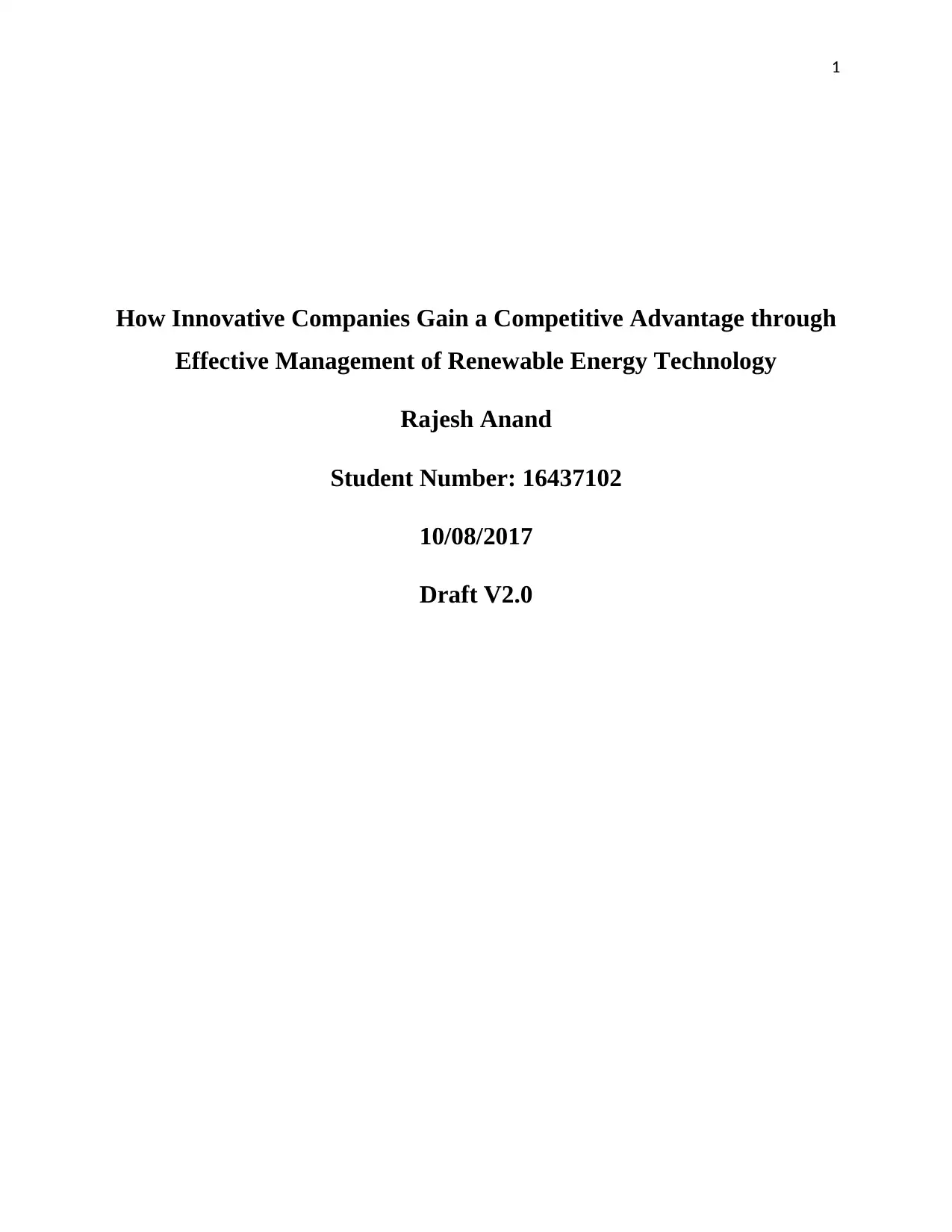
1
How Innovative Companies Gain a Competitive Advantage through
Effective Management of Renewable Energy Technology
Rajesh Anand
Student Number: 16437102
10/08/2017
Draft V2.0
How Innovative Companies Gain a Competitive Advantage through
Effective Management of Renewable Energy Technology
Rajesh Anand
Student Number: 16437102
10/08/2017
Draft V2.0
Secure Best Marks with AI Grader
Need help grading? Try our AI Grader for instant feedback on your assignments.

Page | 2
ACKNOLWEDGEMENT
This research study was supported by my professor and dissertation supervisor Dr.Nick Barnes. I
would like to thank him for his valuable and professional guidance and insight also like to thank
all my colleagues from Signature One INC, United States who helped me by providing insight
and expertise that immensely assisted the research and gather the information required and
introducing to the right faculties and helping me making the right connections in the industry. A
special thanks to the team who have extended support on the virtual medium and calls to
facilitate sessions with multiple industry leaders and subject matter experts in the United States.
ACKNOLWEDGEMENT
This research study was supported by my professor and dissertation supervisor Dr.Nick Barnes. I
would like to thank him for his valuable and professional guidance and insight also like to thank
all my colleagues from Signature One INC, United States who helped me by providing insight
and expertise that immensely assisted the research and gather the information required and
introducing to the right faculties and helping me making the right connections in the industry. A
special thanks to the team who have extended support on the virtual medium and calls to
facilitate sessions with multiple industry leaders and subject matter experts in the United States.
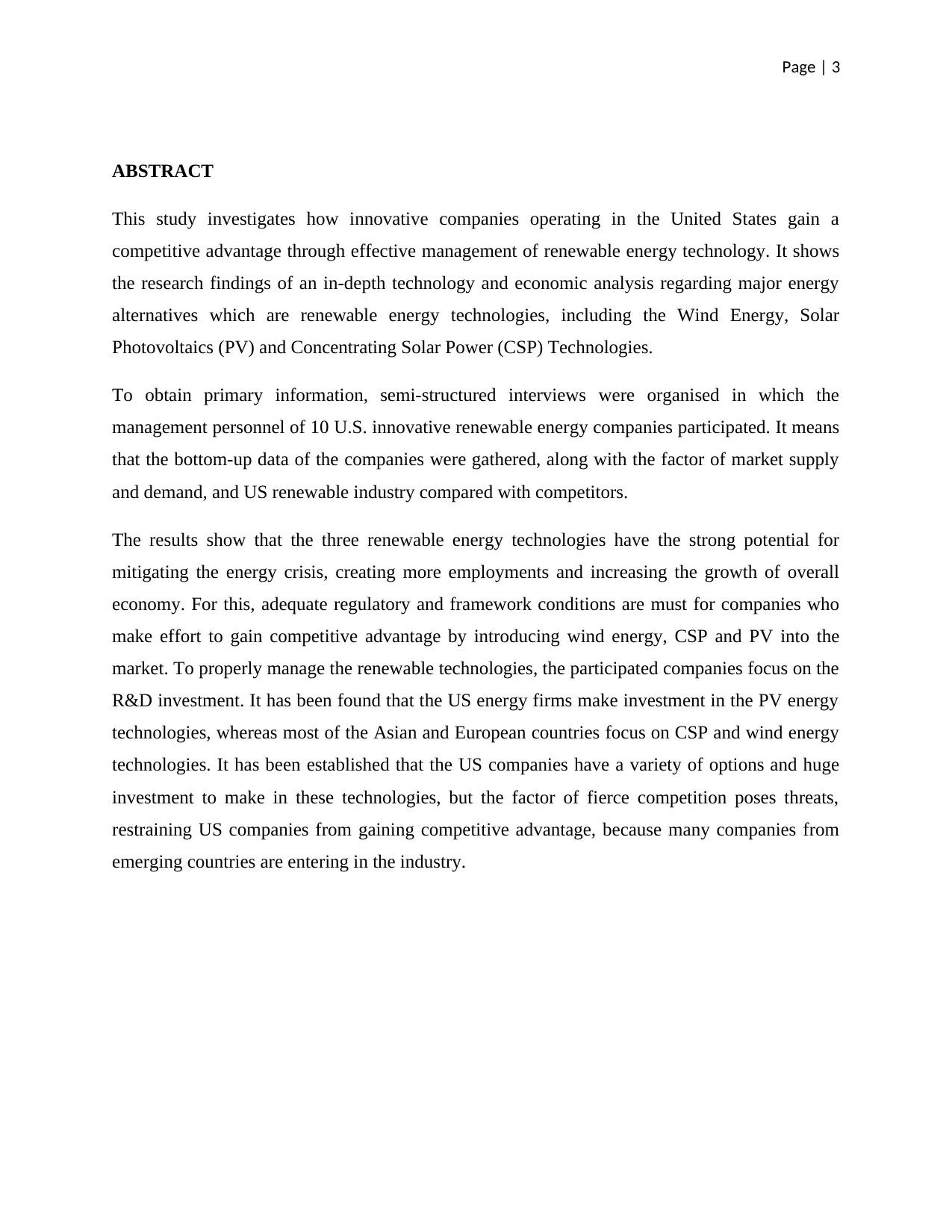
Page | 3
ABSTRACT
This study investigates how innovative companies operating in the United States gain a
competitive advantage through effective management of renewable energy technology. It shows
the research findings of an in-depth technology and economic analysis regarding major energy
alternatives which are renewable energy technologies, including the Wind Energy, Solar
Photovoltaics (PV) and Concentrating Solar Power (CSP) Technologies.
To obtain primary information, semi-structured interviews were organised in which the
management personnel of 10 U.S. innovative renewable energy companies participated. It means
that the bottom-up data of the companies were gathered, along with the factor of market supply
and demand, and US renewable industry compared with competitors.
The results show that the three renewable energy technologies have the strong potential for
mitigating the energy crisis, creating more employments and increasing the growth of overall
economy. For this, adequate regulatory and framework conditions are must for companies who
make effort to gain competitive advantage by introducing wind energy, CSP and PV into the
market. To properly manage the renewable technologies, the participated companies focus on the
R&D investment. It has been found that the US energy firms make investment in the PV energy
technologies, whereas most of the Asian and European countries focus on CSP and wind energy
technologies. It has been established that the US companies have a variety of options and huge
investment to make in these technologies, but the factor of fierce competition poses threats,
restraining US companies from gaining competitive advantage, because many companies from
emerging countries are entering in the industry.
ABSTRACT
This study investigates how innovative companies operating in the United States gain a
competitive advantage through effective management of renewable energy technology. It shows
the research findings of an in-depth technology and economic analysis regarding major energy
alternatives which are renewable energy technologies, including the Wind Energy, Solar
Photovoltaics (PV) and Concentrating Solar Power (CSP) Technologies.
To obtain primary information, semi-structured interviews were organised in which the
management personnel of 10 U.S. innovative renewable energy companies participated. It means
that the bottom-up data of the companies were gathered, along with the factor of market supply
and demand, and US renewable industry compared with competitors.
The results show that the three renewable energy technologies have the strong potential for
mitigating the energy crisis, creating more employments and increasing the growth of overall
economy. For this, adequate regulatory and framework conditions are must for companies who
make effort to gain competitive advantage by introducing wind energy, CSP and PV into the
market. To properly manage the renewable technologies, the participated companies focus on the
R&D investment. It has been found that the US energy firms make investment in the PV energy
technologies, whereas most of the Asian and European countries focus on CSP and wind energy
technologies. It has been established that the US companies have a variety of options and huge
investment to make in these technologies, but the factor of fierce competition poses threats,
restraining US companies from gaining competitive advantage, because many companies from
emerging countries are entering in the industry.
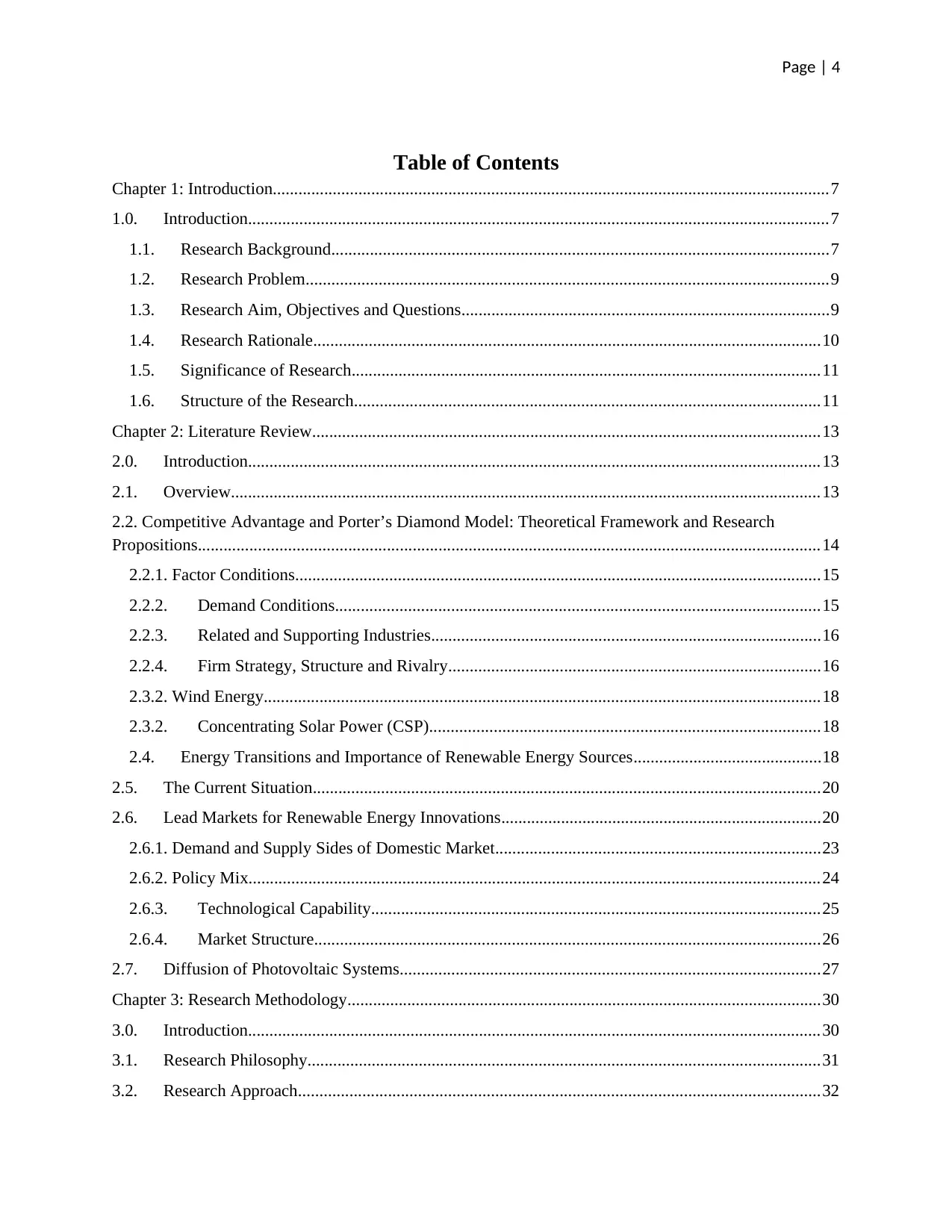
Page | 4
Table of Contents
Chapter 1: Introduction..................................................................................................................................7
1.0. Introduction........................................................................................................................................7
1.1. Research Background....................................................................................................................7
1.2. Research Problem..........................................................................................................................9
1.3. Research Aim, Objectives and Questions......................................................................................9
1.4. Research Rationale.......................................................................................................................10
1.5. Significance of Research..............................................................................................................11
1.6. Structure of the Research.............................................................................................................11
Chapter 2: Literature Review.......................................................................................................................13
2.0. Introduction......................................................................................................................................13
2.1. Overview..........................................................................................................................................13
2.2. Competitive Advantage and Porter’s Diamond Model: Theoretical Framework and Research
Propositions.................................................................................................................................................14
2.2.1. Factor Conditions...........................................................................................................................15
2.2.2. Demand Conditions.................................................................................................................15
2.2.3. Related and Supporting Industries...........................................................................................16
2.2.4. Firm Strategy, Structure and Rivalry.......................................................................................16
2.3.2. Wind Energy..................................................................................................................................18
2.3.2. Concentrating Solar Power (CSP)...........................................................................................18
2.4. Energy Transitions and Importance of Renewable Energy Sources............................................18
2.5. The Current Situation.......................................................................................................................20
2.6. Lead Markets for Renewable Energy Innovations...........................................................................20
2.6.1. Demand and Supply Sides of Domestic Market............................................................................23
2.6.2. Policy Mix......................................................................................................................................24
2.6.3. Technological Capability.........................................................................................................25
2.6.4. Market Structure......................................................................................................................26
2.7. Diffusion of Photovoltaic Systems..................................................................................................27
Chapter 3: Research Methodology...............................................................................................................30
3.0. Introduction......................................................................................................................................30
3.1. Research Philosophy........................................................................................................................31
3.2. Research Approach..........................................................................................................................32
Table of Contents
Chapter 1: Introduction..................................................................................................................................7
1.0. Introduction........................................................................................................................................7
1.1. Research Background....................................................................................................................7
1.2. Research Problem..........................................................................................................................9
1.3. Research Aim, Objectives and Questions......................................................................................9
1.4. Research Rationale.......................................................................................................................10
1.5. Significance of Research..............................................................................................................11
1.6. Structure of the Research.............................................................................................................11
Chapter 2: Literature Review.......................................................................................................................13
2.0. Introduction......................................................................................................................................13
2.1. Overview..........................................................................................................................................13
2.2. Competitive Advantage and Porter’s Diamond Model: Theoretical Framework and Research
Propositions.................................................................................................................................................14
2.2.1. Factor Conditions...........................................................................................................................15
2.2.2. Demand Conditions.................................................................................................................15
2.2.3. Related and Supporting Industries...........................................................................................16
2.2.4. Firm Strategy, Structure and Rivalry.......................................................................................16
2.3.2. Wind Energy..................................................................................................................................18
2.3.2. Concentrating Solar Power (CSP)...........................................................................................18
2.4. Energy Transitions and Importance of Renewable Energy Sources............................................18
2.5. The Current Situation.......................................................................................................................20
2.6. Lead Markets for Renewable Energy Innovations...........................................................................20
2.6.1. Demand and Supply Sides of Domestic Market............................................................................23
2.6.2. Policy Mix......................................................................................................................................24
2.6.3. Technological Capability.........................................................................................................25
2.6.4. Market Structure......................................................................................................................26
2.7. Diffusion of Photovoltaic Systems..................................................................................................27
Chapter 3: Research Methodology...............................................................................................................30
3.0. Introduction......................................................................................................................................30
3.1. Research Philosophy........................................................................................................................31
3.2. Research Approach..........................................................................................................................32
Secure Best Marks with AI Grader
Need help grading? Try our AI Grader for instant feedback on your assignments.
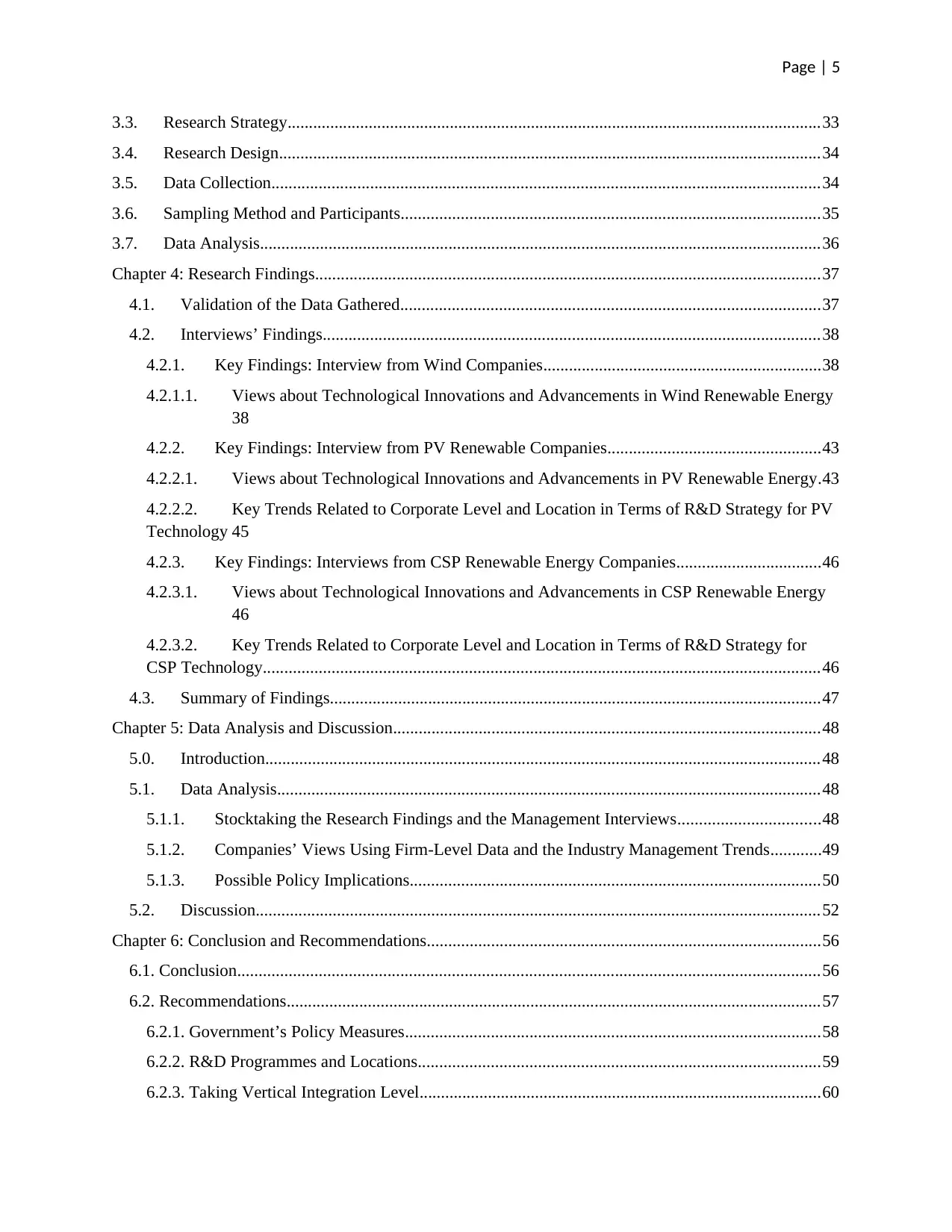
Page | 5
3.3. Research Strategy.............................................................................................................................33
3.4. Research Design...............................................................................................................................34
3.5. Data Collection................................................................................................................................34
3.6. Sampling Method and Participants..................................................................................................35
3.7. Data Analysis...................................................................................................................................36
Chapter 4: Research Findings......................................................................................................................37
4.1. Validation of the Data Gathered..................................................................................................37
4.2. Interviews’ Findings....................................................................................................................38
4.2.1. Key Findings: Interview from Wind Companies.................................................................38
4.2.1.1. Views about Technological Innovations and Advancements in Wind Renewable Energy
38
4.2.2. Key Findings: Interview from PV Renewable Companies..................................................43
4.2.2.1. Views about Technological Innovations and Advancements in PV Renewable Energy.43
4.2.2.2. Key Trends Related to Corporate Level and Location in Terms of R&D Strategy for PV
Technology 45
4.2.3. Key Findings: Interviews from CSP Renewable Energy Companies..................................46
4.2.3.1. Views about Technological Innovations and Advancements in CSP Renewable Energy
46
4.2.3.2. Key Trends Related to Corporate Level and Location in Terms of R&D Strategy for
CSP Technology..................................................................................................................................46
4.3. Summary of Findings...................................................................................................................47
Chapter 5: Data Analysis and Discussion....................................................................................................48
5.0. Introduction..................................................................................................................................48
5.1. Data Analysis...............................................................................................................................48
5.1.1. Stocktaking the Research Findings and the Management Interviews.................................48
5.1.2. Companies’ Views Using Firm-Level Data and the Industry Management Trends............49
5.1.3. Possible Policy Implications................................................................................................50
5.2. Discussion....................................................................................................................................52
Chapter 6: Conclusion and Recommendations............................................................................................56
6.1. Conclusion........................................................................................................................................56
6.2. Recommendations.............................................................................................................................57
6.2.1. Government’s Policy Measures.................................................................................................58
6.2.2. R&D Programmes and Locations..............................................................................................59
6.2.3. Taking Vertical Integration Level..............................................................................................60
3.3. Research Strategy.............................................................................................................................33
3.4. Research Design...............................................................................................................................34
3.5. Data Collection................................................................................................................................34
3.6. Sampling Method and Participants..................................................................................................35
3.7. Data Analysis...................................................................................................................................36
Chapter 4: Research Findings......................................................................................................................37
4.1. Validation of the Data Gathered..................................................................................................37
4.2. Interviews’ Findings....................................................................................................................38
4.2.1. Key Findings: Interview from Wind Companies.................................................................38
4.2.1.1. Views about Technological Innovations and Advancements in Wind Renewable Energy
38
4.2.2. Key Findings: Interview from PV Renewable Companies..................................................43
4.2.2.1. Views about Technological Innovations and Advancements in PV Renewable Energy.43
4.2.2.2. Key Trends Related to Corporate Level and Location in Terms of R&D Strategy for PV
Technology 45
4.2.3. Key Findings: Interviews from CSP Renewable Energy Companies..................................46
4.2.3.1. Views about Technological Innovations and Advancements in CSP Renewable Energy
46
4.2.3.2. Key Trends Related to Corporate Level and Location in Terms of R&D Strategy for
CSP Technology..................................................................................................................................46
4.3. Summary of Findings...................................................................................................................47
Chapter 5: Data Analysis and Discussion....................................................................................................48
5.0. Introduction..................................................................................................................................48
5.1. Data Analysis...............................................................................................................................48
5.1.1. Stocktaking the Research Findings and the Management Interviews.................................48
5.1.2. Companies’ Views Using Firm-Level Data and the Industry Management Trends............49
5.1.3. Possible Policy Implications................................................................................................50
5.2. Discussion....................................................................................................................................52
Chapter 6: Conclusion and Recommendations............................................................................................56
6.1. Conclusion........................................................................................................................................56
6.2. Recommendations.............................................................................................................................57
6.2.1. Government’s Policy Measures.................................................................................................58
6.2.2. R&D Programmes and Locations..............................................................................................59
6.2.3. Taking Vertical Integration Level..............................................................................................60

Page | 6
References....................................................................................................................................................61
Appendices...................................................................................................................................................71
Appendix 1: Interview Questionnaires....................................................................................................71
Appendix 2: Research Ethics Form/Consent Form.................................................................................72
References....................................................................................................................................................61
Appendices...................................................................................................................................................71
Appendix 1: Interview Questionnaires....................................................................................................71
Appendix 2: Research Ethics Form/Consent Form.................................................................................72
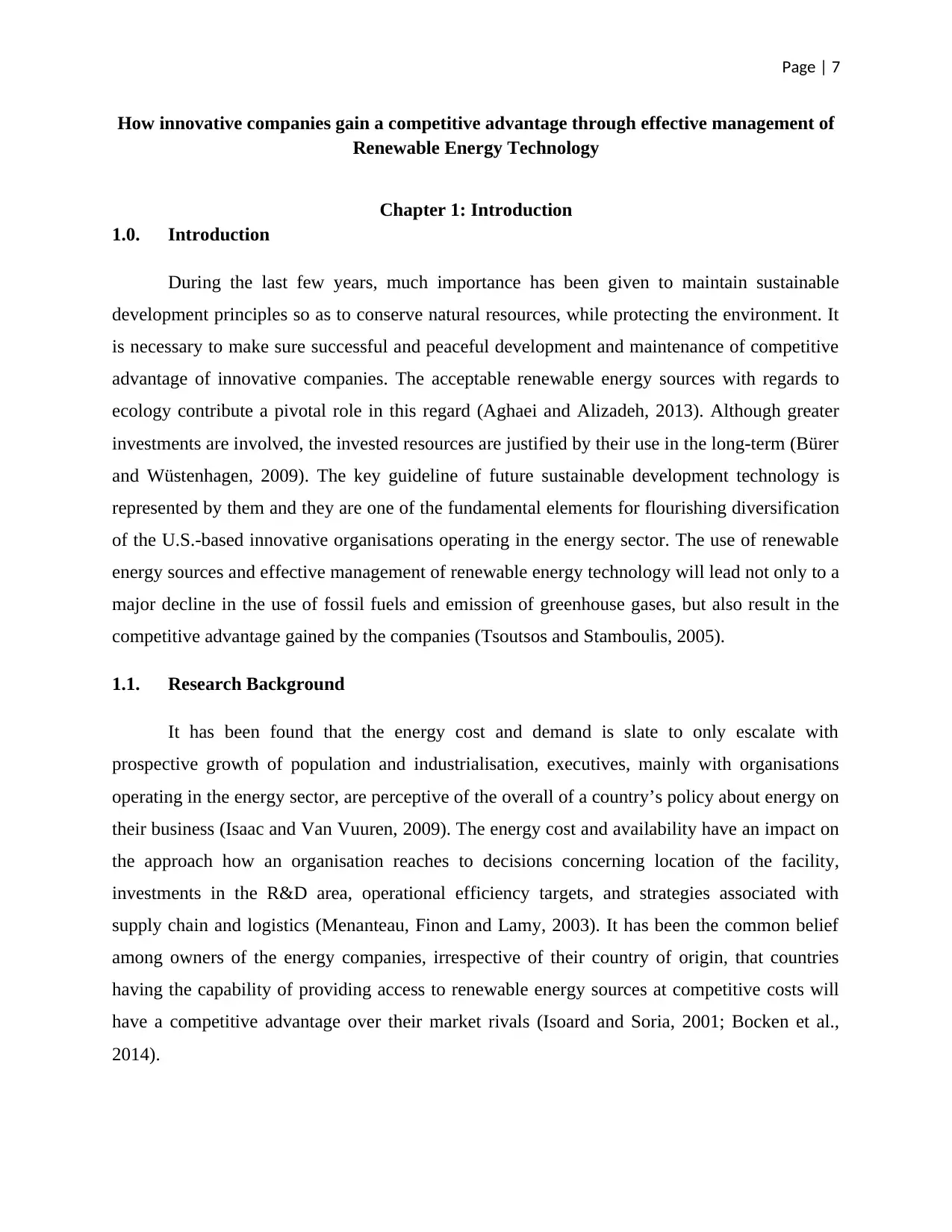
Page | 7
How innovative companies gain a competitive advantage through effective management of
Renewable Energy Technology
Chapter 1: Introduction
1.0. Introduction
During the last few years, much importance has been given to maintain sustainable
development principles so as to conserve natural resources, while protecting the environment. It
is necessary to make sure successful and peaceful development and maintenance of competitive
advantage of innovative companies. The acceptable renewable energy sources with regards to
ecology contribute a pivotal role in this regard (Aghaei and Alizadeh, 2013). Although greater
investments are involved, the invested resources are justified by their use in the long-term (Bürer
and Wüstenhagen, 2009). The key guideline of future sustainable development technology is
represented by them and they are one of the fundamental elements for flourishing diversification
of the U.S.-based innovative organisations operating in the energy sector. The use of renewable
energy sources and effective management of renewable energy technology will lead not only to a
major decline in the use of fossil fuels and emission of greenhouse gases, but also result in the
competitive advantage gained by the companies (Tsoutsos and Stamboulis, 2005).
1.1. Research Background
It has been found that the energy cost and demand is slate to only escalate with
prospective growth of population and industrialisation, executives, mainly with organisations
operating in the energy sector, are perceptive of the overall of a country’s policy about energy on
their business (Isaac and Van Vuuren, 2009). The energy cost and availability have an impact on
the approach how an organisation reaches to decisions concerning location of the facility,
investments in the R&D area, operational efficiency targets, and strategies associated with
supply chain and logistics (Menanteau, Finon and Lamy, 2003). It has been the common belief
among owners of the energy companies, irrespective of their country of origin, that countries
having the capability of providing access to renewable energy sources at competitive costs will
have a competitive advantage over their market rivals (Isoard and Soria, 2001; Bocken et al.,
2014).
How innovative companies gain a competitive advantage through effective management of
Renewable Energy Technology
Chapter 1: Introduction
1.0. Introduction
During the last few years, much importance has been given to maintain sustainable
development principles so as to conserve natural resources, while protecting the environment. It
is necessary to make sure successful and peaceful development and maintenance of competitive
advantage of innovative companies. The acceptable renewable energy sources with regards to
ecology contribute a pivotal role in this regard (Aghaei and Alizadeh, 2013). Although greater
investments are involved, the invested resources are justified by their use in the long-term (Bürer
and Wüstenhagen, 2009). The key guideline of future sustainable development technology is
represented by them and they are one of the fundamental elements for flourishing diversification
of the U.S.-based innovative organisations operating in the energy sector. The use of renewable
energy sources and effective management of renewable energy technology will lead not only to a
major decline in the use of fossil fuels and emission of greenhouse gases, but also result in the
competitive advantage gained by the companies (Tsoutsos and Stamboulis, 2005).
1.1. Research Background
It has been found that the energy cost and demand is slate to only escalate with
prospective growth of population and industrialisation, executives, mainly with organisations
operating in the energy sector, are perceptive of the overall of a country’s policy about energy on
their business (Isaac and Van Vuuren, 2009). The energy cost and availability have an impact on
the approach how an organisation reaches to decisions concerning location of the facility,
investments in the R&D area, operational efficiency targets, and strategies associated with
supply chain and logistics (Menanteau, Finon and Lamy, 2003). It has been the common belief
among owners of the energy companies, irrespective of their country of origin, that countries
having the capability of providing access to renewable energy sources at competitive costs will
have a competitive advantage over their market rivals (Isoard and Soria, 2001; Bocken et al.,
2014).
Paraphrase This Document
Need a fresh take? Get an instant paraphrase of this document with our AI Paraphraser
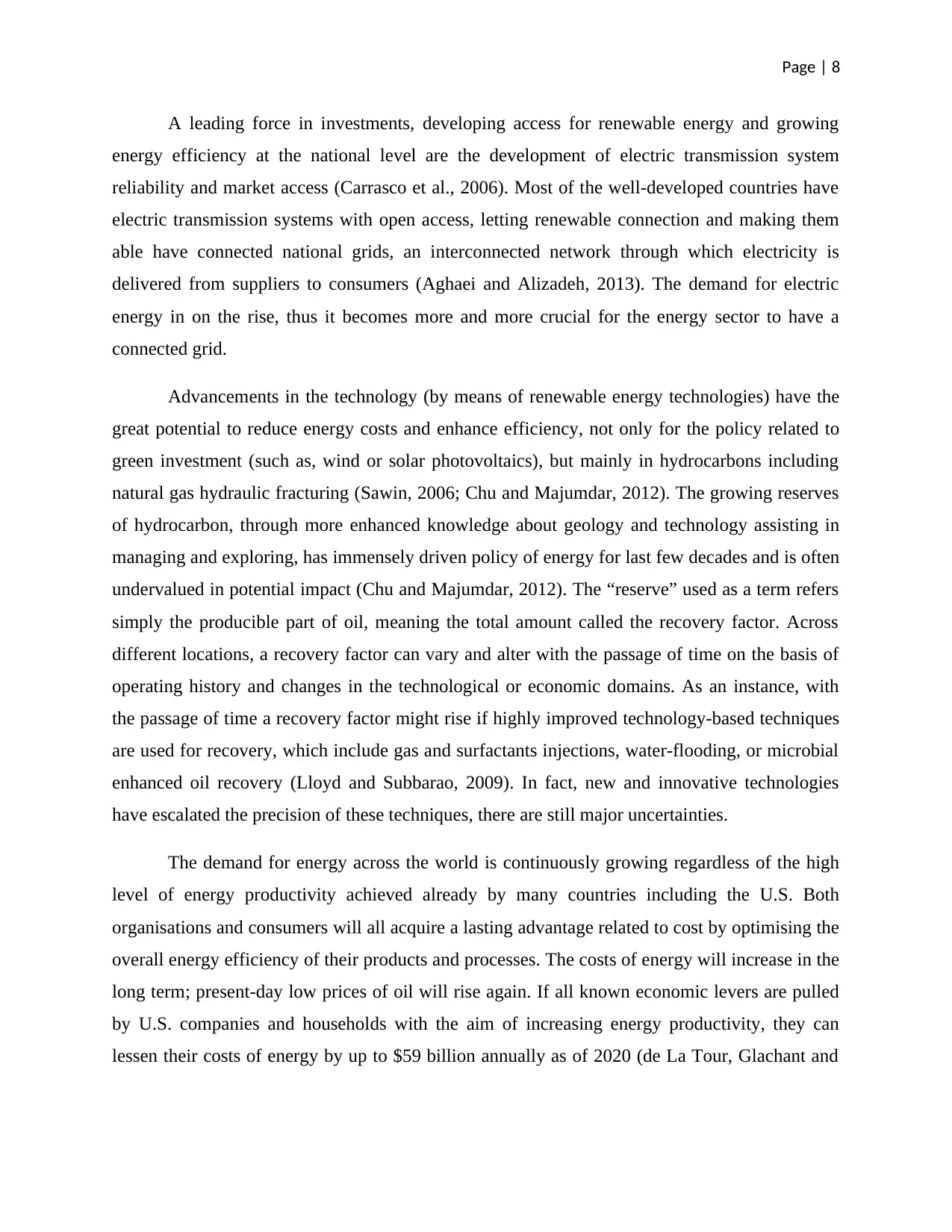
Page | 8
A leading force in investments, developing access for renewable energy and growing
energy efficiency at the national level are the development of electric transmission system
reliability and market access (Carrasco et al., 2006). Most of the well-developed countries have
electric transmission systems with open access, letting renewable connection and making them
able have connected national grids, an interconnected network through which electricity is
delivered from suppliers to consumers (Aghaei and Alizadeh, 2013). The demand for electric
energy in on the rise, thus it becomes more and more crucial for the energy sector to have a
connected grid.
Advancements in the technology (by means of renewable energy technologies) have the
great potential to reduce energy costs and enhance efficiency, not only for the policy related to
green investment (such as, wind or solar photovoltaics), but mainly in hydrocarbons including
natural gas hydraulic fracturing (Sawin, 2006; Chu and Majumdar, 2012). The growing reserves
of hydrocarbon, through more enhanced knowledge about geology and technology assisting in
managing and exploring, has immensely driven policy of energy for last few decades and is often
undervalued in potential impact (Chu and Majumdar, 2012). The “reserve” used as a term refers
simply the producible part of oil, meaning the total amount called the recovery factor. Across
different locations, a recovery factor can vary and alter with the passage of time on the basis of
operating history and changes in the technological or economic domains. As an instance, with
the passage of time a recovery factor might rise if highly improved technology-based techniques
are used for recovery, which include gas and surfactants injections, water-flooding, or microbial
enhanced oil recovery (Lloyd and Subbarao, 2009). In fact, new and innovative technologies
have escalated the precision of these techniques, there are still major uncertainties.
The demand for energy across the world is continuously growing regardless of the high
level of energy productivity achieved already by many countries including the U.S. Both
organisations and consumers will all acquire a lasting advantage related to cost by optimising the
overall energy efficiency of their products and processes. The costs of energy will increase in the
long term; present-day low prices of oil will rise again. If all known economic levers are pulled
by U.S. companies and households with the aim of increasing energy productivity, they can
lessen their costs of energy by up to $59 billion annually as of 2020 (de La Tour, Glachant and
A leading force in investments, developing access for renewable energy and growing
energy efficiency at the national level are the development of electric transmission system
reliability and market access (Carrasco et al., 2006). Most of the well-developed countries have
electric transmission systems with open access, letting renewable connection and making them
able have connected national grids, an interconnected network through which electricity is
delivered from suppliers to consumers (Aghaei and Alizadeh, 2013). The demand for electric
energy in on the rise, thus it becomes more and more crucial for the energy sector to have a
connected grid.
Advancements in the technology (by means of renewable energy technologies) have the
great potential to reduce energy costs and enhance efficiency, not only for the policy related to
green investment (such as, wind or solar photovoltaics), but mainly in hydrocarbons including
natural gas hydraulic fracturing (Sawin, 2006; Chu and Majumdar, 2012). The growing reserves
of hydrocarbon, through more enhanced knowledge about geology and technology assisting in
managing and exploring, has immensely driven policy of energy for last few decades and is often
undervalued in potential impact (Chu and Majumdar, 2012). The “reserve” used as a term refers
simply the producible part of oil, meaning the total amount called the recovery factor. Across
different locations, a recovery factor can vary and alter with the passage of time on the basis of
operating history and changes in the technological or economic domains. As an instance, with
the passage of time a recovery factor might rise if highly improved technology-based techniques
are used for recovery, which include gas and surfactants injections, water-flooding, or microbial
enhanced oil recovery (Lloyd and Subbarao, 2009). In fact, new and innovative technologies
have escalated the precision of these techniques, there are still major uncertainties.
The demand for energy across the world is continuously growing regardless of the high
level of energy productivity achieved already by many countries including the U.S. Both
organisations and consumers will all acquire a lasting advantage related to cost by optimising the
overall energy efficiency of their products and processes. The costs of energy will increase in the
long term; present-day low prices of oil will rise again. If all known economic levers are pulled
by U.S. companies and households with the aim of increasing energy productivity, they can
lessen their costs of energy by up to $59 billion annually as of 2020 (de La Tour, Glachant and

Page | 9
Ménière, 2013). In this regard, innovative companies in the U.S. could gain competitive
advantage by using and maintaining renewable energy technology.
1.2. Research Problem
The renewable energy sources are very expensive in relation to the traditional fossil-fuel
and nuclear sources used with the aim of generating electricity. For this very reason, all countries
have their own alternative programmes through which they promote renewable energy
technologies. Currently in the 21st century era, renewable energy sources based on technology
will rule the overall energy technology market. It seems that although renewable energy is very
costly, all the world’s countries, mainly their energy sector companies, are currently making
investment in research and development area with the aim of devising new and innovative
technologies and implementing them to make sure their competitive advantage (Peidong et al.,
2009). One of the key factors behind these are aspects associated with environment, fast growing
demand and cost of fossil fuel and reducing the risk of nuclear technologies (Peidong et al.,
2009). With these considerations in mind, this research work targets the energy sector companies
based in the United States to explore how they perceive the role played by of technological
innovations and advancements in the area of renewable energy in gaining competitive advantage.
1.3. Research Aim, Objectives and Questions
Defining its core aims, objectives and questions is an important task in any research
study. The core points in a research project are what central aim, goal or purpose of the research
project is and what research topics, questions and problems are (Ritchie et al., 2013). Majority of
the research projects have to face difficulty because not a considerable amount of time, effort and
thought is devoted while properly defining the research aims and goals. Consequently, valuable
time and authentic resources can be wasted gathering inappropriate research data. For this study,
following are the research aim, objective and questions:
1.3.1. Research Aim
The key aim and purpose of this research study is to explore and investigate the use and
management of renewable energy technology by companies operating in the energy sector and
how they gain competitive advantage through that. Keeping this aim in mind, the study has
Ménière, 2013). In this regard, innovative companies in the U.S. could gain competitive
advantage by using and maintaining renewable energy technology.
1.2. Research Problem
The renewable energy sources are very expensive in relation to the traditional fossil-fuel
and nuclear sources used with the aim of generating electricity. For this very reason, all countries
have their own alternative programmes through which they promote renewable energy
technologies. Currently in the 21st century era, renewable energy sources based on technology
will rule the overall energy technology market. It seems that although renewable energy is very
costly, all the world’s countries, mainly their energy sector companies, are currently making
investment in research and development area with the aim of devising new and innovative
technologies and implementing them to make sure their competitive advantage (Peidong et al.,
2009). One of the key factors behind these are aspects associated with environment, fast growing
demand and cost of fossil fuel and reducing the risk of nuclear technologies (Peidong et al.,
2009). With these considerations in mind, this research work targets the energy sector companies
based in the United States to explore how they perceive the role played by of technological
innovations and advancements in the area of renewable energy in gaining competitive advantage.
1.3. Research Aim, Objectives and Questions
Defining its core aims, objectives and questions is an important task in any research
study. The core points in a research project are what central aim, goal or purpose of the research
project is and what research topics, questions and problems are (Ritchie et al., 2013). Majority of
the research projects have to face difficulty because not a considerable amount of time, effort and
thought is devoted while properly defining the research aims and goals. Consequently, valuable
time and authentic resources can be wasted gathering inappropriate research data. For this study,
following are the research aim, objective and questions:
1.3.1. Research Aim
The key aim and purpose of this research study is to explore and investigate the use and
management of renewable energy technology by companies operating in the energy sector and
how they gain competitive advantage through that. Keeping this aim in mind, the study has
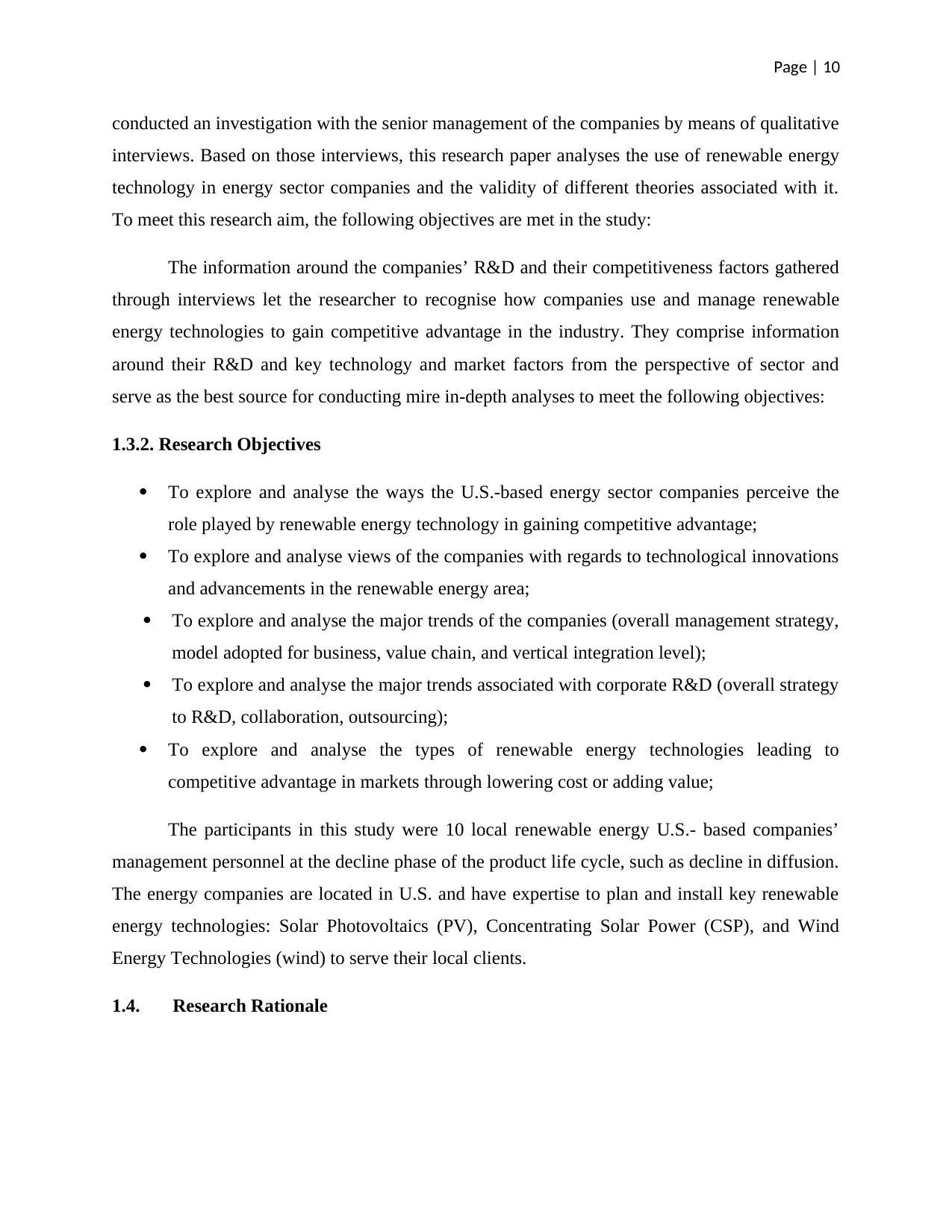
Page | 10
conducted an investigation with the senior management of the companies by means of qualitative
interviews. Based on those interviews, this research paper analyses the use of renewable energy
technology in energy sector companies and the validity of different theories associated with it.
To meet this research aim, the following objectives are met in the study:
The information around the companies’ R&D and their competitiveness factors gathered
through interviews let the researcher to recognise how companies use and manage renewable
energy technologies to gain competitive advantage in the industry. They comprise information
around their R&D and key technology and market factors from the perspective of sector and
serve as the best source for conducting mire in-depth analyses to meet the following objectives:
1.3.2. Research Objectives
To explore and analyse the ways the U.S.-based energy sector companies perceive the
role played by renewable energy technology in gaining competitive advantage;
To explore and analyse views of the companies with regards to technological innovations
and advancements in the renewable energy area;
To explore and analyse the major trends of the companies (overall management strategy,
model adopted for business, value chain, and vertical integration level);
To explore and analyse the major trends associated with corporate R&D (overall strategy
to R&D, collaboration, outsourcing);
To explore and analyse the types of renewable energy technologies leading to
competitive advantage in markets through lowering cost or adding value;
The participants in this study were 10 local renewable energy U.S.- based companies’
management personnel at the decline phase of the product life cycle, such as decline in diffusion.
The energy companies are located in U.S. and have expertise to plan and install key renewable
energy technologies: Solar Photovoltaics (PV), Concentrating Solar Power (CSP), and Wind
Energy Technologies (wind) to serve their local clients.
1.4. Research Rationale
conducted an investigation with the senior management of the companies by means of qualitative
interviews. Based on those interviews, this research paper analyses the use of renewable energy
technology in energy sector companies and the validity of different theories associated with it.
To meet this research aim, the following objectives are met in the study:
The information around the companies’ R&D and their competitiveness factors gathered
through interviews let the researcher to recognise how companies use and manage renewable
energy technologies to gain competitive advantage in the industry. They comprise information
around their R&D and key technology and market factors from the perspective of sector and
serve as the best source for conducting mire in-depth analyses to meet the following objectives:
1.3.2. Research Objectives
To explore and analyse the ways the U.S.-based energy sector companies perceive the
role played by renewable energy technology in gaining competitive advantage;
To explore and analyse views of the companies with regards to technological innovations
and advancements in the renewable energy area;
To explore and analyse the major trends of the companies (overall management strategy,
model adopted for business, value chain, and vertical integration level);
To explore and analyse the major trends associated with corporate R&D (overall strategy
to R&D, collaboration, outsourcing);
To explore and analyse the types of renewable energy technologies leading to
competitive advantage in markets through lowering cost or adding value;
The participants in this study were 10 local renewable energy U.S.- based companies’
management personnel at the decline phase of the product life cycle, such as decline in diffusion.
The energy companies are located in U.S. and have expertise to plan and install key renewable
energy technologies: Solar Photovoltaics (PV), Concentrating Solar Power (CSP), and Wind
Energy Technologies (wind) to serve their local clients.
1.4. Research Rationale
Secure Best Marks with AI Grader
Need help grading? Try our AI Grader for instant feedback on your assignments.
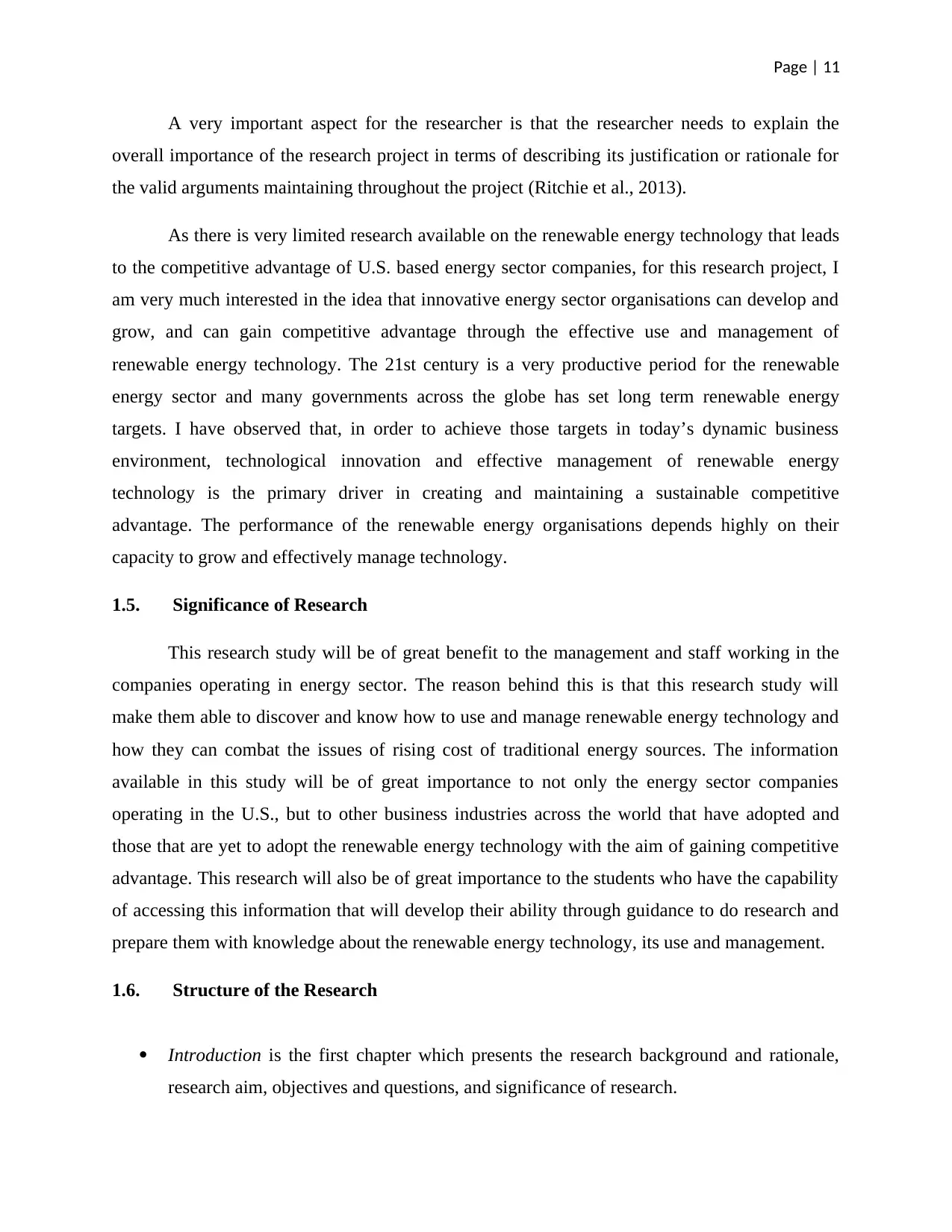
Page | 11
A very important aspect for the researcher is that the researcher needs to explain the
overall importance of the research project in terms of describing its justification or rationale for
the valid arguments maintaining throughout the project (Ritchie et al., 2013).
As there is very limited research available on the renewable energy technology that leads
to the competitive advantage of U.S. based energy sector companies, for this research project, I
am very much interested in the idea that innovative energy sector organisations can develop and
grow, and can gain competitive advantage through the effective use and management of
renewable energy technology. The 21st century is a very productive period for the renewable
energy sector and many governments across the globe has set long term renewable energy
targets. I have observed that, in order to achieve those targets in today’s dynamic business
environment, technological innovation and effective management of renewable energy
technology is the primary driver in creating and maintaining a sustainable competitive
advantage. The performance of the renewable energy organisations depends highly on their
capacity to grow and effectively manage technology.
1.5. Significance of Research
This research study will be of great benefit to the management and staff working in the
companies operating in energy sector. The reason behind this is that this research study will
make them able to discover and know how to use and manage renewable energy technology and
how they can combat the issues of rising cost of traditional energy sources. The information
available in this study will be of great importance to not only the energy sector companies
operating in the U.S., but to other business industries across the world that have adopted and
those that are yet to adopt the renewable energy technology with the aim of gaining competitive
advantage. This research will also be of great importance to the students who have the capability
of accessing this information that will develop their ability through guidance to do research and
prepare them with knowledge about the renewable energy technology, its use and management.
1.6. Structure of the Research
Introduction is the first chapter which presents the research background and rationale,
research aim, objectives and questions, and significance of research.
A very important aspect for the researcher is that the researcher needs to explain the
overall importance of the research project in terms of describing its justification or rationale for
the valid arguments maintaining throughout the project (Ritchie et al., 2013).
As there is very limited research available on the renewable energy technology that leads
to the competitive advantage of U.S. based energy sector companies, for this research project, I
am very much interested in the idea that innovative energy sector organisations can develop and
grow, and can gain competitive advantage through the effective use and management of
renewable energy technology. The 21st century is a very productive period for the renewable
energy sector and many governments across the globe has set long term renewable energy
targets. I have observed that, in order to achieve those targets in today’s dynamic business
environment, technological innovation and effective management of renewable energy
technology is the primary driver in creating and maintaining a sustainable competitive
advantage. The performance of the renewable energy organisations depends highly on their
capacity to grow and effectively manage technology.
1.5. Significance of Research
This research study will be of great benefit to the management and staff working in the
companies operating in energy sector. The reason behind this is that this research study will
make them able to discover and know how to use and manage renewable energy technology and
how they can combat the issues of rising cost of traditional energy sources. The information
available in this study will be of great importance to not only the energy sector companies
operating in the U.S., but to other business industries across the world that have adopted and
those that are yet to adopt the renewable energy technology with the aim of gaining competitive
advantage. This research will also be of great importance to the students who have the capability
of accessing this information that will develop their ability through guidance to do research and
prepare them with knowledge about the renewable energy technology, its use and management.
1.6. Structure of the Research
Introduction is the first chapter which presents the research background and rationale,
research aim, objectives and questions, and significance of research.
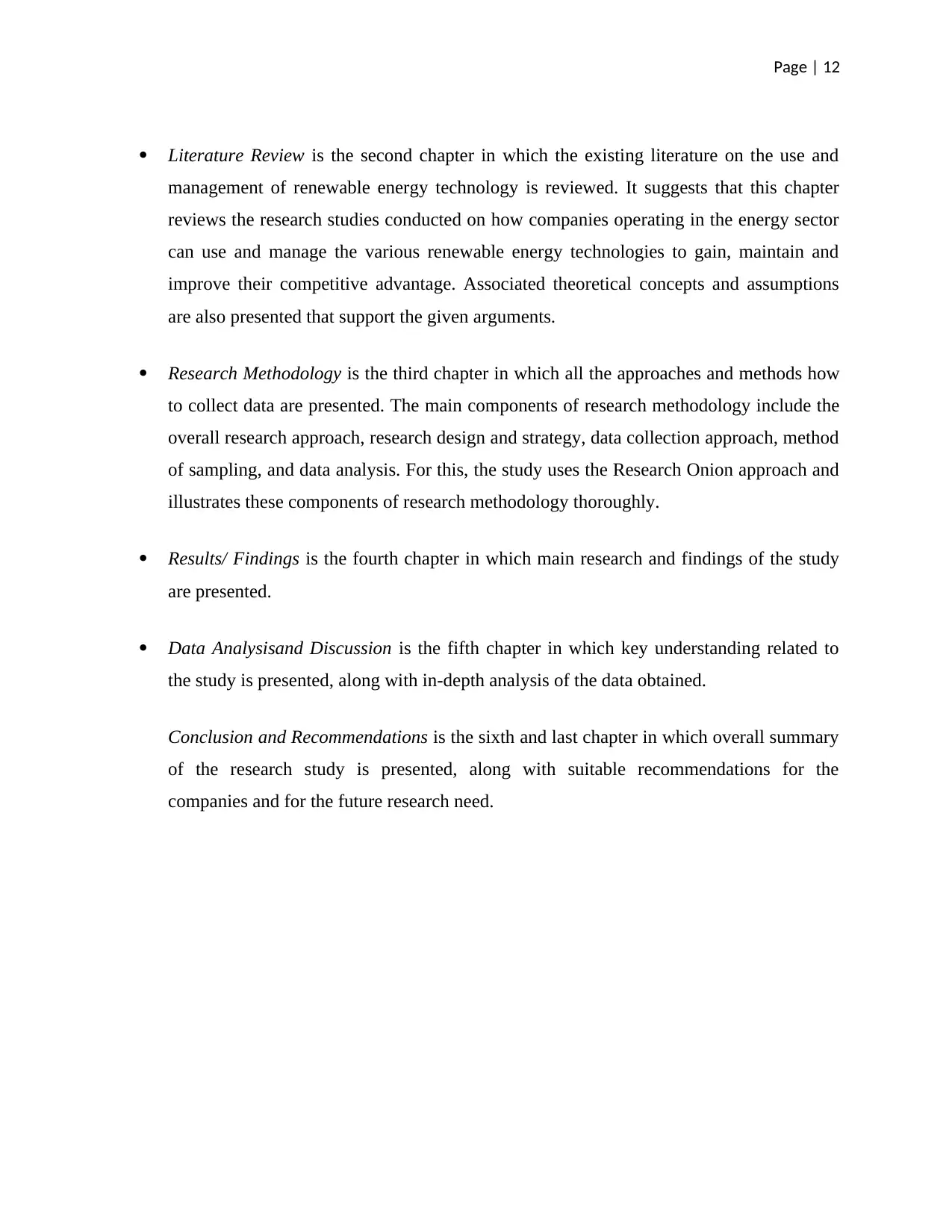
Page | 12
Literature Review is the second chapter in which the existing literature on the use and
management of renewable energy technology is reviewed. It suggests that this chapter
reviews the research studies conducted on how companies operating in the energy sector
can use and manage the various renewable energy technologies to gain, maintain and
improve their competitive advantage. Associated theoretical concepts and assumptions
are also presented that support the given arguments.
Research Methodology is the third chapter in which all the approaches and methods how
to collect data are presented. The main components of research methodology include the
overall research approach, research design and strategy, data collection approach, method
of sampling, and data analysis. For this, the study uses the Research Onion approach and
illustrates these components of research methodology thoroughly.
Results/ Findings is the fourth chapter in which main research and findings of the study
are presented.
Data Analysisand Discussion is the fifth chapter in which key understanding related to
the study is presented, along with in-depth analysis of the data obtained.
Conclusion and Recommendations is the sixth and last chapter in which overall summary
of the research study is presented, along with suitable recommendations for the
companies and for the future research need.
Literature Review is the second chapter in which the existing literature on the use and
management of renewable energy technology is reviewed. It suggests that this chapter
reviews the research studies conducted on how companies operating in the energy sector
can use and manage the various renewable energy technologies to gain, maintain and
improve their competitive advantage. Associated theoretical concepts and assumptions
are also presented that support the given arguments.
Research Methodology is the third chapter in which all the approaches and methods how
to collect data are presented. The main components of research methodology include the
overall research approach, research design and strategy, data collection approach, method
of sampling, and data analysis. For this, the study uses the Research Onion approach and
illustrates these components of research methodology thoroughly.
Results/ Findings is the fourth chapter in which main research and findings of the study
are presented.
Data Analysisand Discussion is the fifth chapter in which key understanding related to
the study is presented, along with in-depth analysis of the data obtained.
Conclusion and Recommendations is the sixth and last chapter in which overall summary
of the research study is presented, along with suitable recommendations for the
companies and for the future research need.
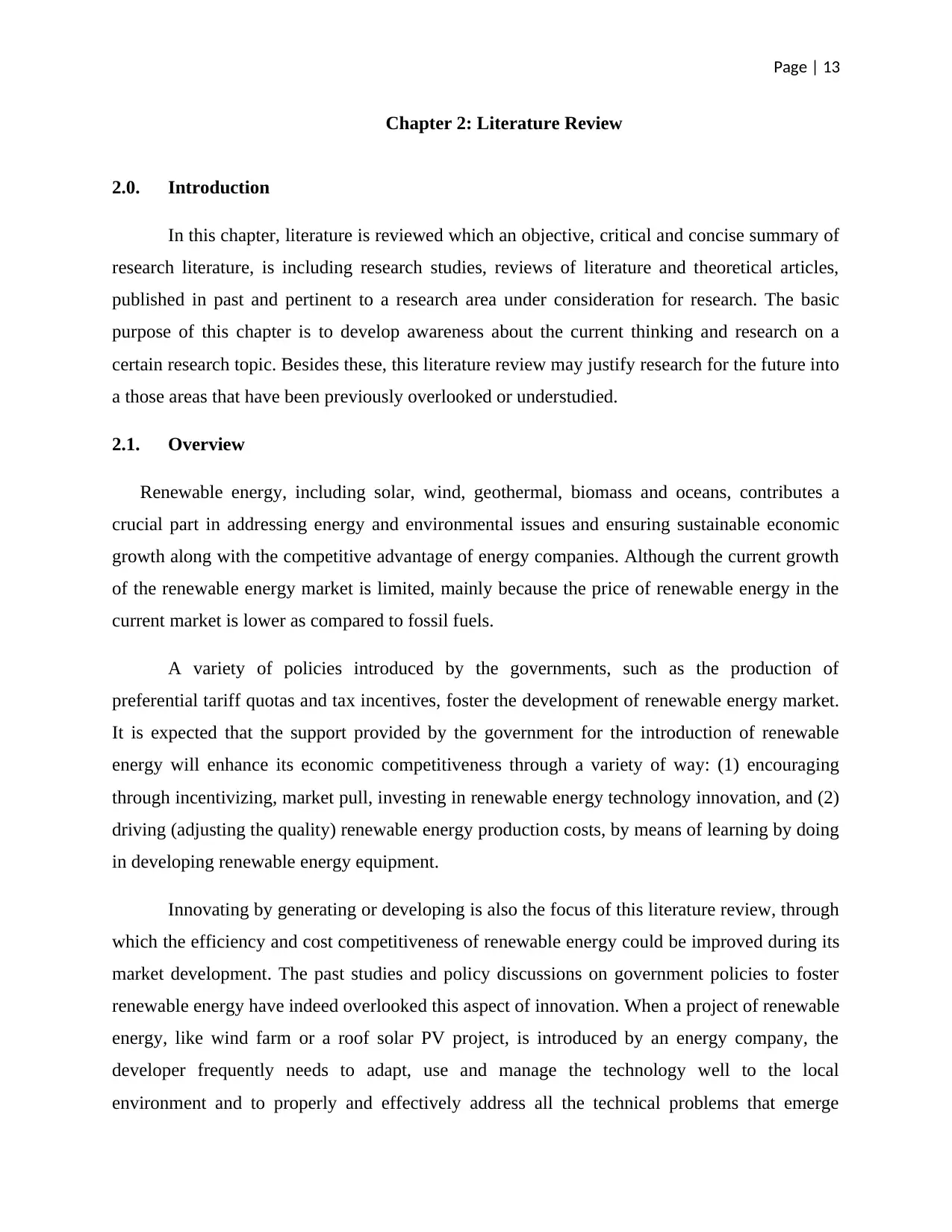
Page | 13
Chapter 2: Literature Review
2.0. Introduction
In this chapter, literature is reviewed which an objective, critical and concise summary of
research literature, is including research studies, reviews of literature and theoretical articles,
published in past and pertinent to a research area under consideration for research. The basic
purpose of this chapter is to develop awareness about the current thinking and research on a
certain research topic. Besides these, this literature review may justify research for the future into
a those areas that have been previously overlooked or understudied.
2.1. Overview
Renewable energy, including solar, wind, geothermal, biomass and oceans, contributes a
crucial part in addressing energy and environmental issues and ensuring sustainable economic
growth along with the competitive advantage of energy companies. Although the current growth
of the renewable energy market is limited, mainly because the price of renewable energy in the
current market is lower as compared to fossil fuels.
A variety of policies introduced by the governments, such as the production of
preferential tariff quotas and tax incentives, foster the development of renewable energy market.
It is expected that the support provided by the government for the introduction of renewable
energy will enhance its economic competitiveness through a variety of way: (1) encouraging
through incentivizing, market pull, investing in renewable energy technology innovation, and (2)
driving (adjusting the quality) renewable energy production costs, by means of learning by doing
in developing renewable energy equipment.
Innovating by generating or developing is also the focus of this literature review, through
which the efficiency and cost competitiveness of renewable energy could be improved during its
market development. The past studies and policy discussions on government policies to foster
renewable energy have indeed overlooked this aspect of innovation. When a project of renewable
energy, like wind farm or a roof solar PV project, is introduced by an energy company, the
developer frequently needs to adapt, use and manage the technology well to the local
environment and to properly and effectively address all the technical problems that emerge
Chapter 2: Literature Review
2.0. Introduction
In this chapter, literature is reviewed which an objective, critical and concise summary of
research literature, is including research studies, reviews of literature and theoretical articles,
published in past and pertinent to a research area under consideration for research. The basic
purpose of this chapter is to develop awareness about the current thinking and research on a
certain research topic. Besides these, this literature review may justify research for the future into
a those areas that have been previously overlooked or understudied.
2.1. Overview
Renewable energy, including solar, wind, geothermal, biomass and oceans, contributes a
crucial part in addressing energy and environmental issues and ensuring sustainable economic
growth along with the competitive advantage of energy companies. Although the current growth
of the renewable energy market is limited, mainly because the price of renewable energy in the
current market is lower as compared to fossil fuels.
A variety of policies introduced by the governments, such as the production of
preferential tariff quotas and tax incentives, foster the development of renewable energy market.
It is expected that the support provided by the government for the introduction of renewable
energy will enhance its economic competitiveness through a variety of way: (1) encouraging
through incentivizing, market pull, investing in renewable energy technology innovation, and (2)
driving (adjusting the quality) renewable energy production costs, by means of learning by doing
in developing renewable energy equipment.
Innovating by generating or developing is also the focus of this literature review, through
which the efficiency and cost competitiveness of renewable energy could be improved during its
market development. The past studies and policy discussions on government policies to foster
renewable energy have indeed overlooked this aspect of innovation. When a project of renewable
energy, like wind farm or a roof solar PV project, is introduced by an energy company, the
developer frequently needs to adapt, use and manage the technology well to the local
environment and to properly and effectively address all the technical problems that emerge
Paraphrase This Document
Need a fresh take? Get an instant paraphrase of this document with our AI Paraphraser
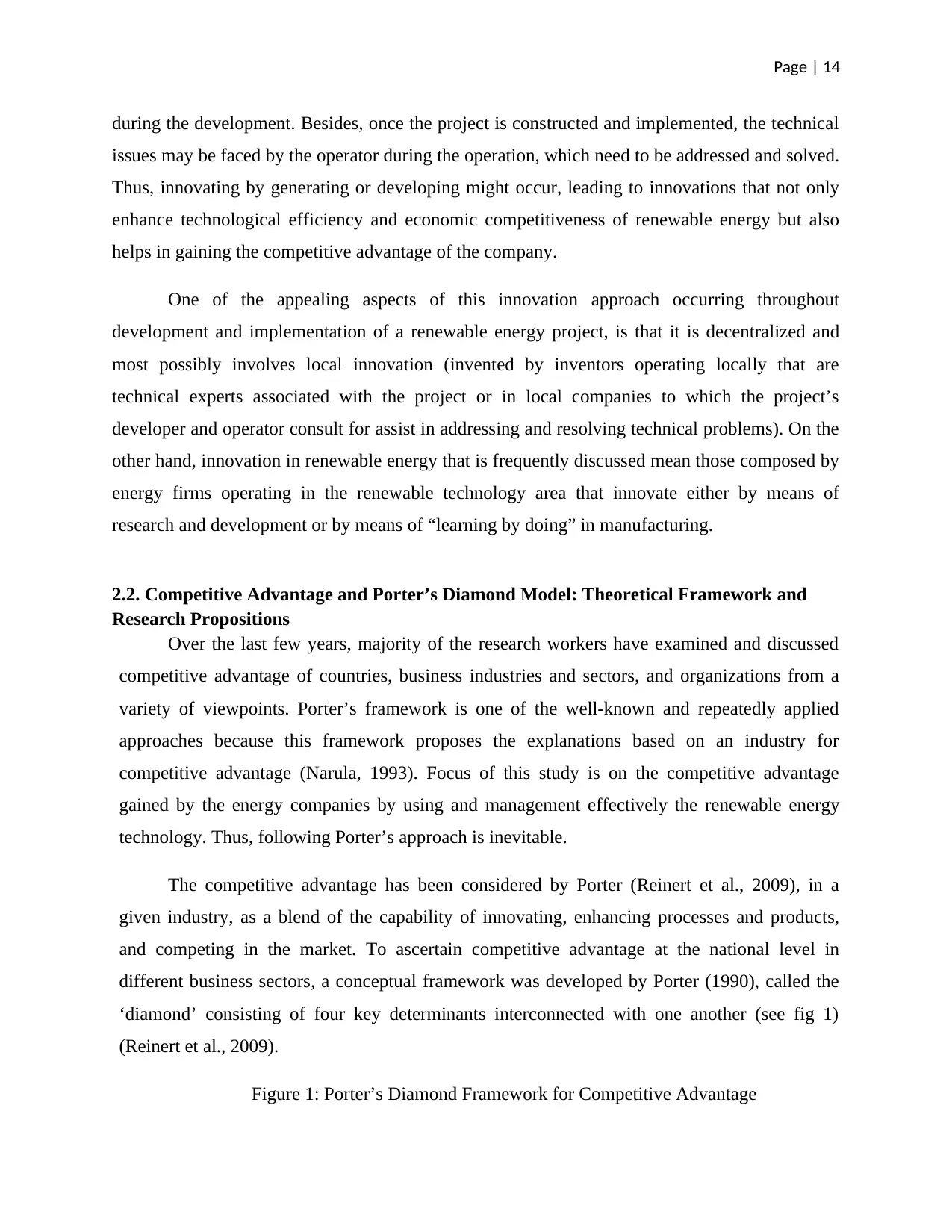
Page | 14
during the development. Besides, once the project is constructed and implemented, the technical
issues may be faced by the operator during the operation, which need to be addressed and solved.
Thus, innovating by generating or developing might occur, leading to innovations that not only
enhance technological efficiency and economic competitiveness of renewable energy but also
helps in gaining the competitive advantage of the company.
One of the appealing aspects of this innovation approach occurring throughout
development and implementation of a renewable energy project, is that it is decentralized and
most possibly involves local innovation (invented by inventors operating locally that are
technical experts associated with the project or in local companies to which the project’s
developer and operator consult for assist in addressing and resolving technical problems). On the
other hand, innovation in renewable energy that is frequently discussed mean those composed by
energy firms operating in the renewable technology area that innovate either by means of
research and development or by means of “learning by doing” in manufacturing.
2.2. Competitive Advantage and Porter’s Diamond Model: Theoretical Framework and
Research Propositions
Over the last few years, majority of the research workers have examined and discussed
competitive advantage of countries, business industries and sectors, and organizations from a
variety of viewpoints. Porter’s framework is one of the well-known and repeatedly applied
approaches because this framework proposes the explanations based on an industry for
competitive advantage (Narula, 1993). Focus of this study is on the competitive advantage
gained by the energy companies by using and management effectively the renewable energy
technology. Thus, following Porter’s approach is inevitable.
The competitive advantage has been considered by Porter (Reinert et al., 2009), in a
given industry, as a blend of the capability of innovating, enhancing processes and products,
and competing in the market. To ascertain competitive advantage at the national level in
different business sectors, a conceptual framework was developed by Porter (1990), called the
‘diamond’ consisting of four key determinants interconnected with one another (see fig 1)
(Reinert et al., 2009).
Figure 1: Porter’s Diamond Framework for Competitive Advantage
during the development. Besides, once the project is constructed and implemented, the technical
issues may be faced by the operator during the operation, which need to be addressed and solved.
Thus, innovating by generating or developing might occur, leading to innovations that not only
enhance technological efficiency and economic competitiveness of renewable energy but also
helps in gaining the competitive advantage of the company.
One of the appealing aspects of this innovation approach occurring throughout
development and implementation of a renewable energy project, is that it is decentralized and
most possibly involves local innovation (invented by inventors operating locally that are
technical experts associated with the project or in local companies to which the project’s
developer and operator consult for assist in addressing and resolving technical problems). On the
other hand, innovation in renewable energy that is frequently discussed mean those composed by
energy firms operating in the renewable technology area that innovate either by means of
research and development or by means of “learning by doing” in manufacturing.
2.2. Competitive Advantage and Porter’s Diamond Model: Theoretical Framework and
Research Propositions
Over the last few years, majority of the research workers have examined and discussed
competitive advantage of countries, business industries and sectors, and organizations from a
variety of viewpoints. Porter’s framework is one of the well-known and repeatedly applied
approaches because this framework proposes the explanations based on an industry for
competitive advantage (Narula, 1993). Focus of this study is on the competitive advantage
gained by the energy companies by using and management effectively the renewable energy
technology. Thus, following Porter’s approach is inevitable.
The competitive advantage has been considered by Porter (Reinert et al., 2009), in a
given industry, as a blend of the capability of innovating, enhancing processes and products,
and competing in the market. To ascertain competitive advantage at the national level in
different business sectors, a conceptual framework was developed by Porter (1990), called the
‘diamond’ consisting of four key determinants interconnected with one another (see fig 1)
(Reinert et al., 2009).
Figure 1: Porter’s Diamond Framework for Competitive Advantage
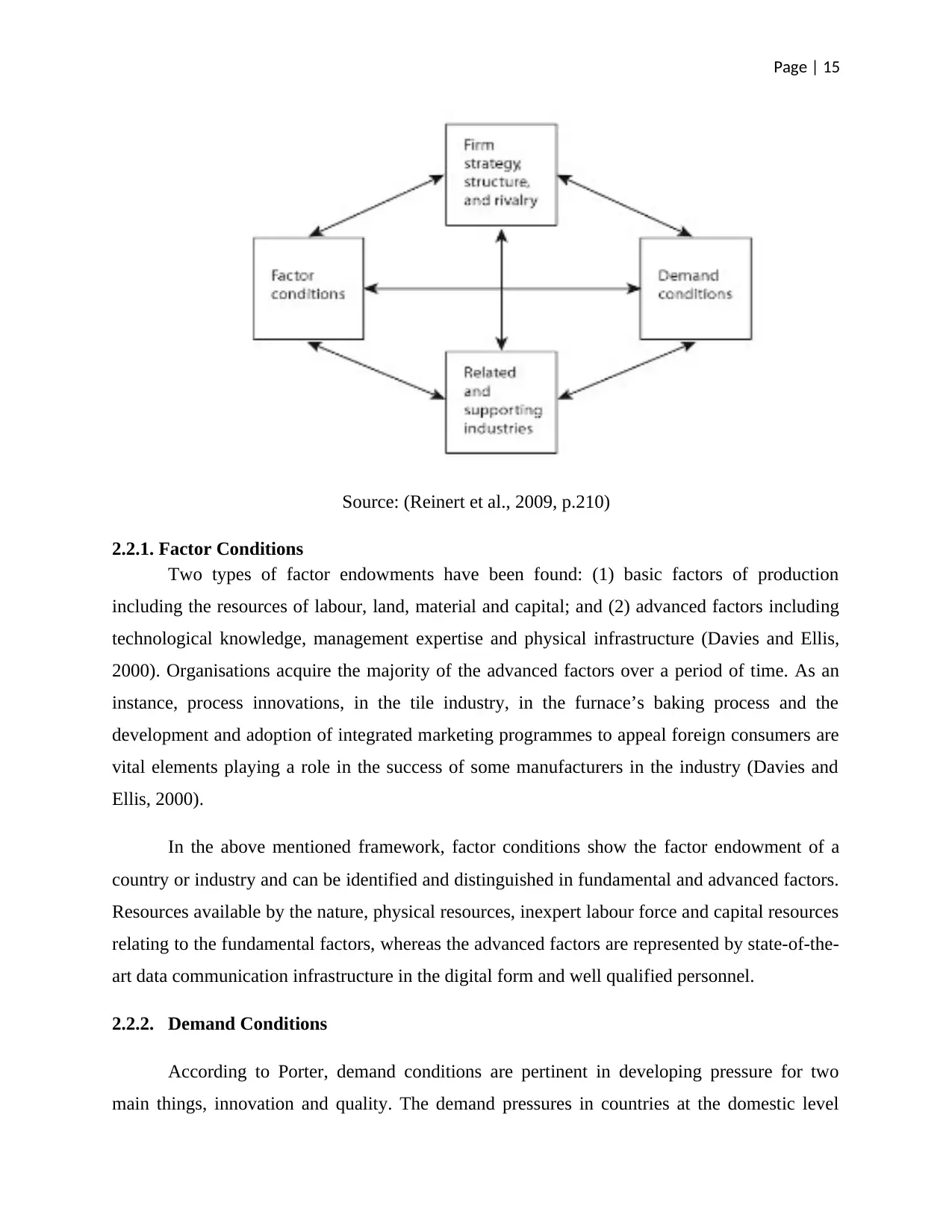
Page | 15
Source: (Reinert et al., 2009, p.210)
2.2.1. Factor Conditions
Two types of factor endowments have been found: (1) basic factors of production
including the resources of labour, land, material and capital; and (2) advanced factors including
technological knowledge, management expertise and physical infrastructure (Davies and Ellis,
2000). Organisations acquire the majority of the advanced factors over a period of time. As an
instance, process innovations, in the tile industry, in the furnace’s baking process and the
development and adoption of integrated marketing programmes to appeal foreign consumers are
vital elements playing a role in the success of some manufacturers in the industry (Davies and
Ellis, 2000).
In the above mentioned framework, factor conditions show the factor endowment of a
country or industry and can be identified and distinguished in fundamental and advanced factors.
Resources available by the nature, physical resources, inexpert labour force and capital resources
relating to the fundamental factors, whereas the advanced factors are represented by state-of-the-
art data communication infrastructure in the digital form and well qualified personnel.
2.2.2. Demand Conditions
According to Porter, demand conditions are pertinent in developing pressure for two
main things, innovation and quality. The demand pressures in countries at the domestic level
Source: (Reinert et al., 2009, p.210)
2.2.1. Factor Conditions
Two types of factor endowments have been found: (1) basic factors of production
including the resources of labour, land, material and capital; and (2) advanced factors including
technological knowledge, management expertise and physical infrastructure (Davies and Ellis,
2000). Organisations acquire the majority of the advanced factors over a period of time. As an
instance, process innovations, in the tile industry, in the furnace’s baking process and the
development and adoption of integrated marketing programmes to appeal foreign consumers are
vital elements playing a role in the success of some manufacturers in the industry (Davies and
Ellis, 2000).
In the above mentioned framework, factor conditions show the factor endowment of a
country or industry and can be identified and distinguished in fundamental and advanced factors.
Resources available by the nature, physical resources, inexpert labour force and capital resources
relating to the fundamental factors, whereas the advanced factors are represented by state-of-the-
art data communication infrastructure in the digital form and well qualified personnel.
2.2.2. Demand Conditions
According to Porter, demand conditions are pertinent in developing pressure for two
main things, innovation and quality. The demand pressures in countries at the domestic level
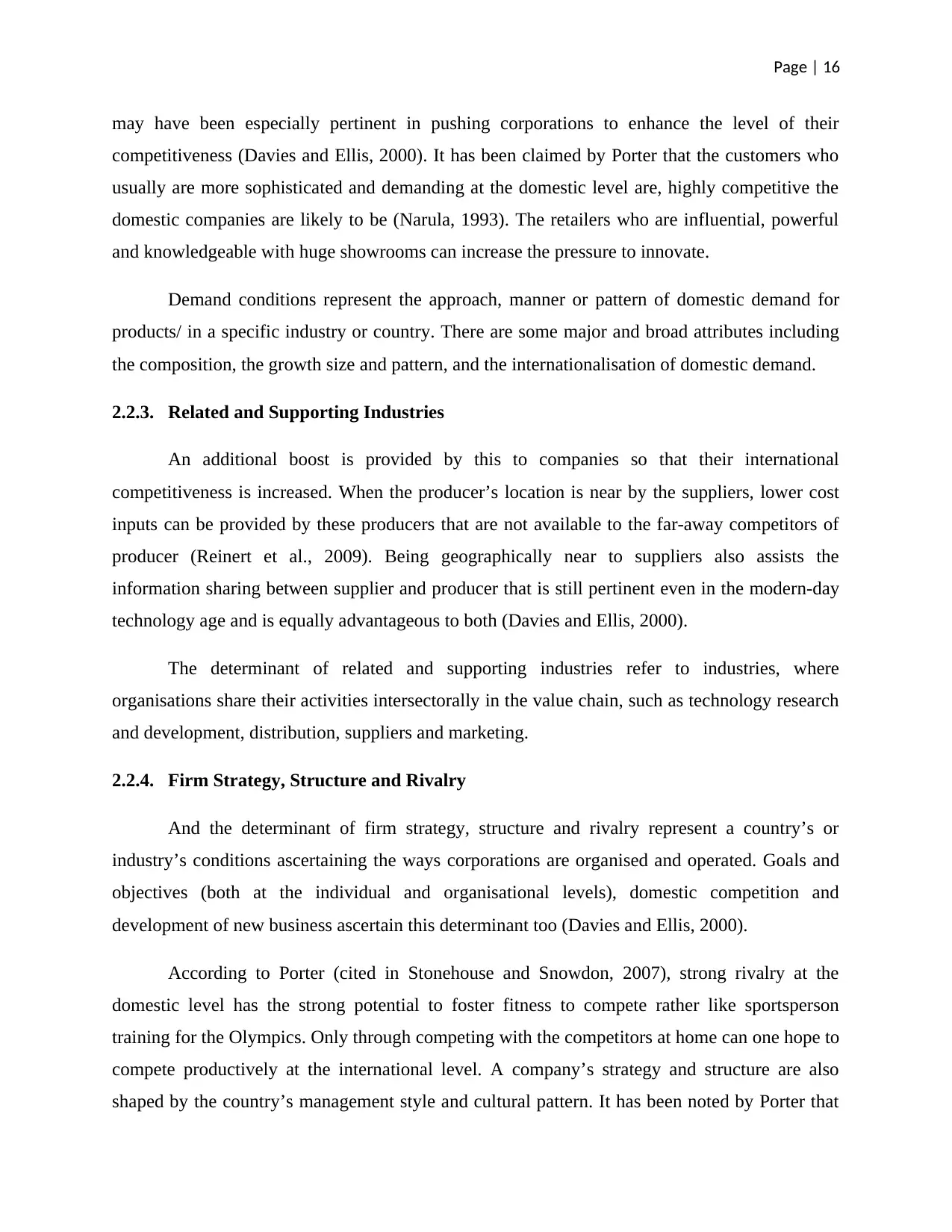
Page | 16
may have been especially pertinent in pushing corporations to enhance the level of their
competitiveness (Davies and Ellis, 2000). It has been claimed by Porter that the customers who
usually are more sophisticated and demanding at the domestic level are, highly competitive the
domestic companies are likely to be (Narula, 1993). The retailers who are influential, powerful
and knowledgeable with huge showrooms can increase the pressure to innovate.
Demand conditions represent the approach, manner or pattern of domestic demand for
products/ in a specific industry or country. There are some major and broad attributes including
the composition, the growth size and pattern, and the internationalisation of domestic demand.
2.2.3. Related and Supporting Industries
An additional boost is provided by this to companies so that their international
competitiveness is increased. When the producer’s location is near by the suppliers, lower cost
inputs can be provided by these producers that are not available to the far-away competitors of
producer (Reinert et al., 2009). Being geographically near to suppliers also assists the
information sharing between supplier and producer that is still pertinent even in the modern-day
technology age and is equally advantageous to both (Davies and Ellis, 2000).
The determinant of related and supporting industries refer to industries, where
organisations share their activities intersectorally in the value chain, such as technology research
and development, distribution, suppliers and marketing.
2.2.4. Firm Strategy, Structure and Rivalry
And the determinant of firm strategy, structure and rivalry represent a country’s or
industry’s conditions ascertaining the ways corporations are organised and operated. Goals and
objectives (both at the individual and organisational levels), domestic competition and
development of new business ascertain this determinant too (Davies and Ellis, 2000).
According to Porter (cited in Stonehouse and Snowdon, 2007), strong rivalry at the
domestic level has the strong potential to foster fitness to compete rather like sportsperson
training for the Olympics. Only through competing with the competitors at home can one hope to
compete productively at the international level. A company’s strategy and structure are also
shaped by the country’s management style and cultural pattern. It has been noted by Porter that
may have been especially pertinent in pushing corporations to enhance the level of their
competitiveness (Davies and Ellis, 2000). It has been claimed by Porter that the customers who
usually are more sophisticated and demanding at the domestic level are, highly competitive the
domestic companies are likely to be (Narula, 1993). The retailers who are influential, powerful
and knowledgeable with huge showrooms can increase the pressure to innovate.
Demand conditions represent the approach, manner or pattern of domestic demand for
products/ in a specific industry or country. There are some major and broad attributes including
the composition, the growth size and pattern, and the internationalisation of domestic demand.
2.2.3. Related and Supporting Industries
An additional boost is provided by this to companies so that their international
competitiveness is increased. When the producer’s location is near by the suppliers, lower cost
inputs can be provided by these producers that are not available to the far-away competitors of
producer (Reinert et al., 2009). Being geographically near to suppliers also assists the
information sharing between supplier and producer that is still pertinent even in the modern-day
technology age and is equally advantageous to both (Davies and Ellis, 2000).
The determinant of related and supporting industries refer to industries, where
organisations share their activities intersectorally in the value chain, such as technology research
and development, distribution, suppliers and marketing.
2.2.4. Firm Strategy, Structure and Rivalry
And the determinant of firm strategy, structure and rivalry represent a country’s or
industry’s conditions ascertaining the ways corporations are organised and operated. Goals and
objectives (both at the individual and organisational levels), domestic competition and
development of new business ascertain this determinant too (Davies and Ellis, 2000).
According to Porter (cited in Stonehouse and Snowdon, 2007), strong rivalry at the
domestic level has the strong potential to foster fitness to compete rather like sportsperson
training for the Olympics. Only through competing with the competitors at home can one hope to
compete productively at the international level. A company’s strategy and structure are also
shaped by the country’s management style and cultural pattern. It has been noted by Porter that
Secure Best Marks with AI Grader
Need help grading? Try our AI Grader for instant feedback on your assignments.
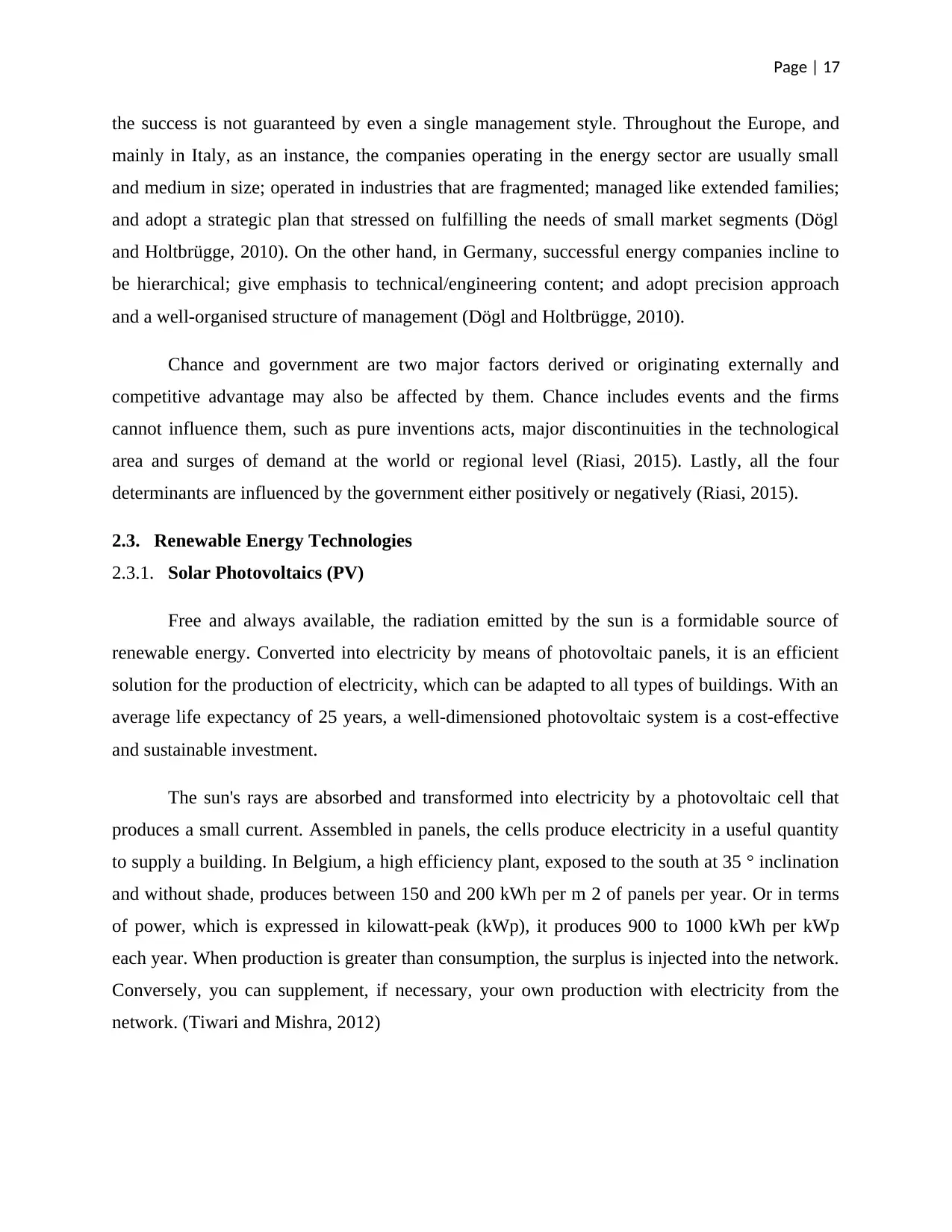
Page | 17
the success is not guaranteed by even a single management style. Throughout the Europe, and
mainly in Italy, as an instance, the companies operating in the energy sector are usually small
and medium in size; operated in industries that are fragmented; managed like extended families;
and adopt a strategic plan that stressed on fulfilling the needs of small market segments (Dögl
and Holtbrügge, 2010). On the other hand, in Germany, successful energy companies incline to
be hierarchical; give emphasis to technical/engineering content; and adopt precision approach
and a well-organised structure of management (Dögl and Holtbrügge, 2010).
Chance and government are two major factors derived or originating externally and
competitive advantage may also be affected by them. Chance includes events and the firms
cannot influence them, such as pure inventions acts, major discontinuities in the technological
area and surges of demand at the world or regional level (Riasi, 2015). Lastly, all the four
determinants are influenced by the government either positively or negatively (Riasi, 2015).
2.3. Renewable Energy Technologies
2.3.1. Solar Photovoltaics (PV)
Free and always available, the radiation emitted by the sun is a formidable source of
renewable energy. Converted into electricity by means of photovoltaic panels, it is an efficient
solution for the production of electricity, which can be adapted to all types of buildings. With an
average life expectancy of 25 years, a well-dimensioned photovoltaic system is a cost-effective
and sustainable investment.
The sun's rays are absorbed and transformed into electricity by a photovoltaic cell that
produces a small current. Assembled in panels, the cells produce electricity in a useful quantity
to supply a building. In Belgium, a high efficiency plant, exposed to the south at 35 ° inclination
and without shade, produces between 150 and 200 kWh per m 2 of panels per year. Or in terms
of power, which is expressed in kilowatt-peak (kWp), it produces 900 to 1000 kWh per kWp
each year. When production is greater than consumption, the surplus is injected into the network.
Conversely, you can supplement, if necessary, your own production with electricity from the
network. (Tiwari and Mishra, 2012)
the success is not guaranteed by even a single management style. Throughout the Europe, and
mainly in Italy, as an instance, the companies operating in the energy sector are usually small
and medium in size; operated in industries that are fragmented; managed like extended families;
and adopt a strategic plan that stressed on fulfilling the needs of small market segments (Dögl
and Holtbrügge, 2010). On the other hand, in Germany, successful energy companies incline to
be hierarchical; give emphasis to technical/engineering content; and adopt precision approach
and a well-organised structure of management (Dögl and Holtbrügge, 2010).
Chance and government are two major factors derived or originating externally and
competitive advantage may also be affected by them. Chance includes events and the firms
cannot influence them, such as pure inventions acts, major discontinuities in the technological
area and surges of demand at the world or regional level (Riasi, 2015). Lastly, all the four
determinants are influenced by the government either positively or negatively (Riasi, 2015).
2.3. Renewable Energy Technologies
2.3.1. Solar Photovoltaics (PV)
Free and always available, the radiation emitted by the sun is a formidable source of
renewable energy. Converted into electricity by means of photovoltaic panels, it is an efficient
solution for the production of electricity, which can be adapted to all types of buildings. With an
average life expectancy of 25 years, a well-dimensioned photovoltaic system is a cost-effective
and sustainable investment.
The sun's rays are absorbed and transformed into electricity by a photovoltaic cell that
produces a small current. Assembled in panels, the cells produce electricity in a useful quantity
to supply a building. In Belgium, a high efficiency plant, exposed to the south at 35 ° inclination
and without shade, produces between 150 and 200 kWh per m 2 of panels per year. Or in terms
of power, which is expressed in kilowatt-peak (kWp), it produces 900 to 1000 kWh per kWp
each year. When production is greater than consumption, the surplus is injected into the network.
Conversely, you can supplement, if necessary, your own production with electricity from the
network. (Tiwari and Mishra, 2012)
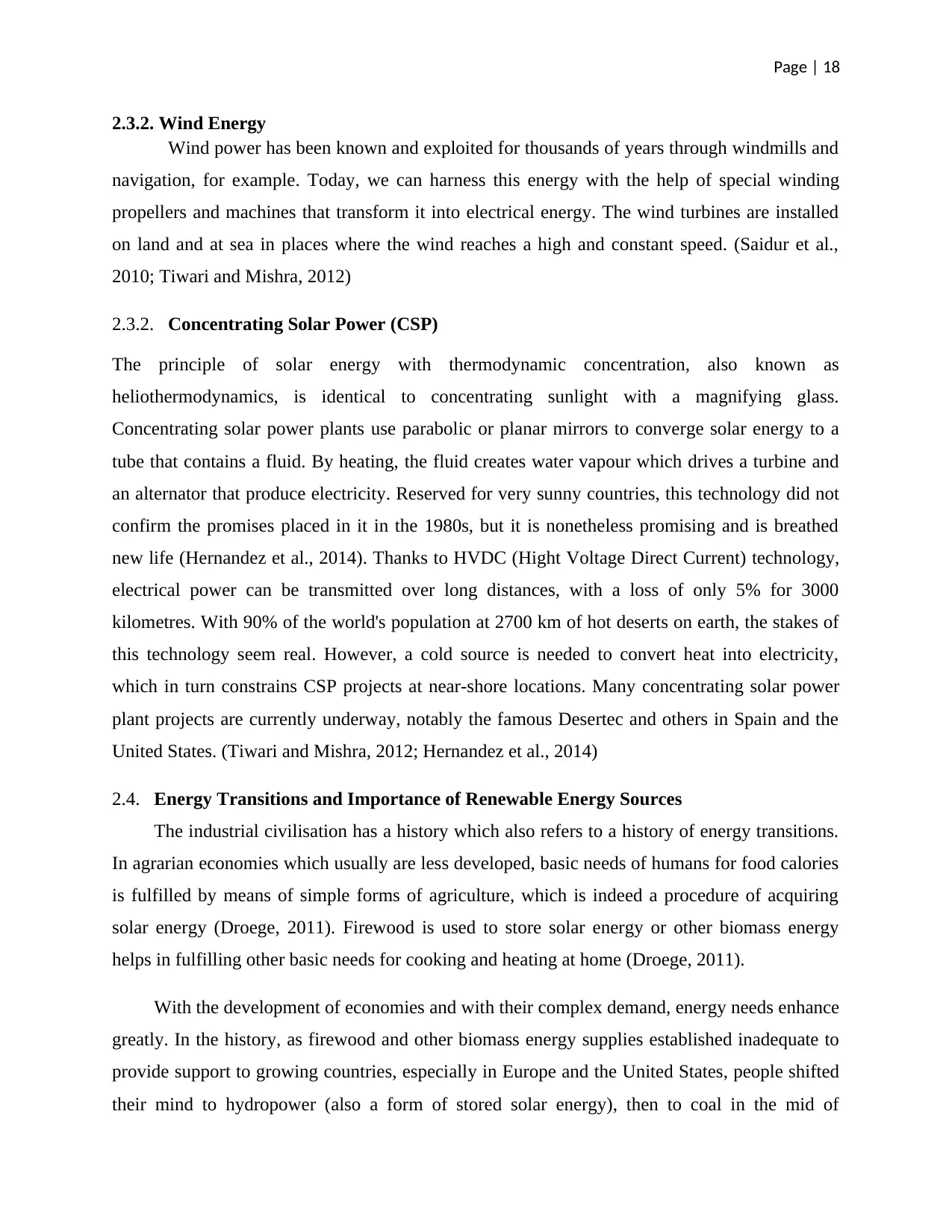
Page | 18
2.3.2. Wind Energy
Wind power has been known and exploited for thousands of years through windmills and
navigation, for example. Today, we can harness this energy with the help of special winding
propellers and machines that transform it into electrical energy. The wind turbines are installed
on land and at sea in places where the wind reaches a high and constant speed. (Saidur et al.,
2010; Tiwari and Mishra, 2012)
2.3.2. Concentrating Solar Power (CSP)
The principle of solar energy with thermodynamic concentration, also known as
heliothermodynamics, is identical to concentrating sunlight with a magnifying glass.
Concentrating solar power plants use parabolic or planar mirrors to converge solar energy to a
tube that contains a fluid. By heating, the fluid creates water vapour which drives a turbine and
an alternator that produce electricity. Reserved for very sunny countries, this technology did not
confirm the promises placed in it in the 1980s, but it is nonetheless promising and is breathed
new life (Hernandez et al., 2014). Thanks to HVDC (Hight Voltage Direct Current) technology,
electrical power can be transmitted over long distances, with a loss of only 5% for 3000
kilometres. With 90% of the world's population at 2700 km of hot deserts on earth, the stakes of
this technology seem real. However, a cold source is needed to convert heat into electricity,
which in turn constrains CSP projects at near-shore locations. Many concentrating solar power
plant projects are currently underway, notably the famous Desertec and others in Spain and the
United States. (Tiwari and Mishra, 2012; Hernandez et al., 2014)
2.4. Energy Transitions and Importance of Renewable Energy Sources
The industrial civilisation has a history which also refers to a history of energy transitions.
In agrarian economies which usually are less developed, basic needs of humans for food calories
is fulfilled by means of simple forms of agriculture, which is indeed a procedure of acquiring
solar energy (Droege, 2011). Firewood is used to store solar energy or other biomass energy
helps in fulfilling other basic needs for cooking and heating at home (Droege, 2011).
With the development of economies and with their complex demand, energy needs enhance
greatly. In the history, as firewood and other biomass energy supplies established inadequate to
provide support to growing countries, especially in Europe and the United States, people shifted
their mind to hydropower (also a form of stored solar energy), then to coal in the mid of
2.3.2. Wind Energy
Wind power has been known and exploited for thousands of years through windmills and
navigation, for example. Today, we can harness this energy with the help of special winding
propellers and machines that transform it into electrical energy. The wind turbines are installed
on land and at sea in places where the wind reaches a high and constant speed. (Saidur et al.,
2010; Tiwari and Mishra, 2012)
2.3.2. Concentrating Solar Power (CSP)
The principle of solar energy with thermodynamic concentration, also known as
heliothermodynamics, is identical to concentrating sunlight with a magnifying glass.
Concentrating solar power plants use parabolic or planar mirrors to converge solar energy to a
tube that contains a fluid. By heating, the fluid creates water vapour which drives a turbine and
an alternator that produce electricity. Reserved for very sunny countries, this technology did not
confirm the promises placed in it in the 1980s, but it is nonetheless promising and is breathed
new life (Hernandez et al., 2014). Thanks to HVDC (Hight Voltage Direct Current) technology,
electrical power can be transmitted over long distances, with a loss of only 5% for 3000
kilometres. With 90% of the world's population at 2700 km of hot deserts on earth, the stakes of
this technology seem real. However, a cold source is needed to convert heat into electricity,
which in turn constrains CSP projects at near-shore locations. Many concentrating solar power
plant projects are currently underway, notably the famous Desertec and others in Spain and the
United States. (Tiwari and Mishra, 2012; Hernandez et al., 2014)
2.4. Energy Transitions and Importance of Renewable Energy Sources
The industrial civilisation has a history which also refers to a history of energy transitions.
In agrarian economies which usually are less developed, basic needs of humans for food calories
is fulfilled by means of simple forms of agriculture, which is indeed a procedure of acquiring
solar energy (Droege, 2011). Firewood is used to store solar energy or other biomass energy
helps in fulfilling other basic needs for cooking and heating at home (Droege, 2011).
With the development of economies and with their complex demand, energy needs enhance
greatly. In the history, as firewood and other biomass energy supplies established inadequate to
provide support to growing countries, especially in Europe and the United States, people shifted
their mind to hydropower (also a form of stored solar energy), then to coal in the mid of
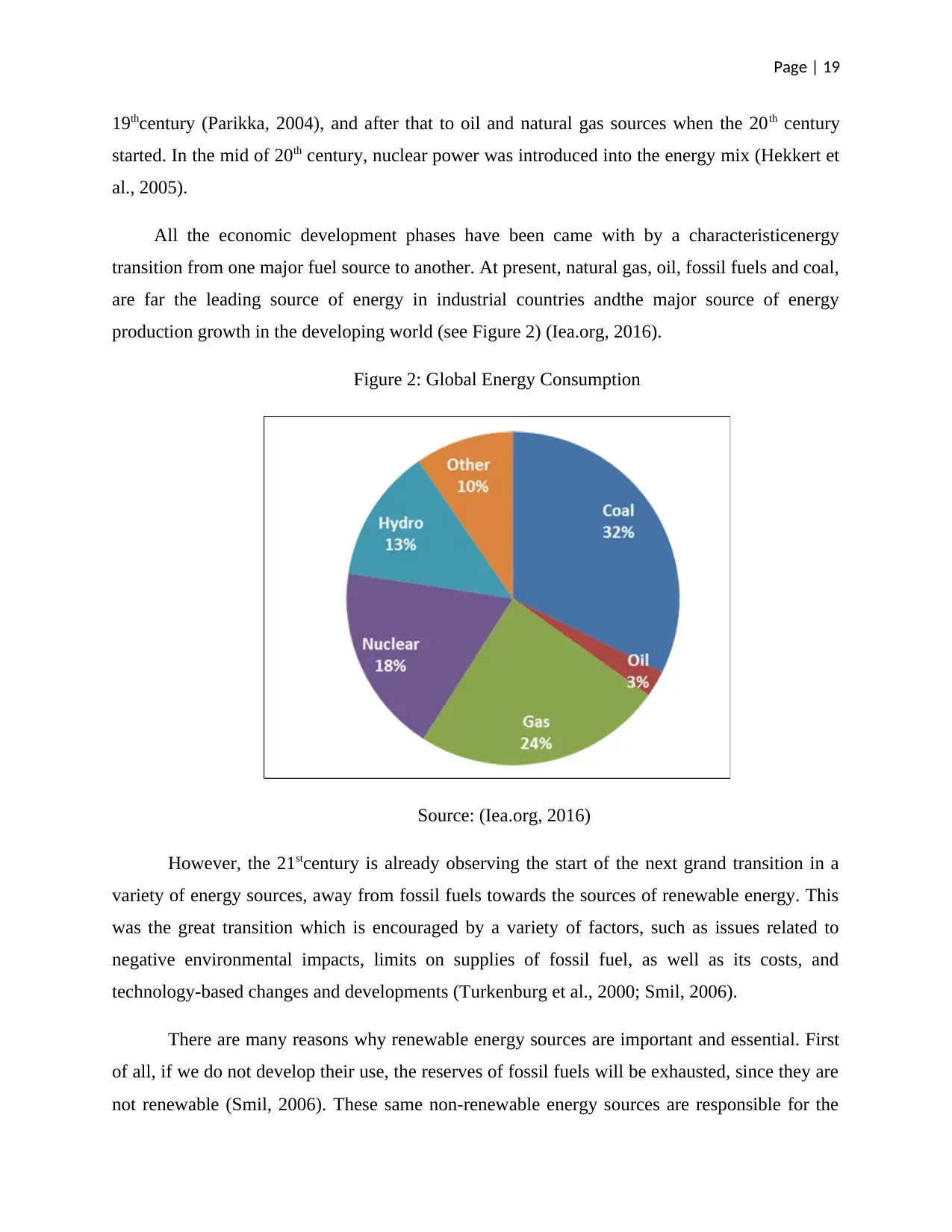
Page | 19
19thcentury (Parikka, 2004), and after that to oil and natural gas sources when the 20th century
started. In the mid of 20th century, nuclear power was introduced into the energy mix (Hekkert et
al., 2005).
All the economic development phases have been came with by a characteristicenergy
transition from one major fuel source to another. At present, natural gas, oil, fossil fuels and coal,
are far the leading source of energy in industrial countries andthe major source of energy
production growth in the developing world (see Figure 2) (Iea.org, 2016).
Figure 2: Global Energy Consumption
Source: (Iea.org, 2016)
However, the 21stcentury is already observing the start of the next grand transition in a
variety of energy sources, away from fossil fuels towards the sources of renewable energy. This
was the great transition which is encouraged by a variety of factors, such as issues related to
negative environmental impacts, limits on supplies of fossil fuel, as well as its costs, and
technology-based changes and developments (Turkenburg et al., 2000; Smil, 2006).
There are many reasons why renewable energy sources are important and essential. First
of all, if we do not develop their use, the reserves of fossil fuels will be exhausted, since they are
not renewable (Smil, 2006). These same non-renewable energy sources are responsible for the
19thcentury (Parikka, 2004), and after that to oil and natural gas sources when the 20th century
started. In the mid of 20th century, nuclear power was introduced into the energy mix (Hekkert et
al., 2005).
All the economic development phases have been came with by a characteristicenergy
transition from one major fuel source to another. At present, natural gas, oil, fossil fuels and coal,
are far the leading source of energy in industrial countries andthe major source of energy
production growth in the developing world (see Figure 2) (Iea.org, 2016).
Figure 2: Global Energy Consumption
Source: (Iea.org, 2016)
However, the 21stcentury is already observing the start of the next grand transition in a
variety of energy sources, away from fossil fuels towards the sources of renewable energy. This
was the great transition which is encouraged by a variety of factors, such as issues related to
negative environmental impacts, limits on supplies of fossil fuel, as well as its costs, and
technology-based changes and developments (Turkenburg et al., 2000; Smil, 2006).
There are many reasons why renewable energy sources are important and essential. First
of all, if we do not develop their use, the reserves of fossil fuels will be exhausted, since they are
not renewable (Smil, 2006). These same non-renewable energy sources are responsible for the
Paraphrase This Document
Need a fresh take? Get an instant paraphrase of this document with our AI Paraphraser
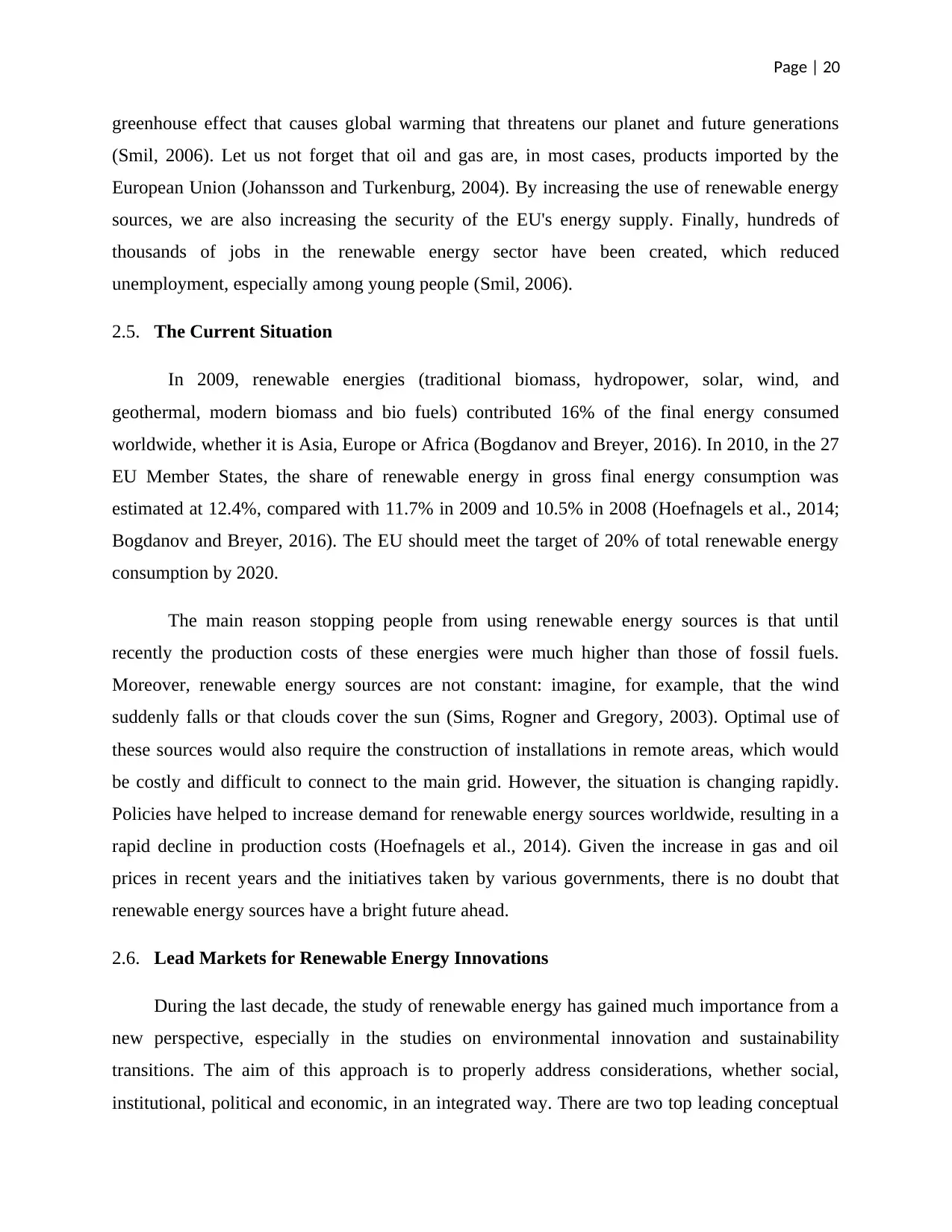
Page | 20
greenhouse effect that causes global warming that threatens our planet and future generations
(Smil, 2006). Let us not forget that oil and gas are, in most cases, products imported by the
European Union (Johansson and Turkenburg, 2004). By increasing the use of renewable energy
sources, we are also increasing the security of the EU's energy supply. Finally, hundreds of
thousands of jobs in the renewable energy sector have been created, which reduced
unemployment, especially among young people (Smil, 2006).
2.5. The Current Situation
In 2009, renewable energies (traditional biomass, hydropower, solar, wind, and
geothermal, modern biomass and bio fuels) contributed 16% of the final energy consumed
worldwide, whether it is Asia, Europe or Africa (Bogdanov and Breyer, 2016). In 2010, in the 27
EU Member States, the share of renewable energy in gross final energy consumption was
estimated at 12.4%, compared with 11.7% in 2009 and 10.5% in 2008 (Hoefnagels et al., 2014;
Bogdanov and Breyer, 2016). The EU should meet the target of 20% of total renewable energy
consumption by 2020.
The main reason stopping people from using renewable energy sources is that until
recently the production costs of these energies were much higher than those of fossil fuels.
Moreover, renewable energy sources are not constant: imagine, for example, that the wind
suddenly falls or that clouds cover the sun (Sims, Rogner and Gregory, 2003). Optimal use of
these sources would also require the construction of installations in remote areas, which would
be costly and difficult to connect to the main grid. However, the situation is changing rapidly.
Policies have helped to increase demand for renewable energy sources worldwide, resulting in a
rapid decline in production costs (Hoefnagels et al., 2014). Given the increase in gas and oil
prices in recent years and the initiatives taken by various governments, there is no doubt that
renewable energy sources have a bright future ahead.
2.6. Lead Markets for Renewable Energy Innovations
During the last decade, the study of renewable energy has gained much importance from a
new perspective, especially in the studies on environmental innovation and sustainability
transitions. The aim of this approach is to properly address considerations, whether social,
institutional, political and economic, in an integrated way. There are two top leading conceptual
greenhouse effect that causes global warming that threatens our planet and future generations
(Smil, 2006). Let us not forget that oil and gas are, in most cases, products imported by the
European Union (Johansson and Turkenburg, 2004). By increasing the use of renewable energy
sources, we are also increasing the security of the EU's energy supply. Finally, hundreds of
thousands of jobs in the renewable energy sector have been created, which reduced
unemployment, especially among young people (Smil, 2006).
2.5. The Current Situation
In 2009, renewable energies (traditional biomass, hydropower, solar, wind, and
geothermal, modern biomass and bio fuels) contributed 16% of the final energy consumed
worldwide, whether it is Asia, Europe or Africa (Bogdanov and Breyer, 2016). In 2010, in the 27
EU Member States, the share of renewable energy in gross final energy consumption was
estimated at 12.4%, compared with 11.7% in 2009 and 10.5% in 2008 (Hoefnagels et al., 2014;
Bogdanov and Breyer, 2016). The EU should meet the target of 20% of total renewable energy
consumption by 2020.
The main reason stopping people from using renewable energy sources is that until
recently the production costs of these energies were much higher than those of fossil fuels.
Moreover, renewable energy sources are not constant: imagine, for example, that the wind
suddenly falls or that clouds cover the sun (Sims, Rogner and Gregory, 2003). Optimal use of
these sources would also require the construction of installations in remote areas, which would
be costly and difficult to connect to the main grid. However, the situation is changing rapidly.
Policies have helped to increase demand for renewable energy sources worldwide, resulting in a
rapid decline in production costs (Hoefnagels et al., 2014). Given the increase in gas and oil
prices in recent years and the initiatives taken by various governments, there is no doubt that
renewable energy sources have a bright future ahead.
2.6. Lead Markets for Renewable Energy Innovations
During the last decade, the study of renewable energy has gained much importance from a
new perspective, especially in the studies on environmental innovation and sustainability
transitions. The aim of this approach is to properly address considerations, whether social,
institutional, political and economic, in an integrated way. There are two top leading conceptual
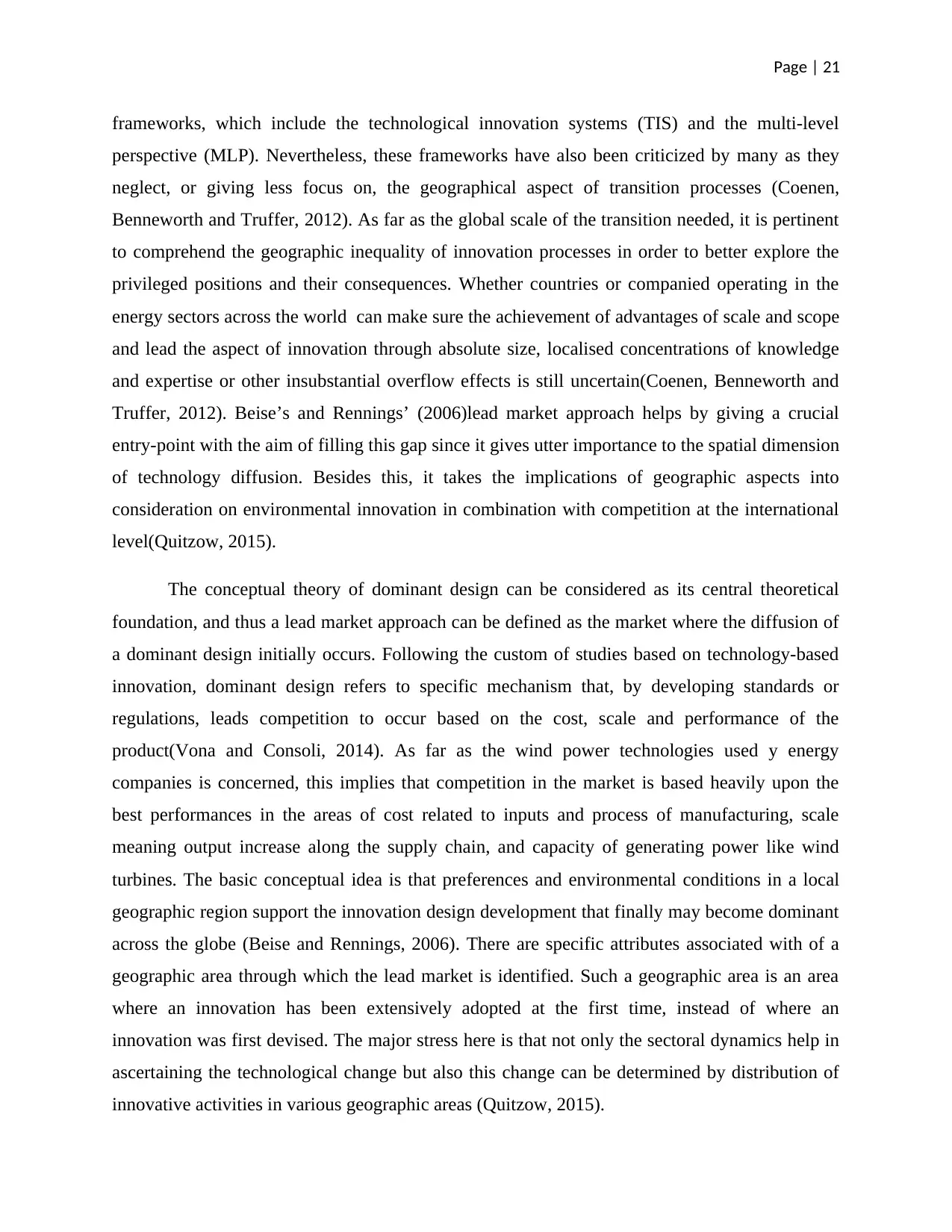
Page | 21
frameworks, which include the technological innovation systems (TIS) and the multi-level
perspective (MLP). Nevertheless, these frameworks have also been criticized by many as they
neglect, or giving less focus on, the geographical aspect of transition processes (Coenen,
Benneworth and Truffer, 2012). As far as the global scale of the transition needed, it is pertinent
to comprehend the geographic inequality of innovation processes in order to better explore the
privileged positions and their consequences. Whether countries or companied operating in the
energy sectors across the world can make sure the achievement of advantages of scale and scope
and lead the aspect of innovation through absolute size, localised concentrations of knowledge
and expertise or other insubstantial overflow effects is still uncertain(Coenen, Benneworth and
Truffer, 2012). Beise’s and Rennings’ (2006)lead market approach helps by giving a crucial
entry-point with the aim of filling this gap since it gives utter importance to the spatial dimension
of technology diffusion. Besides this, it takes the implications of geographic aspects into
consideration on environmental innovation in combination with competition at the international
level(Quitzow, 2015).
The conceptual theory of dominant design can be considered as its central theoretical
foundation, and thus a lead market approach can be defined as the market where the diffusion of
a dominant design initially occurs. Following the custom of studies based on technology-based
innovation, dominant design refers to specific mechanism that, by developing standards or
regulations, leads competition to occur based on the cost, scale and performance of the
product(Vona and Consoli, 2014). As far as the wind power technologies used y energy
companies is concerned, this implies that competition in the market is based heavily upon the
best performances in the areas of cost related to inputs and process of manufacturing, scale
meaning output increase along the supply chain, and capacity of generating power like wind
turbines. The basic conceptual idea is that preferences and environmental conditions in a local
geographic region support the innovation design development that finally may become dominant
across the globe (Beise and Rennings, 2006). There are specific attributes associated with of a
geographic area through which the lead market is identified. Such a geographic area is an area
where an innovation has been extensively adopted at the first time, instead of where an
innovation was first devised. The major stress here is that not only the sectoral dynamics help in
ascertaining the technological change but also this change can be determined by distribution of
innovative activities in various geographic areas (Quitzow, 2015).
frameworks, which include the technological innovation systems (TIS) and the multi-level
perspective (MLP). Nevertheless, these frameworks have also been criticized by many as they
neglect, or giving less focus on, the geographical aspect of transition processes (Coenen,
Benneworth and Truffer, 2012). As far as the global scale of the transition needed, it is pertinent
to comprehend the geographic inequality of innovation processes in order to better explore the
privileged positions and their consequences. Whether countries or companied operating in the
energy sectors across the world can make sure the achievement of advantages of scale and scope
and lead the aspect of innovation through absolute size, localised concentrations of knowledge
and expertise or other insubstantial overflow effects is still uncertain(Coenen, Benneworth and
Truffer, 2012). Beise’s and Rennings’ (2006)lead market approach helps by giving a crucial
entry-point with the aim of filling this gap since it gives utter importance to the spatial dimension
of technology diffusion. Besides this, it takes the implications of geographic aspects into
consideration on environmental innovation in combination with competition at the international
level(Quitzow, 2015).
The conceptual theory of dominant design can be considered as its central theoretical
foundation, and thus a lead market approach can be defined as the market where the diffusion of
a dominant design initially occurs. Following the custom of studies based on technology-based
innovation, dominant design refers to specific mechanism that, by developing standards or
regulations, leads competition to occur based on the cost, scale and performance of the
product(Vona and Consoli, 2014). As far as the wind power technologies used y energy
companies is concerned, this implies that competition in the market is based heavily upon the
best performances in the areas of cost related to inputs and process of manufacturing, scale
meaning output increase along the supply chain, and capacity of generating power like wind
turbines. The basic conceptual idea is that preferences and environmental conditions in a local
geographic region support the innovation design development that finally may become dominant
across the globe (Beise and Rennings, 2006). There are specific attributes associated with of a
geographic area through which the lead market is identified. Such a geographic area is an area
where an innovation has been extensively adopted at the first time, instead of where an
innovation was first devised. The major stress here is that not only the sectoral dynamics help in
ascertaining the technological change but also this change can be determined by distribution of
innovative activities in various geographic areas (Quitzow, 2015).
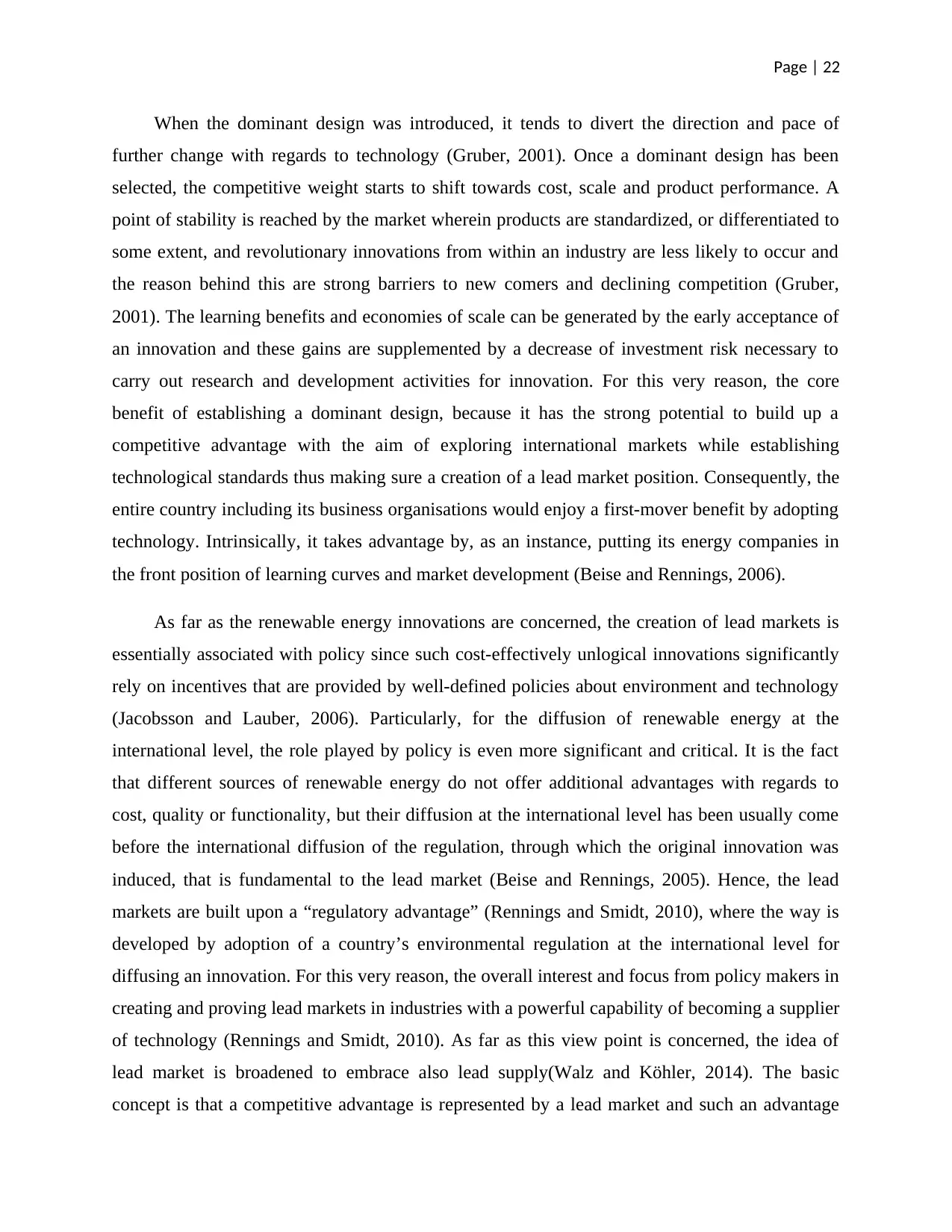
Page | 22
When the dominant design was introduced, it tends to divert the direction and pace of
further change with regards to technology (Gruber, 2001). Once a dominant design has been
selected, the competitive weight starts to shift towards cost, scale and product performance. A
point of stability is reached by the market wherein products are standardized, or differentiated to
some extent, and revolutionary innovations from within an industry are less likely to occur and
the reason behind this are strong barriers to new comers and declining competition (Gruber,
2001). The learning benefits and economies of scale can be generated by the early acceptance of
an innovation and these gains are supplemented by a decrease of investment risk necessary to
carry out research and development activities for innovation. For this very reason, the core
benefit of establishing a dominant design, because it has the strong potential to build up a
competitive advantage with the aim of exploring international markets while establishing
technological standards thus making sure a creation of a lead market position. Consequently, the
entire country including its business organisations would enjoy a first-mover benefit by adopting
technology. Intrinsically, it takes advantage by, as an instance, putting its energy companies in
the front position of learning curves and market development (Beise and Rennings, 2006).
As far as the renewable energy innovations are concerned, the creation of lead markets is
essentially associated with policy since such cost-effectively unlogical innovations significantly
rely on incentives that are provided by well-defined policies about environment and technology
(Jacobsson and Lauber, 2006). Particularly, for the diffusion of renewable energy at the
international level, the role played by policy is even more significant and critical. It is the fact
that different sources of renewable energy do not offer additional advantages with regards to
cost, quality or functionality, but their diffusion at the international level has been usually come
before the international diffusion of the regulation, through which the original innovation was
induced, that is fundamental to the lead market (Beise and Rennings, 2005). Hence, the lead
markets are built upon a “regulatory advantage” (Rennings and Smidt, 2010), where the way is
developed by adoption of a country’s environmental regulation at the international level for
diffusing an innovation. For this very reason, the overall interest and focus from policy makers in
creating and proving lead markets in industries with a powerful capability of becoming a supplier
of technology (Rennings and Smidt, 2010). As far as this view point is concerned, the idea of
lead market is broadened to embrace also lead supply(Walz and Köhler, 2014). The basic
concept is that a competitive advantage is represented by a lead market and such an advantage
When the dominant design was introduced, it tends to divert the direction and pace of
further change with regards to technology (Gruber, 2001). Once a dominant design has been
selected, the competitive weight starts to shift towards cost, scale and product performance. A
point of stability is reached by the market wherein products are standardized, or differentiated to
some extent, and revolutionary innovations from within an industry are less likely to occur and
the reason behind this are strong barriers to new comers and declining competition (Gruber,
2001). The learning benefits and economies of scale can be generated by the early acceptance of
an innovation and these gains are supplemented by a decrease of investment risk necessary to
carry out research and development activities for innovation. For this very reason, the core
benefit of establishing a dominant design, because it has the strong potential to build up a
competitive advantage with the aim of exploring international markets while establishing
technological standards thus making sure a creation of a lead market position. Consequently, the
entire country including its business organisations would enjoy a first-mover benefit by adopting
technology. Intrinsically, it takes advantage by, as an instance, putting its energy companies in
the front position of learning curves and market development (Beise and Rennings, 2006).
As far as the renewable energy innovations are concerned, the creation of lead markets is
essentially associated with policy since such cost-effectively unlogical innovations significantly
rely on incentives that are provided by well-defined policies about environment and technology
(Jacobsson and Lauber, 2006). Particularly, for the diffusion of renewable energy at the
international level, the role played by policy is even more significant and critical. It is the fact
that different sources of renewable energy do not offer additional advantages with regards to
cost, quality or functionality, but their diffusion at the international level has been usually come
before the international diffusion of the regulation, through which the original innovation was
induced, that is fundamental to the lead market (Beise and Rennings, 2005). Hence, the lead
markets are built upon a “regulatory advantage” (Rennings and Smidt, 2010), where the way is
developed by adoption of a country’s environmental regulation at the international level for
diffusing an innovation. For this very reason, the overall interest and focus from policy makers in
creating and proving lead markets in industries with a powerful capability of becoming a supplier
of technology (Rennings and Smidt, 2010). As far as this view point is concerned, the idea of
lead market is broadened to embrace also lead supply(Walz and Köhler, 2014). The basic
concept is that a competitive advantage is represented by a lead market and such an advantage
Secure Best Marks with AI Grader
Need help grading? Try our AI Grader for instant feedback on your assignments.
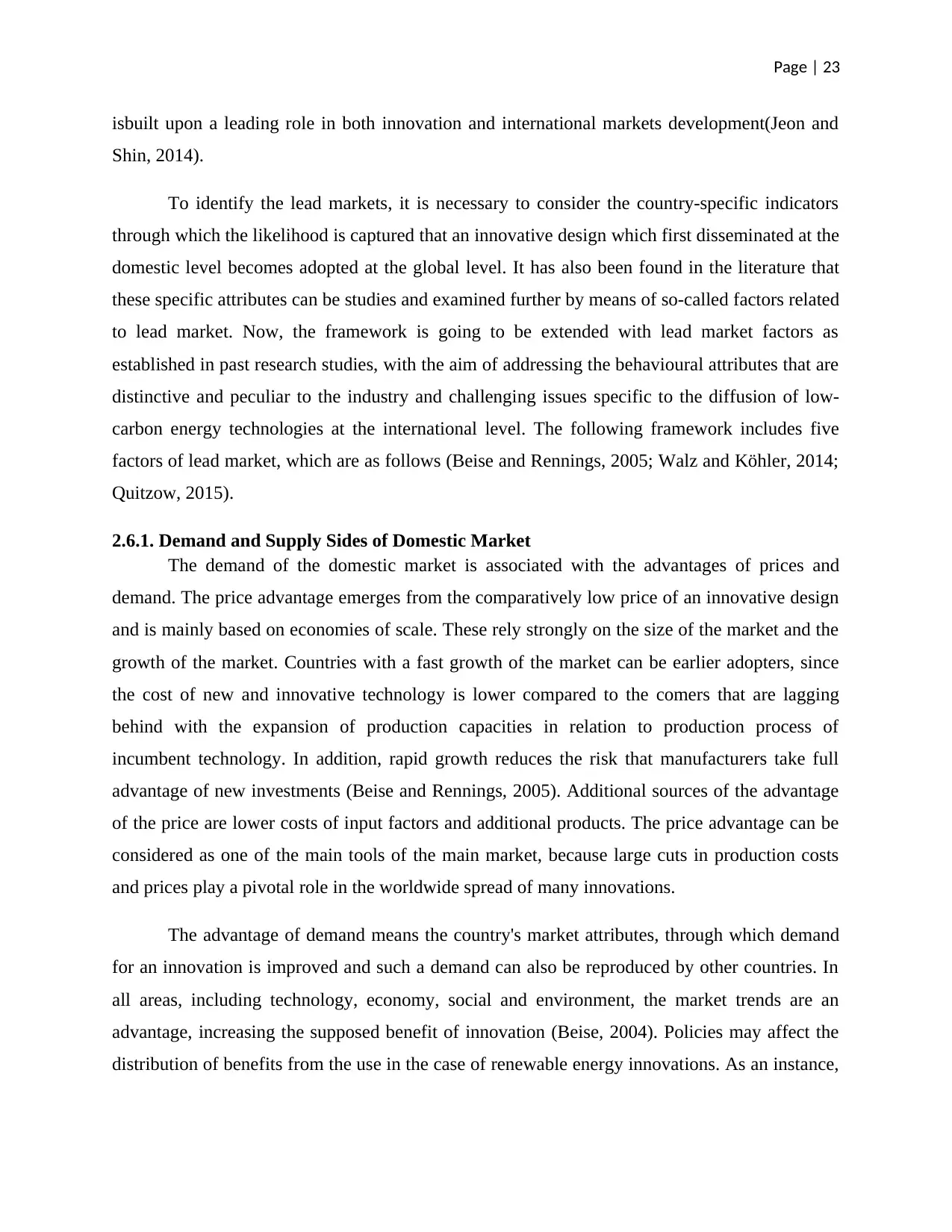
Page | 23
isbuilt upon a leading role in both innovation and international markets development(Jeon and
Shin, 2014).
To identify the lead markets, it is necessary to consider the country-specific indicators
through which the likelihood is captured that an innovative design which first disseminated at the
domestic level becomes adopted at the global level. It has also been found in the literature that
these specific attributes can be studies and examined further by means of so-called factors related
to lead market. Now, the framework is going to be extended with lead market factors as
established in past research studies, with the aim of addressing the behavioural attributes that are
distinctive and peculiar to the industry and challenging issues specific to the diffusion of low-
carbon energy technologies at the international level. The following framework includes five
factors of lead market, which are as follows (Beise and Rennings, 2005; Walz and Köhler, 2014;
Quitzow, 2015).
2.6.1. Demand and Supply Sides of Domestic Market
The demand of the domestic market is associated with the advantages of prices and
demand. The price advantage emerges from the comparatively low price of an innovative design
and is mainly based on economies of scale. These rely strongly on the size of the market and the
growth of the market. Countries with a fast growth of the market can be earlier adopters, since
the cost of new and innovative technology is lower compared to the comers that are lagging
behind with the expansion of production capacities in relation to production process of
incumbent technology. In addition, rapid growth reduces the risk that manufacturers take full
advantage of new investments (Beise and Rennings, 2005). Additional sources of the advantage
of the price are lower costs of input factors and additional products. The price advantage can be
considered as one of the main tools of the main market, because large cuts in production costs
and prices play a pivotal role in the worldwide spread of many innovations.
The advantage of demand means the country's market attributes, through which demand
for an innovation is improved and such a demand can also be reproduced by other countries. In
all areas, including technology, economy, social and environment, the market trends are an
advantage, increasing the supposed benefit of innovation (Beise, 2004). Policies may affect the
distribution of benefits from the use in the case of renewable energy innovations. As an instance,
isbuilt upon a leading role in both innovation and international markets development(Jeon and
Shin, 2014).
To identify the lead markets, it is necessary to consider the country-specific indicators
through which the likelihood is captured that an innovative design which first disseminated at the
domestic level becomes adopted at the global level. It has also been found in the literature that
these specific attributes can be studies and examined further by means of so-called factors related
to lead market. Now, the framework is going to be extended with lead market factors as
established in past research studies, with the aim of addressing the behavioural attributes that are
distinctive and peculiar to the industry and challenging issues specific to the diffusion of low-
carbon energy technologies at the international level. The following framework includes five
factors of lead market, which are as follows (Beise and Rennings, 2005; Walz and Köhler, 2014;
Quitzow, 2015).
2.6.1. Demand and Supply Sides of Domestic Market
The demand of the domestic market is associated with the advantages of prices and
demand. The price advantage emerges from the comparatively low price of an innovative design
and is mainly based on economies of scale. These rely strongly on the size of the market and the
growth of the market. Countries with a fast growth of the market can be earlier adopters, since
the cost of new and innovative technology is lower compared to the comers that are lagging
behind with the expansion of production capacities in relation to production process of
incumbent technology. In addition, rapid growth reduces the risk that manufacturers take full
advantage of new investments (Beise and Rennings, 2005). Additional sources of the advantage
of the price are lower costs of input factors and additional products. The price advantage can be
considered as one of the main tools of the main market, because large cuts in production costs
and prices play a pivotal role in the worldwide spread of many innovations.
The advantage of demand means the country's market attributes, through which demand
for an innovation is improved and such a demand can also be reproduced by other countries. In
all areas, including technology, economy, social and environment, the market trends are an
advantage, increasing the supposed benefit of innovation (Beise, 2004). Policies may affect the
distribution of benefits from the use in the case of renewable energy innovations. As an instance,
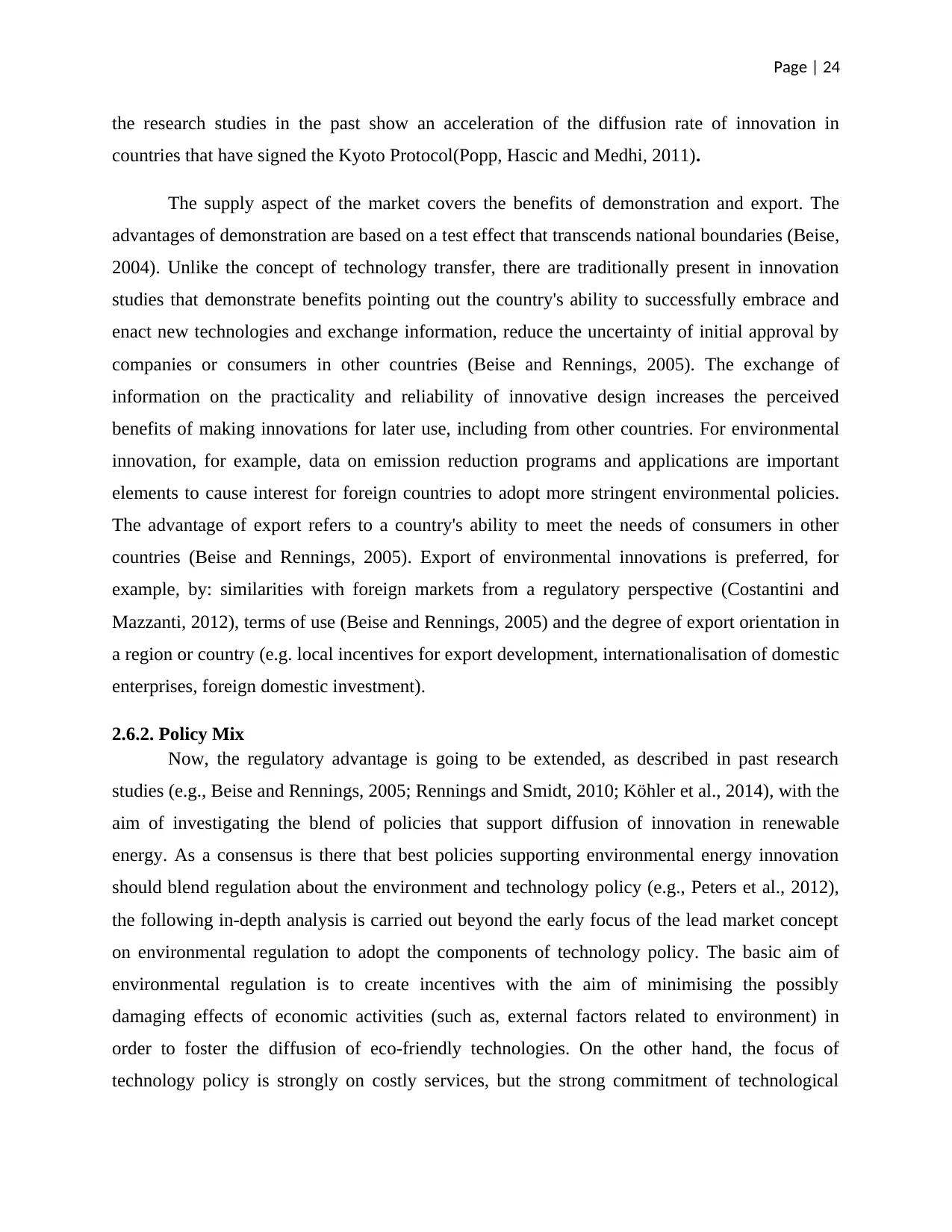
Page | 24
the research studies in the past show an acceleration of the diffusion rate of innovation in
countries that have signed the Kyoto Protocol(Popp, Hascic and Medhi, 2011).
The supply aspect of the market covers the benefits of demonstration and export. The
advantages of demonstration are based on a test effect that transcends national boundaries (Beise,
2004). Unlike the concept of technology transfer, there are traditionally present in innovation
studies that demonstrate benefits pointing out the country's ability to successfully embrace and
enact new technologies and exchange information, reduce the uncertainty of initial approval by
companies or consumers in other countries (Beise and Rennings, 2005). The exchange of
information on the practicality and reliability of innovative design increases the perceived
benefits of making innovations for later use, including from other countries. For environmental
innovation, for example, data on emission reduction programs and applications are important
elements to cause interest for foreign countries to adopt more stringent environmental policies.
The advantage of export refers to a country's ability to meet the needs of consumers in other
countries (Beise and Rennings, 2005). Export of environmental innovations is preferred, for
example, by: similarities with foreign markets from a regulatory perspective (Costantini and
Mazzanti, 2012), terms of use (Beise and Rennings, 2005) and the degree of export orientation in
a region or country (e.g. local incentives for export development, internationalisation of domestic
enterprises, foreign domestic investment).
2.6.2. Policy Mix
Now, the regulatory advantage is going to be extended, as described in past research
studies (e.g., Beise and Rennings, 2005; Rennings and Smidt, 2010; Köhler et al., 2014), with the
aim of investigating the blend of policies that support diffusion of innovation in renewable
energy. As a consensus is there that best policies supporting environmental energy innovation
should blend regulation about the environment and technology policy (e.g., Peters et al., 2012),
the following in-depth analysis is carried out beyond the early focus of the lead market concept
on environmental regulation to adopt the components of technology policy. The basic aim of
environmental regulation is to create incentives with the aim of minimising the possibly
damaging effects of economic activities (such as, external factors related to environment) in
order to foster the diffusion of eco-friendly technologies. On the other hand, the focus of
technology policy is strongly on costly services, but the strong commitment of technological
the research studies in the past show an acceleration of the diffusion rate of innovation in
countries that have signed the Kyoto Protocol(Popp, Hascic and Medhi, 2011).
The supply aspect of the market covers the benefits of demonstration and export. The
advantages of demonstration are based on a test effect that transcends national boundaries (Beise,
2004). Unlike the concept of technology transfer, there are traditionally present in innovation
studies that demonstrate benefits pointing out the country's ability to successfully embrace and
enact new technologies and exchange information, reduce the uncertainty of initial approval by
companies or consumers in other countries (Beise and Rennings, 2005). The exchange of
information on the practicality and reliability of innovative design increases the perceived
benefits of making innovations for later use, including from other countries. For environmental
innovation, for example, data on emission reduction programs and applications are important
elements to cause interest for foreign countries to adopt more stringent environmental policies.
The advantage of export refers to a country's ability to meet the needs of consumers in other
countries (Beise and Rennings, 2005). Export of environmental innovations is preferred, for
example, by: similarities with foreign markets from a regulatory perspective (Costantini and
Mazzanti, 2012), terms of use (Beise and Rennings, 2005) and the degree of export orientation in
a region or country (e.g. local incentives for export development, internationalisation of domestic
enterprises, foreign domestic investment).
2.6.2. Policy Mix
Now, the regulatory advantage is going to be extended, as described in past research
studies (e.g., Beise and Rennings, 2005; Rennings and Smidt, 2010; Köhler et al., 2014), with the
aim of investigating the blend of policies that support diffusion of innovation in renewable
energy. As a consensus is there that best policies supporting environmental energy innovation
should blend regulation about the environment and technology policy (e.g., Peters et al., 2012),
the following in-depth analysis is carried out beyond the early focus of the lead market concept
on environmental regulation to adopt the components of technology policy. The basic aim of
environmental regulation is to create incentives with the aim of minimising the possibly
damaging effects of economic activities (such as, external factors related to environment) in
order to foster the diffusion of eco-friendly technologies. On the other hand, the focus of
technology policy is strongly on costly services, but the strong commitment of technological
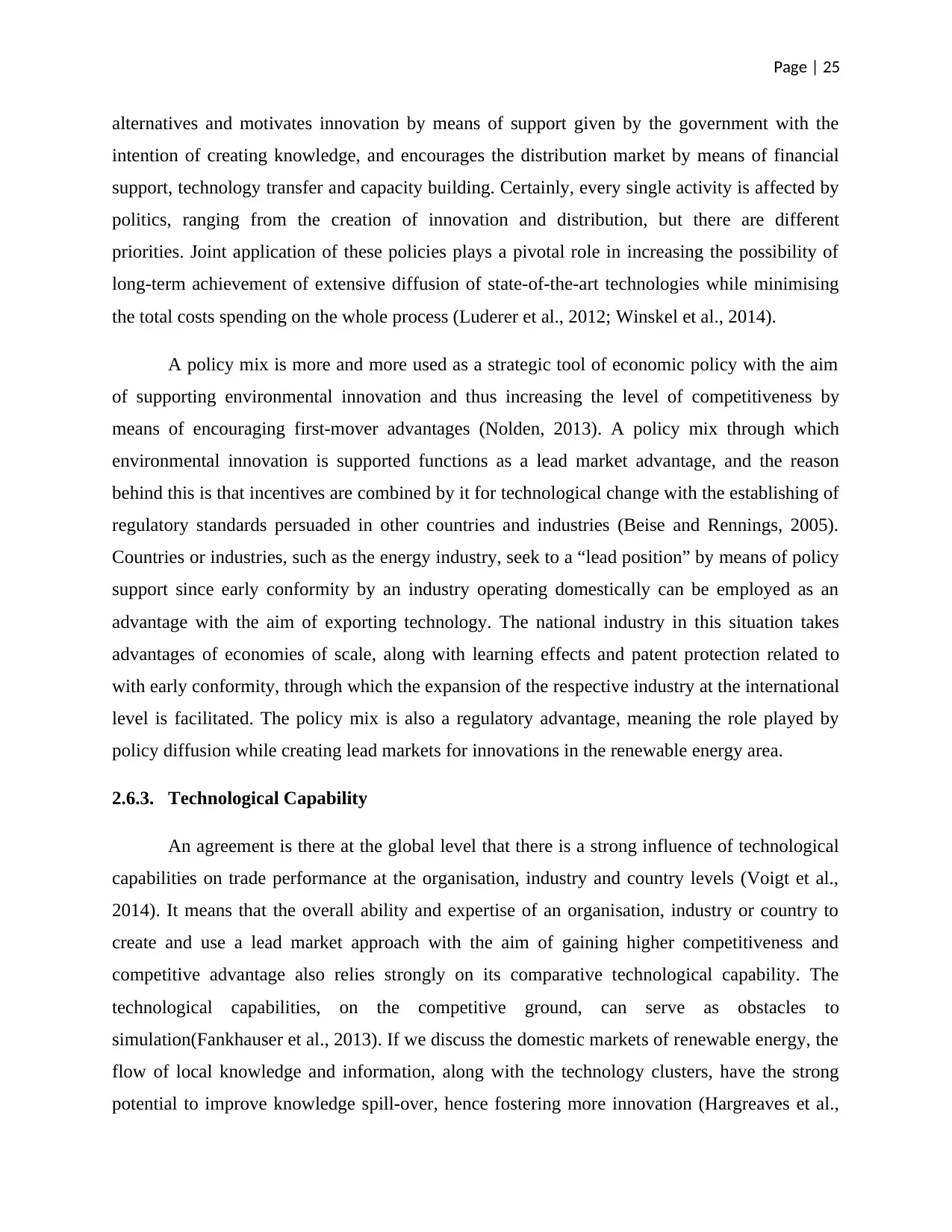
Page | 25
alternatives and motivates innovation by means of support given by the government with the
intention of creating knowledge, and encourages the distribution market by means of financial
support, technology transfer and capacity building. Certainly, every single activity is affected by
politics, ranging from the creation of innovation and distribution, but there are different
priorities. Joint application of these policies plays a pivotal role in increasing the possibility of
long-term achievement of extensive diffusion of state-of-the-art technologies while minimising
the total costs spending on the whole process (Luderer et al., 2012; Winskel et al., 2014).
A policy mix is more and more used as a strategic tool of economic policy with the aim
of supporting environmental innovation and thus increasing the level of competitiveness by
means of encouraging first-mover advantages (Nolden, 2013). A policy mix through which
environmental innovation is supported functions as a lead market advantage, and the reason
behind this is that incentives are combined by it for technological change with the establishing of
regulatory standards persuaded in other countries and industries (Beise and Rennings, 2005).
Countries or industries, such as the energy industry, seek to a “lead position” by means of policy
support since early conformity by an industry operating domestically can be employed as an
advantage with the aim of exporting technology. The national industry in this situation takes
advantages of economies of scale, along with learning effects and patent protection related to
with early conformity, through which the expansion of the respective industry at the international
level is facilitated. The policy mix is also a regulatory advantage, meaning the role played by
policy diffusion while creating lead markets for innovations in the renewable energy area.
2.6.3. Technological Capability
An agreement is there at the global level that there is a strong influence of technological
capabilities on trade performance at the organisation, industry and country levels (Voigt et al.,
2014). It means that the overall ability and expertise of an organisation, industry or country to
create and use a lead market approach with the aim of gaining higher competitiveness and
competitive advantage also relies strongly on its comparative technological capability. The
technological capabilities, on the competitive ground, can serve as obstacles to
simulation(Fankhauser et al., 2013). If we discuss the domestic markets of renewable energy, the
flow of local knowledge and information, along with the technology clusters, have the strong
potential to improve knowledge spill-over, hence fostering more innovation (Hargreaves et al.,
alternatives and motivates innovation by means of support given by the government with the
intention of creating knowledge, and encourages the distribution market by means of financial
support, technology transfer and capacity building. Certainly, every single activity is affected by
politics, ranging from the creation of innovation and distribution, but there are different
priorities. Joint application of these policies plays a pivotal role in increasing the possibility of
long-term achievement of extensive diffusion of state-of-the-art technologies while minimising
the total costs spending on the whole process (Luderer et al., 2012; Winskel et al., 2014).
A policy mix is more and more used as a strategic tool of economic policy with the aim
of supporting environmental innovation and thus increasing the level of competitiveness by
means of encouraging first-mover advantages (Nolden, 2013). A policy mix through which
environmental innovation is supported functions as a lead market advantage, and the reason
behind this is that incentives are combined by it for technological change with the establishing of
regulatory standards persuaded in other countries and industries (Beise and Rennings, 2005).
Countries or industries, such as the energy industry, seek to a “lead position” by means of policy
support since early conformity by an industry operating domestically can be employed as an
advantage with the aim of exporting technology. The national industry in this situation takes
advantages of economies of scale, along with learning effects and patent protection related to
with early conformity, through which the expansion of the respective industry at the international
level is facilitated. The policy mix is also a regulatory advantage, meaning the role played by
policy diffusion while creating lead markets for innovations in the renewable energy area.
2.6.3. Technological Capability
An agreement is there at the global level that there is a strong influence of technological
capabilities on trade performance at the organisation, industry and country levels (Voigt et al.,
2014). It means that the overall ability and expertise of an organisation, industry or country to
create and use a lead market approach with the aim of gaining higher competitiveness and
competitive advantage also relies strongly on its comparative technological capability. The
technological capabilities, on the competitive ground, can serve as obstacles to
simulation(Fankhauser et al., 2013). If we discuss the domestic markets of renewable energy, the
flow of local knowledge and information, along with the technology clusters, have the strong
potential to improve knowledge spill-over, hence fostering more innovation (Hargreaves et al.,
Paraphrase This Document
Need a fresh take? Get an instant paraphrase of this document with our AI Paraphraser
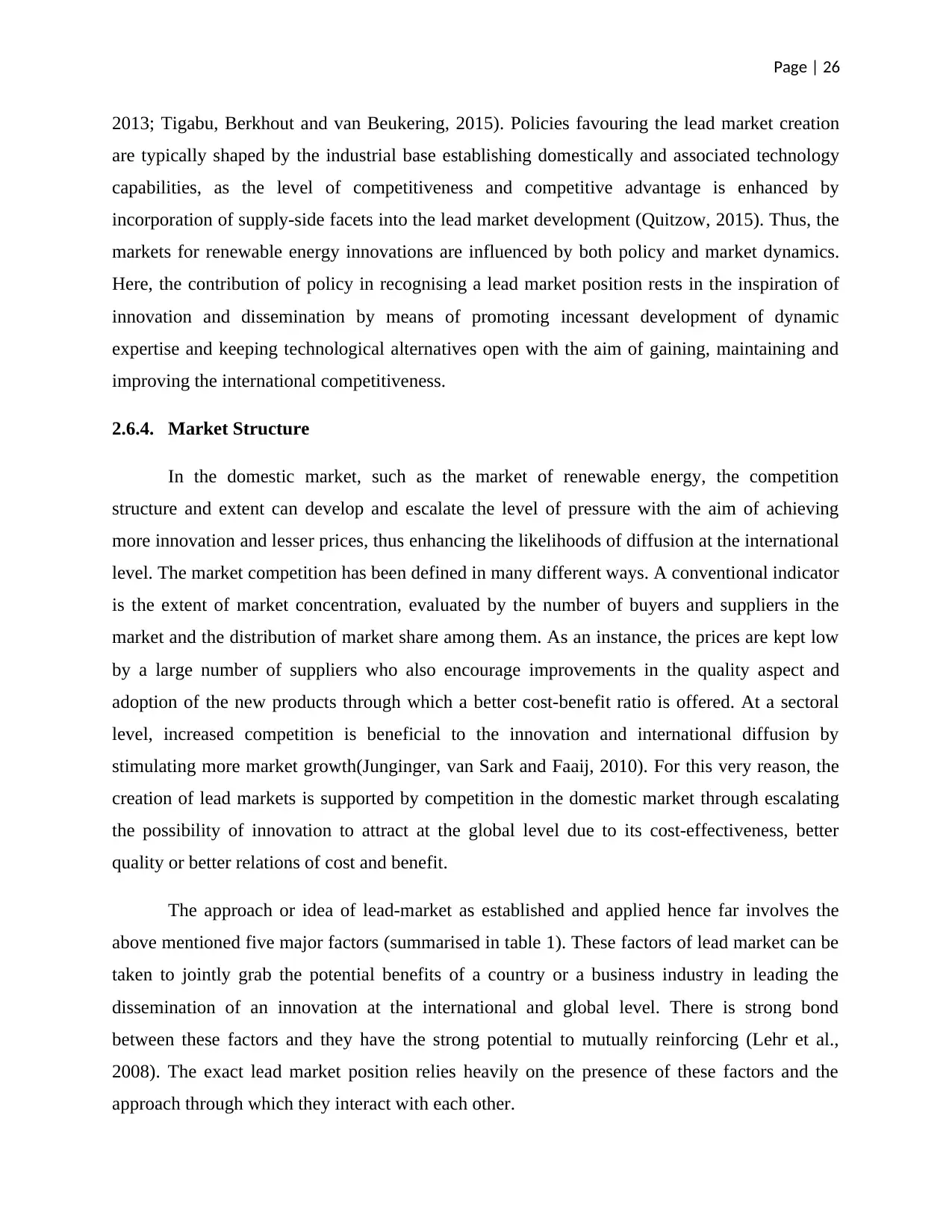
Page | 26
2013; Tigabu, Berkhout and van Beukering, 2015). Policies favouring the lead market creation
are typically shaped by the industrial base establishing domestically and associated technology
capabilities, as the level of competitiveness and competitive advantage is enhanced by
incorporation of supply-side facets into the lead market development (Quitzow, 2015). Thus, the
markets for renewable energy innovations are influenced by both policy and market dynamics.
Here, the contribution of policy in recognising a lead market position rests in the inspiration of
innovation and dissemination by means of promoting incessant development of dynamic
expertise and keeping technological alternatives open with the aim of gaining, maintaining and
improving the international competitiveness.
2.6.4. Market Structure
In the domestic market, such as the market of renewable energy, the competition
structure and extent can develop and escalate the level of pressure with the aim of achieving
more innovation and lesser prices, thus enhancing the likelihoods of diffusion at the international
level. The market competition has been defined in many different ways. A conventional indicator
is the extent of market concentration, evaluated by the number of buyers and suppliers in the
market and the distribution of market share among them. As an instance, the prices are kept low
by a large number of suppliers who also encourage improvements in the quality aspect and
adoption of the new products through which a better cost-benefit ratio is offered. At a sectoral
level, increased competition is beneficial to the innovation and international diffusion by
stimulating more market growth(Junginger, van Sark and Faaij, 2010). For this very reason, the
creation of lead markets is supported by competition in the domestic market through escalating
the possibility of innovation to attract at the global level due to its cost-effectiveness, better
quality or better relations of cost and benefit.
The approach or idea of lead-market as established and applied hence far involves the
above mentioned five major factors (summarised in table 1). These factors of lead market can be
taken to jointly grab the potential benefits of a country or a business industry in leading the
dissemination of an innovation at the international and global level. There is strong bond
between these factors and they have the strong potential to mutually reinforcing (Lehr et al.,
2008). The exact lead market position relies heavily on the presence of these factors and the
approach through which they interact with each other.
2013; Tigabu, Berkhout and van Beukering, 2015). Policies favouring the lead market creation
are typically shaped by the industrial base establishing domestically and associated technology
capabilities, as the level of competitiveness and competitive advantage is enhanced by
incorporation of supply-side facets into the lead market development (Quitzow, 2015). Thus, the
markets for renewable energy innovations are influenced by both policy and market dynamics.
Here, the contribution of policy in recognising a lead market position rests in the inspiration of
innovation and dissemination by means of promoting incessant development of dynamic
expertise and keeping technological alternatives open with the aim of gaining, maintaining and
improving the international competitiveness.
2.6.4. Market Structure
In the domestic market, such as the market of renewable energy, the competition
structure and extent can develop and escalate the level of pressure with the aim of achieving
more innovation and lesser prices, thus enhancing the likelihoods of diffusion at the international
level. The market competition has been defined in many different ways. A conventional indicator
is the extent of market concentration, evaluated by the number of buyers and suppliers in the
market and the distribution of market share among them. As an instance, the prices are kept low
by a large number of suppliers who also encourage improvements in the quality aspect and
adoption of the new products through which a better cost-benefit ratio is offered. At a sectoral
level, increased competition is beneficial to the innovation and international diffusion by
stimulating more market growth(Junginger, van Sark and Faaij, 2010). For this very reason, the
creation of lead markets is supported by competition in the domestic market through escalating
the possibility of innovation to attract at the global level due to its cost-effectiveness, better
quality or better relations of cost and benefit.
The approach or idea of lead-market as established and applied hence far involves the
above mentioned five major factors (summarised in table 1). These factors of lead market can be
taken to jointly grab the potential benefits of a country or a business industry in leading the
dissemination of an innovation at the international and global level. There is strong bond
between these factors and they have the strong potential to mutually reinforcing (Lehr et al.,
2008). The exact lead market position relies heavily on the presence of these factors and the
approach through which they interact with each other.
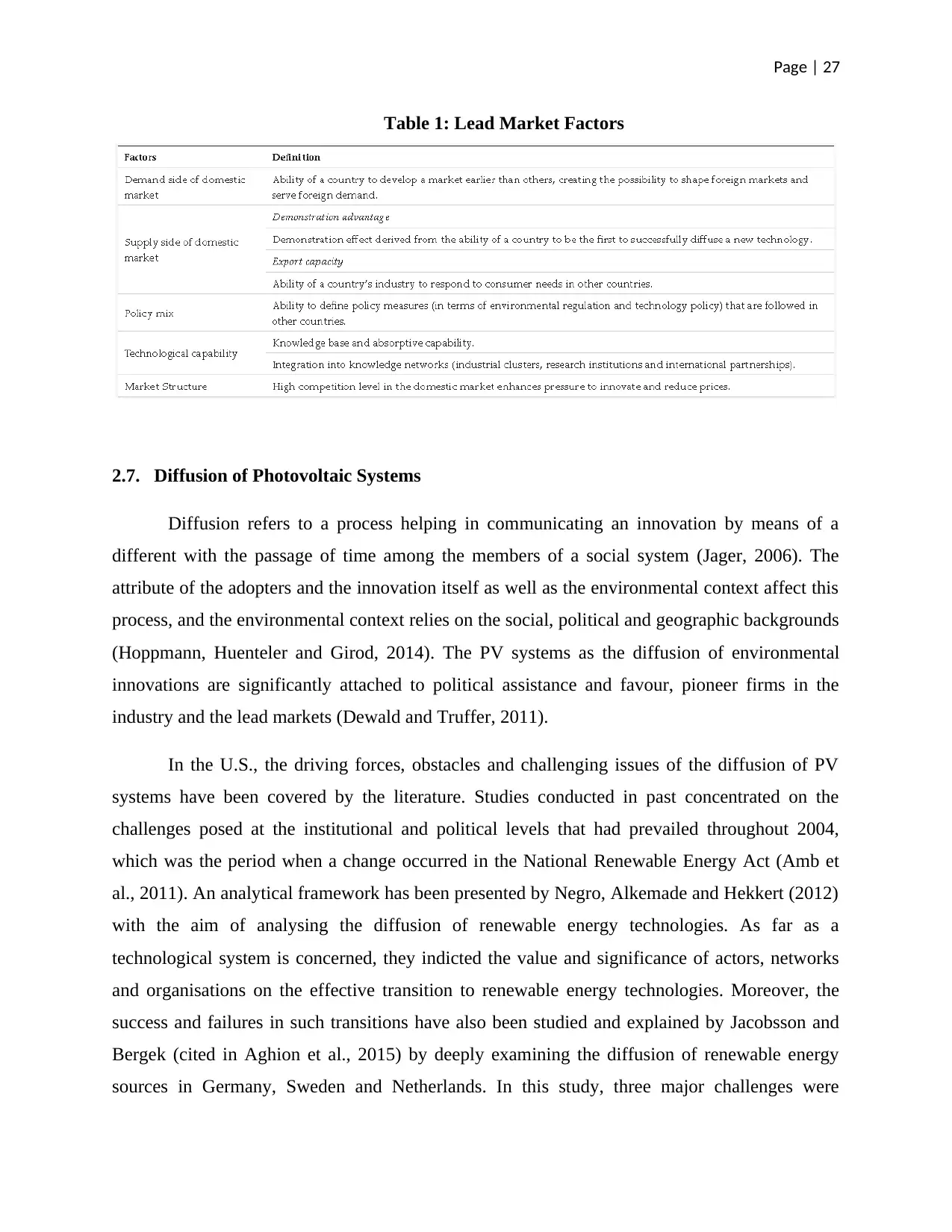
Page | 27
Table 1: Lead Market Factors
2.7. Diffusion of Photovoltaic Systems
Diffusion refers to a process helping in communicating an innovation by means of a
different with the passage of time among the members of a social system (Jager, 2006). The
attribute of the adopters and the innovation itself as well as the environmental context affect this
process, and the environmental context relies on the social, political and geographic backgrounds
(Hoppmann, Huenteler and Girod, 2014). The PV systems as the diffusion of environmental
innovations are significantly attached to political assistance and favour, pioneer firms in the
industry and the lead markets (Dewald and Truffer, 2011).
In the U.S., the driving forces, obstacles and challenging issues of the diffusion of PV
systems have been covered by the literature. Studies conducted in past concentrated on the
challenges posed at the institutional and political levels that had prevailed throughout 2004,
which was the period when a change occurred in the National Renewable Energy Act (Amb et
al., 2011). An analytical framework has been presented by Negro, Alkemade and Hekkert (2012)
with the aim of analysing the diffusion of renewable energy technologies. As far as a
technological system is concerned, they indicted the value and significance of actors, networks
and organisations on the effective transition to renewable energy technologies. Moreover, the
success and failures in such transitions have also been studied and explained by Jacobsson and
Bergek (cited in Aghion et al., 2015) by deeply examining the diffusion of renewable energy
sources in Germany, Sweden and Netherlands. In this study, three major challenges were
Table 1: Lead Market Factors
2.7. Diffusion of Photovoltaic Systems
Diffusion refers to a process helping in communicating an innovation by means of a
different with the passage of time among the members of a social system (Jager, 2006). The
attribute of the adopters and the innovation itself as well as the environmental context affect this
process, and the environmental context relies on the social, political and geographic backgrounds
(Hoppmann, Huenteler and Girod, 2014). The PV systems as the diffusion of environmental
innovations are significantly attached to political assistance and favour, pioneer firms in the
industry and the lead markets (Dewald and Truffer, 2011).
In the U.S., the driving forces, obstacles and challenging issues of the diffusion of PV
systems have been covered by the literature. Studies conducted in past concentrated on the
challenges posed at the institutional and political levels that had prevailed throughout 2004,
which was the period when a change occurred in the National Renewable Energy Act (Amb et
al., 2011). An analytical framework has been presented by Negro, Alkemade and Hekkert (2012)
with the aim of analysing the diffusion of renewable energy technologies. As far as a
technological system is concerned, they indicted the value and significance of actors, networks
and organisations on the effective transition to renewable energy technologies. Moreover, the
success and failures in such transitions have also been studied and explained by Jacobsson and
Bergek (cited in Aghion et al., 2015) by deeply examining the diffusion of renewable energy
sources in Germany, Sweden and Netherlands. In this study, three major challenges were

Page | 28
identified faced by the policy makers, which are (1)problems in projecting the result of policy
intervention; (2) the long time scale of the diffusion process; and (3) the great effort at the
political level to overcome the resistance from incumbent actors (cited in Aghion et al., 2015).
Further, in their study Zhao, Ma and Hong (2010) focused on the Germany by analysing,
discussing and describing the creation and structure of political assistance for renewable energies
as a “battle over institutions.” The regulatory frameworks favouring wind energy and PV
systems in Germany experienced the opposition from interests in coal and nuclear. Some new
facets on the PV market in Germany have been discussed by other later studies. Stetz, Marten
and Braun (2013) on the one hand disagreed with and criticised the feed-in tariff scheme
associated with the EEG, indicating the scheme’s inadequacy on greenhouse gas reduction.
Instead of favouring the PV’s adopters with the feed-in tariff scheme, they in its place suggested
policy makers favour the vast production of PV panels. Zhang, Andrews-Speed and Zhao (2013),
on the other hand, focused the EEG by discussing it as an example for America. They also
addressed the decades-long considerable change at the political level as a leading force on
diffusion of PV systems. Moreover, the worth of substructures in the market have been discussed
by Dewald and Fromhold-Eisebith (2015), by claiming that there are various market segments of
PV systems that have revealed a variety of past diffusion patterns. Besides this, the effects of
feed-in tariff amendments on diffusion of PV systems in Germany have been discussed by
(Sueyoshi and Goto, 2014). There were two significant contributing parts. Initially, their claim
was that the diffusion is still supported by feed-in tariff declining from 0.39 V/Kwh in 2009 to
0.22 V/Kwh in the beginning of 2012. In the second place, with the aim of meeting targets set by
the government, alternative approaches have been presented by authors in order to make
adjustments concerning the feed-in tariff.
What is more, a common agreement is there that factors functioning locally have been
integral for making the diffusion of PV systems able in Germany. According to Dewald and
Fromhold-Eisebith (2015), solar initiatives at the local level have been very important because
the PV market is formed by it, through which rapid diffusion is stimulated. They further added
by arguing that the success was due strict support from policy or supportive geophysical
environments, as well as due to the activities of solar companies operating locally in influencing
the development of PV market. Likewise, the contributing part of U.S.-based local solar
companies has been studied by Karakaya and Sriwannawit (2015). The authors conceptualised
identified faced by the policy makers, which are (1)problems in projecting the result of policy
intervention; (2) the long time scale of the diffusion process; and (3) the great effort at the
political level to overcome the resistance from incumbent actors (cited in Aghion et al., 2015).
Further, in their study Zhao, Ma and Hong (2010) focused on the Germany by analysing,
discussing and describing the creation and structure of political assistance for renewable energies
as a “battle over institutions.” The regulatory frameworks favouring wind energy and PV
systems in Germany experienced the opposition from interests in coal and nuclear. Some new
facets on the PV market in Germany have been discussed by other later studies. Stetz, Marten
and Braun (2013) on the one hand disagreed with and criticised the feed-in tariff scheme
associated with the EEG, indicating the scheme’s inadequacy on greenhouse gas reduction.
Instead of favouring the PV’s adopters with the feed-in tariff scheme, they in its place suggested
policy makers favour the vast production of PV panels. Zhang, Andrews-Speed and Zhao (2013),
on the other hand, focused the EEG by discussing it as an example for America. They also
addressed the decades-long considerable change at the political level as a leading force on
diffusion of PV systems. Moreover, the worth of substructures in the market have been discussed
by Dewald and Fromhold-Eisebith (2015), by claiming that there are various market segments of
PV systems that have revealed a variety of past diffusion patterns. Besides this, the effects of
feed-in tariff amendments on diffusion of PV systems in Germany have been discussed by
(Sueyoshi and Goto, 2014). There were two significant contributing parts. Initially, their claim
was that the diffusion is still supported by feed-in tariff declining from 0.39 V/Kwh in 2009 to
0.22 V/Kwh in the beginning of 2012. In the second place, with the aim of meeting targets set by
the government, alternative approaches have been presented by authors in order to make
adjustments concerning the feed-in tariff.
What is more, a common agreement is there that factors functioning locally have been
integral for making the diffusion of PV systems able in Germany. According to Dewald and
Fromhold-Eisebith (2015), solar initiatives at the local level have been very important because
the PV market is formed by it, through which rapid diffusion is stimulated. They further added
by arguing that the success was due strict support from policy or supportive geophysical
environments, as well as due to the activities of solar companies operating locally in influencing
the development of PV market. Likewise, the contributing part of U.S.-based local solar
companies has been studied by Karakaya and Sriwannawit (2015). The authors conceptualised
Secure Best Marks with AI Grader
Need help grading? Try our AI Grader for instant feedback on your assignments.
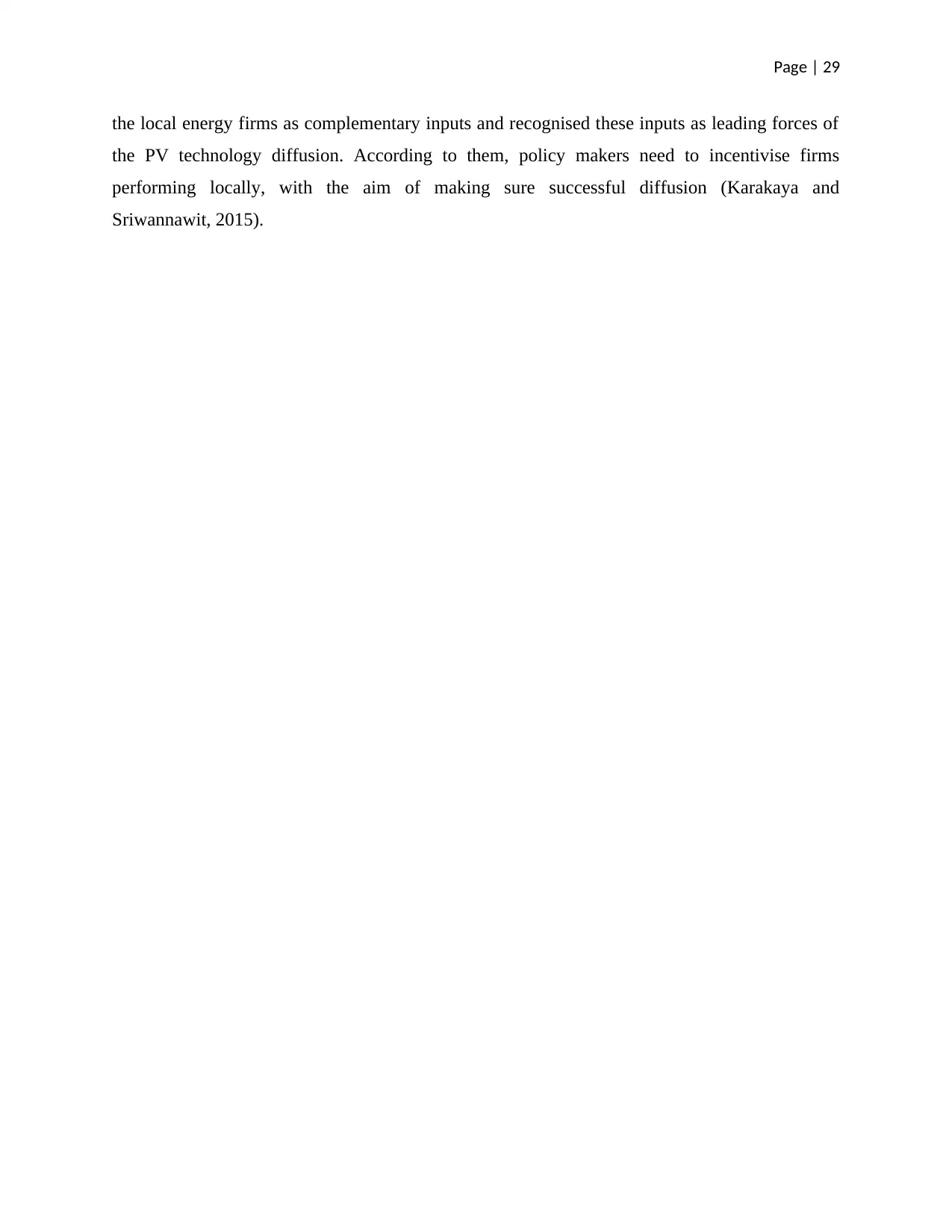
Page | 29
the local energy firms as complementary inputs and recognised these inputs as leading forces of
the PV technology diffusion. According to them, policy makers need to incentivise firms
performing locally, with the aim of making sure successful diffusion (Karakaya and
Sriwannawit, 2015).
the local energy firms as complementary inputs and recognised these inputs as leading forces of
the PV technology diffusion. According to them, policy makers need to incentivise firms
performing locally, with the aim of making sure successful diffusion (Karakaya and
Sriwannawit, 2015).
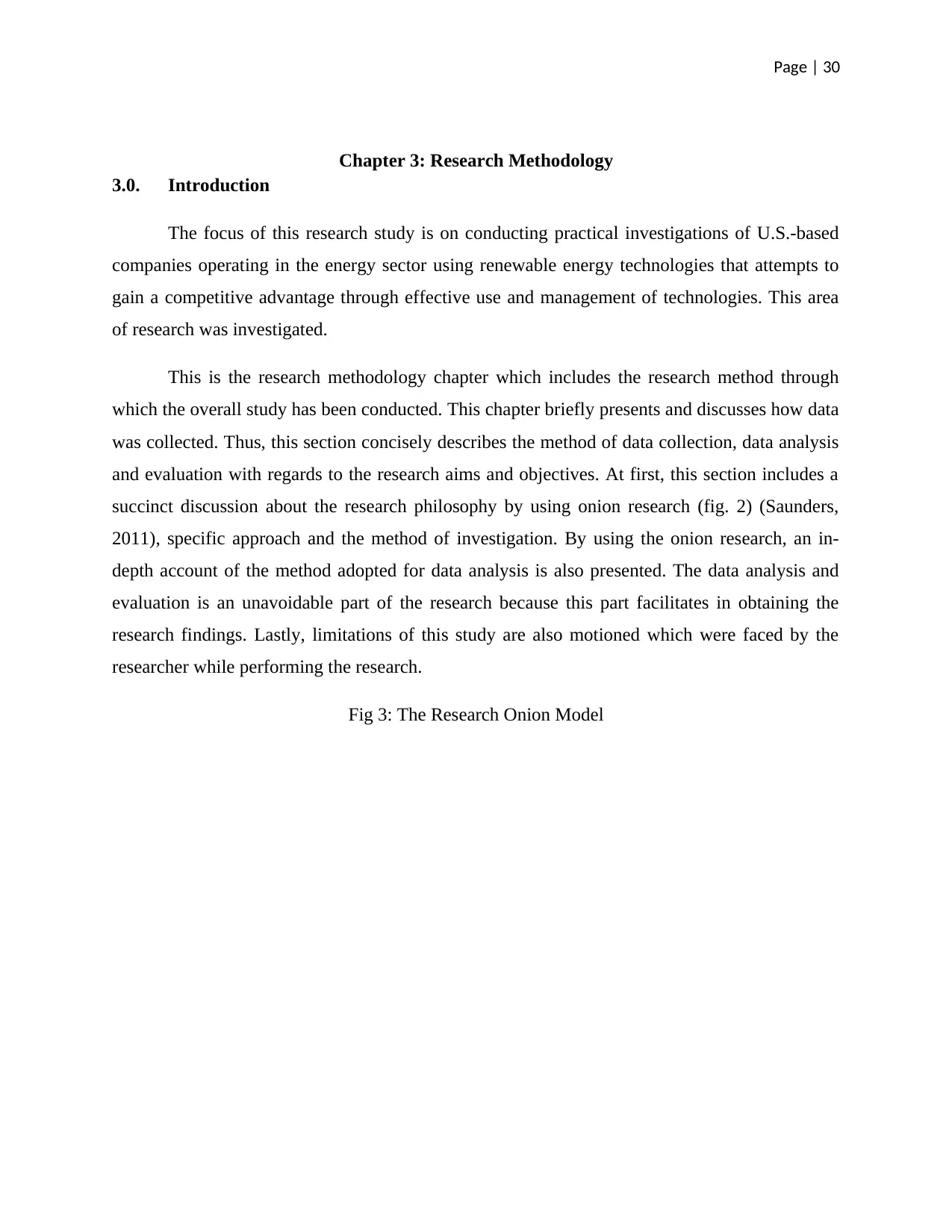
Page | 30
Chapter 3: Research Methodology
3.0. Introduction
The focus of this research study is on conducting practical investigations of U.S.-based
companies operating in the energy sector using renewable energy technologies that attempts to
gain a competitive advantage through effective use and management of technologies. This area
of research was investigated.
This is the research methodology chapter which includes the research method through
which the overall study has been conducted. This chapter briefly presents and discusses how data
was collected. Thus, this section concisely describes the method of data collection, data analysis
and evaluation with regards to the research aims and objectives. At first, this section includes a
succinct discussion about the research philosophy by using onion research (fig. 2) (Saunders,
2011), specific approach and the method of investigation. By using the onion research, an in-
depth account of the method adopted for data analysis is also presented. The data analysis and
evaluation is an unavoidable part of the research because this part facilitates in obtaining the
research findings. Lastly, limitations of this study are also motioned which were faced by the
researcher while performing the research.
Fig 3: The Research Onion Model
Chapter 3: Research Methodology
3.0. Introduction
The focus of this research study is on conducting practical investigations of U.S.-based
companies operating in the energy sector using renewable energy technologies that attempts to
gain a competitive advantage through effective use and management of technologies. This area
of research was investigated.
This is the research methodology chapter which includes the research method through
which the overall study has been conducted. This chapter briefly presents and discusses how data
was collected. Thus, this section concisely describes the method of data collection, data analysis
and evaluation with regards to the research aims and objectives. At first, this section includes a
succinct discussion about the research philosophy by using onion research (fig. 2) (Saunders,
2011), specific approach and the method of investigation. By using the onion research, an in-
depth account of the method adopted for data analysis is also presented. The data analysis and
evaluation is an unavoidable part of the research because this part facilitates in obtaining the
research findings. Lastly, limitations of this study are also motioned which were faced by the
researcher while performing the research.
Fig 3: The Research Onion Model
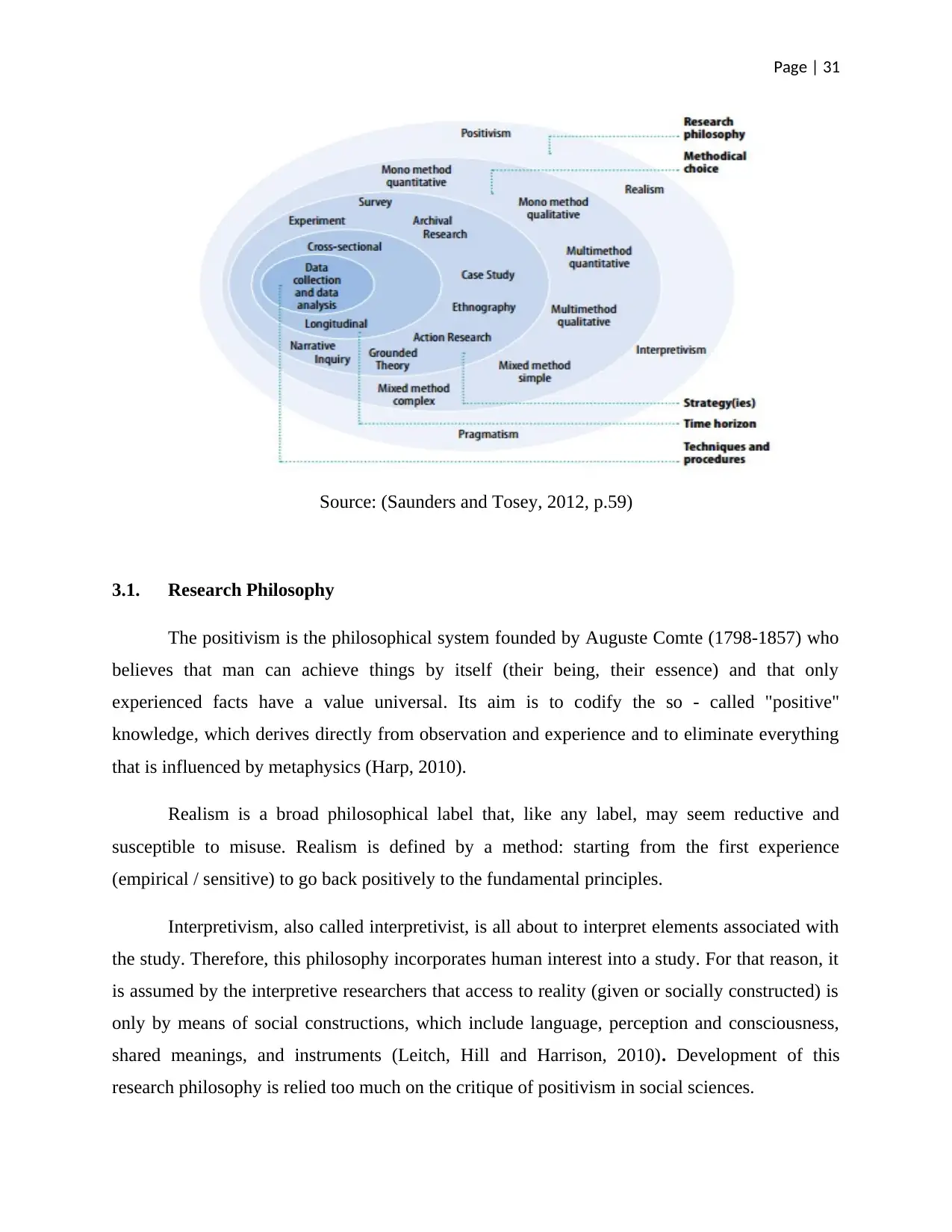
Page | 31
Source: (Saunders and Tosey, 2012, p.59)
3.1. Research Philosophy
The positivism is the philosophical system founded by Auguste Comte (1798-1857) who
believes that man can achieve things by itself (their being, their essence) and that only
experienced facts have a value universal. Its aim is to codify the so - called "positive"
knowledge, which derives directly from observation and experience and to eliminate everything
that is influenced by metaphysics (Harp, 2010).
Realism is a broad philosophical label that, like any label, may seem reductive and
susceptible to misuse. Realism is defined by a method: starting from the first experience
(empirical / sensitive) to go back positively to the fundamental principles.
Interpretivism, also called interpretivist, is all about to interpret elements associated with
the study. Therefore, this philosophy incorporates human interest into a study. For that reason, it
is assumed by the interpretive researchers that access to reality (given or socially constructed) is
only by means of social constructions, which include language, perception and consciousness,
shared meanings, and instruments (Leitch, Hill and Harrison, 2010). Development of this
research philosophy is relied too much on the critique of positivism in social sciences.
Source: (Saunders and Tosey, 2012, p.59)
3.1. Research Philosophy
The positivism is the philosophical system founded by Auguste Comte (1798-1857) who
believes that man can achieve things by itself (their being, their essence) and that only
experienced facts have a value universal. Its aim is to codify the so - called "positive"
knowledge, which derives directly from observation and experience and to eliminate everything
that is influenced by metaphysics (Harp, 2010).
Realism is a broad philosophical label that, like any label, may seem reductive and
susceptible to misuse. Realism is defined by a method: starting from the first experience
(empirical / sensitive) to go back positively to the fundamental principles.
Interpretivism, also called interpretivist, is all about to interpret elements associated with
the study. Therefore, this philosophy incorporates human interest into a study. For that reason, it
is assumed by the interpretive researchers that access to reality (given or socially constructed) is
only by means of social constructions, which include language, perception and consciousness,
shared meanings, and instruments (Leitch, Hill and Harrison, 2010). Development of this
research philosophy is relied too much on the critique of positivism in social sciences.
Paraphrase This Document
Need a fresh take? Get an instant paraphrase of this document with our AI Paraphraser

Page | 32
Pragmatism has a philosophical meaning ('to bind meaning, cognition and action').
Pragmatism is a philosophical school founded in the 19th century by philosophers and scientists
who opposed modern metaphysics (Hegel) and the theory / practice dichotomy (Aristotle, Kant)
(Yvonne Feilzer, 2010). Pragmatism is more a set of philosophies than a unique philosophy, as
evidenced by the variety of options that are its own about the relationships between truth and
meaning, cognition and action, science, morals and art (Yvonne Feilzer, 2010).
However, positivism philosophy was used to analyse the qualitative data whereas the
realism philosophy was adopted to evaluate the data authenticity. It means that a “Mixed
Research Design” was used. Positivism has been used in this study with the aim of obtaining
quite positive result and predicting the outcome (Harp, 2010). Positivism has been used because
it establishes a hierarchy between the sciences which start from the study of the raw bodies and
rises to the organized bodies, culminating in sociology, which developed only at the end of the
nineteenth century. Through his vision of the world and his methods, positivism is very close to
the natural sciences. The reason behind using the realism philosophy was to signify the
distinctions between realism and anti-realism (Miller and Tsang, 2011). Realism postulates the
world is itself structured rationally, and that our mind can reveal and know these structures
(Miller and Tsang, 2011). The essence of things is accessible to our knowledge, and there is no
opposition of the Kantian type between the thing "in itself" and the phenomenon. That is, the
thing experienced in a sensible way is not distinguished from its essence known in the form of
concept by reason (Miller and Tsang, 2011).
3.2. Research Approach
There are two methods of reasoning in research studies, inductive and deductive. These
two methods which correspond in fact to two diametrically opposed starting points:
The deductive method , which a priori reasons on the basis of the knowing subject, the
personal ego, and which deduces a whole series of philosophical consequences - and we
will see it in the scientific order;
The inductive method, which a posterior reasoning from the known object, namely: the
scientifically explored sensitive reality, and which induces a whole series of
consequences on the metaphysical plane.
Pragmatism has a philosophical meaning ('to bind meaning, cognition and action').
Pragmatism is a philosophical school founded in the 19th century by philosophers and scientists
who opposed modern metaphysics (Hegel) and the theory / practice dichotomy (Aristotle, Kant)
(Yvonne Feilzer, 2010). Pragmatism is more a set of philosophies than a unique philosophy, as
evidenced by the variety of options that are its own about the relationships between truth and
meaning, cognition and action, science, morals and art (Yvonne Feilzer, 2010).
However, positivism philosophy was used to analyse the qualitative data whereas the
realism philosophy was adopted to evaluate the data authenticity. It means that a “Mixed
Research Design” was used. Positivism has been used in this study with the aim of obtaining
quite positive result and predicting the outcome (Harp, 2010). Positivism has been used because
it establishes a hierarchy between the sciences which start from the study of the raw bodies and
rises to the organized bodies, culminating in sociology, which developed only at the end of the
nineteenth century. Through his vision of the world and his methods, positivism is very close to
the natural sciences. The reason behind using the realism philosophy was to signify the
distinctions between realism and anti-realism (Miller and Tsang, 2011). Realism postulates the
world is itself structured rationally, and that our mind can reveal and know these structures
(Miller and Tsang, 2011). The essence of things is accessible to our knowledge, and there is no
opposition of the Kantian type between the thing "in itself" and the phenomenon. That is, the
thing experienced in a sensible way is not distinguished from its essence known in the form of
concept by reason (Miller and Tsang, 2011).
3.2. Research Approach
There are two methods of reasoning in research studies, inductive and deductive. These
two methods which correspond in fact to two diametrically opposed starting points:
The deductive method , which a priori reasons on the basis of the knowing subject, the
personal ego, and which deduces a whole series of philosophical consequences - and we
will see it in the scientific order;
The inductive method, which a posterior reasoning from the known object, namely: the
scientifically explored sensitive reality, and which induces a whole series of
consequences on the metaphysical plane.
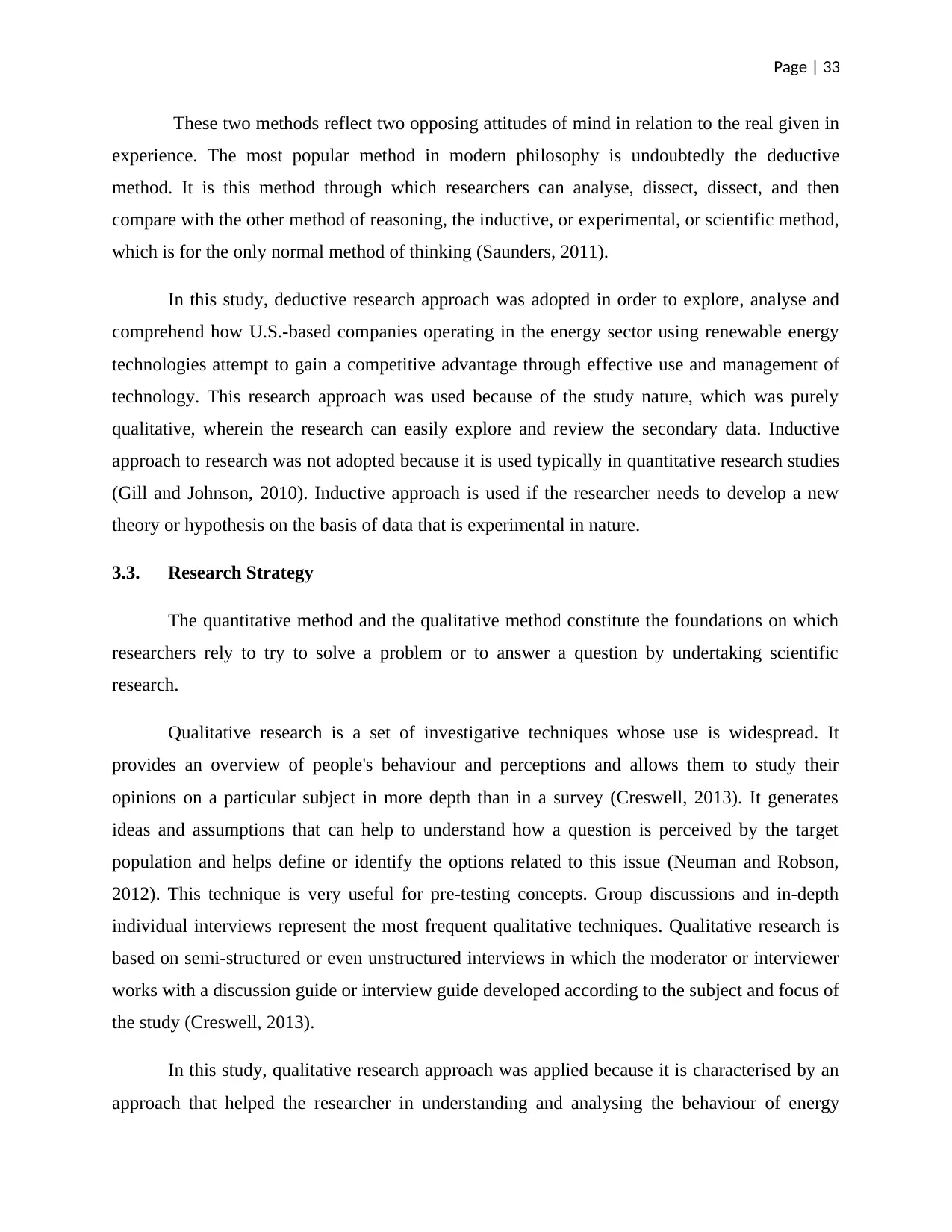
Page | 33
These two methods reflect two opposing attitudes of mind in relation to the real given in
experience. The most popular method in modern philosophy is undoubtedly the deductive
method. It is this method through which researchers can analyse, dissect, dissect, and then
compare with the other method of reasoning, the inductive, or experimental, or scientific method,
which is for the only normal method of thinking (Saunders, 2011).
In this study, deductive research approach was adopted in order to explore, analyse and
comprehend how U.S.-based companies operating in the energy sector using renewable energy
technologies attempt to gain a competitive advantage through effective use and management of
technology. This research approach was used because of the study nature, which was purely
qualitative, wherein the research can easily explore and review the secondary data. Inductive
approach to research was not adopted because it is used typically in quantitative research studies
(Gill and Johnson, 2010). Inductive approach is used if the researcher needs to develop a new
theory or hypothesis on the basis of data that is experimental in nature.
3.3. Research Strategy
The quantitative method and the qualitative method constitute the foundations on which
researchers rely to try to solve a problem or to answer a question by undertaking scientific
research.
Qualitative research is a set of investigative techniques whose use is widespread. It
provides an overview of people's behaviour and perceptions and allows them to study their
opinions on a particular subject in more depth than in a survey (Creswell, 2013). It generates
ideas and assumptions that can help to understand how a question is perceived by the target
population and helps define or identify the options related to this issue (Neuman and Robson,
2012). This technique is very useful for pre-testing concepts. Group discussions and in-depth
individual interviews represent the most frequent qualitative techniques. Qualitative research is
based on semi-structured or even unstructured interviews in which the moderator or interviewer
works with a discussion guide or interview guide developed according to the subject and focus of
the study (Creswell, 2013).
In this study, qualitative research approach was applied because it is characterised by an
approach that helped the researcher in understanding and analysing the behaviour of energy
These two methods reflect two opposing attitudes of mind in relation to the real given in
experience. The most popular method in modern philosophy is undoubtedly the deductive
method. It is this method through which researchers can analyse, dissect, dissect, and then
compare with the other method of reasoning, the inductive, or experimental, or scientific method,
which is for the only normal method of thinking (Saunders, 2011).
In this study, deductive research approach was adopted in order to explore, analyse and
comprehend how U.S.-based companies operating in the energy sector using renewable energy
technologies attempt to gain a competitive advantage through effective use and management of
technology. This research approach was used because of the study nature, which was purely
qualitative, wherein the research can easily explore and review the secondary data. Inductive
approach to research was not adopted because it is used typically in quantitative research studies
(Gill and Johnson, 2010). Inductive approach is used if the researcher needs to develop a new
theory or hypothesis on the basis of data that is experimental in nature.
3.3. Research Strategy
The quantitative method and the qualitative method constitute the foundations on which
researchers rely to try to solve a problem or to answer a question by undertaking scientific
research.
Qualitative research is a set of investigative techniques whose use is widespread. It
provides an overview of people's behaviour and perceptions and allows them to study their
opinions on a particular subject in more depth than in a survey (Creswell, 2013). It generates
ideas and assumptions that can help to understand how a question is perceived by the target
population and helps define or identify the options related to this issue (Neuman and Robson,
2012). This technique is very useful for pre-testing concepts. Group discussions and in-depth
individual interviews represent the most frequent qualitative techniques. Qualitative research is
based on semi-structured or even unstructured interviews in which the moderator or interviewer
works with a discussion guide or interview guide developed according to the subject and focus of
the study (Creswell, 2013).
In this study, qualitative research approach was applied because it is characterised by an
approach that helped the researcher in understanding and analysing the behaviour of energy
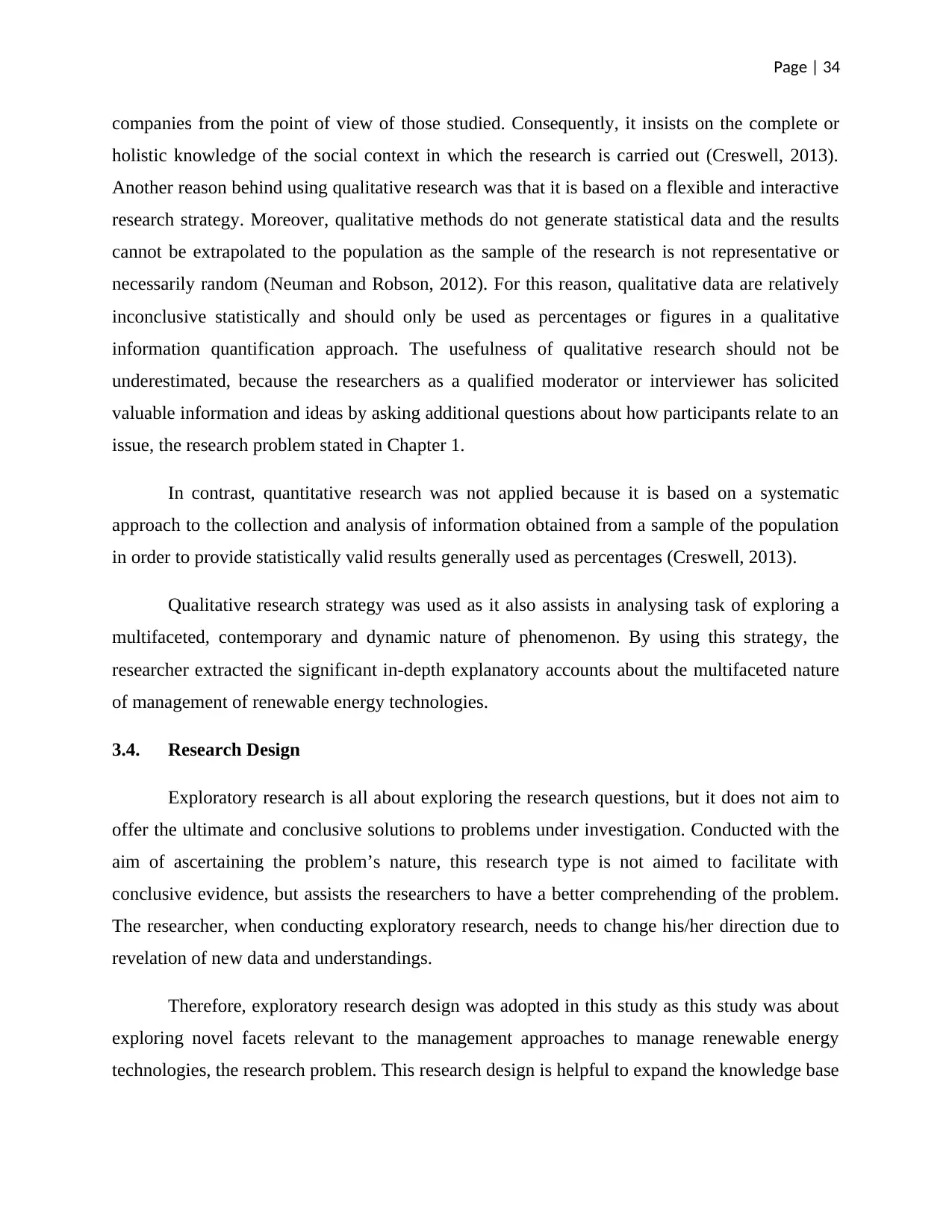
Page | 34
companies from the point of view of those studied. Consequently, it insists on the complete or
holistic knowledge of the social context in which the research is carried out (Creswell, 2013).
Another reason behind using qualitative research was that it is based on a flexible and interactive
research strategy. Moreover, qualitative methods do not generate statistical data and the results
cannot be extrapolated to the population as the sample of the research is not representative or
necessarily random (Neuman and Robson, 2012). For this reason, qualitative data are relatively
inconclusive statistically and should only be used as percentages or figures in a qualitative
information quantification approach. The usefulness of qualitative research should not be
underestimated, because the researchers as a qualified moderator or interviewer has solicited
valuable information and ideas by asking additional questions about how participants relate to an
issue, the research problem stated in Chapter 1.
In contrast, quantitative research was not applied because it is based on a systematic
approach to the collection and analysis of information obtained from a sample of the population
in order to provide statistically valid results generally used as percentages (Creswell, 2013).
Qualitative research strategy was used as it also assists in analysing task of exploring a
multifaceted, contemporary and dynamic nature of phenomenon. By using this strategy, the
researcher extracted the significant in-depth explanatory accounts about the multifaceted nature
of management of renewable energy technologies.
3.4. Research Design
Exploratory research is all about exploring the research questions, but it does not aim to
offer the ultimate and conclusive solutions to problems under investigation. Conducted with the
aim of ascertaining the problem’s nature, this research type is not aimed to facilitate with
conclusive evidence, but assists the researchers to have a better comprehending of the problem.
The researcher, when conducting exploratory research, needs to change his/her direction due to
revelation of new data and understandings.
Therefore, exploratory research design was adopted in this study as this study was about
exploring novel facets relevant to the management approaches to manage renewable energy
technologies, the research problem. This research design is helpful to expand the knowledge base
companies from the point of view of those studied. Consequently, it insists on the complete or
holistic knowledge of the social context in which the research is carried out (Creswell, 2013).
Another reason behind using qualitative research was that it is based on a flexible and interactive
research strategy. Moreover, qualitative methods do not generate statistical data and the results
cannot be extrapolated to the population as the sample of the research is not representative or
necessarily random (Neuman and Robson, 2012). For this reason, qualitative data are relatively
inconclusive statistically and should only be used as percentages or figures in a qualitative
information quantification approach. The usefulness of qualitative research should not be
underestimated, because the researchers as a qualified moderator or interviewer has solicited
valuable information and ideas by asking additional questions about how participants relate to an
issue, the research problem stated in Chapter 1.
In contrast, quantitative research was not applied because it is based on a systematic
approach to the collection and analysis of information obtained from a sample of the population
in order to provide statistically valid results generally used as percentages (Creswell, 2013).
Qualitative research strategy was used as it also assists in analysing task of exploring a
multifaceted, contemporary and dynamic nature of phenomenon. By using this strategy, the
researcher extracted the significant in-depth explanatory accounts about the multifaceted nature
of management of renewable energy technologies.
3.4. Research Design
Exploratory research is all about exploring the research questions, but it does not aim to
offer the ultimate and conclusive solutions to problems under investigation. Conducted with the
aim of ascertaining the problem’s nature, this research type is not aimed to facilitate with
conclusive evidence, but assists the researchers to have a better comprehending of the problem.
The researcher, when conducting exploratory research, needs to change his/her direction due to
revelation of new data and understandings.
Therefore, exploratory research design was adopted in this study as this study was about
exploring novel facets relevant to the management approaches to manage renewable energy
technologies, the research problem. This research design is helpful to expand the knowledge base
Secure Best Marks with AI Grader
Need help grading? Try our AI Grader for instant feedback on your assignments.
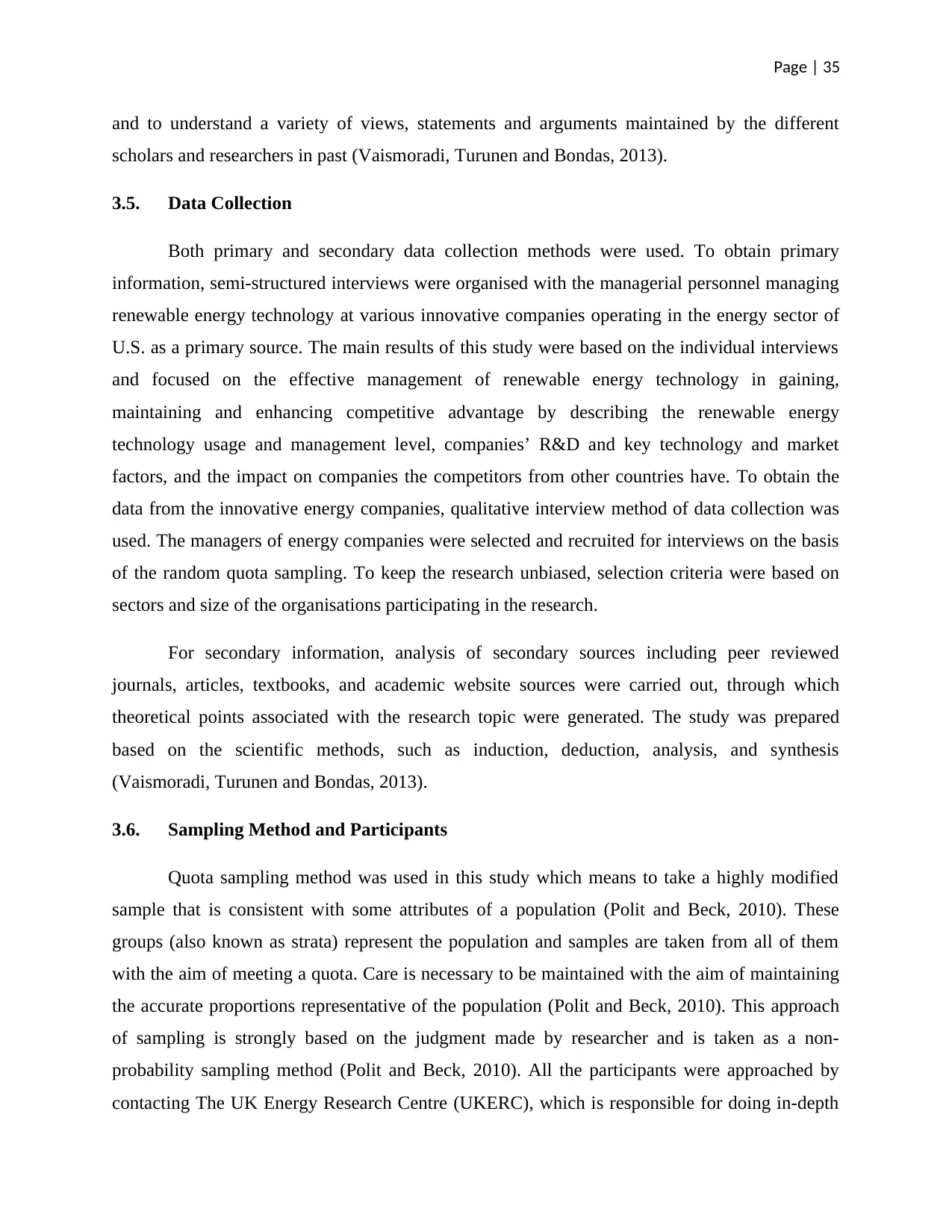
Page | 35
and to understand a variety of views, statements and arguments maintained by the different
scholars and researchers in past (Vaismoradi, Turunen and Bondas, 2013).
3.5. Data Collection
Both primary and secondary data collection methods were used. To obtain primary
information, semi-structured interviews were organised with the managerial personnel managing
renewable energy technology at various innovative companies operating in the energy sector of
U.S. as a primary source. The main results of this study were based on the individual interviews
and focused on the effective management of renewable energy technology in gaining,
maintaining and enhancing competitive advantage by describing the renewable energy
technology usage and management level, companies’ R&D and key technology and market
factors, and the impact on companies the competitors from other countries have. To obtain the
data from the innovative energy companies, qualitative interview method of data collection was
used. The managers of energy companies were selected and recruited for interviews on the basis
of the random quota sampling. To keep the research unbiased, selection criteria were based on
sectors and size of the organisations participating in the research.
For secondary information, analysis of secondary sources including peer reviewed
journals, articles, textbooks, and academic website sources were carried out, through which
theoretical points associated with the research topic were generated. The study was prepared
based on the scientific methods, such as induction, deduction, analysis, and synthesis
(Vaismoradi, Turunen and Bondas, 2013).
3.6. Sampling Method and Participants
Quota sampling method was used in this study which means to take a highly modified
sample that is consistent with some attributes of a population (Polit and Beck, 2010). These
groups (also known as strata) represent the population and samples are taken from all of them
with the aim of meeting a quota. Care is necessary to be maintained with the aim of maintaining
the accurate proportions representative of the population (Polit and Beck, 2010). This approach
of sampling is strongly based on the judgment made by researcher and is taken as a non-
probability sampling method (Polit and Beck, 2010). All the participants were approached by
contacting The UK Energy Research Centre (UKERC), which is responsible for doing in-depth
and to understand a variety of views, statements and arguments maintained by the different
scholars and researchers in past (Vaismoradi, Turunen and Bondas, 2013).
3.5. Data Collection
Both primary and secondary data collection methods were used. To obtain primary
information, semi-structured interviews were organised with the managerial personnel managing
renewable energy technology at various innovative companies operating in the energy sector of
U.S. as a primary source. The main results of this study were based on the individual interviews
and focused on the effective management of renewable energy technology in gaining,
maintaining and enhancing competitive advantage by describing the renewable energy
technology usage and management level, companies’ R&D and key technology and market
factors, and the impact on companies the competitors from other countries have. To obtain the
data from the innovative energy companies, qualitative interview method of data collection was
used. The managers of energy companies were selected and recruited for interviews on the basis
of the random quota sampling. To keep the research unbiased, selection criteria were based on
sectors and size of the organisations participating in the research.
For secondary information, analysis of secondary sources including peer reviewed
journals, articles, textbooks, and academic website sources were carried out, through which
theoretical points associated with the research topic were generated. The study was prepared
based on the scientific methods, such as induction, deduction, analysis, and synthesis
(Vaismoradi, Turunen and Bondas, 2013).
3.6. Sampling Method and Participants
Quota sampling method was used in this study which means to take a highly modified
sample that is consistent with some attributes of a population (Polit and Beck, 2010). These
groups (also known as strata) represent the population and samples are taken from all of them
with the aim of meeting a quota. Care is necessary to be maintained with the aim of maintaining
the accurate proportions representative of the population (Polit and Beck, 2010). This approach
of sampling is strongly based on the judgment made by researcher and is taken as a non-
probability sampling method (Polit and Beck, 2010). All the participants were approached by
contacting The UK Energy Research Centre (UKERC), which is responsible for doing in-depth
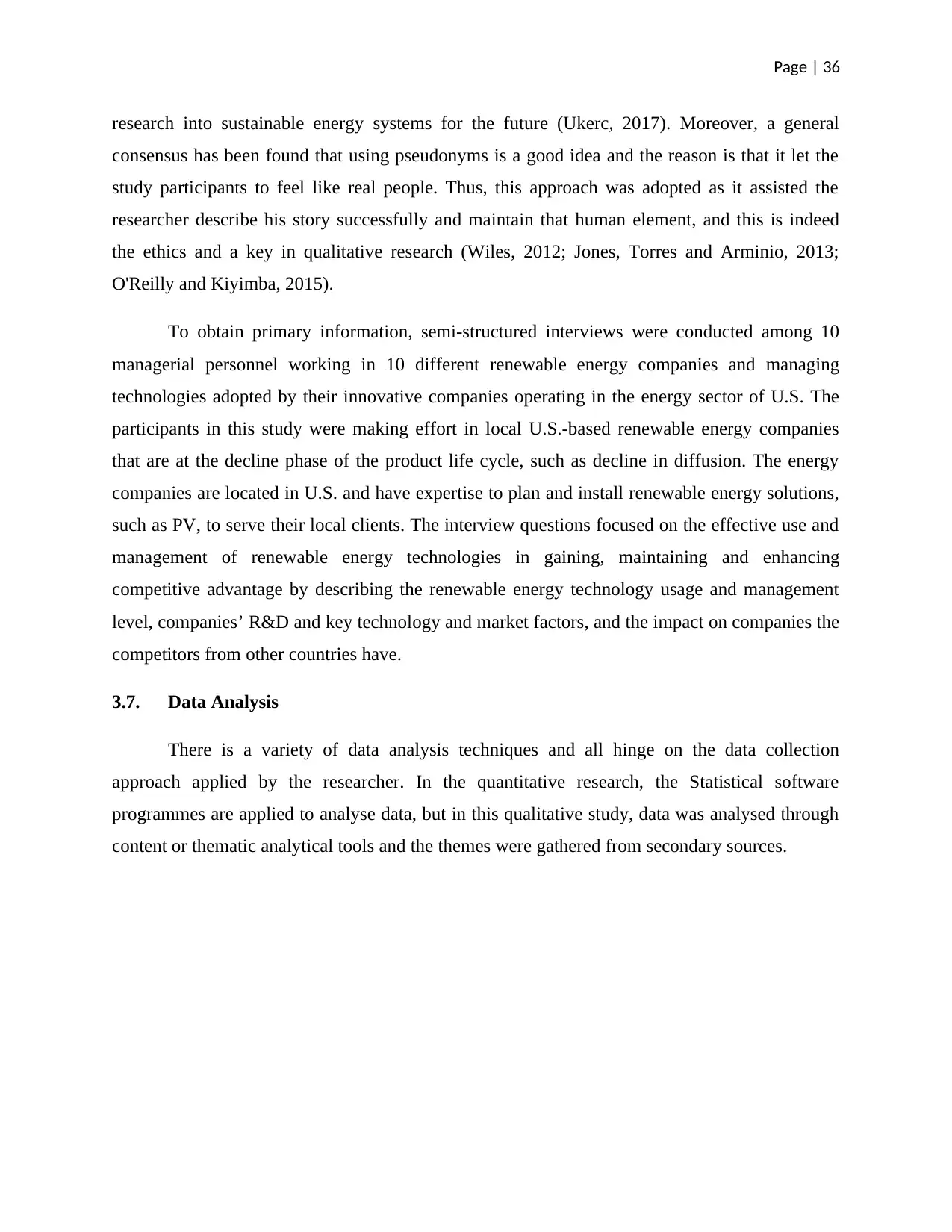
Page | 36
research into sustainable energy systems for the future (Ukerc, 2017). Moreover, a general
consensus has been found that using pseudonyms is a good idea and the reason is that it let the
study participants to feel like real people. Thus, this approach was adopted as it assisted the
researcher describe his story successfully and maintain that human element, and this is indeed
the ethics and a key in qualitative research (Wiles, 2012; Jones, Torres and Arminio, 2013;
O'Reilly and Kiyimba, 2015).
To obtain primary information, semi-structured interviews were conducted among 10
managerial personnel working in 10 different renewable energy companies and managing
technologies adopted by their innovative companies operating in the energy sector of U.S. The
participants in this study were making effort in local U.S.-based renewable energy companies
that are at the decline phase of the product life cycle, such as decline in diffusion. The energy
companies are located in U.S. and have expertise to plan and install renewable energy solutions,
such as PV, to serve their local clients. The interview questions focused on the effective use and
management of renewable energy technologies in gaining, maintaining and enhancing
competitive advantage by describing the renewable energy technology usage and management
level, companies’ R&D and key technology and market factors, and the impact on companies the
competitors from other countries have.
3.7. Data Analysis
There is a variety of data analysis techniques and all hinge on the data collection
approach applied by the researcher. In the quantitative research, the Statistical software
programmes are applied to analyse data, but in this qualitative study, data was analysed through
content or thematic analytical tools and the themes were gathered from secondary sources.
research into sustainable energy systems for the future (Ukerc, 2017). Moreover, a general
consensus has been found that using pseudonyms is a good idea and the reason is that it let the
study participants to feel like real people. Thus, this approach was adopted as it assisted the
researcher describe his story successfully and maintain that human element, and this is indeed
the ethics and a key in qualitative research (Wiles, 2012; Jones, Torres and Arminio, 2013;
O'Reilly and Kiyimba, 2015).
To obtain primary information, semi-structured interviews were conducted among 10
managerial personnel working in 10 different renewable energy companies and managing
technologies adopted by their innovative companies operating in the energy sector of U.S. The
participants in this study were making effort in local U.S.-based renewable energy companies
that are at the decline phase of the product life cycle, such as decline in diffusion. The energy
companies are located in U.S. and have expertise to plan and install renewable energy solutions,
such as PV, to serve their local clients. The interview questions focused on the effective use and
management of renewable energy technologies in gaining, maintaining and enhancing
competitive advantage by describing the renewable energy technology usage and management
level, companies’ R&D and key technology and market factors, and the impact on companies the
competitors from other countries have.
3.7. Data Analysis
There is a variety of data analysis techniques and all hinge on the data collection
approach applied by the researcher. In the quantitative research, the Statistical software
programmes are applied to analyse data, but in this qualitative study, data was analysed through
content or thematic analytical tools and the themes were gathered from secondary sources.
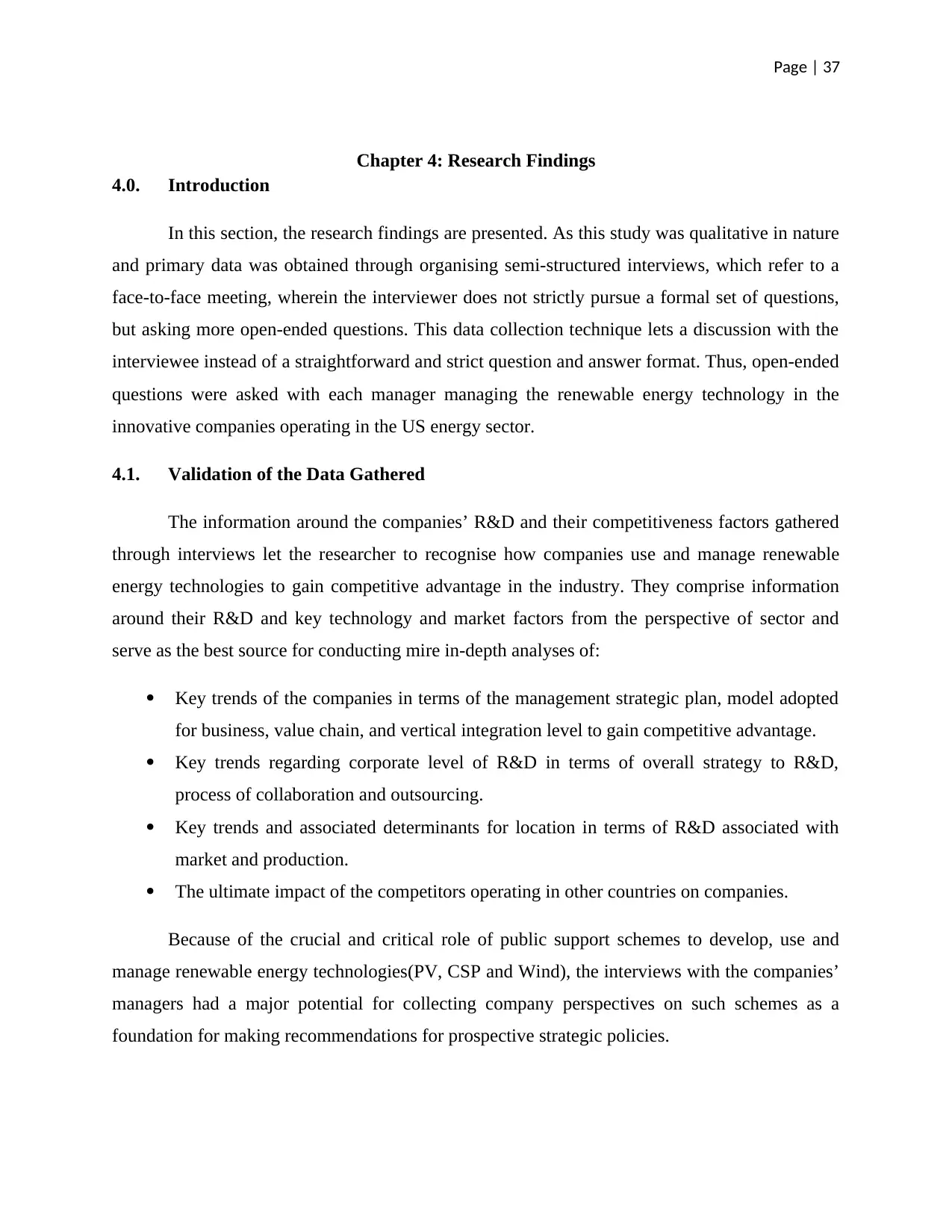
Page | 37
Chapter 4: Research Findings
4.0. Introduction
In this section, the research findings are presented. As this study was qualitative in nature
and primary data was obtained through organising semi-structured interviews, which refer to a
face-to-face meeting, wherein the interviewer does not strictly pursue a formal set of questions,
but asking more open-ended questions. This data collection technique lets a discussion with the
interviewee instead of a straightforward and strict question and answer format. Thus, open-ended
questions were asked with each manager managing the renewable energy technology in the
innovative companies operating in the US energy sector.
4.1. Validation of the Data Gathered
The information around the companies’ R&D and their competitiveness factors gathered
through interviews let the researcher to recognise how companies use and manage renewable
energy technologies to gain competitive advantage in the industry. They comprise information
around their R&D and key technology and market factors from the perspective of sector and
serve as the best source for conducting mire in-depth analyses of:
Key trends of the companies in terms of the management strategic plan, model adopted
for business, value chain, and vertical integration level to gain competitive advantage.
Key trends regarding corporate level of R&D in terms of overall strategy to R&D,
process of collaboration and outsourcing.
Key trends and associated determinants for location in terms of R&D associated with
market and production.
The ultimate impact of the competitors operating in other countries on companies.
Because of the crucial and critical role of public support schemes to develop, use and
manage renewable energy technologies(PV, CSP and Wind), the interviews with the companies’
managers had a major potential for collecting company perspectives on such schemes as a
foundation for making recommendations for prospective strategic policies.
Chapter 4: Research Findings
4.0. Introduction
In this section, the research findings are presented. As this study was qualitative in nature
and primary data was obtained through organising semi-structured interviews, which refer to a
face-to-face meeting, wherein the interviewer does not strictly pursue a formal set of questions,
but asking more open-ended questions. This data collection technique lets a discussion with the
interviewee instead of a straightforward and strict question and answer format. Thus, open-ended
questions were asked with each manager managing the renewable energy technology in the
innovative companies operating in the US energy sector.
4.1. Validation of the Data Gathered
The information around the companies’ R&D and their competitiveness factors gathered
through interviews let the researcher to recognise how companies use and manage renewable
energy technologies to gain competitive advantage in the industry. They comprise information
around their R&D and key technology and market factors from the perspective of sector and
serve as the best source for conducting mire in-depth analyses of:
Key trends of the companies in terms of the management strategic plan, model adopted
for business, value chain, and vertical integration level to gain competitive advantage.
Key trends regarding corporate level of R&D in terms of overall strategy to R&D,
process of collaboration and outsourcing.
Key trends and associated determinants for location in terms of R&D associated with
market and production.
The ultimate impact of the competitors operating in other countries on companies.
Because of the crucial and critical role of public support schemes to develop, use and
manage renewable energy technologies(PV, CSP and Wind), the interviews with the companies’
managers had a major potential for collecting company perspectives on such schemes as a
foundation for making recommendations for prospective strategic policies.
Paraphrase This Document
Need a fresh take? Get an instant paraphrase of this document with our AI Paraphraser
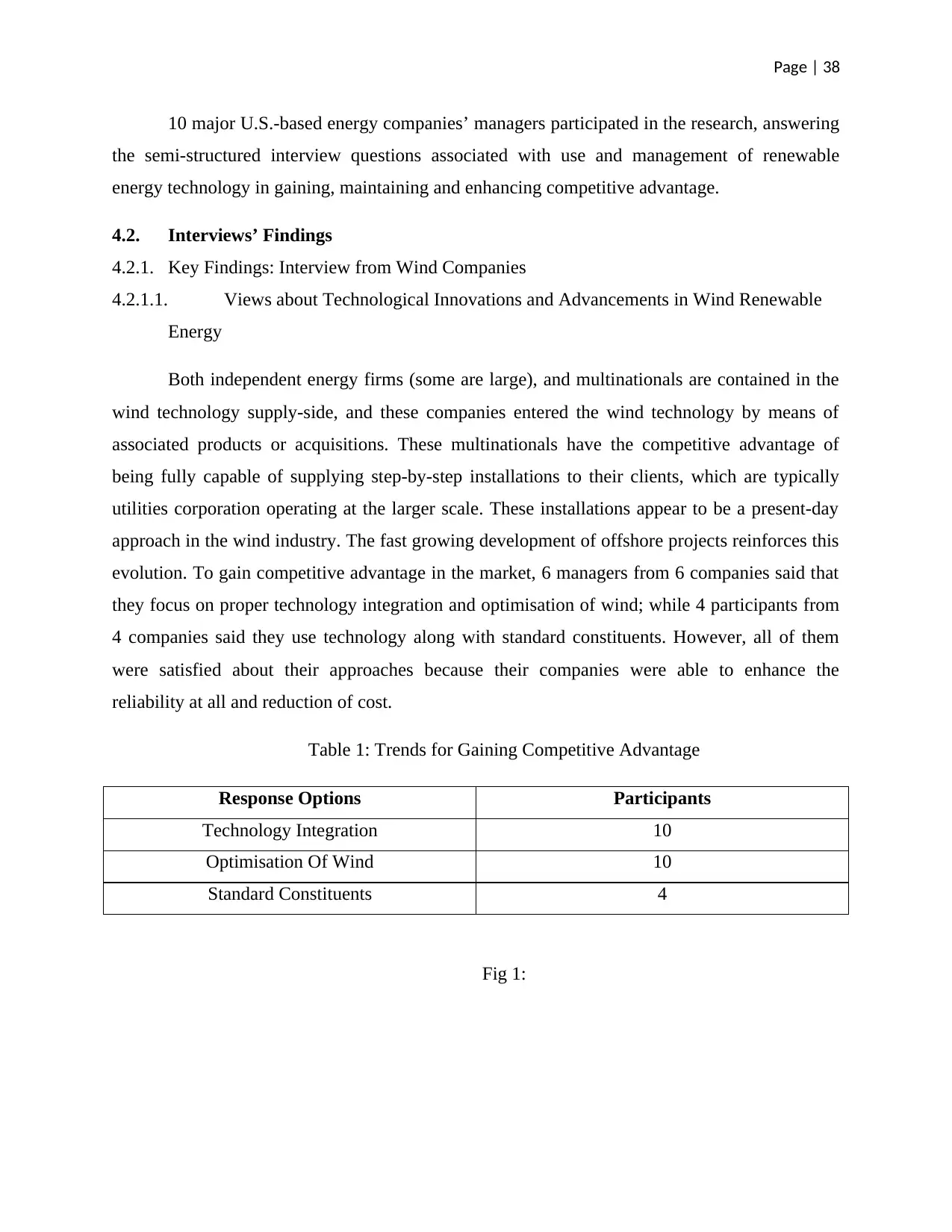
Page | 38
10 major U.S.-based energy companies’ managers participated in the research, answering
the semi-structured interview questions associated with use and management of renewable
energy technology in gaining, maintaining and enhancing competitive advantage.
4.2. Interviews’ Findings
4.2.1. Key Findings: Interview from Wind Companies
4.2.1.1. Views about Technological Innovations and Advancements in Wind Renewable
Energy
Both independent energy firms (some are large), and multinationals are contained in the
wind technology supply-side, and these companies entered the wind technology by means of
associated products or acquisitions. These multinationals have the competitive advantage of
being fully capable of supplying step-by-step installations to their clients, which are typically
utilities corporation operating at the larger scale. These installations appear to be a present-day
approach in the wind industry. The fast growing development of offshore projects reinforces this
evolution. To gain competitive advantage in the market, 6 managers from 6 companies said that
they focus on proper technology integration and optimisation of wind; while 4 participants from
4 companies said they use technology along with standard constituents. However, all of them
were satisfied about their approaches because their companies were able to enhance the
reliability at all and reduction of cost.
Table 1: Trends for Gaining Competitive Advantage
Response Options Participants
Technology Integration 10
Optimisation Of Wind 10
Standard Constituents 4
Fig 1:
10 major U.S.-based energy companies’ managers participated in the research, answering
the semi-structured interview questions associated with use and management of renewable
energy technology in gaining, maintaining and enhancing competitive advantage.
4.2. Interviews’ Findings
4.2.1. Key Findings: Interview from Wind Companies
4.2.1.1. Views about Technological Innovations and Advancements in Wind Renewable
Energy
Both independent energy firms (some are large), and multinationals are contained in the
wind technology supply-side, and these companies entered the wind technology by means of
associated products or acquisitions. These multinationals have the competitive advantage of
being fully capable of supplying step-by-step installations to their clients, which are typically
utilities corporation operating at the larger scale. These installations appear to be a present-day
approach in the wind industry. The fast growing development of offshore projects reinforces this
evolution. To gain competitive advantage in the market, 6 managers from 6 companies said that
they focus on proper technology integration and optimisation of wind; while 4 participants from
4 companies said they use technology along with standard constituents. However, all of them
were satisfied about their approaches because their companies were able to enhance the
reliability at all and reduction of cost.
Table 1: Trends for Gaining Competitive Advantage
Response Options Participants
Technology Integration 10
Optimisation Of Wind 10
Standard Constituents 4
Fig 1:
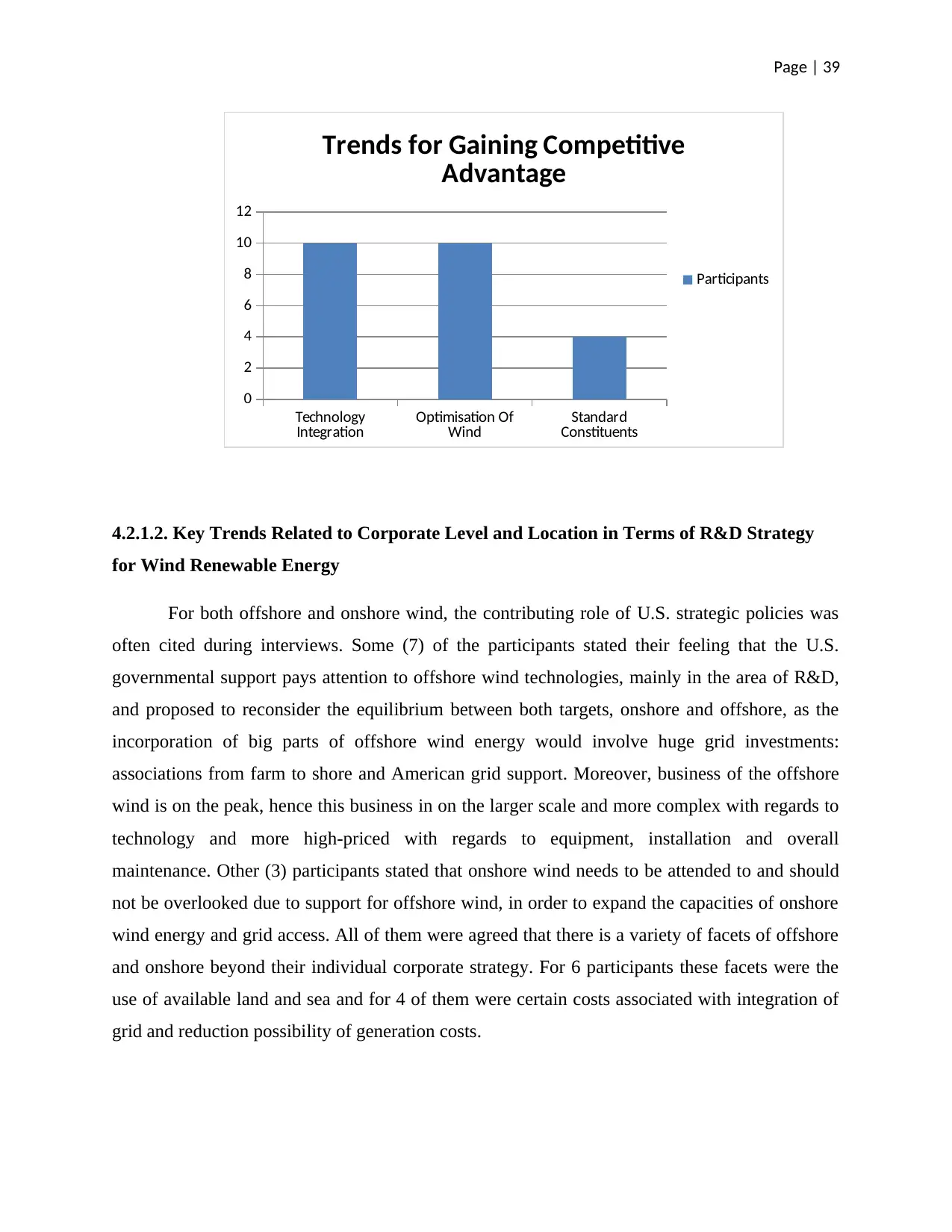
Page | 39
Technology
Integration Optimisation Of
Wind Standard
Constituents
0
2
4
6
8
10
12
Trends for Gaining Competitive
Advantage
Participants
4.2.1.2. Key Trends Related to Corporate Level and Location in Terms of R&D Strategy
for Wind Renewable Energy
For both offshore and onshore wind, the contributing role of U.S. strategic policies was
often cited during interviews. Some (7) of the participants stated their feeling that the U.S.
governmental support pays attention to offshore wind technologies, mainly in the area of R&D,
and proposed to reconsider the equilibrium between both targets, onshore and offshore, as the
incorporation of big parts of offshore wind energy would involve huge grid investments:
associations from farm to shore and American grid support. Moreover, business of the offshore
wind is on the peak, hence this business in on the larger scale and more complex with regards to
technology and more high-priced with regards to equipment, installation and overall
maintenance. Other (3) participants stated that onshore wind needs to be attended to and should
not be overlooked due to support for offshore wind, in order to expand the capacities of onshore
wind energy and grid access. All of them were agreed that there is a variety of facets of offshore
and onshore beyond their individual corporate strategy. For 6 participants these facets were the
use of available land and sea and for 4 of them were certain costs associated with integration of
grid and reduction possibility of generation costs.
Technology
Integration Optimisation Of
Wind Standard
Constituents
0
2
4
6
8
10
12
Trends for Gaining Competitive
Advantage
Participants
4.2.1.2. Key Trends Related to Corporate Level and Location in Terms of R&D Strategy
for Wind Renewable Energy
For both offshore and onshore wind, the contributing role of U.S. strategic policies was
often cited during interviews. Some (7) of the participants stated their feeling that the U.S.
governmental support pays attention to offshore wind technologies, mainly in the area of R&D,
and proposed to reconsider the equilibrium between both targets, onshore and offshore, as the
incorporation of big parts of offshore wind energy would involve huge grid investments:
associations from farm to shore and American grid support. Moreover, business of the offshore
wind is on the peak, hence this business in on the larger scale and more complex with regards to
technology and more high-priced with regards to equipment, installation and overall
maintenance. Other (3) participants stated that onshore wind needs to be attended to and should
not be overlooked due to support for offshore wind, in order to expand the capacities of onshore
wind energy and grid access. All of them were agreed that there is a variety of facets of offshore
and onshore beyond their individual corporate strategy. For 6 participants these facets were the
use of available land and sea and for 4 of them were certain costs associated with integration of
grid and reduction possibility of generation costs.
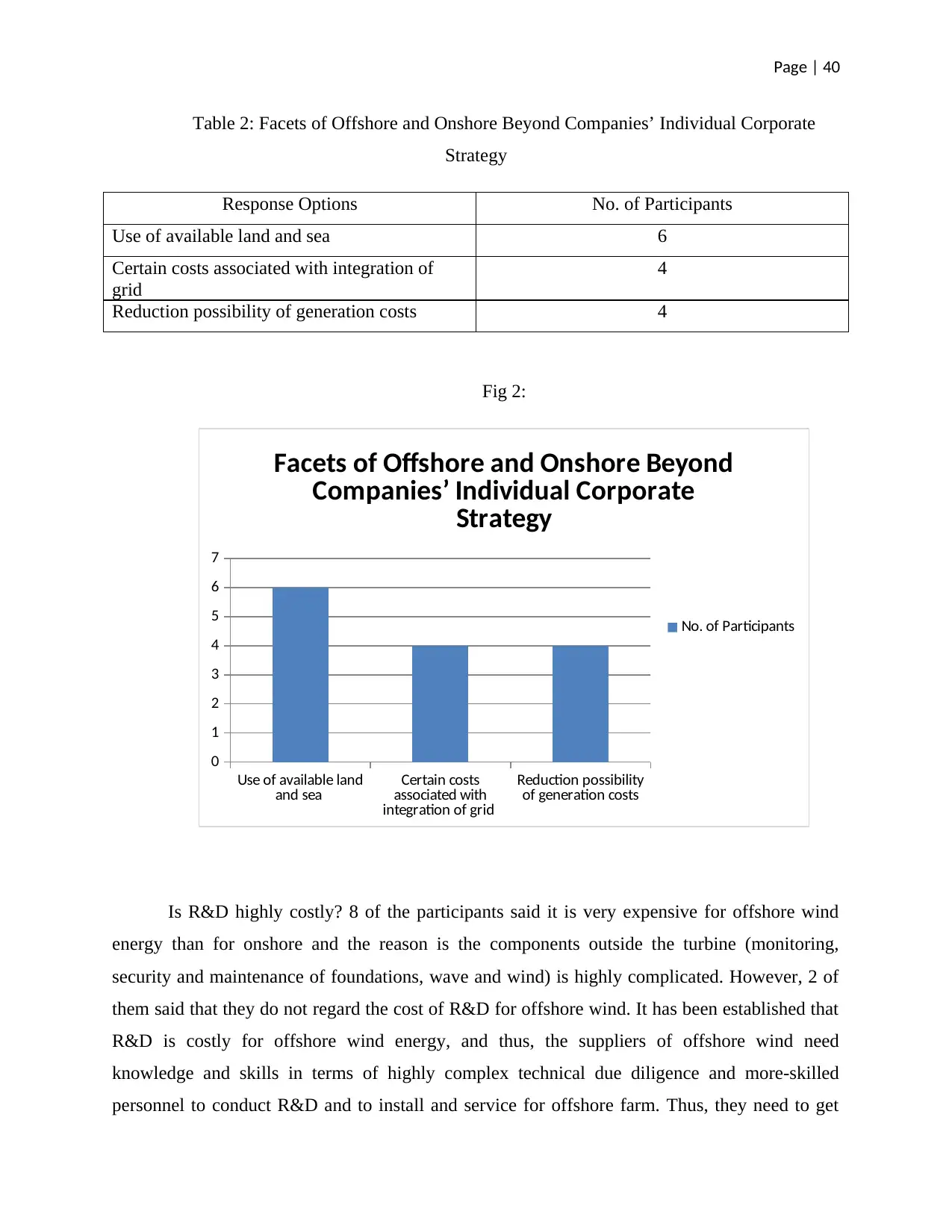
Page | 40
Table 2: Facets of Offshore and Onshore Beyond Companies’ Individual Corporate
Strategy
Response Options No. of Participants
Use of available land and sea 6
Certain costs associated with integration of
grid
4
Reduction possibility of generation costs 4
Fig 2:
Use of available land
and sea Certain costs
associated with
integration of grid
Reduction possibility
of generation costs
0
1
2
3
4
5
6
7
Facets of Offshore and Onshore Beyond
Companies’ Individual Corporate
Strategy
No. of Participants
Is R&D highly costly? 8 of the participants said it is very expensive for offshore wind
energy than for onshore and the reason is the components outside the turbine (monitoring,
security and maintenance of foundations, wave and wind) is highly complicated. However, 2 of
them said that they do not regard the cost of R&D for offshore wind. It has been established that
R&D is costly for offshore wind energy, and thus, the suppliers of offshore wind need
knowledge and skills in terms of highly complex technical due diligence and more-skilled
personnel to conduct R&D and to install and service for offshore farm. Thus, they need to get
Table 2: Facets of Offshore and Onshore Beyond Companies’ Individual Corporate
Strategy
Response Options No. of Participants
Use of available land and sea 6
Certain costs associated with integration of
grid
4
Reduction possibility of generation costs 4
Fig 2:
Use of available land
and sea Certain costs
associated with
integration of grid
Reduction possibility
of generation costs
0
1
2
3
4
5
6
7
Facets of Offshore and Onshore Beyond
Companies’ Individual Corporate
Strategy
No. of Participants
Is R&D highly costly? 8 of the participants said it is very expensive for offshore wind
energy than for onshore and the reason is the components outside the turbine (monitoring,
security and maintenance of foundations, wave and wind) is highly complicated. However, 2 of
them said that they do not regard the cost of R&D for offshore wind. It has been established that
R&D is costly for offshore wind energy, and thus, the suppliers of offshore wind need
knowledge and skills in terms of highly complex technical due diligence and more-skilled
personnel to conduct R&D and to install and service for offshore farm. Thus, they need to get
Secure Best Marks with AI Grader
Need help grading? Try our AI Grader for instant feedback on your assignments.
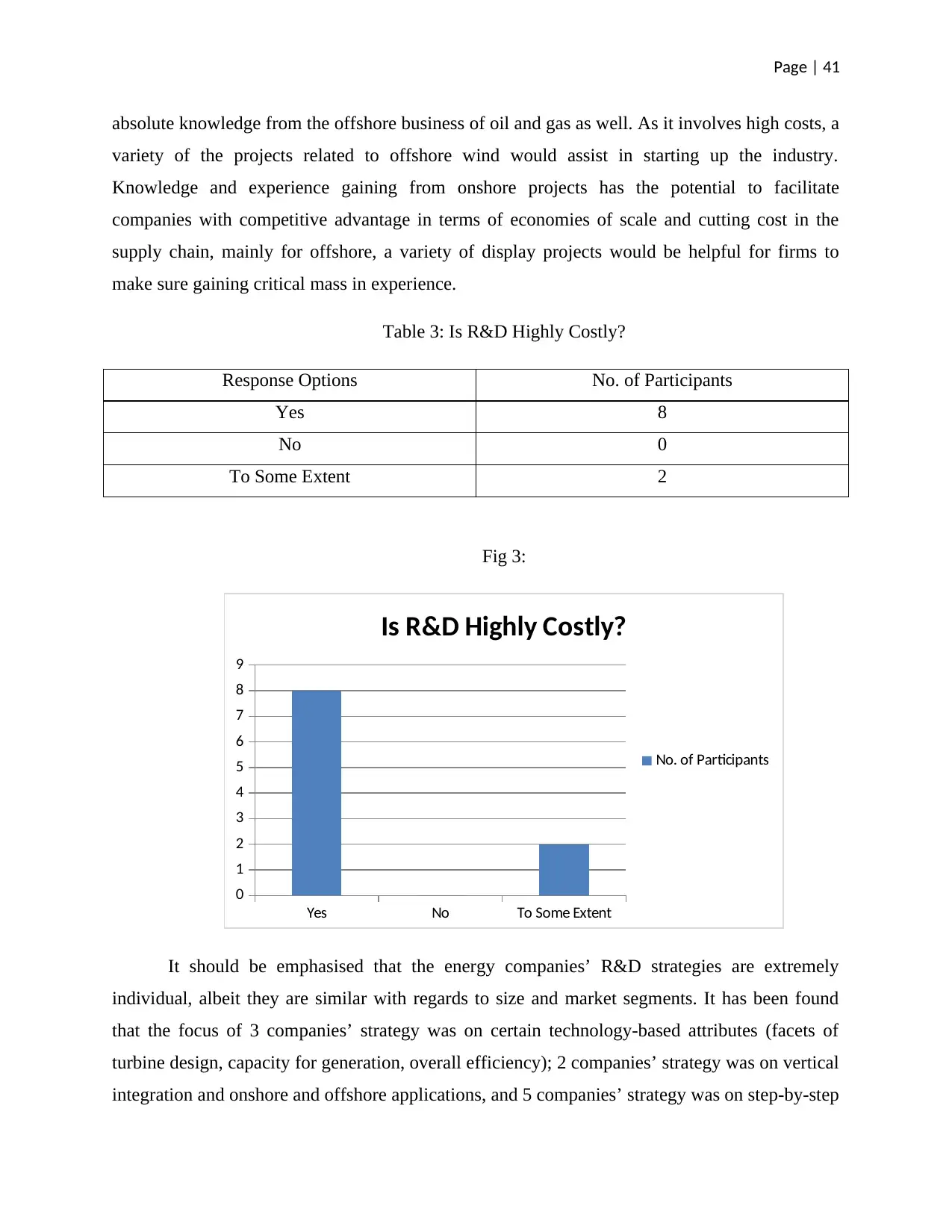
Page | 41
absolute knowledge from the offshore business of oil and gas as well. As it involves high costs, a
variety of the projects related to offshore wind would assist in starting up the industry.
Knowledge and experience gaining from onshore projects has the potential to facilitate
companies with competitive advantage in terms of economies of scale and cutting cost in the
supply chain, mainly for offshore, a variety of display projects would be helpful for firms to
make sure gaining critical mass in experience.
Table 3: Is R&D Highly Costly?
Response Options No. of Participants
Yes 8
No 0
To Some Extent 2
Fig 3:
Yes No To Some Extent
0
1
2
3
4
5
6
7
8
9
Is R&D Highly Costly?
No. of Participants
It should be emphasised that the energy companies’ R&D strategies are extremely
individual, albeit they are similar with regards to size and market segments. It has been found
that the focus of 3 companies’ strategy was on certain technology-based attributes (facets of
turbine design, capacity for generation, overall efficiency); 2 companies’ strategy was on vertical
integration and onshore and offshore applications, and 5 companies’ strategy was on step-by-step
absolute knowledge from the offshore business of oil and gas as well. As it involves high costs, a
variety of the projects related to offshore wind would assist in starting up the industry.
Knowledge and experience gaining from onshore projects has the potential to facilitate
companies with competitive advantage in terms of economies of scale and cutting cost in the
supply chain, mainly for offshore, a variety of display projects would be helpful for firms to
make sure gaining critical mass in experience.
Table 3: Is R&D Highly Costly?
Response Options No. of Participants
Yes 8
No 0
To Some Extent 2
Fig 3:
Yes No To Some Extent
0
1
2
3
4
5
6
7
8
9
Is R&D Highly Costly?
No. of Participants
It should be emphasised that the energy companies’ R&D strategies are extremely
individual, albeit they are similar with regards to size and market segments. It has been found
that the focus of 3 companies’ strategy was on certain technology-based attributes (facets of
turbine design, capacity for generation, overall efficiency); 2 companies’ strategy was on vertical
integration and onshore and offshore applications, and 5 companies’ strategy was on step-by-step

Page | 42
installations and incorporation with the traditional energy grid. Thus, variation exists in their
needs and objectives, with regards to what they anticipate from decision/policy-makers. Further,
this applies to location of R&D and activities related to manufacturing, where some energy firms
are especially present in the U.S. and others are globally-locally. Nevertheless, it appears that the
more strategic activities of R&D are located home ground or near to the companies because of
the practical issues, such as Intellectual Property (IP), easier testing and closeness to the place of
manufacturing. It was emphasised by half of the interviewees that there is not too much benefit
by relocating R&D, mainly the strategic areas, remote from the U.S. because of the region’s IP
protection and the technological leadership. It is very interesting that costs of R&D were not
discussed in this respect.
Table 4: Focus of Companies’ Strategy
Response options No. of Participants
Certain technology-based attributes 3
Vertical integration 2
Onshore and offshore applications 2
Step-by-step installations and incorporation
with the traditional energy grid
5
Fig 4:
installations and incorporation with the traditional energy grid. Thus, variation exists in their
needs and objectives, with regards to what they anticipate from decision/policy-makers. Further,
this applies to location of R&D and activities related to manufacturing, where some energy firms
are especially present in the U.S. and others are globally-locally. Nevertheless, it appears that the
more strategic activities of R&D are located home ground or near to the companies because of
the practical issues, such as Intellectual Property (IP), easier testing and closeness to the place of
manufacturing. It was emphasised by half of the interviewees that there is not too much benefit
by relocating R&D, mainly the strategic areas, remote from the U.S. because of the region’s IP
protection and the technological leadership. It is very interesting that costs of R&D were not
discussed in this respect.
Table 4: Focus of Companies’ Strategy
Response options No. of Participants
Certain technology-based attributes 3
Vertical integration 2
Onshore and offshore applications 2
Step-by-step installations and incorporation
with the traditional energy grid
5
Fig 4:
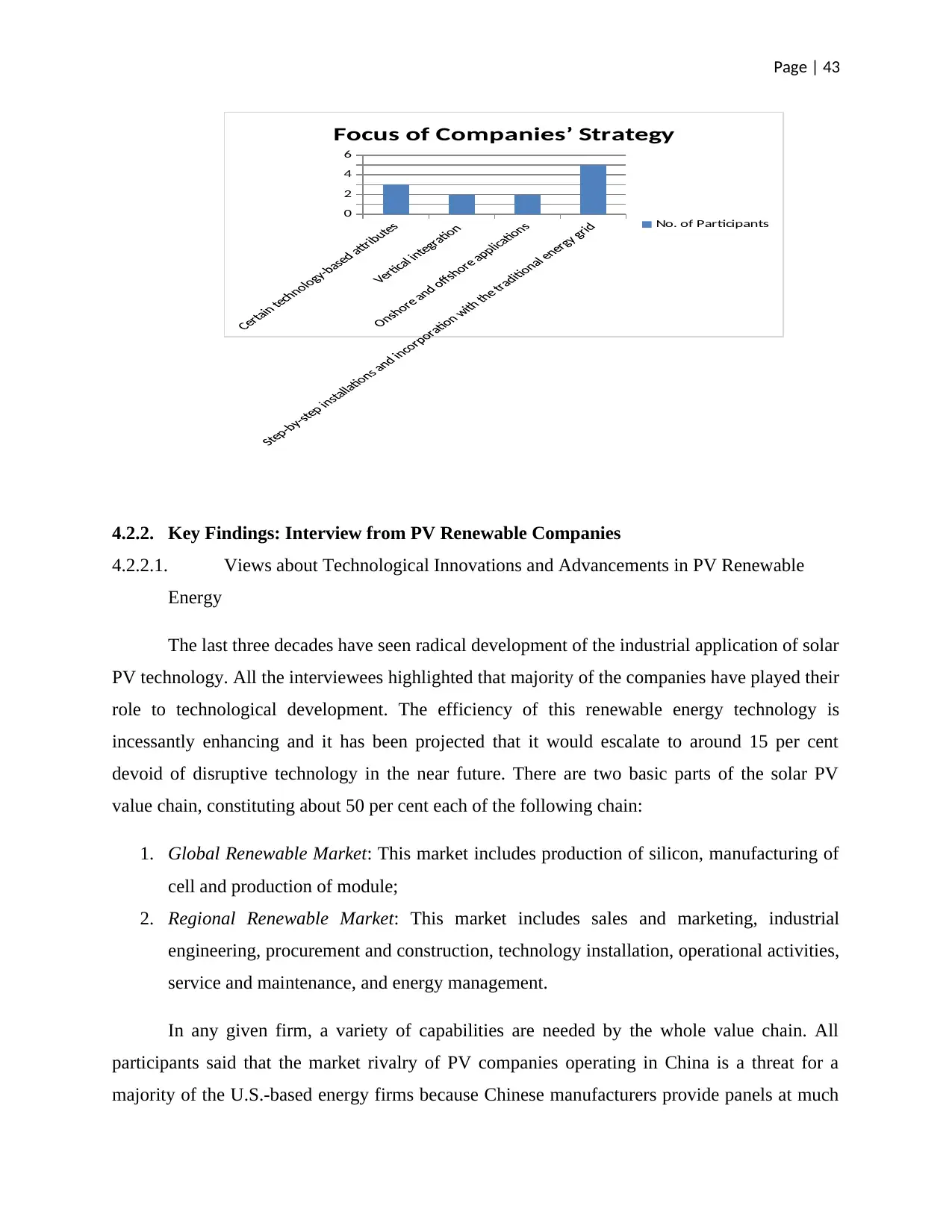
Page | 43
0
2
4
6
Focus of Companies’ Strategy
No. of Participants
4.2.2. Key Findings: Interview from PV Renewable Companies
4.2.2.1. Views about Technological Innovations and Advancements in PV Renewable
Energy
The last three decades have seen radical development of the industrial application of solar
PV technology. All the interviewees highlighted that majority of the companies have played their
role to technological development. The efficiency of this renewable energy technology is
incessantly enhancing and it has been projected that it would escalate to around 15 per cent
devoid of disruptive technology in the near future. There are two basic parts of the solar PV
value chain, constituting about 50 per cent each of the following chain:
1. Global Renewable Market: This market includes production of silicon, manufacturing of
cell and production of module;
2. Regional Renewable Market: This market includes sales and marketing, industrial
engineering, procurement and construction, technology installation, operational activities,
service and maintenance, and energy management.
In any given firm, a variety of capabilities are needed by the whole value chain. All
participants said that the market rivalry of PV companies operating in China is a threat for a
majority of the U.S.-based energy firms because Chinese manufacturers provide panels at much
0
2
4
6
Focus of Companies’ Strategy
No. of Participants
4.2.2. Key Findings: Interview from PV Renewable Companies
4.2.2.1. Views about Technological Innovations and Advancements in PV Renewable
Energy
The last three decades have seen radical development of the industrial application of solar
PV technology. All the interviewees highlighted that majority of the companies have played their
role to technological development. The efficiency of this renewable energy technology is
incessantly enhancing and it has been projected that it would escalate to around 15 per cent
devoid of disruptive technology in the near future. There are two basic parts of the solar PV
value chain, constituting about 50 per cent each of the following chain:
1. Global Renewable Market: This market includes production of silicon, manufacturing of
cell and production of module;
2. Regional Renewable Market: This market includes sales and marketing, industrial
engineering, procurement and construction, technology installation, operational activities,
service and maintenance, and energy management.
In any given firm, a variety of capabilities are needed by the whole value chain. All
participants said that the market rivalry of PV companies operating in China is a threat for a
majority of the U.S.-based energy firms because Chinese manufacturers provide panels at much
Paraphrase This Document
Need a fresh take? Get an instant paraphrase of this document with our AI Paraphraser
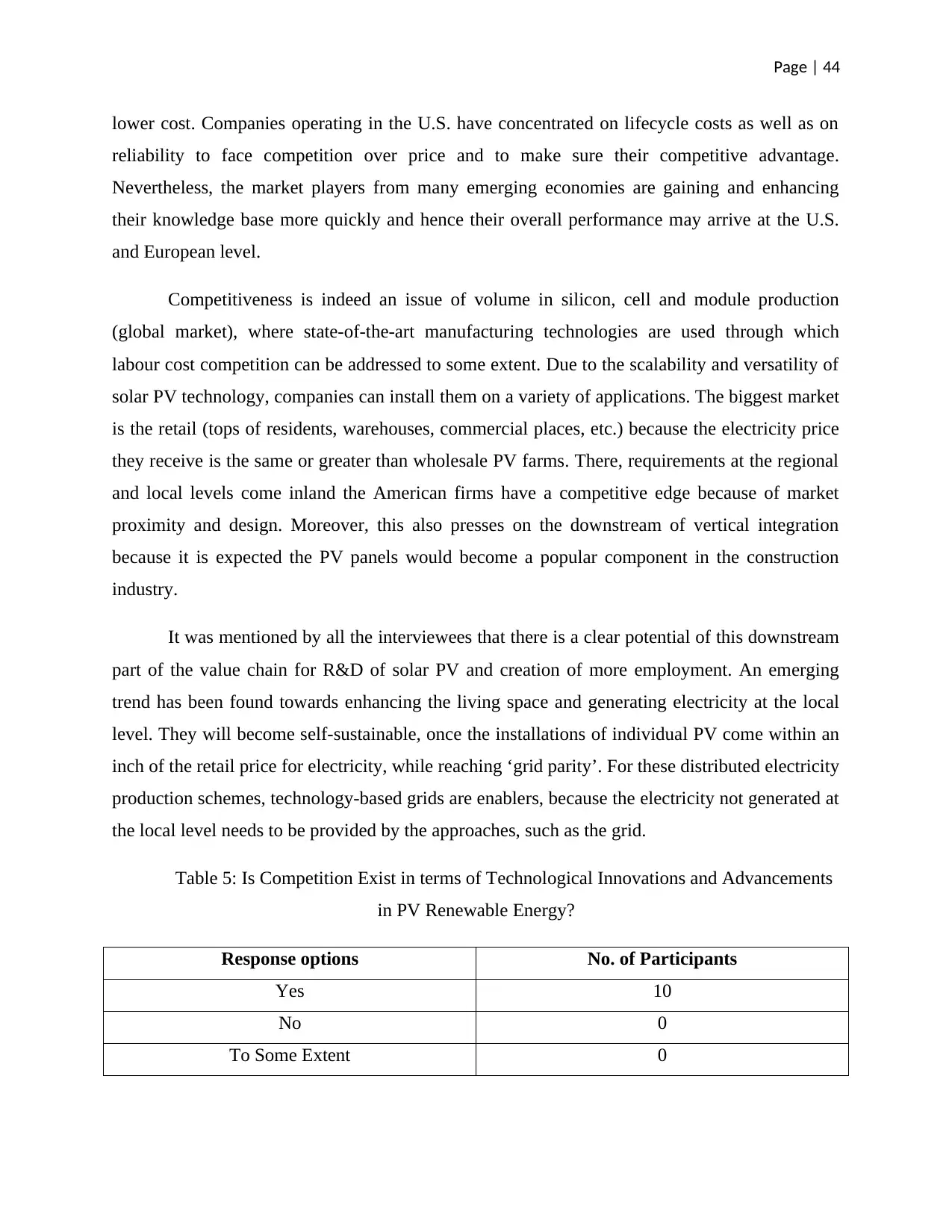
Page | 44
lower cost. Companies operating in the U.S. have concentrated on lifecycle costs as well as on
reliability to face competition over price and to make sure their competitive advantage.
Nevertheless, the market players from many emerging economies are gaining and enhancing
their knowledge base more quickly and hence their overall performance may arrive at the U.S.
and European level.
Competitiveness is indeed an issue of volume in silicon, cell and module production
(global market), where state-of-the-art manufacturing technologies are used through which
labour cost competition can be addressed to some extent. Due to the scalability and versatility of
solar PV technology, companies can install them on a variety of applications. The biggest market
is the retail (tops of residents, warehouses, commercial places, etc.) because the electricity price
they receive is the same or greater than wholesale PV farms. There, requirements at the regional
and local levels come inland the American firms have a competitive edge because of market
proximity and design. Moreover, this also presses on the downstream of vertical integration
because it is expected the PV panels would become a popular component in the construction
industry.
It was mentioned by all the interviewees that there is a clear potential of this downstream
part of the value chain for R&D of solar PV and creation of more employment. An emerging
trend has been found towards enhancing the living space and generating electricity at the local
level. They will become self-sustainable, once the installations of individual PV come within an
inch of the retail price for electricity, while reaching ‘grid parity’. For these distributed electricity
production schemes, technology-based grids are enablers, because the electricity not generated at
the local level needs to be provided by the approaches, such as the grid.
Table 5: Is Competition Exist in terms of Technological Innovations and Advancements
in PV Renewable Energy?
Response options No. of Participants
Yes 10
No 0
To Some Extent 0
lower cost. Companies operating in the U.S. have concentrated on lifecycle costs as well as on
reliability to face competition over price and to make sure their competitive advantage.
Nevertheless, the market players from many emerging economies are gaining and enhancing
their knowledge base more quickly and hence their overall performance may arrive at the U.S.
and European level.
Competitiveness is indeed an issue of volume in silicon, cell and module production
(global market), where state-of-the-art manufacturing technologies are used through which
labour cost competition can be addressed to some extent. Due to the scalability and versatility of
solar PV technology, companies can install them on a variety of applications. The biggest market
is the retail (tops of residents, warehouses, commercial places, etc.) because the electricity price
they receive is the same or greater than wholesale PV farms. There, requirements at the regional
and local levels come inland the American firms have a competitive edge because of market
proximity and design. Moreover, this also presses on the downstream of vertical integration
because it is expected the PV panels would become a popular component in the construction
industry.
It was mentioned by all the interviewees that there is a clear potential of this downstream
part of the value chain for R&D of solar PV and creation of more employment. An emerging
trend has been found towards enhancing the living space and generating electricity at the local
level. They will become self-sustainable, once the installations of individual PV come within an
inch of the retail price for electricity, while reaching ‘grid parity’. For these distributed electricity
production schemes, technology-based grids are enablers, because the electricity not generated at
the local level needs to be provided by the approaches, such as the grid.
Table 5: Is Competition Exist in terms of Technological Innovations and Advancements
in PV Renewable Energy?
Response options No. of Participants
Yes 10
No 0
To Some Extent 0
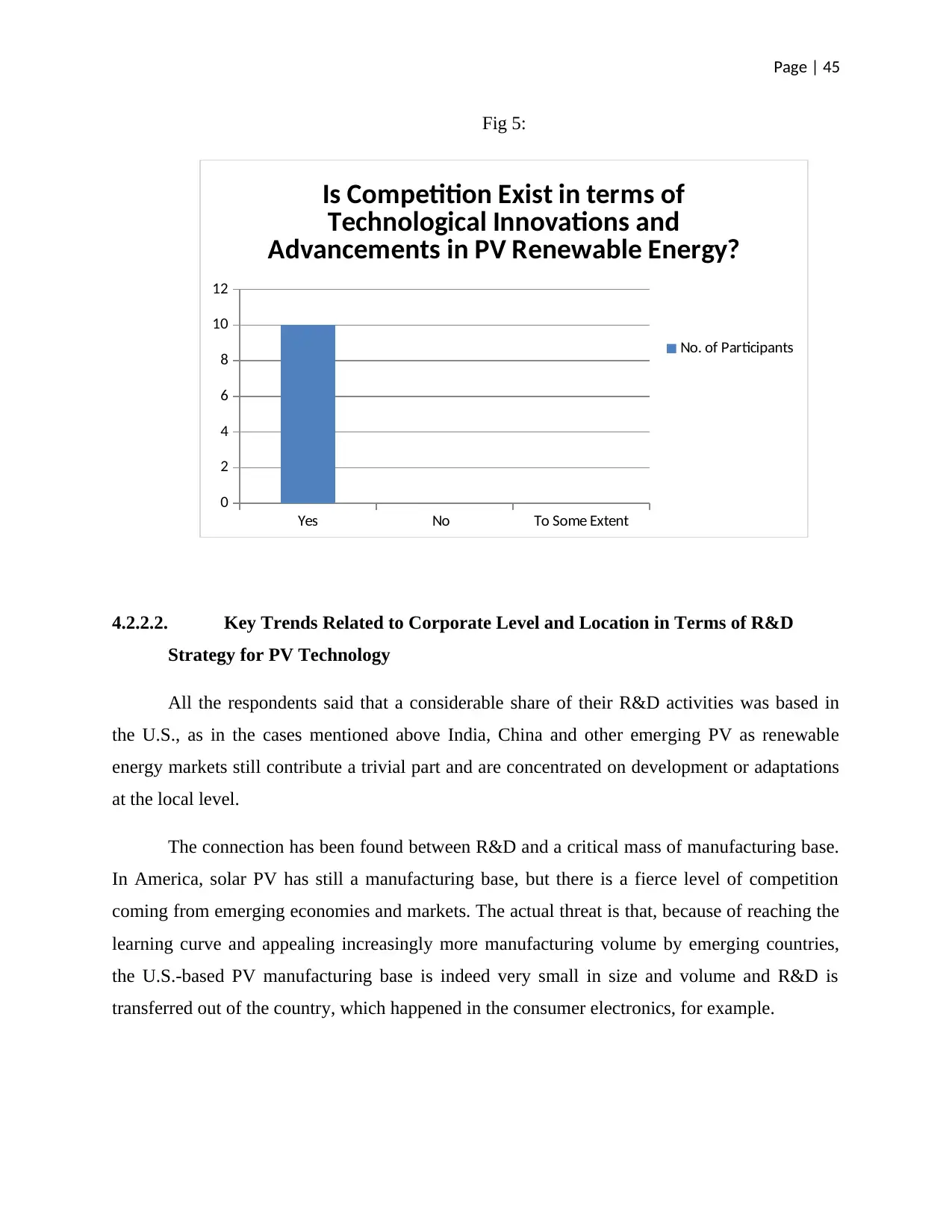
Page | 45
Fig 5:
Yes No To Some Extent
0
2
4
6
8
10
12
Is Competition Exist in terms of
Technological Innovations and
Advancements in PV Renewable Energy?
No. of Participants
4.2.2.2. Key Trends Related to Corporate Level and Location in Terms of R&D
Strategy for PV Technology
All the respondents said that a considerable share of their R&D activities was based in
the U.S., as in the cases mentioned above India, China and other emerging PV as renewable
energy markets still contribute a trivial part and are concentrated on development or adaptations
at the local level.
The connection has been found between R&D and a critical mass of manufacturing base.
In America, solar PV has still a manufacturing base, but there is a fierce level of competition
coming from emerging economies and markets. The actual threat is that, because of reaching the
learning curve and appealing increasingly more manufacturing volume by emerging countries,
the U.S.-based PV manufacturing base is indeed very small in size and volume and R&D is
transferred out of the country, which happened in the consumer electronics, for example.
Fig 5:
Yes No To Some Extent
0
2
4
6
8
10
12
Is Competition Exist in terms of
Technological Innovations and
Advancements in PV Renewable Energy?
No. of Participants
4.2.2.2. Key Trends Related to Corporate Level and Location in Terms of R&D
Strategy for PV Technology
All the respondents said that a considerable share of their R&D activities was based in
the U.S., as in the cases mentioned above India, China and other emerging PV as renewable
energy markets still contribute a trivial part and are concentrated on development or adaptations
at the local level.
The connection has been found between R&D and a critical mass of manufacturing base.
In America, solar PV has still a manufacturing base, but there is a fierce level of competition
coming from emerging economies and markets. The actual threat is that, because of reaching the
learning curve and appealing increasingly more manufacturing volume by emerging countries,
the U.S.-based PV manufacturing base is indeed very small in size and volume and R&D is
transferred out of the country, which happened in the consumer electronics, for example.
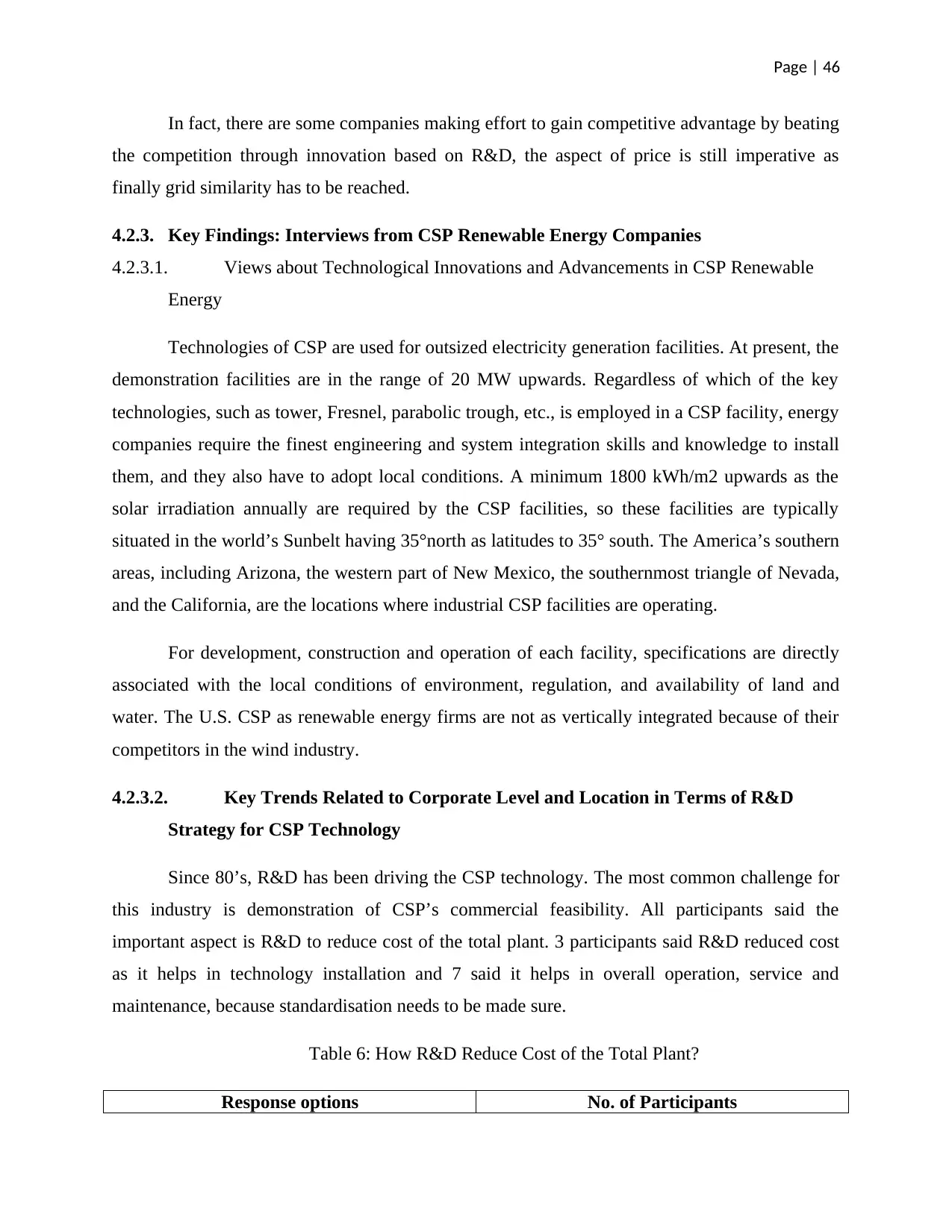
Page | 46
In fact, there are some companies making effort to gain competitive advantage by beating
the competition through innovation based on R&D, the aspect of price is still imperative as
finally grid similarity has to be reached.
4.2.3. Key Findings: Interviews from CSP Renewable Energy Companies
4.2.3.1. Views about Technological Innovations and Advancements in CSP Renewable
Energy
Technologies of CSP are used for outsized electricity generation facilities. At present, the
demonstration facilities are in the range of 20 MW upwards. Regardless of which of the key
technologies, such as tower, Fresnel, parabolic trough, etc., is employed in a CSP facility, energy
companies require the finest engineering and system integration skills and knowledge to install
them, and they also have to adopt local conditions. A minimum 1800 kWh/m2 upwards as the
solar irradiation annually are required by the CSP facilities, so these facilities are typically
situated in the world’s Sunbelt having 35°north as latitudes to 35° south. The America’s southern
areas, including Arizona, the western part of New Mexico, the southernmost triangle of Nevada,
and the California, are the locations where industrial CSP facilities are operating.
For development, construction and operation of each facility, specifications are directly
associated with the local conditions of environment, regulation, and availability of land and
water. The U.S. CSP as renewable energy firms are not as vertically integrated because of their
competitors in the wind industry.
4.2.3.2. Key Trends Related to Corporate Level and Location in Terms of R&D
Strategy for CSP Technology
Since 80’s, R&D has been driving the CSP technology. The most common challenge for
this industry is demonstration of CSP’s commercial feasibility. All participants said the
important aspect is R&D to reduce cost of the total plant. 3 participants said R&D reduced cost
as it helps in technology installation and 7 said it helps in overall operation, service and
maintenance, because standardisation needs to be made sure.
Table 6: How R&D Reduce Cost of the Total Plant?
Response options No. of Participants
In fact, there are some companies making effort to gain competitive advantage by beating
the competition through innovation based on R&D, the aspect of price is still imperative as
finally grid similarity has to be reached.
4.2.3. Key Findings: Interviews from CSP Renewable Energy Companies
4.2.3.1. Views about Technological Innovations and Advancements in CSP Renewable
Energy
Technologies of CSP are used for outsized electricity generation facilities. At present, the
demonstration facilities are in the range of 20 MW upwards. Regardless of which of the key
technologies, such as tower, Fresnel, parabolic trough, etc., is employed in a CSP facility, energy
companies require the finest engineering and system integration skills and knowledge to install
them, and they also have to adopt local conditions. A minimum 1800 kWh/m2 upwards as the
solar irradiation annually are required by the CSP facilities, so these facilities are typically
situated in the world’s Sunbelt having 35°north as latitudes to 35° south. The America’s southern
areas, including Arizona, the western part of New Mexico, the southernmost triangle of Nevada,
and the California, are the locations where industrial CSP facilities are operating.
For development, construction and operation of each facility, specifications are directly
associated with the local conditions of environment, regulation, and availability of land and
water. The U.S. CSP as renewable energy firms are not as vertically integrated because of their
competitors in the wind industry.
4.2.3.2. Key Trends Related to Corporate Level and Location in Terms of R&D
Strategy for CSP Technology
Since 80’s, R&D has been driving the CSP technology. The most common challenge for
this industry is demonstration of CSP’s commercial feasibility. All participants said the
important aspect is R&D to reduce cost of the total plant. 3 participants said R&D reduced cost
as it helps in technology installation and 7 said it helps in overall operation, service and
maintenance, because standardisation needs to be made sure.
Table 6: How R&D Reduce Cost of the Total Plant?
Response options No. of Participants
Secure Best Marks with AI Grader
Need help grading? Try our AI Grader for instant feedback on your assignments.
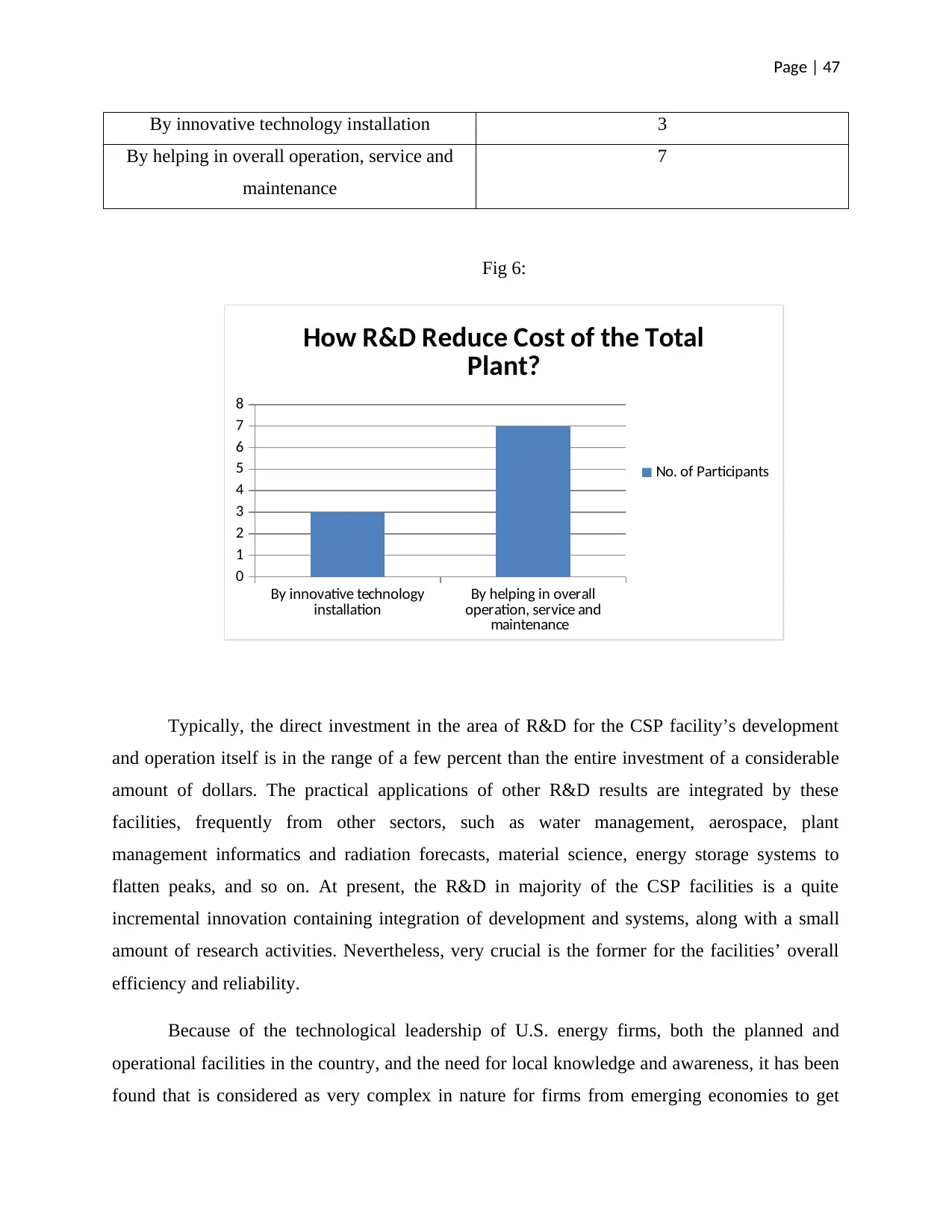
Page | 47
By innovative technology installation 3
By helping in overall operation, service and
maintenance
7
Fig 6:
By innovative technology
installation By helping in overall
operation, service and
maintenance
0
1
2
3
4
5
6
7
8
How R&D Reduce Cost of the Total
Plant?
No. of Participants
Typically, the direct investment in the area of R&D for the CSP facility’s development
and operation itself is in the range of a few percent than the entire investment of a considerable
amount of dollars. The practical applications of other R&D results are integrated by these
facilities, frequently from other sectors, such as water management, aerospace, plant
management informatics and radiation forecasts, material science, energy storage systems to
flatten peaks, and so on. At present, the R&D in majority of the CSP facilities is a quite
incremental innovation containing integration of development and systems, along with a small
amount of research activities. Nevertheless, very crucial is the former for the facilities’ overall
efficiency and reliability.
Because of the technological leadership of U.S. energy firms, both the planned and
operational facilities in the country, and the need for local knowledge and awareness, it has been
found that is considered as very complex in nature for firms from emerging economies to get
By innovative technology installation 3
By helping in overall operation, service and
maintenance
7
Fig 6:
By innovative technology
installation By helping in overall
operation, service and
maintenance
0
1
2
3
4
5
6
7
8
How R&D Reduce Cost of the Total
Plant?
No. of Participants
Typically, the direct investment in the area of R&D for the CSP facility’s development
and operation itself is in the range of a few percent than the entire investment of a considerable
amount of dollars. The practical applications of other R&D results are integrated by these
facilities, frequently from other sectors, such as water management, aerospace, plant
management informatics and radiation forecasts, material science, energy storage systems to
flatten peaks, and so on. At present, the R&D in majority of the CSP facilities is a quite
incremental innovation containing integration of development and systems, along with a small
amount of research activities. Nevertheless, very crucial is the former for the facilities’ overall
efficiency and reliability.
Because of the technological leadership of U.S. energy firms, both the planned and
operational facilities in the country, and the need for local knowledge and awareness, it has been
found that is considered as very complex in nature for firms from emerging economies to get
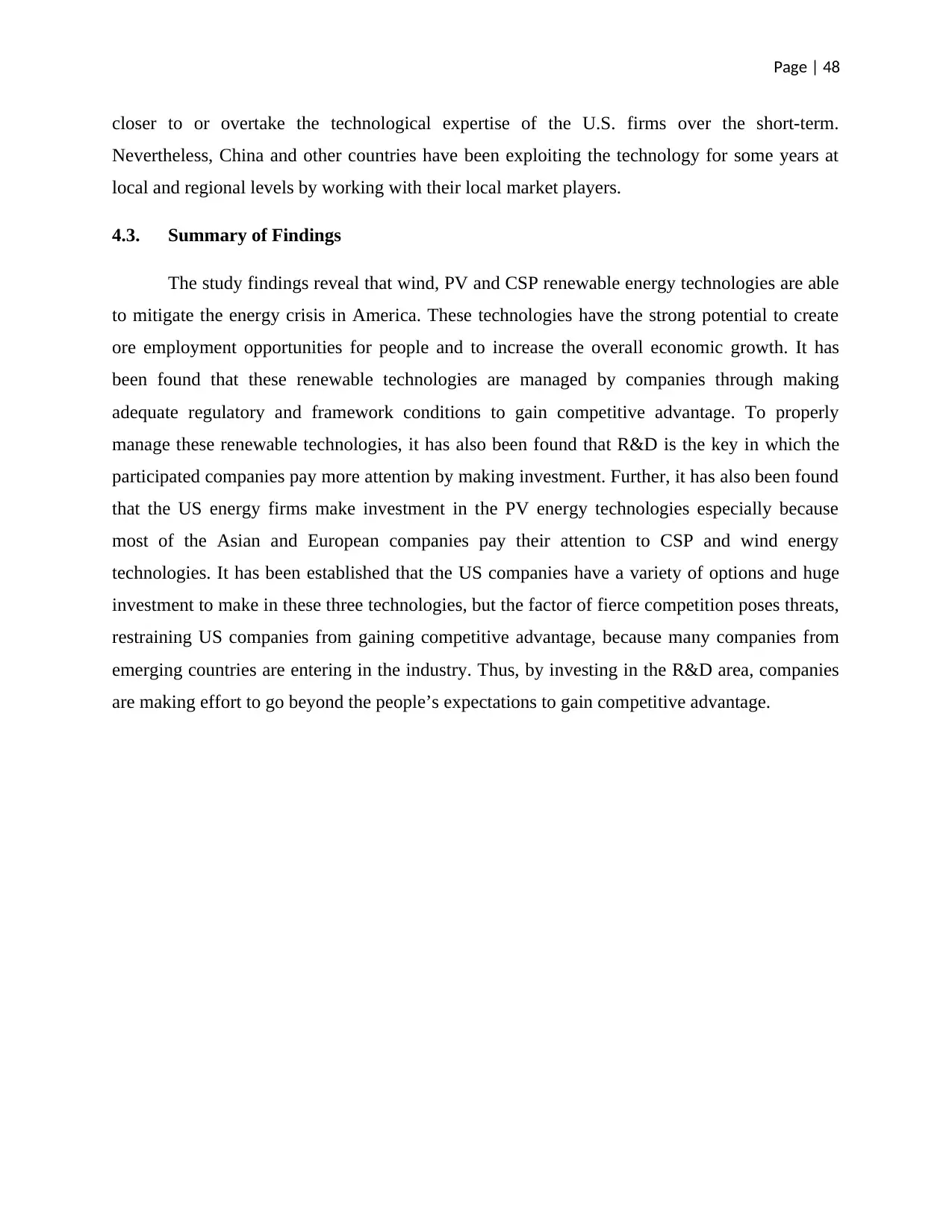
Page | 48
closer to or overtake the technological expertise of the U.S. firms over the short-term.
Nevertheless, China and other countries have been exploiting the technology for some years at
local and regional levels by working with their local market players.
4.3. Summary of Findings
The study findings reveal that wind, PV and CSP renewable energy technologies are able
to mitigate the energy crisis in America. These technologies have the strong potential to create
ore employment opportunities for people and to increase the overall economic growth. It has
been found that these renewable technologies are managed by companies through making
adequate regulatory and framework conditions to gain competitive advantage. To properly
manage these renewable technologies, it has also been found that R&D is the key in which the
participated companies pay more attention by making investment. Further, it has also been found
that the US energy firms make investment in the PV energy technologies especially because
most of the Asian and European companies pay their attention to CSP and wind energy
technologies. It has been established that the US companies have a variety of options and huge
investment to make in these three technologies, but the factor of fierce competition poses threats,
restraining US companies from gaining competitive advantage, because many companies from
emerging countries are entering in the industry. Thus, by investing in the R&D area, companies
are making effort to go beyond the people’s expectations to gain competitive advantage.
closer to or overtake the technological expertise of the U.S. firms over the short-term.
Nevertheless, China and other countries have been exploiting the technology for some years at
local and regional levels by working with their local market players.
4.3. Summary of Findings
The study findings reveal that wind, PV and CSP renewable energy technologies are able
to mitigate the energy crisis in America. These technologies have the strong potential to create
ore employment opportunities for people and to increase the overall economic growth. It has
been found that these renewable technologies are managed by companies through making
adequate regulatory and framework conditions to gain competitive advantage. To properly
manage these renewable technologies, it has also been found that R&D is the key in which the
participated companies pay more attention by making investment. Further, it has also been found
that the US energy firms make investment in the PV energy technologies especially because
most of the Asian and European companies pay their attention to CSP and wind energy
technologies. It has been established that the US companies have a variety of options and huge
investment to make in these three technologies, but the factor of fierce competition poses threats,
restraining US companies from gaining competitive advantage, because many companies from
emerging countries are entering in the industry. Thus, by investing in the R&D area, companies
are making effort to go beyond the people’s expectations to gain competitive advantage.

Page | 49
Chapter 5: Data Analysis and Discussion
5.0. Introduction
The aim and objective of this study was to validate the research findings of in-depth
analysis of management of renewable energy technologies to gain competitive advantage among
a group of selected research participants, who were the innovative energy companies’
management. The key research findings is presented and discussed, along with the data analysis
in the following. This research study reveals the results of a technology and economic based
analysis of three major renewable energy technologies, which are Solar Photovoltaics (PV),
Concentrating Solar Power (CSP), and Wind Energy Technologies. In this regard, the researcher
collected the bottom-up data of U.S. based innovative energy companies, along with factors
related to market supply and demand, and U.S. energy industry which has been compared with
the major competitors from other developing countries. Semi-structured interviews were
conducted with 10 key management personnel of the innovative companies operating in the
renewable energy sector to get primary information. This discussion, along with data analysis
through thematic analysis method, focuses on the key themes stated below:
Reappraising of the research findings based on the interviews;
Validation of the innovative energy companies’ views and standpoints using firm-
level information and the trends found; and
Discussion and analysis around the possible policy implications.
The data analysis along with in-depth discussion took place based with limited scope and
resources shows a variety of domains where improvement is required and it has been validated
that the general aspects recognised, the material examined and the management personnel of the
innovative companies interviewed facilitate the researcher by providing authentic information.
Behold the following analysis and discussion over the data collected.
5.1. Data Analysis
5.1.1. Stocktaking the Research Findings and the Management Interviews
The research on data collection and in-depth analysis of key factors of competition has
identified 10 energy companies from a variety of information sources available to publicly.
Chapter 5: Data Analysis and Discussion
5.0. Introduction
The aim and objective of this study was to validate the research findings of in-depth
analysis of management of renewable energy technologies to gain competitive advantage among
a group of selected research participants, who were the innovative energy companies’
management. The key research findings is presented and discussed, along with the data analysis
in the following. This research study reveals the results of a technology and economic based
analysis of three major renewable energy technologies, which are Solar Photovoltaics (PV),
Concentrating Solar Power (CSP), and Wind Energy Technologies. In this regard, the researcher
collected the bottom-up data of U.S. based innovative energy companies, along with factors
related to market supply and demand, and U.S. energy industry which has been compared with
the major competitors from other developing countries. Semi-structured interviews were
conducted with 10 key management personnel of the innovative companies operating in the
renewable energy sector to get primary information. This discussion, along with data analysis
through thematic analysis method, focuses on the key themes stated below:
Reappraising of the research findings based on the interviews;
Validation of the innovative energy companies’ views and standpoints using firm-
level information and the trends found; and
Discussion and analysis around the possible policy implications.
The data analysis along with in-depth discussion took place based with limited scope and
resources shows a variety of domains where improvement is required and it has been validated
that the general aspects recognised, the material examined and the management personnel of the
innovative companies interviewed facilitate the researcher by providing authentic information.
Behold the following analysis and discussion over the data collected.
5.1. Data Analysis
5.1.1. Stocktaking the Research Findings and the Management Interviews
The research on data collection and in-depth analysis of key factors of competition has
identified 10 energy companies from a variety of information sources available to publicly.
Paraphrase This Document
Need a fresh take? Get an instant paraphrase of this document with our AI Paraphraser
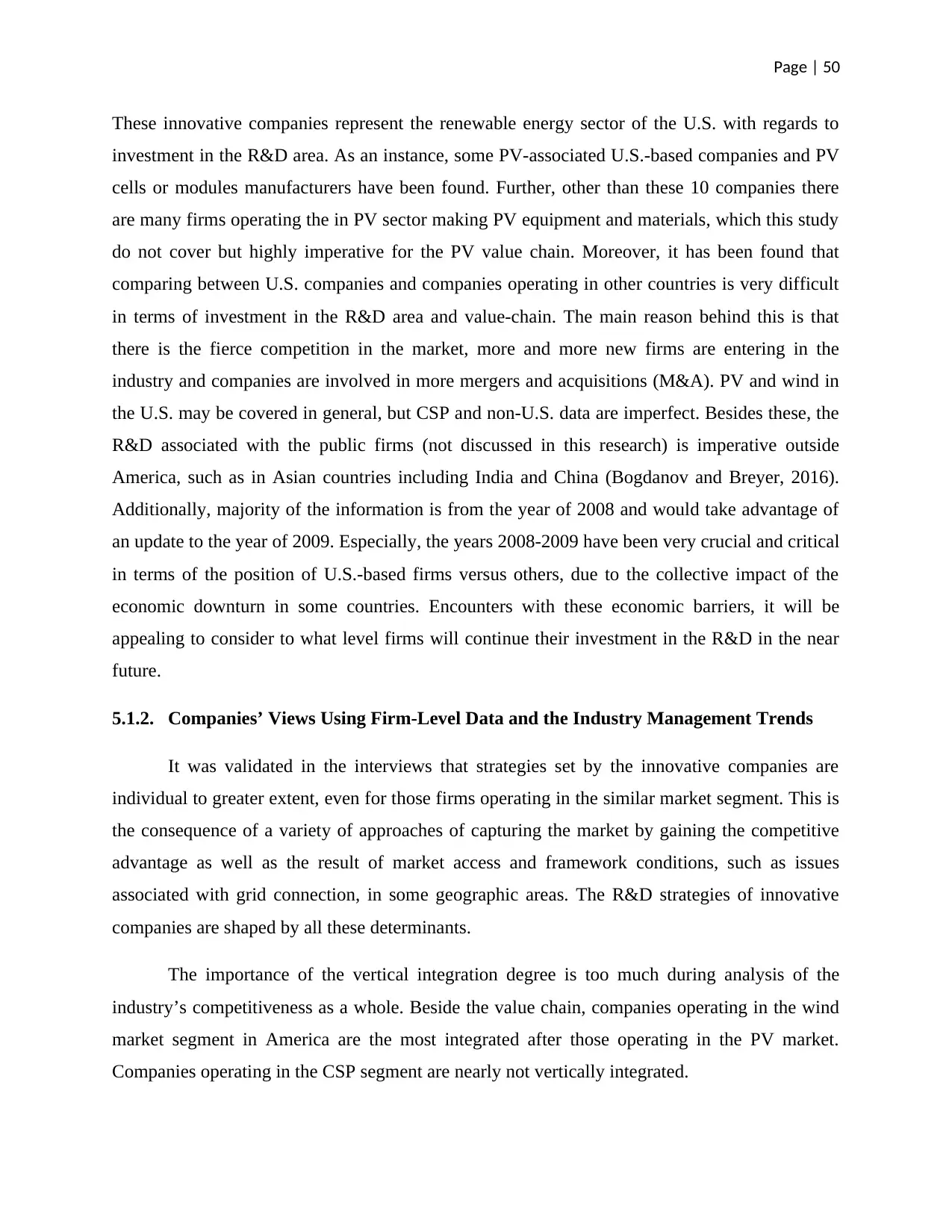
Page | 50
These innovative companies represent the renewable energy sector of the U.S. with regards to
investment in the R&D area. As an instance, some PV-associated U.S.-based companies and PV
cells or modules manufacturers have been found. Further, other than these 10 companies there
are many firms operating the in PV sector making PV equipment and materials, which this study
do not cover but highly imperative for the PV value chain. Moreover, it has been found that
comparing between U.S. companies and companies operating in other countries is very difficult
in terms of investment in the R&D area and value-chain. The main reason behind this is that
there is the fierce competition in the market, more and more new firms are entering in the
industry and companies are involved in more mergers and acquisitions (M&A). PV and wind in
the U.S. may be covered in general, but CSP and non-U.S. data are imperfect. Besides these, the
R&D associated with the public firms (not discussed in this research) is imperative outside
America, such as in Asian countries including India and China (Bogdanov and Breyer, 2016).
Additionally, majority of the information is from the year of 2008 and would take advantage of
an update to the year of 2009. Especially, the years 2008-2009 have been very crucial and critical
in terms of the position of U.S.-based firms versus others, due to the collective impact of the
economic downturn in some countries. Encounters with these economic barriers, it will be
appealing to consider to what level firms will continue their investment in the R&D in the near
future.
5.1.2. Companies’ Views Using Firm-Level Data and the Industry Management Trends
It was validated in the interviews that strategies set by the innovative companies are
individual to greater extent, even for those firms operating in the similar market segment. This is
the consequence of a variety of approaches of capturing the market by gaining the competitive
advantage as well as the result of market access and framework conditions, such as issues
associated with grid connection, in some geographic areas. The R&D strategies of innovative
companies are shaped by all these determinants.
The importance of the vertical integration degree is too much during analysis of the
industry’s competitiveness as a whole. Beside the value chain, companies operating in the wind
market segment in America are the most integrated after those operating in the PV market.
Companies operating in the CSP segment are nearly not vertically integrated.
These innovative companies represent the renewable energy sector of the U.S. with regards to
investment in the R&D area. As an instance, some PV-associated U.S.-based companies and PV
cells or modules manufacturers have been found. Further, other than these 10 companies there
are many firms operating the in PV sector making PV equipment and materials, which this study
do not cover but highly imperative for the PV value chain. Moreover, it has been found that
comparing between U.S. companies and companies operating in other countries is very difficult
in terms of investment in the R&D area and value-chain. The main reason behind this is that
there is the fierce competition in the market, more and more new firms are entering in the
industry and companies are involved in more mergers and acquisitions (M&A). PV and wind in
the U.S. may be covered in general, but CSP and non-U.S. data are imperfect. Besides these, the
R&D associated with the public firms (not discussed in this research) is imperative outside
America, such as in Asian countries including India and China (Bogdanov and Breyer, 2016).
Additionally, majority of the information is from the year of 2008 and would take advantage of
an update to the year of 2009. Especially, the years 2008-2009 have been very crucial and critical
in terms of the position of U.S.-based firms versus others, due to the collective impact of the
economic downturn in some countries. Encounters with these economic barriers, it will be
appealing to consider to what level firms will continue their investment in the R&D in the near
future.
5.1.2. Companies’ Views Using Firm-Level Data and the Industry Management Trends
It was validated in the interviews that strategies set by the innovative companies are
individual to greater extent, even for those firms operating in the similar market segment. This is
the consequence of a variety of approaches of capturing the market by gaining the competitive
advantage as well as the result of market access and framework conditions, such as issues
associated with grid connection, in some geographic areas. The R&D strategies of innovative
companies are shaped by all these determinants.
The importance of the vertical integration degree is too much during analysis of the
industry’s competitiveness as a whole. Beside the value chain, companies operating in the wind
market segment in America are the most integrated after those operating in the PV market.
Companies operating in the CSP segment are nearly not vertically integrated.
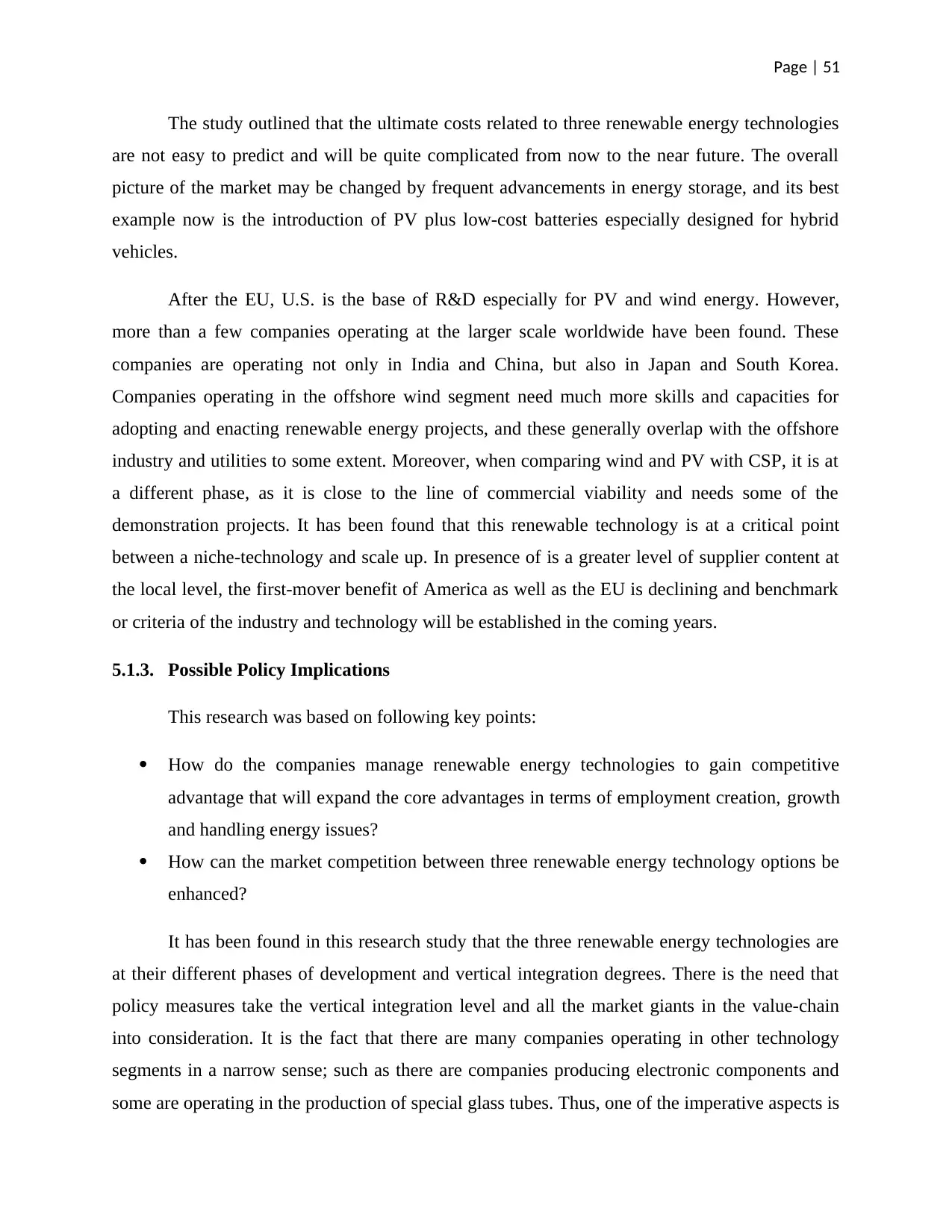
Page | 51
The study outlined that the ultimate costs related to three renewable energy technologies
are not easy to predict and will be quite complicated from now to the near future. The overall
picture of the market may be changed by frequent advancements in energy storage, and its best
example now is the introduction of PV plus low-cost batteries especially designed for hybrid
vehicles.
After the EU, U.S. is the base of R&D especially for PV and wind energy. However,
more than a few companies operating at the larger scale worldwide have been found. These
companies are operating not only in India and China, but also in Japan and South Korea.
Companies operating in the offshore wind segment need much more skills and capacities for
adopting and enacting renewable energy projects, and these generally overlap with the offshore
industry and utilities to some extent. Moreover, when comparing wind and PV with CSP, it is at
a different phase, as it is close to the line of commercial viability and needs some of the
demonstration projects. It has been found that this renewable technology is at a critical point
between a niche-technology and scale up. In presence of is a greater level of supplier content at
the local level, the first-mover benefit of America as well as the EU is declining and benchmark
or criteria of the industry and technology will be established in the coming years.
5.1.3. Possible Policy Implications
This research was based on following key points:
How do the companies manage renewable energy technologies to gain competitive
advantage that will expand the core advantages in terms of employment creation, growth
and handling energy issues?
How can the market competition between three renewable energy technology options be
enhanced?
It has been found in this research study that the three renewable energy technologies are
at their different phases of development and vertical integration degrees. There is the need that
policy measures take the vertical integration level and all the market giants in the value-chain
into consideration. It is the fact that there are many companies operating in other technology
segments in a narrow sense; such as there are companies producing electronic components and
some are operating in the production of special glass tubes. Thus, one of the imperative aspects is
The study outlined that the ultimate costs related to three renewable energy technologies
are not easy to predict and will be quite complicated from now to the near future. The overall
picture of the market may be changed by frequent advancements in energy storage, and its best
example now is the introduction of PV plus low-cost batteries especially designed for hybrid
vehicles.
After the EU, U.S. is the base of R&D especially for PV and wind energy. However,
more than a few companies operating at the larger scale worldwide have been found. These
companies are operating not only in India and China, but also in Japan and South Korea.
Companies operating in the offshore wind segment need much more skills and capacities for
adopting and enacting renewable energy projects, and these generally overlap with the offshore
industry and utilities to some extent. Moreover, when comparing wind and PV with CSP, it is at
a different phase, as it is close to the line of commercial viability and needs some of the
demonstration projects. It has been found that this renewable technology is at a critical point
between a niche-technology and scale up. In presence of is a greater level of supplier content at
the local level, the first-mover benefit of America as well as the EU is declining and benchmark
or criteria of the industry and technology will be established in the coming years.
5.1.3. Possible Policy Implications
This research was based on following key points:
How do the companies manage renewable energy technologies to gain competitive
advantage that will expand the core advantages in terms of employment creation, growth
and handling energy issues?
How can the market competition between three renewable energy technology options be
enhanced?
It has been found in this research study that the three renewable energy technologies are
at their different phases of development and vertical integration degrees. There is the need that
policy measures take the vertical integration level and all the market giants in the value-chain
into consideration. It is the fact that there are many companies operating in other technology
segments in a narrow sense; such as there are companies producing electronic components and
some are operating in the production of special glass tubes. Thus, one of the imperative aspects is
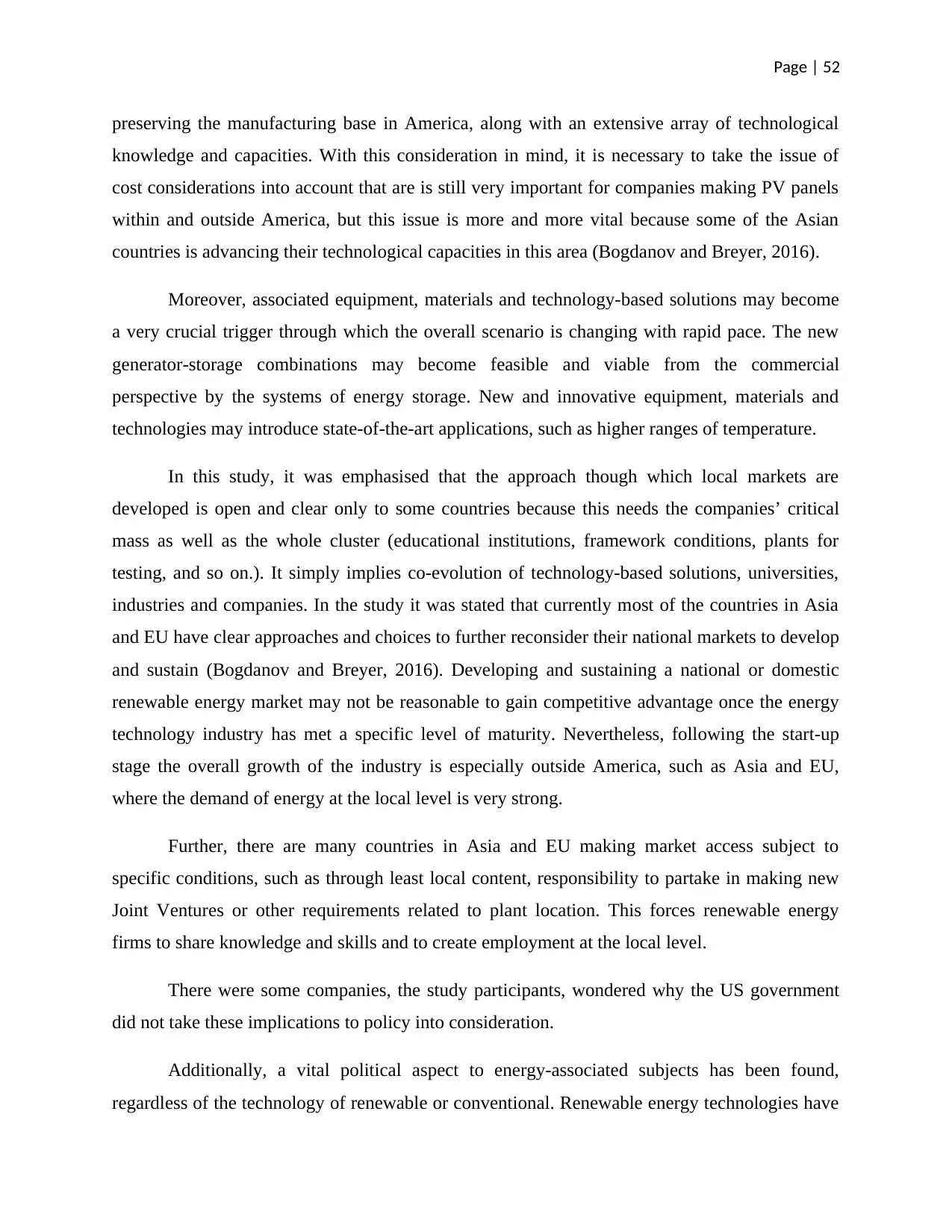
Page | 52
preserving the manufacturing base in America, along with an extensive array of technological
knowledge and capacities. With this consideration in mind, it is necessary to take the issue of
cost considerations into account that are is still very important for companies making PV panels
within and outside America, but this issue is more and more vital because some of the Asian
countries is advancing their technological capacities in this area (Bogdanov and Breyer, 2016).
Moreover, associated equipment, materials and technology-based solutions may become
a very crucial trigger through which the overall scenario is changing with rapid pace. The new
generator-storage combinations may become feasible and viable from the commercial
perspective by the systems of energy storage. New and innovative equipment, materials and
technologies may introduce state-of-the-art applications, such as higher ranges of temperature.
In this study, it was emphasised that the approach though which local markets are
developed is open and clear only to some countries because this needs the companies’ critical
mass as well as the whole cluster (educational institutions, framework conditions, plants for
testing, and so on.). It simply implies co-evolution of technology-based solutions, universities,
industries and companies. In the study it was stated that currently most of the countries in Asia
and EU have clear approaches and choices to further reconsider their national markets to develop
and sustain (Bogdanov and Breyer, 2016). Developing and sustaining a national or domestic
renewable energy market may not be reasonable to gain competitive advantage once the energy
technology industry has met a specific level of maturity. Nevertheless, following the start-up
stage the overall growth of the industry is especially outside America, such as Asia and EU,
where the demand of energy at the local level is very strong.
Further, there are many countries in Asia and EU making market access subject to
specific conditions, such as through least local content, responsibility to partake in making new
Joint Ventures or other requirements related to plant location. This forces renewable energy
firms to share knowledge and skills and to create employment at the local level.
There were some companies, the study participants, wondered why the US government
did not take these implications to policy into consideration.
Additionally, a vital political aspect to energy-associated subjects has been found,
regardless of the technology of renewable or conventional. Renewable energy technologies have
preserving the manufacturing base in America, along with an extensive array of technological
knowledge and capacities. With this consideration in mind, it is necessary to take the issue of
cost considerations into account that are is still very important for companies making PV panels
within and outside America, but this issue is more and more vital because some of the Asian
countries is advancing their technological capacities in this area (Bogdanov and Breyer, 2016).
Moreover, associated equipment, materials and technology-based solutions may become
a very crucial trigger through which the overall scenario is changing with rapid pace. The new
generator-storage combinations may become feasible and viable from the commercial
perspective by the systems of energy storage. New and innovative equipment, materials and
technologies may introduce state-of-the-art applications, such as higher ranges of temperature.
In this study, it was emphasised that the approach though which local markets are
developed is open and clear only to some countries because this needs the companies’ critical
mass as well as the whole cluster (educational institutions, framework conditions, plants for
testing, and so on.). It simply implies co-evolution of technology-based solutions, universities,
industries and companies. In the study it was stated that currently most of the countries in Asia
and EU have clear approaches and choices to further reconsider their national markets to develop
and sustain (Bogdanov and Breyer, 2016). Developing and sustaining a national or domestic
renewable energy market may not be reasonable to gain competitive advantage once the energy
technology industry has met a specific level of maturity. Nevertheless, following the start-up
stage the overall growth of the industry is especially outside America, such as Asia and EU,
where the demand of energy at the local level is very strong.
Further, there are many countries in Asia and EU making market access subject to
specific conditions, such as through least local content, responsibility to partake in making new
Joint Ventures or other requirements related to plant location. This forces renewable energy
firms to share knowledge and skills and to create employment at the local level.
There were some companies, the study participants, wondered why the US government
did not take these implications to policy into consideration.
Additionally, a vital political aspect to energy-associated subjects has been found,
regardless of the technology of renewable or conventional. Renewable energy technologies have
Secure Best Marks with AI Grader
Need help grading? Try our AI Grader for instant feedback on your assignments.
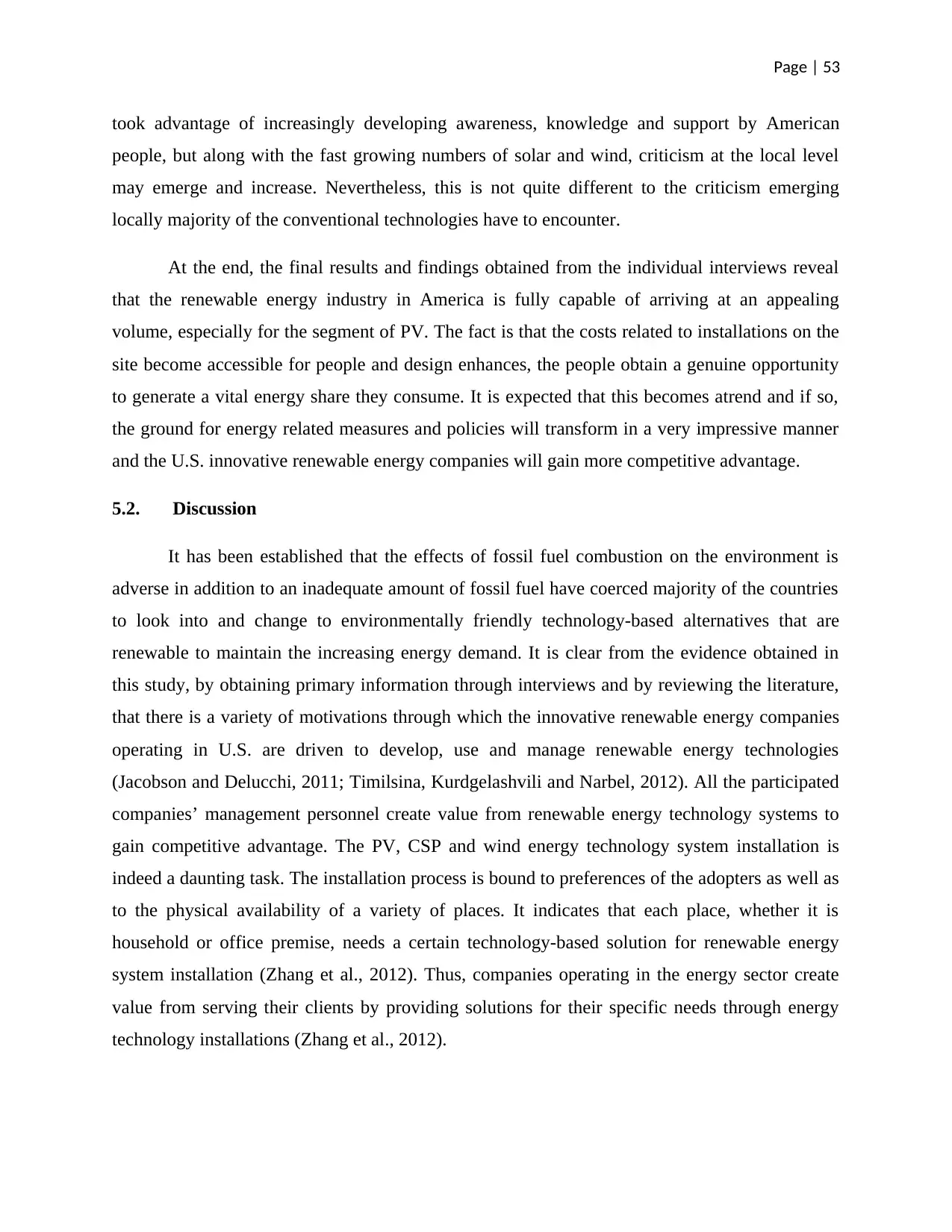
Page | 53
took advantage of increasingly developing awareness, knowledge and support by American
people, but along with the fast growing numbers of solar and wind, criticism at the local level
may emerge and increase. Nevertheless, this is not quite different to the criticism emerging
locally majority of the conventional technologies have to encounter.
At the end, the final results and findings obtained from the individual interviews reveal
that the renewable energy industry in America is fully capable of arriving at an appealing
volume, especially for the segment of PV. The fact is that the costs related to installations on the
site become accessible for people and design enhances, the people obtain a genuine opportunity
to generate a vital energy share they consume. It is expected that this becomes atrend and if so,
the ground for energy related measures and policies will transform in a very impressive manner
and the U.S. innovative renewable energy companies will gain more competitive advantage.
5.2. Discussion
It has been established that the effects of fossil fuel combustion on the environment is
adverse in addition to an inadequate amount of fossil fuel have coerced majority of the countries
to look into and change to environmentally friendly technology-based alternatives that are
renewable to maintain the increasing energy demand. It is clear from the evidence obtained in
this study, by obtaining primary information through interviews and by reviewing the literature,
that there is a variety of motivations through which the innovative renewable energy companies
operating in U.S. are driven to develop, use and manage renewable energy technologies
(Jacobson and Delucchi, 2011; Timilsina, Kurdgelashvili and Narbel, 2012). All the participated
companies’ management personnel create value from renewable energy technology systems to
gain competitive advantage. The PV, CSP and wind energy technology system installation is
indeed a daunting task. The installation process is bound to preferences of the adopters as well as
to the physical availability of a variety of places. It indicates that each place, whether it is
household or office premise, needs a certain technology-based solution for renewable energy
system installation (Zhang et al., 2012). Thus, companies operating in the energy sector create
value from serving their clients by providing solutions for their specific needs through energy
technology installations (Zhang et al., 2012).
took advantage of increasingly developing awareness, knowledge and support by American
people, but along with the fast growing numbers of solar and wind, criticism at the local level
may emerge and increase. Nevertheless, this is not quite different to the criticism emerging
locally majority of the conventional technologies have to encounter.
At the end, the final results and findings obtained from the individual interviews reveal
that the renewable energy industry in America is fully capable of arriving at an appealing
volume, especially for the segment of PV. The fact is that the costs related to installations on the
site become accessible for people and design enhances, the people obtain a genuine opportunity
to generate a vital energy share they consume. It is expected that this becomes atrend and if so,
the ground for energy related measures and policies will transform in a very impressive manner
and the U.S. innovative renewable energy companies will gain more competitive advantage.
5.2. Discussion
It has been established that the effects of fossil fuel combustion on the environment is
adverse in addition to an inadequate amount of fossil fuel have coerced majority of the countries
to look into and change to environmentally friendly technology-based alternatives that are
renewable to maintain the increasing energy demand. It is clear from the evidence obtained in
this study, by obtaining primary information through interviews and by reviewing the literature,
that there is a variety of motivations through which the innovative renewable energy companies
operating in U.S. are driven to develop, use and manage renewable energy technologies
(Jacobson and Delucchi, 2011; Timilsina, Kurdgelashvili and Narbel, 2012). All the participated
companies’ management personnel create value from renewable energy technology systems to
gain competitive advantage. The PV, CSP and wind energy technology system installation is
indeed a daunting task. The installation process is bound to preferences of the adopters as well as
to the physical availability of a variety of places. It indicates that each place, whether it is
household or office premise, needs a certain technology-based solution for renewable energy
system installation (Zhang et al., 2012). Thus, companies operating in the energy sector create
value from serving their clients by providing solutions for their specific needs through energy
technology installations (Zhang et al., 2012).

Page | 54
The energy firms are contained in the supply side of wind technology, and all these
companies entered this market segment by producing wind products or acquisitions (Lemus and
Duart, 2010). They also have the competitive advantage because they have the full potential
supply step-by-step installations in the market, which are typically utilities corporation operating
at the larger scale. In the wind technology industry, these installations appear to be a modern
approach. This great evolution is also reinforced by fast-pace development of offshore energy
projects. For making sure competitive advantage, companies properly integrated technology,
optimised wind and standard constituents, enhanced the level of reliability at all and reduction of
cost.
The contribution of the American strategic policies for both offshore and onshore windis
clear. The government provide support to develop and sustain offshore wind technologies by
financing their R&D. Therefore, the offshore wind business in America is on the rise and for this
very reason this area of business in highly complex with regards to technology and more high-
priced with regards to equipment, installation and overall maintenance. However, it has also been
found that onshore wind needs much attention because it would support the offshore wind, in
order to expand the overall knowledge and skills of onshore wind energy and grid access. There
is a variety of facets about corporate strategy of each innovative renewable energy company, in
terms of the use of land and sea, costs of with integration of grid and reduction possibility of
generation costs. Therefore, the cost of R&D is too high for offshore wind energy as compared to
onshore due to the components involved outside the turbine (monitoring, security and
maintenance of foundations, wave and wind) is highly complicated. There is the need that the
suppliers of offshore wind expand their knowledge and skills to conduct R&D and to install and
service for offshore farm. It has been found that they frequently expand their knowledge base
from the offshore business of oil and gas as well.
There is the need to emphasise that the R&D strategies of the firms are extremely
individual, but they are similar in the area of size and market segments. They pay attention to
certain technology-based solutions, vertical integration, onshore and offshore applications, to
step-by-step installations and incorporation with the traditional energy grid. For this very reason,
their various needs and objectives vary because their anticipation from decision/policy-makers is
different. This also applies to the pace where R&D is conducted and activities related to
The energy firms are contained in the supply side of wind technology, and all these
companies entered this market segment by producing wind products or acquisitions (Lemus and
Duart, 2010). They also have the competitive advantage because they have the full potential
supply step-by-step installations in the market, which are typically utilities corporation operating
at the larger scale. In the wind technology industry, these installations appear to be a modern
approach. This great evolution is also reinforced by fast-pace development of offshore energy
projects. For making sure competitive advantage, companies properly integrated technology,
optimised wind and standard constituents, enhanced the level of reliability at all and reduction of
cost.
The contribution of the American strategic policies for both offshore and onshore windis
clear. The government provide support to develop and sustain offshore wind technologies by
financing their R&D. Therefore, the offshore wind business in America is on the rise and for this
very reason this area of business in highly complex with regards to technology and more high-
priced with regards to equipment, installation and overall maintenance. However, it has also been
found that onshore wind needs much attention because it would support the offshore wind, in
order to expand the overall knowledge and skills of onshore wind energy and grid access. There
is a variety of facets about corporate strategy of each innovative renewable energy company, in
terms of the use of land and sea, costs of with integration of grid and reduction possibility of
generation costs. Therefore, the cost of R&D is too high for offshore wind energy as compared to
onshore due to the components involved outside the turbine (monitoring, security and
maintenance of foundations, wave and wind) is highly complicated. There is the need that the
suppliers of offshore wind expand their knowledge and skills to conduct R&D and to install and
service for offshore farm. It has been found that they frequently expand their knowledge base
from the offshore business of oil and gas as well.
There is the need to emphasise that the R&D strategies of the firms are extremely
individual, but they are similar in the area of size and market segments. They pay attention to
certain technology-based solutions, vertical integration, onshore and offshore applications, to
step-by-step installations and incorporation with the traditional energy grid. For this very reason,
their various needs and objectives vary because their anticipation from decision/policy-makers is
different. This also applies to the pace where R&D is conducted and activities related to

Page | 55
manufacturing, where some companies are especially present in the U.S. and others are globally-
locally. Despite anything to the contrary, the more strategic activities of R&D are located locally
or near to companies because they feel easiness when testing. Relocating R&D gives many
benefits, mainly to their strategic areas, remote from America because of the region’s IP
protection and the technological leadership.
As far as the PV renewable companies are concerned, dramatic development of the
industrial application of solar PV technology has been seen by the last few years (possibly thirty
years) (Sahu, 2015). Majority of the energy companies have contributed totechnological
development to gain competitive advantage. Therefore, the overall efficiency of solar PV
technology is enhancing and this process will continue. The solar PV value chain has two parts
that constitute about 50 per cent of the global market chain, which comprises production of
silicon, manufacturing of cell and production of module; and the regional market chain, which
comprises sales and marketing, industrial engineering, procurement and construction, technology
installation, operational activities, service and maintenance, and energy management (Branker,
Pathak and Pearce, 2011).In any given firm, a variety of skills and capabilities are needed by the
whole value chain. In the PY market, the market rivalry of Asian companies, such as Chinese, is
a real threat for American innovative renewable energy companies as Chinese companies
produce low-cost panels. However, focus of US companies is on lifecycle costs and overall
reliability of the technologies, while encountering the fierce competition over price and to make
sure their competitive advantage. Nevertheless, the companies operating in emerging economies
are expanding their knowledge and capacities with fast-pace. The aspect of competitiveness of
companies is a vital concern related to volume in silicon, cell and module production, where
highly sophisticated manufacturing technologies are adopted by the firms to properly address and
focus on labour cost competition. As far as the R&D strategy of PV companies is concerned,
U.S. is the R&D base where they conduct R&D. Both European and Asian countries are still
contributing a trivial part in the PV as renewable energy markets and are engaging in the
development or adaptations at the local level. There is a relationship between R&D and a critical
mass of manufacturing base. America has still a manufacturing base for solar PV, but high level
of competition coming from emerging economies is a real threat for companies. The companies
in emerging countries is gradually expanding their knowledge base in the energy technologies,
manufacturing, where some companies are especially present in the U.S. and others are globally-
locally. Despite anything to the contrary, the more strategic activities of R&D are located locally
or near to companies because they feel easiness when testing. Relocating R&D gives many
benefits, mainly to their strategic areas, remote from America because of the region’s IP
protection and the technological leadership.
As far as the PV renewable companies are concerned, dramatic development of the
industrial application of solar PV technology has been seen by the last few years (possibly thirty
years) (Sahu, 2015). Majority of the energy companies have contributed totechnological
development to gain competitive advantage. Therefore, the overall efficiency of solar PV
technology is enhancing and this process will continue. The solar PV value chain has two parts
that constitute about 50 per cent of the global market chain, which comprises production of
silicon, manufacturing of cell and production of module; and the regional market chain, which
comprises sales and marketing, industrial engineering, procurement and construction, technology
installation, operational activities, service and maintenance, and energy management (Branker,
Pathak and Pearce, 2011).In any given firm, a variety of skills and capabilities are needed by the
whole value chain. In the PY market, the market rivalry of Asian companies, such as Chinese, is
a real threat for American innovative renewable energy companies as Chinese companies
produce low-cost panels. However, focus of US companies is on lifecycle costs and overall
reliability of the technologies, while encountering the fierce competition over price and to make
sure their competitive advantage. Nevertheless, the companies operating in emerging economies
are expanding their knowledge and capacities with fast-pace. The aspect of competitiveness of
companies is a vital concern related to volume in silicon, cell and module production, where
highly sophisticated manufacturing technologies are adopted by the firms to properly address and
focus on labour cost competition. As far as the R&D strategy of PV companies is concerned,
U.S. is the R&D base where they conduct R&D. Both European and Asian countries are still
contributing a trivial part in the PV as renewable energy markets and are engaging in the
development or adaptations at the local level. There is a relationship between R&D and a critical
mass of manufacturing base. America has still a manufacturing base for solar PV, but high level
of competition coming from emerging economies is a real threat for companies. The companies
in emerging countries is gradually expanding their knowledge base in the energy technologies,
Paraphrase This Document
Need a fresh take? Get an instant paraphrase of this document with our AI Paraphraser
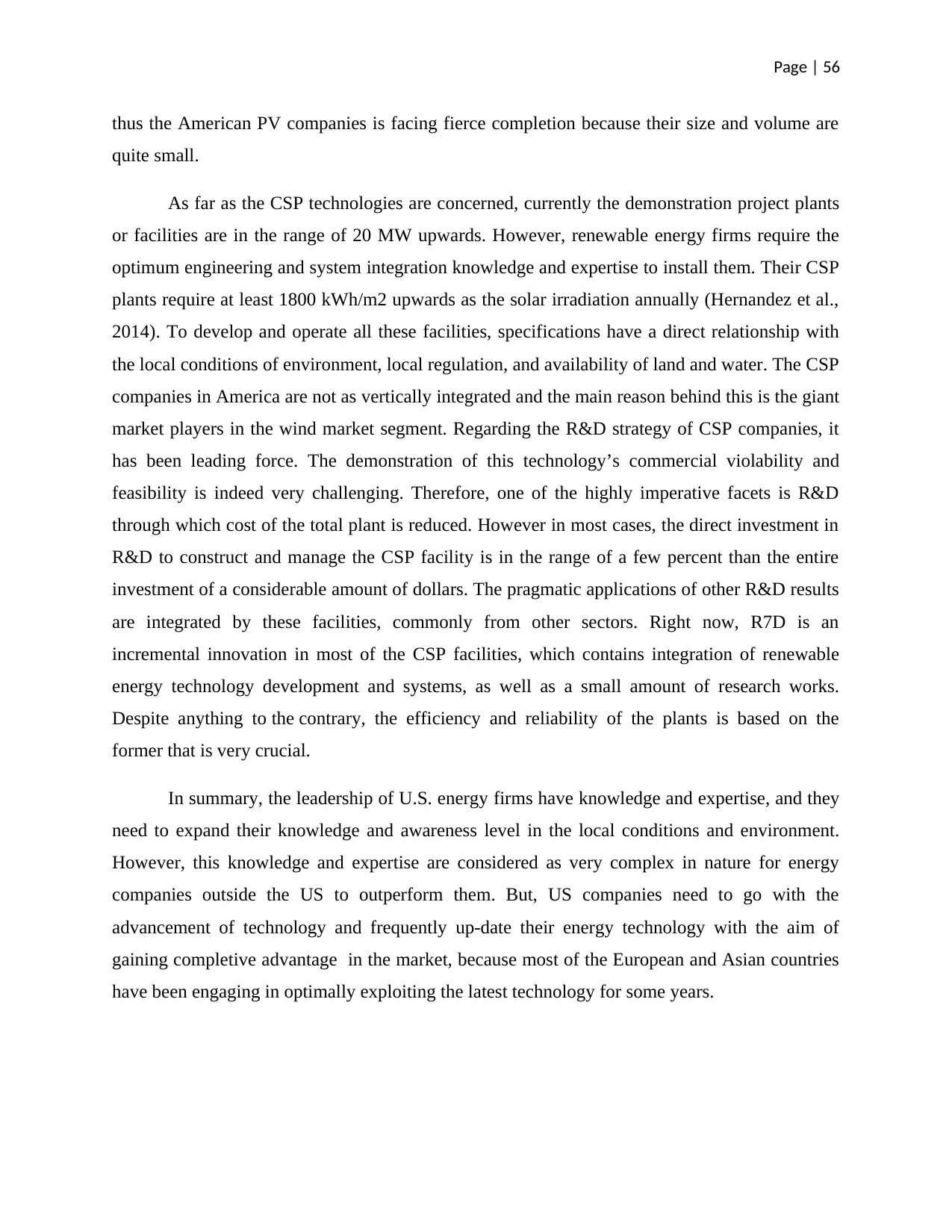
Page | 56
thus the American PV companies is facing fierce completion because their size and volume are
quite small.
As far as the CSP technologies are concerned, currently the demonstration project plants
or facilities are in the range of 20 MW upwards. However, renewable energy firms require the
optimum engineering and system integration knowledge and expertise to install them. Their CSP
plants require at least 1800 kWh/m2 upwards as the solar irradiation annually (Hernandez et al.,
2014). To develop and operate all these facilities, specifications have a direct relationship with
the local conditions of environment, local regulation, and availability of land and water. The CSP
companies in America are not as vertically integrated and the main reason behind this is the giant
market players in the wind market segment. Regarding the R&D strategy of CSP companies, it
has been leading force. The demonstration of this technology’s commercial violability and
feasibility is indeed very challenging. Therefore, one of the highly imperative facets is R&D
through which cost of the total plant is reduced. However in most cases, the direct investment in
R&D to construct and manage the CSP facility is in the range of a few percent than the entire
investment of a considerable amount of dollars. The pragmatic applications of other R&D results
are integrated by these facilities, commonly from other sectors. Right now, R7D is an
incremental innovation in most of the CSP facilities, which contains integration of renewable
energy technology development and systems, as well as a small amount of research works.
Despite anything to the contrary, the efficiency and reliability of the plants is based on the
former that is very crucial.
In summary, the leadership of U.S. energy firms have knowledge and expertise, and they
need to expand their knowledge and awareness level in the local conditions and environment.
However, this knowledge and expertise are considered as very complex in nature for energy
companies outside the US to outperform them. But, US companies need to go with the
advancement of technology and frequently up-date their energy technology with the aim of
gaining completive advantage in the market, because most of the European and Asian countries
have been engaging in optimally exploiting the latest technology for some years.
thus the American PV companies is facing fierce completion because their size and volume are
quite small.
As far as the CSP technologies are concerned, currently the demonstration project plants
or facilities are in the range of 20 MW upwards. However, renewable energy firms require the
optimum engineering and system integration knowledge and expertise to install them. Their CSP
plants require at least 1800 kWh/m2 upwards as the solar irradiation annually (Hernandez et al.,
2014). To develop and operate all these facilities, specifications have a direct relationship with
the local conditions of environment, local regulation, and availability of land and water. The CSP
companies in America are not as vertically integrated and the main reason behind this is the giant
market players in the wind market segment. Regarding the R&D strategy of CSP companies, it
has been leading force. The demonstration of this technology’s commercial violability and
feasibility is indeed very challenging. Therefore, one of the highly imperative facets is R&D
through which cost of the total plant is reduced. However in most cases, the direct investment in
R&D to construct and manage the CSP facility is in the range of a few percent than the entire
investment of a considerable amount of dollars. The pragmatic applications of other R&D results
are integrated by these facilities, commonly from other sectors. Right now, R7D is an
incremental innovation in most of the CSP facilities, which contains integration of renewable
energy technology development and systems, as well as a small amount of research works.
Despite anything to the contrary, the efficiency and reliability of the plants is based on the
former that is very crucial.
In summary, the leadership of U.S. energy firms have knowledge and expertise, and they
need to expand their knowledge and awareness level in the local conditions and environment.
However, this knowledge and expertise are considered as very complex in nature for energy
companies outside the US to outperform them. But, US companies need to go with the
advancement of technology and frequently up-date their energy technology with the aim of
gaining completive advantage in the market, because most of the European and Asian countries
have been engaging in optimally exploiting the latest technology for some years.
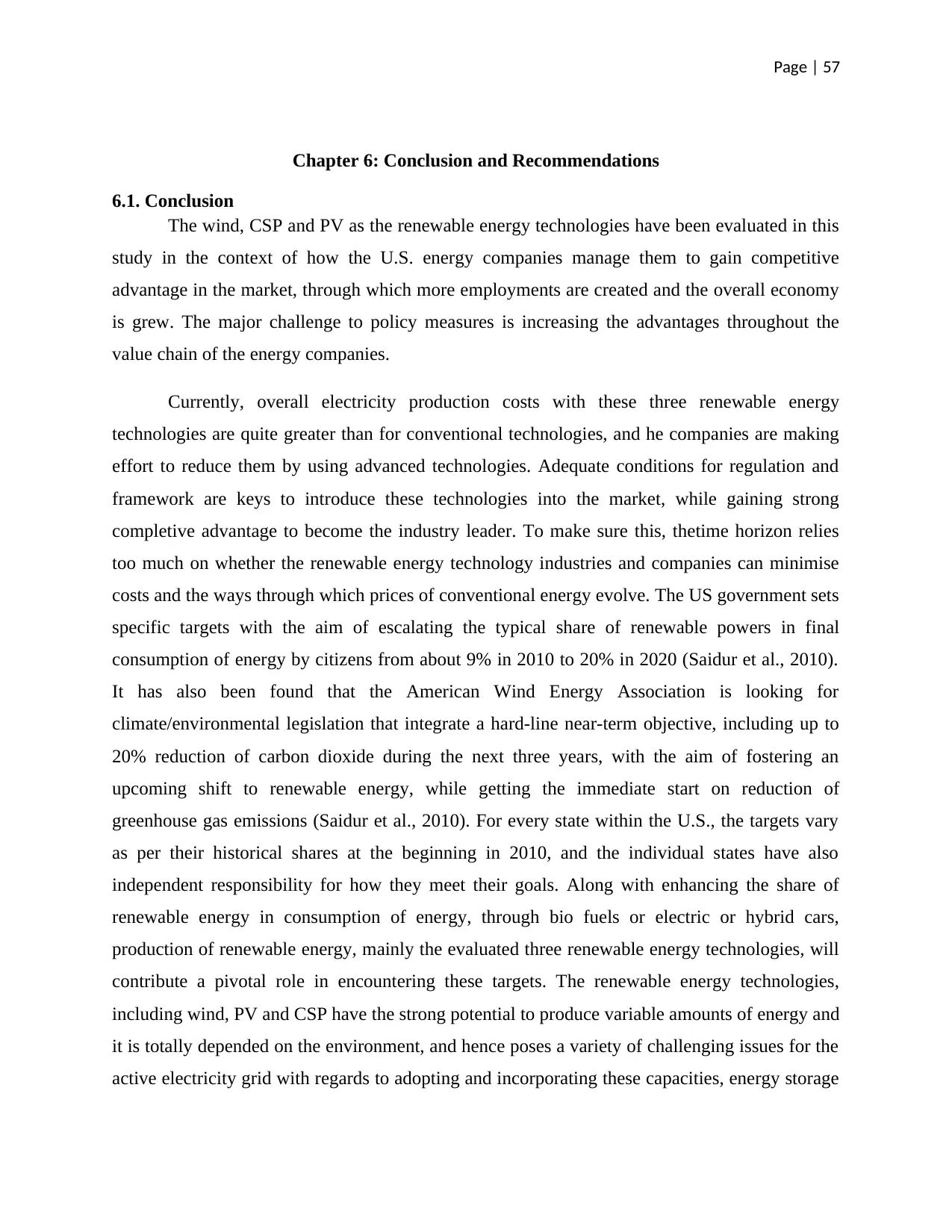
Page | 57
Chapter 6: Conclusion and Recommendations
6.1. Conclusion
The wind, CSP and PV as the renewable energy technologies have been evaluated in this
study in the context of how the U.S. energy companies manage them to gain competitive
advantage in the market, through which more employments are created and the overall economy
is grew. The major challenge to policy measures is increasing the advantages throughout the
value chain of the energy companies.
Currently, overall electricity production costs with these three renewable energy
technologies are quite greater than for conventional technologies, and he companies are making
effort to reduce them by using advanced technologies. Adequate conditions for regulation and
framework are keys to introduce these technologies into the market, while gaining strong
completive advantage to become the industry leader. To make sure this, thetime horizon relies
too much on whether the renewable energy technology industries and companies can minimise
costs and the ways through which prices of conventional energy evolve. The US government sets
specific targets with the aim of escalating the typical share of renewable powers in final
consumption of energy by citizens from about 9% in 2010 to 20% in 2020 (Saidur et al., 2010).
It has also been found that the American Wind Energy Association is looking for
climate/environmental legislation that integrate a hard-line near-term objective, including up to
20% reduction of carbon dioxide during the next three years, with the aim of fostering an
upcoming shift to renewable energy, while getting the immediate start on reduction of
greenhouse gas emissions (Saidur et al., 2010). For every state within the U.S., the targets vary
as per their historical shares at the beginning in 2010, and the individual states have also
independent responsibility for how they meet their goals. Along with enhancing the share of
renewable energy in consumption of energy, through bio fuels or electric or hybrid cars,
production of renewable energy, mainly the evaluated three renewable energy technologies, will
contribute a pivotal role in encountering these targets. The renewable energy technologies,
including wind, PV and CSP have the strong potential to produce variable amounts of energy and
it is totally depended on the environment, and hence poses a variety of challenging issues for the
active electricity grid with regards to adopting and incorporating these capacities, energy storage
Chapter 6: Conclusion and Recommendations
6.1. Conclusion
The wind, CSP and PV as the renewable energy technologies have been evaluated in this
study in the context of how the U.S. energy companies manage them to gain competitive
advantage in the market, through which more employments are created and the overall economy
is grew. The major challenge to policy measures is increasing the advantages throughout the
value chain of the energy companies.
Currently, overall electricity production costs with these three renewable energy
technologies are quite greater than for conventional technologies, and he companies are making
effort to reduce them by using advanced technologies. Adequate conditions for regulation and
framework are keys to introduce these technologies into the market, while gaining strong
completive advantage to become the industry leader. To make sure this, thetime horizon relies
too much on whether the renewable energy technology industries and companies can minimise
costs and the ways through which prices of conventional energy evolve. The US government sets
specific targets with the aim of escalating the typical share of renewable powers in final
consumption of energy by citizens from about 9% in 2010 to 20% in 2020 (Saidur et al., 2010).
It has also been found that the American Wind Energy Association is looking for
climate/environmental legislation that integrate a hard-line near-term objective, including up to
20% reduction of carbon dioxide during the next three years, with the aim of fostering an
upcoming shift to renewable energy, while getting the immediate start on reduction of
greenhouse gas emissions (Saidur et al., 2010). For every state within the U.S., the targets vary
as per their historical shares at the beginning in 2010, and the individual states have also
independent responsibility for how they meet their goals. Along with enhancing the share of
renewable energy in consumption of energy, through bio fuels or electric or hybrid cars,
production of renewable energy, mainly the evaluated three renewable energy technologies, will
contribute a pivotal role in encountering these targets. The renewable energy technologies,
including wind, PV and CSP have the strong potential to produce variable amounts of energy and
it is totally depended on the environment, and hence poses a variety of challenging issues for the
active electricity grid with regards to adopting and incorporating these capacities, energy storage

Page | 58
and supply (Jacobson and Delucchi, 2011). As an instance, the companies need seaside access
for creating offshore wind, along with strong capacity for transmitting power called the smart
grids, which are necessary for a resourceful incorporation of smaller scale renewable systems
(Jacobson and Delucchi, 2011). These smart grids are developed by companies through which
electricity generation at the large- and small-scale and their storage are combined by means of
reciprocal connection and improvement of the association between network and consumer
(Ipakch and Albuyeh, 2009). The context in the long-term is balancing the fast growing
discrepancies between generation surplus of renewable energy (solar grounds in southern
America and offshore wind in coastal regions of US). It is the fact that these are the challenging
issues that have been addressed and pointed out, while receiving momentum at the American
political level, the extent to which they need to be resolved in the near future relies heavily on
the ways they are enacted quickly in the US and the relationship of every single grid components
(Delucchi and Jacobson, 2011).
In fact, high competition level is a leading force through which cost-effectiveness of the
evaluated renewable energy technologies is improved. The reason behind this is that these energy
technologies need to make a strong completion with other various technology-based options
across the entire supply chain. At this stage, there is a vital question: which level exteriorities are
integrated while measuring the cost. In conventional energy production, if exteriorities are
considered, there are some renewable energy technology companies including wind that
previously have a strong competitive advantage. All the three evaluated renewable energy
technologies are at their different phase where they have been developed and they hold different
potential. In America, companies operating in the wind energy technology segment are highly
consolidated energy firms after PV. As far as the CSP sector concerned, the maturity level of
these companies is less, not yet at the phase of mass production. For designing the optimum level
of policy approach, recognising the pertinent components with regards not only to employment
but also to the overall economic impact within the value chain of all technologies is important.
6.2. Recommendations
Companies operating in the three renewable energy technologies need to fulfil a variety
of industry requirements and standards, which include concentrated versus deconcentrated
applications or worldwide versus national or domestic scope. As far as the policy perspective is
and supply (Jacobson and Delucchi, 2011). As an instance, the companies need seaside access
for creating offshore wind, along with strong capacity for transmitting power called the smart
grids, which are necessary for a resourceful incorporation of smaller scale renewable systems
(Jacobson and Delucchi, 2011). These smart grids are developed by companies through which
electricity generation at the large- and small-scale and their storage are combined by means of
reciprocal connection and improvement of the association between network and consumer
(Ipakch and Albuyeh, 2009). The context in the long-term is balancing the fast growing
discrepancies between generation surplus of renewable energy (solar grounds in southern
America and offshore wind in coastal regions of US). It is the fact that these are the challenging
issues that have been addressed and pointed out, while receiving momentum at the American
political level, the extent to which they need to be resolved in the near future relies heavily on
the ways they are enacted quickly in the US and the relationship of every single grid components
(Delucchi and Jacobson, 2011).
In fact, high competition level is a leading force through which cost-effectiveness of the
evaluated renewable energy technologies is improved. The reason behind this is that these energy
technologies need to make a strong completion with other various technology-based options
across the entire supply chain. At this stage, there is a vital question: which level exteriorities are
integrated while measuring the cost. In conventional energy production, if exteriorities are
considered, there are some renewable energy technology companies including wind that
previously have a strong competitive advantage. All the three evaluated renewable energy
technologies are at their different phase where they have been developed and they hold different
potential. In America, companies operating in the wind energy technology segment are highly
consolidated energy firms after PV. As far as the CSP sector concerned, the maturity level of
these companies is less, not yet at the phase of mass production. For designing the optimum level
of policy approach, recognising the pertinent components with regards not only to employment
but also to the overall economic impact within the value chain of all technologies is important.
6.2. Recommendations
Companies operating in the three renewable energy technologies need to fulfil a variety
of industry requirements and standards, which include concentrated versus deconcentrated
applications or worldwide versus national or domestic scope. As far as the policy perspective is
Secure Best Marks with AI Grader
Need help grading? Try our AI Grader for instant feedback on your assignments.
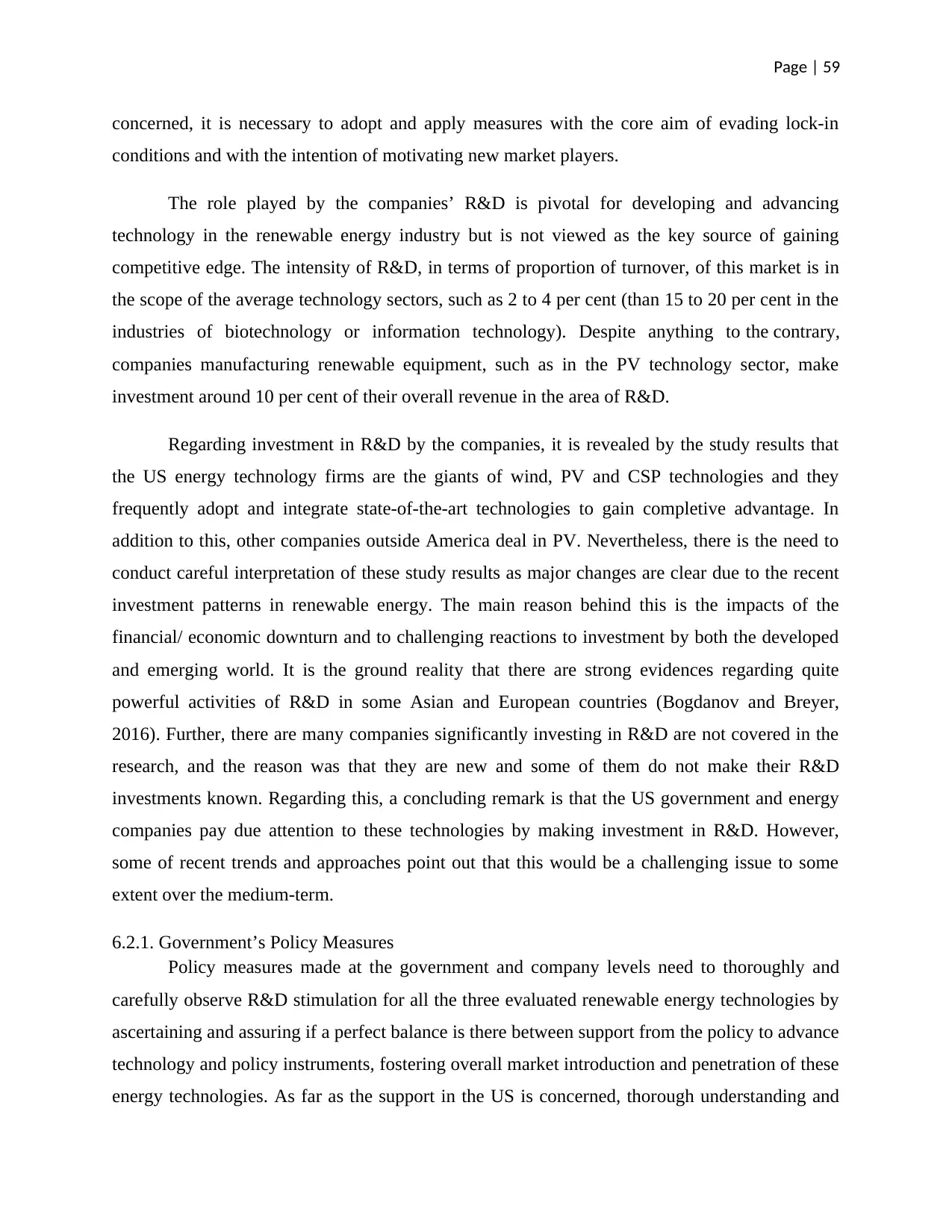
Page | 59
concerned, it is necessary to adopt and apply measures with the core aim of evading lock-in
conditions and with the intention of motivating new market players.
The role played by the companies’ R&D is pivotal for developing and advancing
technology in the renewable energy industry but is not viewed as the key source of gaining
competitive edge. The intensity of R&D, in terms of proportion of turnover, of this market is in
the scope of the average technology sectors, such as 2 to 4 per cent (than 15 to 20 per cent in the
industries of biotechnology or information technology). Despite anything to the contrary,
companies manufacturing renewable equipment, such as in the PV technology sector, make
investment around 10 per cent of their overall revenue in the area of R&D.
Regarding investment in R&D by the companies, it is revealed by the study results that
the US energy technology firms are the giants of wind, PV and CSP technologies and they
frequently adopt and integrate state-of-the-art technologies to gain completive advantage. In
addition to this, other companies outside America deal in PV. Nevertheless, there is the need to
conduct careful interpretation of these study results as major changes are clear due to the recent
investment patterns in renewable energy. The main reason behind this is the impacts of the
financial/ economic downturn and to challenging reactions to investment by both the developed
and emerging world. It is the ground reality that there are strong evidences regarding quite
powerful activities of R&D in some Asian and European countries (Bogdanov and Breyer,
2016). Further, there are many companies significantly investing in R&D are not covered in the
research, and the reason was that they are new and some of them do not make their R&D
investments known. Regarding this, a concluding remark is that the US government and energy
companies pay due attention to these technologies by making investment in R&D. However,
some of recent trends and approaches point out that this would be a challenging issue to some
extent over the medium-term.
6.2.1. Government’s Policy Measures
Policy measures made at the government and company levels need to thoroughly and
carefully observe R&D stimulation for all the three evaluated renewable energy technologies by
ascertaining and assuring if a perfect balance is there between support from the policy to advance
technology and policy instruments, fostering overall market introduction and penetration of these
energy technologies. As far as the support in the US is concerned, thorough understanding and
concerned, it is necessary to adopt and apply measures with the core aim of evading lock-in
conditions and with the intention of motivating new market players.
The role played by the companies’ R&D is pivotal for developing and advancing
technology in the renewable energy industry but is not viewed as the key source of gaining
competitive edge. The intensity of R&D, in terms of proportion of turnover, of this market is in
the scope of the average technology sectors, such as 2 to 4 per cent (than 15 to 20 per cent in the
industries of biotechnology or information technology). Despite anything to the contrary,
companies manufacturing renewable equipment, such as in the PV technology sector, make
investment around 10 per cent of their overall revenue in the area of R&D.
Regarding investment in R&D by the companies, it is revealed by the study results that
the US energy technology firms are the giants of wind, PV and CSP technologies and they
frequently adopt and integrate state-of-the-art technologies to gain completive advantage. In
addition to this, other companies outside America deal in PV. Nevertheless, there is the need to
conduct careful interpretation of these study results as major changes are clear due to the recent
investment patterns in renewable energy. The main reason behind this is the impacts of the
financial/ economic downturn and to challenging reactions to investment by both the developed
and emerging world. It is the ground reality that there are strong evidences regarding quite
powerful activities of R&D in some Asian and European countries (Bogdanov and Breyer,
2016). Further, there are many companies significantly investing in R&D are not covered in the
research, and the reason was that they are new and some of them do not make their R&D
investments known. Regarding this, a concluding remark is that the US government and energy
companies pay due attention to these technologies by making investment in R&D. However,
some of recent trends and approaches point out that this would be a challenging issue to some
extent over the medium-term.
6.2.1. Government’s Policy Measures
Policy measures made at the government and company levels need to thoroughly and
carefully observe R&D stimulation for all the three evaluated renewable energy technologies by
ascertaining and assuring if a perfect balance is there between support from the policy to advance
technology and policy instruments, fostering overall market introduction and penetration of these
energy technologies. As far as the support in the US is concerned, thorough understanding and
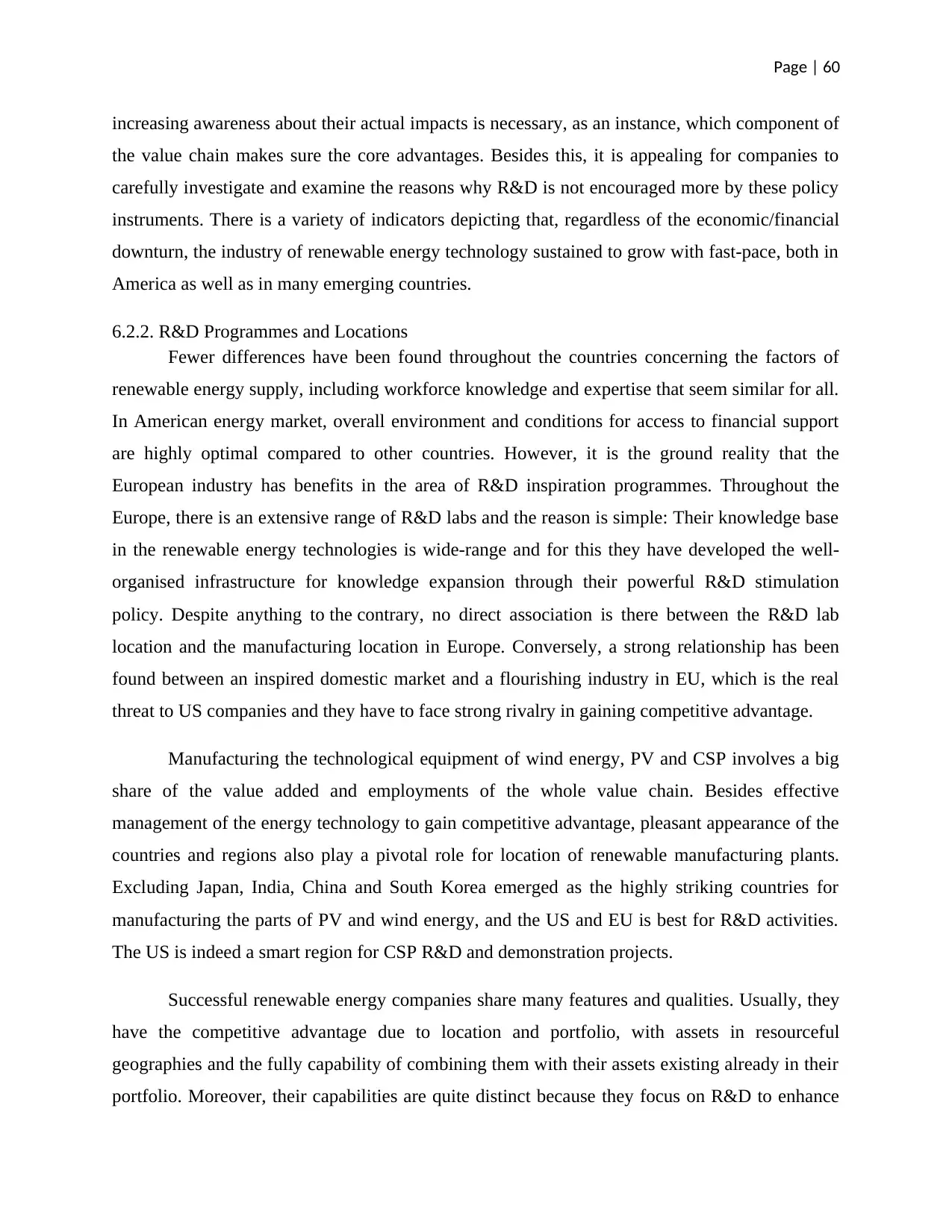
Page | 60
increasing awareness about their actual impacts is necessary, as an instance, which component of
the value chain makes sure the core advantages. Besides this, it is appealing for companies to
carefully investigate and examine the reasons why R&D is not encouraged more by these policy
instruments. There is a variety of indicators depicting that, regardless of the economic/financial
downturn, the industry of renewable energy technology sustained to grow with fast-pace, both in
America as well as in many emerging countries.
6.2.2. R&D Programmes and Locations
Fewer differences have been found throughout the countries concerning the factors of
renewable energy supply, including workforce knowledge and expertise that seem similar for all.
In American energy market, overall environment and conditions for access to financial support
are highly optimal compared to other countries. However, it is the ground reality that the
European industry has benefits in the area of R&D inspiration programmes. Throughout the
Europe, there is an extensive range of R&D labs and the reason is simple: Their knowledge base
in the renewable energy technologies is wide-range and for this they have developed the well-
organised infrastructure for knowledge expansion through their powerful R&D stimulation
policy. Despite anything to the contrary, no direct association is there between the R&D lab
location and the manufacturing location in Europe. Conversely, a strong relationship has been
found between an inspired domestic market and a flourishing industry in EU, which is the real
threat to US companies and they have to face strong rivalry in gaining competitive advantage.
Manufacturing the technological equipment of wind energy, PV and CSP involves a big
share of the value added and employments of the whole value chain. Besides effective
management of the energy technology to gain competitive advantage, pleasant appearance of the
countries and regions also play a pivotal role for location of renewable manufacturing plants.
Excluding Japan, India, China and South Korea emerged as the highly striking countries for
manufacturing the parts of PV and wind energy, and the US and EU is best for R&D activities.
The US is indeed a smart region for CSP R&D and demonstration projects.
Successful renewable energy companies share many features and qualities. Usually, they
have the competitive advantage due to location and portfolio, with assets in resourceful
geographies and the fully capability of combining them with their assets existing already in their
portfolio. Moreover, their capabilities are quite distinct because they focus on R&D to enhance
increasing awareness about their actual impacts is necessary, as an instance, which component of
the value chain makes sure the core advantages. Besides this, it is appealing for companies to
carefully investigate and examine the reasons why R&D is not encouraged more by these policy
instruments. There is a variety of indicators depicting that, regardless of the economic/financial
downturn, the industry of renewable energy technology sustained to grow with fast-pace, both in
America as well as in many emerging countries.
6.2.2. R&D Programmes and Locations
Fewer differences have been found throughout the countries concerning the factors of
renewable energy supply, including workforce knowledge and expertise that seem similar for all.
In American energy market, overall environment and conditions for access to financial support
are highly optimal compared to other countries. However, it is the ground reality that the
European industry has benefits in the area of R&D inspiration programmes. Throughout the
Europe, there is an extensive range of R&D labs and the reason is simple: Their knowledge base
in the renewable energy technologies is wide-range and for this they have developed the well-
organised infrastructure for knowledge expansion through their powerful R&D stimulation
policy. Despite anything to the contrary, no direct association is there between the R&D lab
location and the manufacturing location in Europe. Conversely, a strong relationship has been
found between an inspired domestic market and a flourishing industry in EU, which is the real
threat to US companies and they have to face strong rivalry in gaining competitive advantage.
Manufacturing the technological equipment of wind energy, PV and CSP involves a big
share of the value added and employments of the whole value chain. Besides effective
management of the energy technology to gain competitive advantage, pleasant appearance of the
countries and regions also play a pivotal role for location of renewable manufacturing plants.
Excluding Japan, India, China and South Korea emerged as the highly striking countries for
manufacturing the parts of PV and wind energy, and the US and EU is best for R&D activities.
The US is indeed a smart region for CSP R&D and demonstration projects.
Successful renewable energy companies share many features and qualities. Usually, they
have the competitive advantage due to location and portfolio, with assets in resourceful
geographies and the fully capability of combining them with their assets existing already in their
portfolio. Moreover, their capabilities are quite distinct because they focus on R&D to enhance
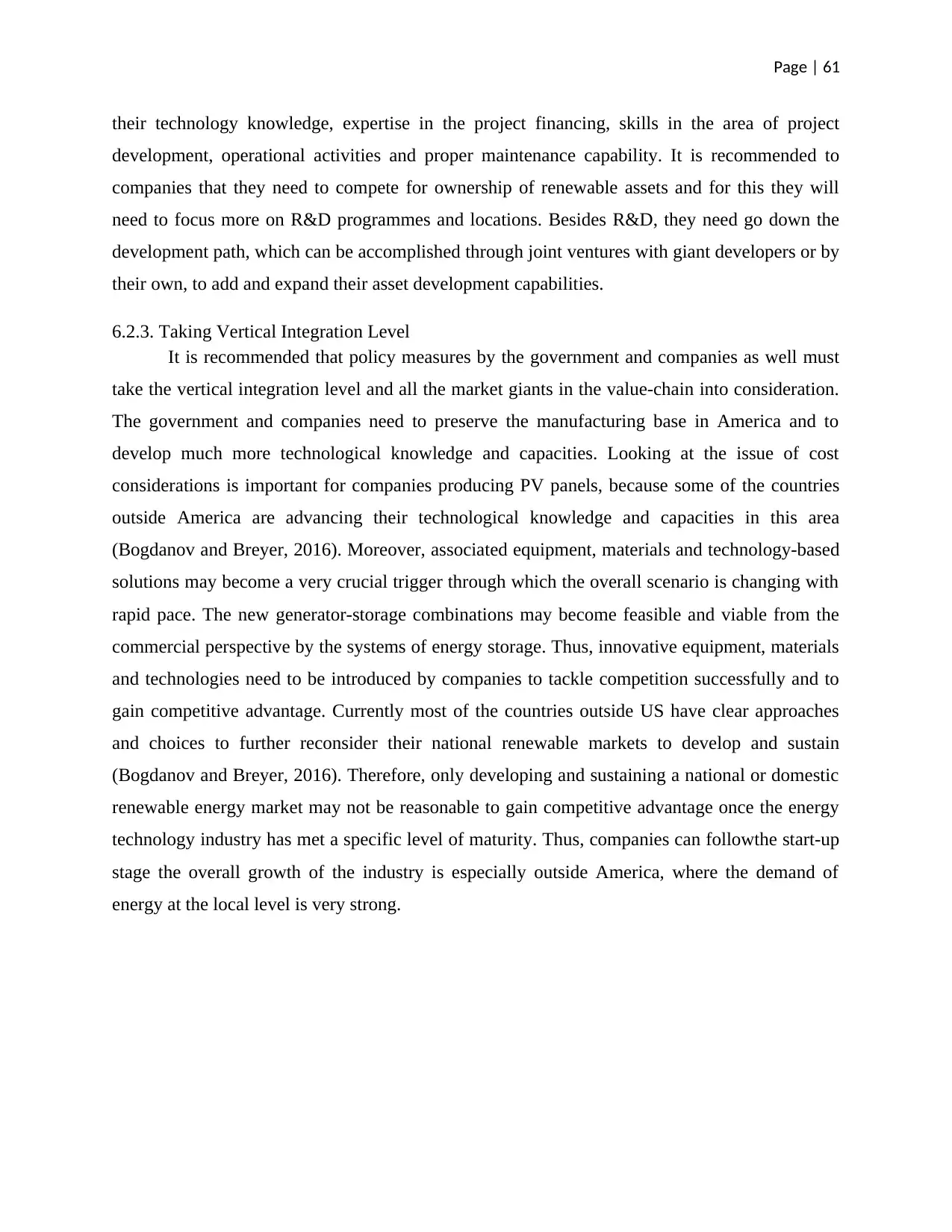
Page | 61
their technology knowledge, expertise in the project financing, skills in the area of project
development, operational activities and proper maintenance capability. It is recommended to
companies that they need to compete for ownership of renewable assets and for this they will
need to focus more on R&D programmes and locations. Besides R&D, they need go down the
development path, which can be accomplished through joint ventures with giant developers or by
their own, to add and expand their asset development capabilities.
6.2.3. Taking Vertical Integration Level
It is recommended that policy measures by the government and companies as well must
take the vertical integration level and all the market giants in the value-chain into consideration.
The government and companies need to preserve the manufacturing base in America and to
develop much more technological knowledge and capacities. Looking at the issue of cost
considerations is important for companies producing PV panels, because some of the countries
outside America are advancing their technological knowledge and capacities in this area
(Bogdanov and Breyer, 2016). Moreover, associated equipment, materials and technology-based
solutions may become a very crucial trigger through which the overall scenario is changing with
rapid pace. The new generator-storage combinations may become feasible and viable from the
commercial perspective by the systems of energy storage. Thus, innovative equipment, materials
and technologies need to be introduced by companies to tackle competition successfully and to
gain competitive advantage. Currently most of the countries outside US have clear approaches
and choices to further reconsider their national renewable markets to develop and sustain
(Bogdanov and Breyer, 2016). Therefore, only developing and sustaining a national or domestic
renewable energy market may not be reasonable to gain competitive advantage once the energy
technology industry has met a specific level of maturity. Thus, companies can followthe start-up
stage the overall growth of the industry is especially outside America, where the demand of
energy at the local level is very strong.
their technology knowledge, expertise in the project financing, skills in the area of project
development, operational activities and proper maintenance capability. It is recommended to
companies that they need to compete for ownership of renewable assets and for this they will
need to focus more on R&D programmes and locations. Besides R&D, they need go down the
development path, which can be accomplished through joint ventures with giant developers or by
their own, to add and expand their asset development capabilities.
6.2.3. Taking Vertical Integration Level
It is recommended that policy measures by the government and companies as well must
take the vertical integration level and all the market giants in the value-chain into consideration.
The government and companies need to preserve the manufacturing base in America and to
develop much more technological knowledge and capacities. Looking at the issue of cost
considerations is important for companies producing PV panels, because some of the countries
outside America are advancing their technological knowledge and capacities in this area
(Bogdanov and Breyer, 2016). Moreover, associated equipment, materials and technology-based
solutions may become a very crucial trigger through which the overall scenario is changing with
rapid pace. The new generator-storage combinations may become feasible and viable from the
commercial perspective by the systems of energy storage. Thus, innovative equipment, materials
and technologies need to be introduced by companies to tackle competition successfully and to
gain competitive advantage. Currently most of the countries outside US have clear approaches
and choices to further reconsider their national renewable markets to develop and sustain
(Bogdanov and Breyer, 2016). Therefore, only developing and sustaining a national or domestic
renewable energy market may not be reasonable to gain competitive advantage once the energy
technology industry has met a specific level of maturity. Thus, companies can followthe start-up
stage the overall growth of the industry is especially outside America, where the demand of
energy at the local level is very strong.
Paraphrase This Document
Need a fresh take? Get an instant paraphrase of this document with our AI Paraphraser
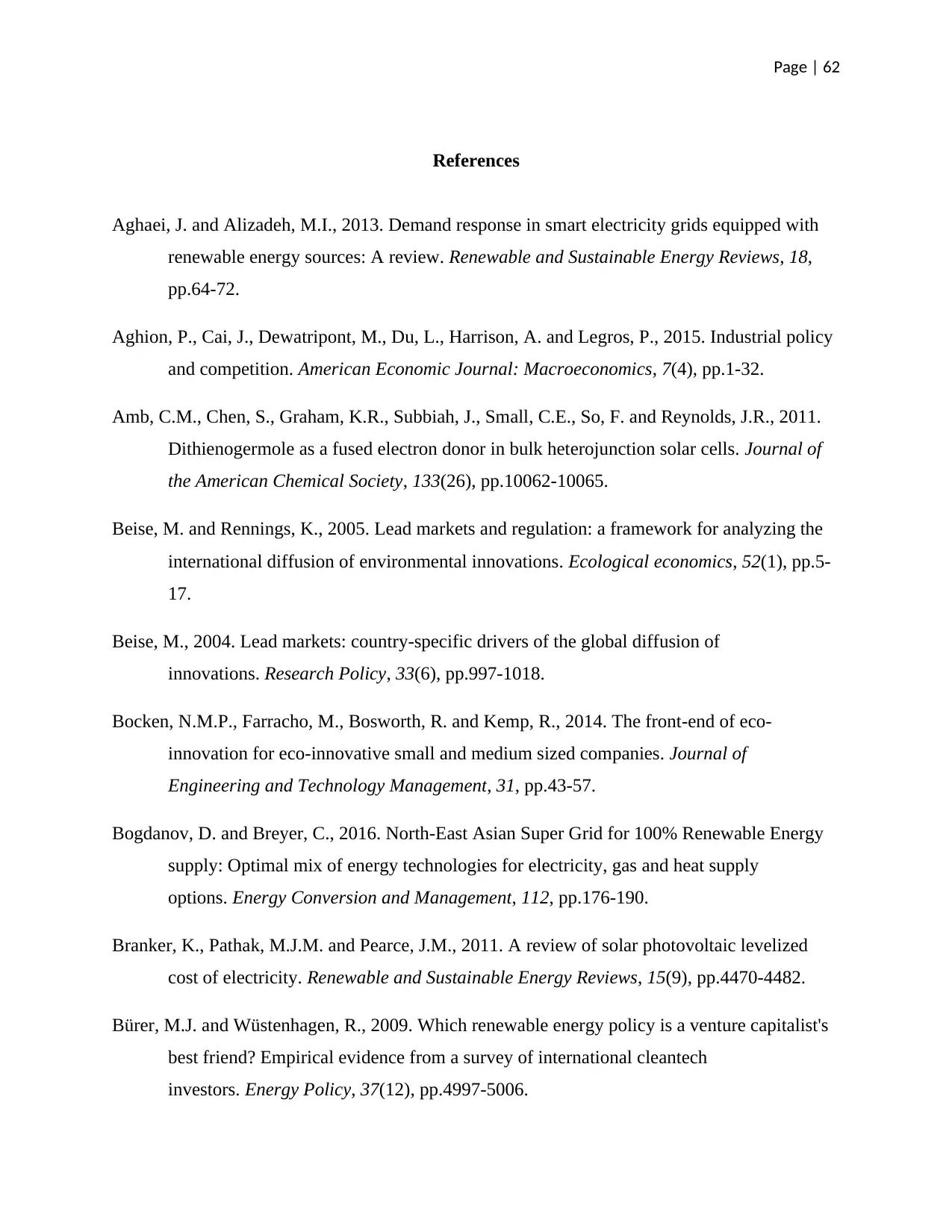
Page | 62
References
Aghaei, J. and Alizadeh, M.I., 2013. Demand response in smart electricity grids equipped with
renewable energy sources: A review. Renewable and Sustainable Energy Reviews, 18,
pp.64-72.
Aghion, P., Cai, J., Dewatripont, M., Du, L., Harrison, A. and Legros, P., 2015. Industrial policy
and competition. American Economic Journal: Macroeconomics, 7(4), pp.1-32.
Amb, C.M., Chen, S., Graham, K.R., Subbiah, J., Small, C.E., So, F. and Reynolds, J.R., 2011.
Dithienogermole as a fused electron donor in bulk heterojunction solar cells. Journal of
the American Chemical Society, 133(26), pp.10062-10065.
Beise, M. and Rennings, K., 2005. Lead markets and regulation: a framework for analyzing the
international diffusion of environmental innovations. Ecological economics, 52(1), pp.5-
17.
Beise, M., 2004. Lead markets: country-specific drivers of the global diffusion of
innovations. Research Policy, 33(6), pp.997-1018.
Bocken, N.M.P., Farracho, M., Bosworth, R. and Kemp, R., 2014. The front-end of eco-
innovation for eco-innovative small and medium sized companies. Journal of
Engineering and Technology Management, 31, pp.43-57.
Bogdanov, D. and Breyer, C., 2016. North-East Asian Super Grid for 100% Renewable Energy
supply: Optimal mix of energy technologies for electricity, gas and heat supply
options. Energy Conversion and Management, 112, pp.176-190.
Branker, K., Pathak, M.J.M. and Pearce, J.M., 2011. A review of solar photovoltaic levelized
cost of electricity. Renewable and Sustainable Energy Reviews, 15(9), pp.4470-4482.
Bürer, M.J. and Wüstenhagen, R., 2009. Which renewable energy policy is a venture capitalist's
best friend? Empirical evidence from a survey of international cleantech
investors. Energy Policy, 37(12), pp.4997-5006.
References
Aghaei, J. and Alizadeh, M.I., 2013. Demand response in smart electricity grids equipped with
renewable energy sources: A review. Renewable and Sustainable Energy Reviews, 18,
pp.64-72.
Aghion, P., Cai, J., Dewatripont, M., Du, L., Harrison, A. and Legros, P., 2015. Industrial policy
and competition. American Economic Journal: Macroeconomics, 7(4), pp.1-32.
Amb, C.M., Chen, S., Graham, K.R., Subbiah, J., Small, C.E., So, F. and Reynolds, J.R., 2011.
Dithienogermole as a fused electron donor in bulk heterojunction solar cells. Journal of
the American Chemical Society, 133(26), pp.10062-10065.
Beise, M. and Rennings, K., 2005. Lead markets and regulation: a framework for analyzing the
international diffusion of environmental innovations. Ecological economics, 52(1), pp.5-
17.
Beise, M., 2004. Lead markets: country-specific drivers of the global diffusion of
innovations. Research Policy, 33(6), pp.997-1018.
Bocken, N.M.P., Farracho, M., Bosworth, R. and Kemp, R., 2014. The front-end of eco-
innovation for eco-innovative small and medium sized companies. Journal of
Engineering and Technology Management, 31, pp.43-57.
Bogdanov, D. and Breyer, C., 2016. North-East Asian Super Grid for 100% Renewable Energy
supply: Optimal mix of energy technologies for electricity, gas and heat supply
options. Energy Conversion and Management, 112, pp.176-190.
Branker, K., Pathak, M.J.M. and Pearce, J.M., 2011. A review of solar photovoltaic levelized
cost of electricity. Renewable and Sustainable Energy Reviews, 15(9), pp.4470-4482.
Bürer, M.J. and Wüstenhagen, R., 2009. Which renewable energy policy is a venture capitalist's
best friend? Empirical evidence from a survey of international cleantech
investors. Energy Policy, 37(12), pp.4997-5006.
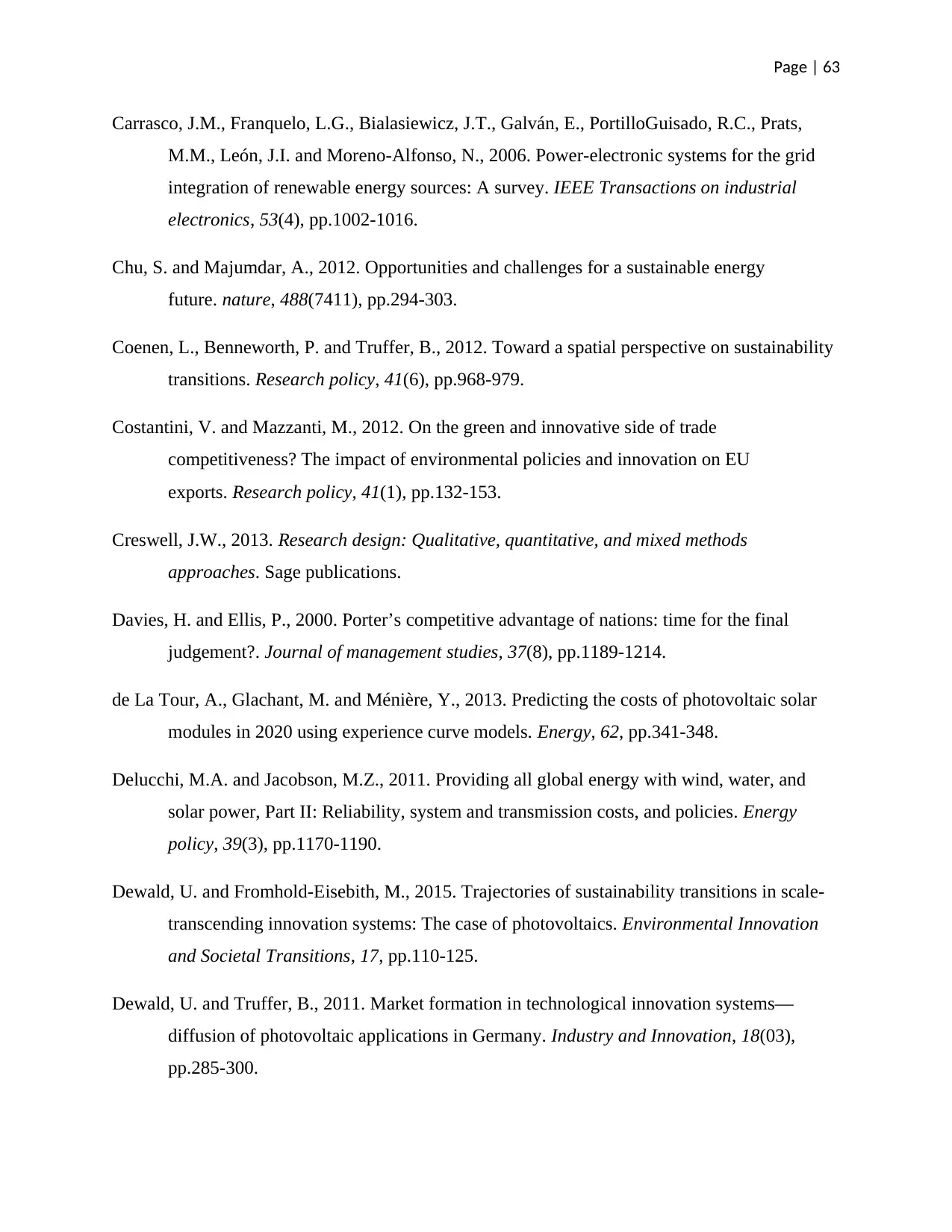
Page | 63
Carrasco, J.M., Franquelo, L.G., Bialasiewicz, J.T., Galván, E., PortilloGuisado, R.C., Prats,
M.M., León, J.I. and Moreno-Alfonso, N., 2006. Power-electronic systems for the grid
integration of renewable energy sources: A survey. IEEE Transactions on industrial
electronics, 53(4), pp.1002-1016.
Chu, S. and Majumdar, A., 2012. Opportunities and challenges for a sustainable energy
future. nature, 488(7411), pp.294-303.
Coenen, L., Benneworth, P. and Truffer, B., 2012. Toward a spatial perspective on sustainability
transitions. Research policy, 41(6), pp.968-979.
Costantini, V. and Mazzanti, M., 2012. On the green and innovative side of trade
competitiveness? The impact of environmental policies and innovation on EU
exports. Research policy, 41(1), pp.132-153.
Creswell, J.W., 2013. Research design: Qualitative, quantitative, and mixed methods
approaches. Sage publications.
Davies, H. and Ellis, P., 2000. Porter’s competitive advantage of nations: time for the final
judgement?. Journal of management studies, 37(8), pp.1189-1214.
de La Tour, A., Glachant, M. and Ménière, Y., 2013. Predicting the costs of photovoltaic solar
modules in 2020 using experience curve models. Energy, 62, pp.341-348.
Delucchi, M.A. and Jacobson, M.Z., 2011. Providing all global energy with wind, water, and
solar power, Part II: Reliability, system and transmission costs, and policies. Energy
policy, 39(3), pp.1170-1190.
Dewald, U. and Fromhold-Eisebith, M., 2015. Trajectories of sustainability transitions in scale-
transcending innovation systems: The case of photovoltaics. Environmental Innovation
and Societal Transitions, 17, pp.110-125.
Dewald, U. and Truffer, B., 2011. Market formation in technological innovation systems—
diffusion of photovoltaic applications in Germany. Industry and Innovation, 18(03),
pp.285-300.
Carrasco, J.M., Franquelo, L.G., Bialasiewicz, J.T., Galván, E., PortilloGuisado, R.C., Prats,
M.M., León, J.I. and Moreno-Alfonso, N., 2006. Power-electronic systems for the grid
integration of renewable energy sources: A survey. IEEE Transactions on industrial
electronics, 53(4), pp.1002-1016.
Chu, S. and Majumdar, A., 2012. Opportunities and challenges for a sustainable energy
future. nature, 488(7411), pp.294-303.
Coenen, L., Benneworth, P. and Truffer, B., 2012. Toward a spatial perspective on sustainability
transitions. Research policy, 41(6), pp.968-979.
Costantini, V. and Mazzanti, M., 2012. On the green and innovative side of trade
competitiveness? The impact of environmental policies and innovation on EU
exports. Research policy, 41(1), pp.132-153.
Creswell, J.W., 2013. Research design: Qualitative, quantitative, and mixed methods
approaches. Sage publications.
Davies, H. and Ellis, P., 2000. Porter’s competitive advantage of nations: time for the final
judgement?. Journal of management studies, 37(8), pp.1189-1214.
de La Tour, A., Glachant, M. and Ménière, Y., 2013. Predicting the costs of photovoltaic solar
modules in 2020 using experience curve models. Energy, 62, pp.341-348.
Delucchi, M.A. and Jacobson, M.Z., 2011. Providing all global energy with wind, water, and
solar power, Part II: Reliability, system and transmission costs, and policies. Energy
policy, 39(3), pp.1170-1190.
Dewald, U. and Fromhold-Eisebith, M., 2015. Trajectories of sustainability transitions in scale-
transcending innovation systems: The case of photovoltaics. Environmental Innovation
and Societal Transitions, 17, pp.110-125.
Dewald, U. and Truffer, B., 2011. Market formation in technological innovation systems—
diffusion of photovoltaic applications in Germany. Industry and Innovation, 18(03),
pp.285-300.
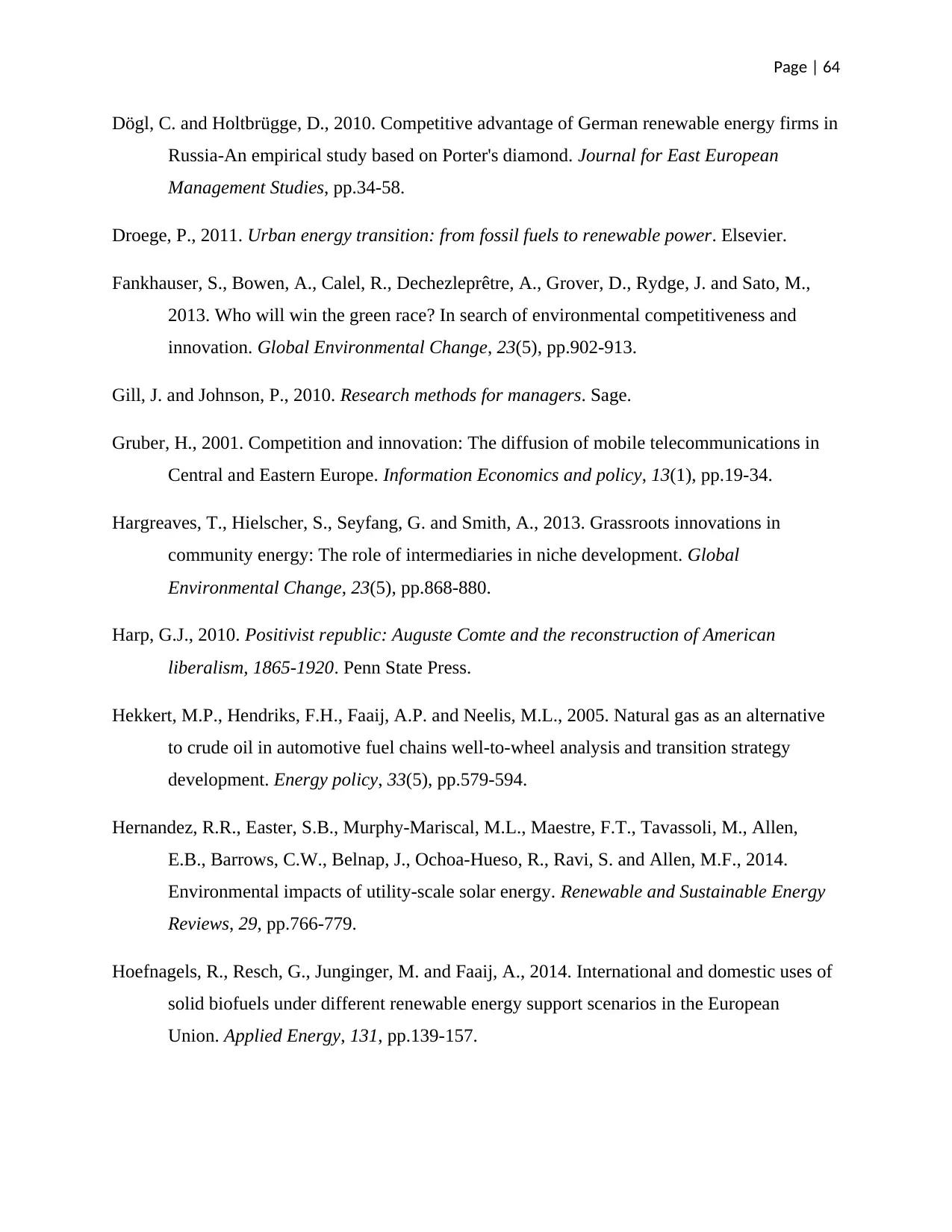
Page | 64
Dögl, C. and Holtbrügge, D., 2010. Competitive advantage of German renewable energy firms in
Russia-An empirical study based on Porter's diamond. Journal for East European
Management Studies, pp.34-58.
Droege, P., 2011. Urban energy transition: from fossil fuels to renewable power. Elsevier.
Fankhauser, S., Bowen, A., Calel, R., Dechezleprêtre, A., Grover, D., Rydge, J. and Sato, M.,
2013. Who will win the green race? In search of environmental competitiveness and
innovation. Global Environmental Change, 23(5), pp.902-913.
Gill, J. and Johnson, P., 2010. Research methods for managers. Sage.
Gruber, H., 2001. Competition and innovation: The diffusion of mobile telecommunications in
Central and Eastern Europe. Information Economics and policy, 13(1), pp.19-34.
Hargreaves, T., Hielscher, S., Seyfang, G. and Smith, A., 2013. Grassroots innovations in
community energy: The role of intermediaries in niche development. Global
Environmental Change, 23(5), pp.868-880.
Harp, G.J., 2010. Positivist republic: Auguste Comte and the reconstruction of American
liberalism, 1865-1920. Penn State Press.
Hekkert, M.P., Hendriks, F.H., Faaij, A.P. and Neelis, M.L., 2005. Natural gas as an alternative
to crude oil in automotive fuel chains well-to-wheel analysis and transition strategy
development. Energy policy, 33(5), pp.579-594.
Hernandez, R.R., Easter, S.B., Murphy-Mariscal, M.L., Maestre, F.T., Tavassoli, M., Allen,
E.B., Barrows, C.W., Belnap, J., Ochoa-Hueso, R., Ravi, S. and Allen, M.F., 2014.
Environmental impacts of utility-scale solar energy. Renewable and Sustainable Energy
Reviews, 29, pp.766-779.
Hoefnagels, R., Resch, G., Junginger, M. and Faaij, A., 2014. International and domestic uses of
solid biofuels under different renewable energy support scenarios in the European
Union. Applied Energy, 131, pp.139-157.
Dögl, C. and Holtbrügge, D., 2010. Competitive advantage of German renewable energy firms in
Russia-An empirical study based on Porter's diamond. Journal for East European
Management Studies, pp.34-58.
Droege, P., 2011. Urban energy transition: from fossil fuels to renewable power. Elsevier.
Fankhauser, S., Bowen, A., Calel, R., Dechezleprêtre, A., Grover, D., Rydge, J. and Sato, M.,
2013. Who will win the green race? In search of environmental competitiveness and
innovation. Global Environmental Change, 23(5), pp.902-913.
Gill, J. and Johnson, P., 2010. Research methods for managers. Sage.
Gruber, H., 2001. Competition and innovation: The diffusion of mobile telecommunications in
Central and Eastern Europe. Information Economics and policy, 13(1), pp.19-34.
Hargreaves, T., Hielscher, S., Seyfang, G. and Smith, A., 2013. Grassroots innovations in
community energy: The role of intermediaries in niche development. Global
Environmental Change, 23(5), pp.868-880.
Harp, G.J., 2010. Positivist republic: Auguste Comte and the reconstruction of American
liberalism, 1865-1920. Penn State Press.
Hekkert, M.P., Hendriks, F.H., Faaij, A.P. and Neelis, M.L., 2005. Natural gas as an alternative
to crude oil in automotive fuel chains well-to-wheel analysis and transition strategy
development. Energy policy, 33(5), pp.579-594.
Hernandez, R.R., Easter, S.B., Murphy-Mariscal, M.L., Maestre, F.T., Tavassoli, M., Allen,
E.B., Barrows, C.W., Belnap, J., Ochoa-Hueso, R., Ravi, S. and Allen, M.F., 2014.
Environmental impacts of utility-scale solar energy. Renewable and Sustainable Energy
Reviews, 29, pp.766-779.
Hoefnagels, R., Resch, G., Junginger, M. and Faaij, A., 2014. International and domestic uses of
solid biofuels under different renewable energy support scenarios in the European
Union. Applied Energy, 131, pp.139-157.
Secure Best Marks with AI Grader
Need help grading? Try our AI Grader for instant feedback on your assignments.

Page | 65
Hoppmann, J., Huenteler, J. and Girod, B., 2014. Compulsive policy-making—The evolution of
the German feed-in tariff system for solar photovoltaic power. Research Policy, 43(8),
pp.1422-1441.
Iea.org. (2016). May: OECD energy production hits record high but consumption and CO2
emissions fall. [online] Available at: http://www.iea.org/newsroom/news/2016/may/oecd-
energy-production-hits-record-high-but-consumption-and-co2-emissions-fall.html
[Accessed 20 Jun. 2017].
Ipakchi, A. and Albuyeh, F., 2009. Grid of the future. IEEE power and energy magazine, 7(2),
pp.52-62.
Isaac, M. and Van Vuuren, D.P., 2009. Modeling global residential sector energy demand for
heating and air conditioning in the context of climate change. Energy policy, 37(2),
pp.507-521.
Isoard, S. and Soria, A., 2001. Technical change dynamics: evidence from the emerging
renewable energy technologies. Energy Economics, 23(6), pp.619-636.
Jacob, K., Beise, M., Blazejczak, J.M., Edler, D., Haum, R., Jänicke, M., Löw, T., Petschow, U.
and Rennings, K., 2006. Lead markets for environmental innovations (Vol. 27). Springer
Science & Business Media.
Jacobson, M.Z. and Delucchi, M.A., 2011. Providing all global energy with wind, water, and
solar power, Part I: Technologies, energy resources, quantities and areas of infrastructure,
and materials. Energy policy, 39(3), pp.1154-1169.
Jacobsson, S. and Lauber, V., 2006. The politics and policy of energy system transformation—
explaining the German diffusion of renewable energy technology. Energy policy, 34(3),
pp.256-276.
Jager, W., 2006. Stimulating the diffusion of photovoltaic systems: A behavioural
perspective. Energy Policy, 34(14), pp.1935-1943.
Hoppmann, J., Huenteler, J. and Girod, B., 2014. Compulsive policy-making—The evolution of
the German feed-in tariff system for solar photovoltaic power. Research Policy, 43(8),
pp.1422-1441.
Iea.org. (2016). May: OECD energy production hits record high but consumption and CO2
emissions fall. [online] Available at: http://www.iea.org/newsroom/news/2016/may/oecd-
energy-production-hits-record-high-but-consumption-and-co2-emissions-fall.html
[Accessed 20 Jun. 2017].
Ipakchi, A. and Albuyeh, F., 2009. Grid of the future. IEEE power and energy magazine, 7(2),
pp.52-62.
Isaac, M. and Van Vuuren, D.P., 2009. Modeling global residential sector energy demand for
heating and air conditioning in the context of climate change. Energy policy, 37(2),
pp.507-521.
Isoard, S. and Soria, A., 2001. Technical change dynamics: evidence from the emerging
renewable energy technologies. Energy Economics, 23(6), pp.619-636.
Jacob, K., Beise, M., Blazejczak, J.M., Edler, D., Haum, R., Jänicke, M., Löw, T., Petschow, U.
and Rennings, K., 2006. Lead markets for environmental innovations (Vol. 27). Springer
Science & Business Media.
Jacobson, M.Z. and Delucchi, M.A., 2011. Providing all global energy with wind, water, and
solar power, Part I: Technologies, energy resources, quantities and areas of infrastructure,
and materials. Energy policy, 39(3), pp.1154-1169.
Jacobsson, S. and Lauber, V., 2006. The politics and policy of energy system transformation—
explaining the German diffusion of renewable energy technology. Energy policy, 34(3),
pp.256-276.
Jager, W., 2006. Stimulating the diffusion of photovoltaic systems: A behavioural
perspective. Energy Policy, 34(14), pp.1935-1943.
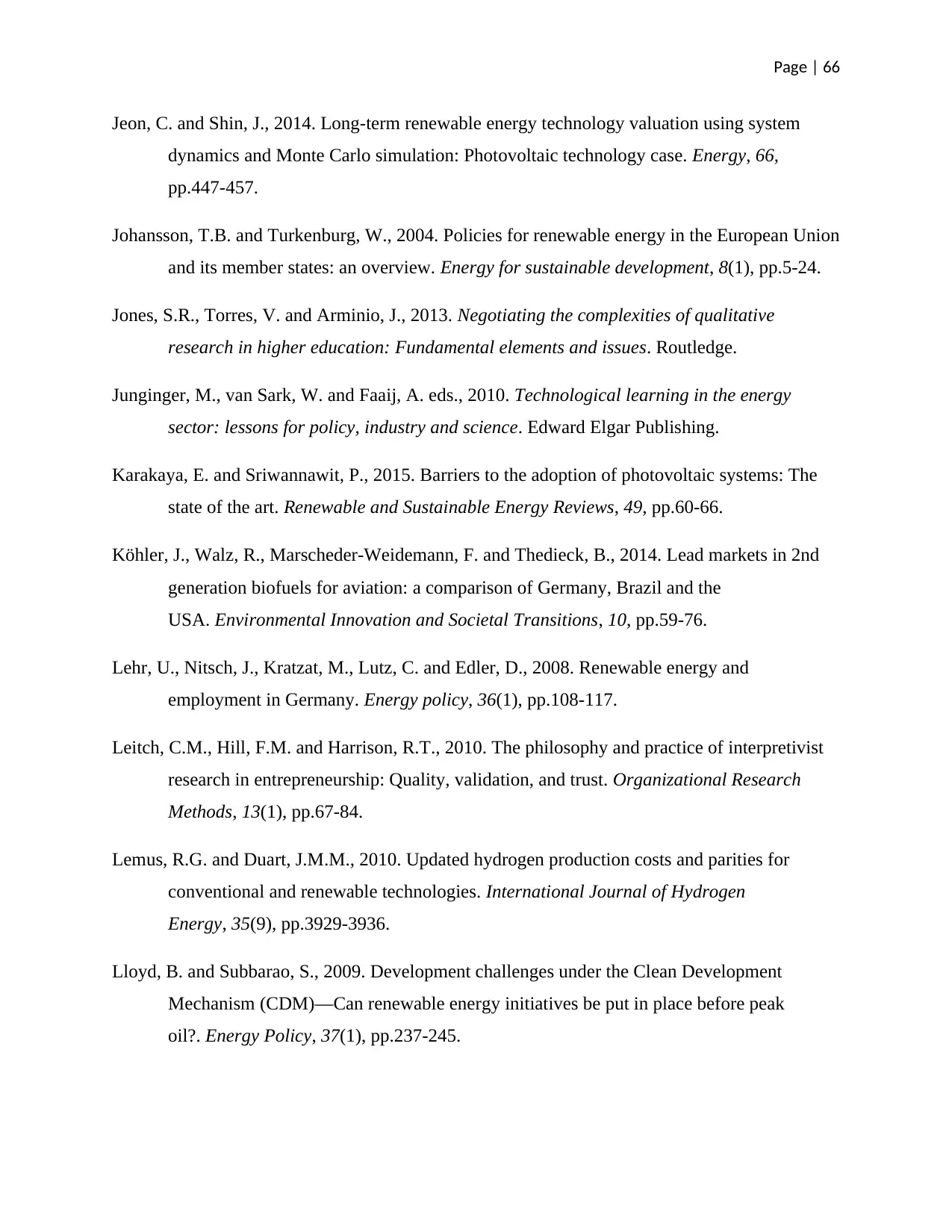
Page | 66
Jeon, C. and Shin, J., 2014. Long-term renewable energy technology valuation using system
dynamics and Monte Carlo simulation: Photovoltaic technology case. Energy, 66,
pp.447-457.
Johansson, T.B. and Turkenburg, W., 2004. Policies for renewable energy in the European Union
and its member states: an overview. Energy for sustainable development, 8(1), pp.5-24.
Jones, S.R., Torres, V. and Arminio, J., 2013. Negotiating the complexities of qualitative
research in higher education: Fundamental elements and issues. Routledge.
Junginger, M., van Sark, W. and Faaij, A. eds., 2010. Technological learning in the energy
sector: lessons for policy, industry and science. Edward Elgar Publishing.
Karakaya, E. and Sriwannawit, P., 2015. Barriers to the adoption of photovoltaic systems: The
state of the art. Renewable and Sustainable Energy Reviews, 49, pp.60-66.
Köhler, J., Walz, R., Marscheder-Weidemann, F. and Thedieck, B., 2014. Lead markets in 2nd
generation biofuels for aviation: a comparison of Germany, Brazil and the
USA. Environmental Innovation and Societal Transitions, 10, pp.59-76.
Lehr, U., Nitsch, J., Kratzat, M., Lutz, C. and Edler, D., 2008. Renewable energy and
employment in Germany. Energy policy, 36(1), pp.108-117.
Leitch, C.M., Hill, F.M. and Harrison, R.T., 2010. The philosophy and practice of interpretivist
research in entrepreneurship: Quality, validation, and trust. Organizational Research
Methods, 13(1), pp.67-84.
Lemus, R.G. and Duart, J.M.M., 2010. Updated hydrogen production costs and parities for
conventional and renewable technologies. International Journal of Hydrogen
Energy, 35(9), pp.3929-3936.
Lloyd, B. and Subbarao, S., 2009. Development challenges under the Clean Development
Mechanism (CDM)—Can renewable energy initiatives be put in place before peak
oil?. Energy Policy, 37(1), pp.237-245.
Jeon, C. and Shin, J., 2014. Long-term renewable energy technology valuation using system
dynamics and Monte Carlo simulation: Photovoltaic technology case. Energy, 66,
pp.447-457.
Johansson, T.B. and Turkenburg, W., 2004. Policies for renewable energy in the European Union
and its member states: an overview. Energy for sustainable development, 8(1), pp.5-24.
Jones, S.R., Torres, V. and Arminio, J., 2013. Negotiating the complexities of qualitative
research in higher education: Fundamental elements and issues. Routledge.
Junginger, M., van Sark, W. and Faaij, A. eds., 2010. Technological learning in the energy
sector: lessons for policy, industry and science. Edward Elgar Publishing.
Karakaya, E. and Sriwannawit, P., 2015. Barriers to the adoption of photovoltaic systems: The
state of the art. Renewable and Sustainable Energy Reviews, 49, pp.60-66.
Köhler, J., Walz, R., Marscheder-Weidemann, F. and Thedieck, B., 2014. Lead markets in 2nd
generation biofuels for aviation: a comparison of Germany, Brazil and the
USA. Environmental Innovation and Societal Transitions, 10, pp.59-76.
Lehr, U., Nitsch, J., Kratzat, M., Lutz, C. and Edler, D., 2008. Renewable energy and
employment in Germany. Energy policy, 36(1), pp.108-117.
Leitch, C.M., Hill, F.M. and Harrison, R.T., 2010. The philosophy and practice of interpretivist
research in entrepreneurship: Quality, validation, and trust. Organizational Research
Methods, 13(1), pp.67-84.
Lemus, R.G. and Duart, J.M.M., 2010. Updated hydrogen production costs and parities for
conventional and renewable technologies. International Journal of Hydrogen
Energy, 35(9), pp.3929-3936.
Lloyd, B. and Subbarao, S., 2009. Development challenges under the Clean Development
Mechanism (CDM)—Can renewable energy initiatives be put in place before peak
oil?. Energy Policy, 37(1), pp.237-245.
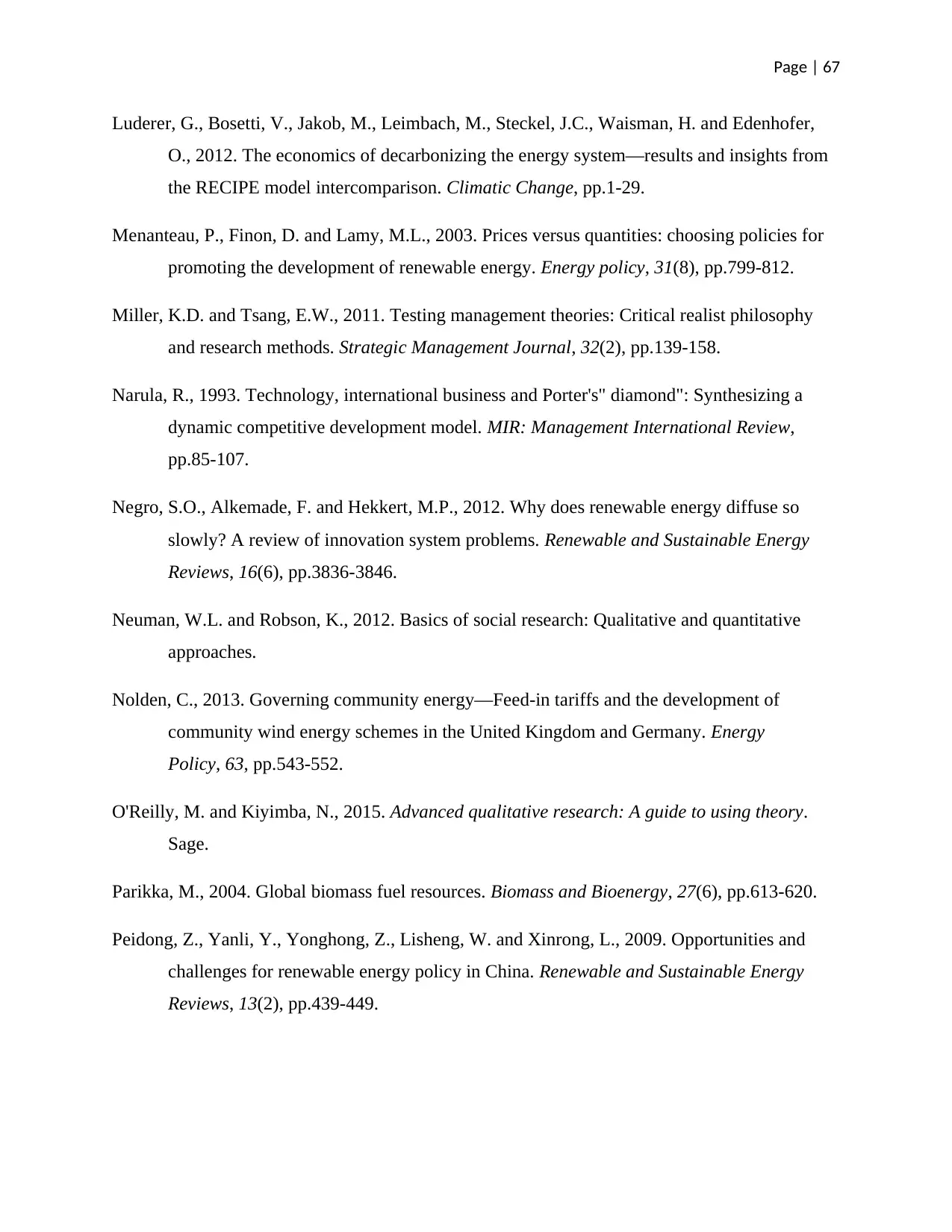
Page | 67
Luderer, G., Bosetti, V., Jakob, M., Leimbach, M., Steckel, J.C., Waisman, H. and Edenhofer,
O., 2012. The economics of decarbonizing the energy system—results and insights from
the RECIPE model intercomparison. Climatic Change, pp.1-29.
Menanteau, P., Finon, D. and Lamy, M.L., 2003. Prices versus quantities: choosing policies for
promoting the development of renewable energy. Energy policy, 31(8), pp.799-812.
Miller, K.D. and Tsang, E.W., 2011. Testing management theories: Critical realist philosophy
and research methods. Strategic Management Journal, 32(2), pp.139-158.
Narula, R., 1993. Technology, international business and Porter's" diamond": Synthesizing a
dynamic competitive development model. MIR: Management International Review,
pp.85-107.
Negro, S.O., Alkemade, F. and Hekkert, M.P., 2012. Why does renewable energy diffuse so
slowly? A review of innovation system problems. Renewable and Sustainable Energy
Reviews, 16(6), pp.3836-3846.
Neuman, W.L. and Robson, K., 2012. Basics of social research: Qualitative and quantitative
approaches.
Nolden, C., 2013. Governing community energy—Feed-in tariffs and the development of
community wind energy schemes in the United Kingdom and Germany. Energy
Policy, 63, pp.543-552.
O'Reilly, M. and Kiyimba, N., 2015. Advanced qualitative research: A guide to using theory.
Sage.
Parikka, M., 2004. Global biomass fuel resources. Biomass and Bioenergy, 27(6), pp.613-620.
Peidong, Z., Yanli, Y., Yonghong, Z., Lisheng, W. and Xinrong, L., 2009. Opportunities and
challenges for renewable energy policy in China. Renewable and Sustainable Energy
Reviews, 13(2), pp.439-449.
Luderer, G., Bosetti, V., Jakob, M., Leimbach, M., Steckel, J.C., Waisman, H. and Edenhofer,
O., 2012. The economics of decarbonizing the energy system—results and insights from
the RECIPE model intercomparison. Climatic Change, pp.1-29.
Menanteau, P., Finon, D. and Lamy, M.L., 2003. Prices versus quantities: choosing policies for
promoting the development of renewable energy. Energy policy, 31(8), pp.799-812.
Miller, K.D. and Tsang, E.W., 2011. Testing management theories: Critical realist philosophy
and research methods. Strategic Management Journal, 32(2), pp.139-158.
Narula, R., 1993. Technology, international business and Porter's" diamond": Synthesizing a
dynamic competitive development model. MIR: Management International Review,
pp.85-107.
Negro, S.O., Alkemade, F. and Hekkert, M.P., 2012. Why does renewable energy diffuse so
slowly? A review of innovation system problems. Renewable and Sustainable Energy
Reviews, 16(6), pp.3836-3846.
Neuman, W.L. and Robson, K., 2012. Basics of social research: Qualitative and quantitative
approaches.
Nolden, C., 2013. Governing community energy—Feed-in tariffs and the development of
community wind energy schemes in the United Kingdom and Germany. Energy
Policy, 63, pp.543-552.
O'Reilly, M. and Kiyimba, N., 2015. Advanced qualitative research: A guide to using theory.
Sage.
Parikka, M., 2004. Global biomass fuel resources. Biomass and Bioenergy, 27(6), pp.613-620.
Peidong, Z., Yanli, Y., Yonghong, Z., Lisheng, W. and Xinrong, L., 2009. Opportunities and
challenges for renewable energy policy in China. Renewable and Sustainable Energy
Reviews, 13(2), pp.439-449.
Paraphrase This Document
Need a fresh take? Get an instant paraphrase of this document with our AI Paraphraser
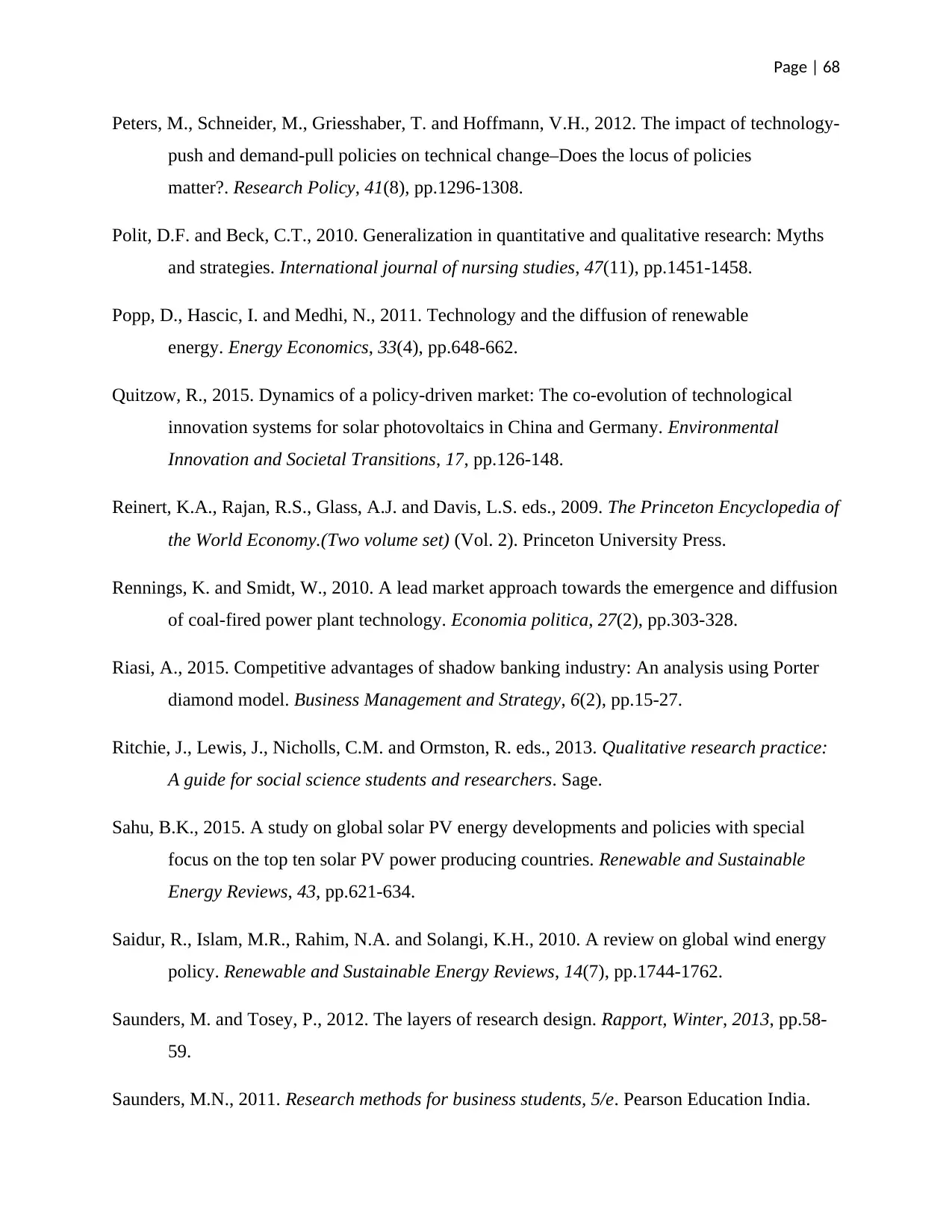
Page | 68
Peters, M., Schneider, M., Griesshaber, T. and Hoffmann, V.H., 2012. The impact of technology-
push and demand-pull policies on technical change–Does the locus of policies
matter?. Research Policy, 41(8), pp.1296-1308.
Polit, D.F. and Beck, C.T., 2010. Generalization in quantitative and qualitative research: Myths
and strategies. International journal of nursing studies, 47(11), pp.1451-1458.
Popp, D., Hascic, I. and Medhi, N., 2011. Technology and the diffusion of renewable
energy. Energy Economics, 33(4), pp.648-662.
Quitzow, R., 2015. Dynamics of a policy-driven market: The co-evolution of technological
innovation systems for solar photovoltaics in China and Germany. Environmental
Innovation and Societal Transitions, 17, pp.126-148.
Reinert, K.A., Rajan, R.S., Glass, A.J. and Davis, L.S. eds., 2009. The Princeton Encyclopedia of
the World Economy.(Two volume set) (Vol. 2). Princeton University Press.
Rennings, K. and Smidt, W., 2010. A lead market approach towards the emergence and diffusion
of coal-fired power plant technology. Economia politica, 27(2), pp.303-328.
Riasi, A., 2015. Competitive advantages of shadow banking industry: An analysis using Porter
diamond model. Business Management and Strategy, 6(2), pp.15-27.
Ritchie, J., Lewis, J., Nicholls, C.M. and Ormston, R. eds., 2013. Qualitative research practice:
A guide for social science students and researchers. Sage.
Sahu, B.K., 2015. A study on global solar PV energy developments and policies with special
focus on the top ten solar PV power producing countries. Renewable and Sustainable
Energy Reviews, 43, pp.621-634.
Saidur, R., Islam, M.R., Rahim, N.A. and Solangi, K.H., 2010. A review on global wind energy
policy. Renewable and Sustainable Energy Reviews, 14(7), pp.1744-1762.
Saunders, M. and Tosey, P., 2012. The layers of research design. Rapport, Winter, 2013, pp.58-
59.
Saunders, M.N., 2011. Research methods for business students, 5/e. Pearson Education India.
Peters, M., Schneider, M., Griesshaber, T. and Hoffmann, V.H., 2012. The impact of technology-
push and demand-pull policies on technical change–Does the locus of policies
matter?. Research Policy, 41(8), pp.1296-1308.
Polit, D.F. and Beck, C.T., 2010. Generalization in quantitative and qualitative research: Myths
and strategies. International journal of nursing studies, 47(11), pp.1451-1458.
Popp, D., Hascic, I. and Medhi, N., 2011. Technology and the diffusion of renewable
energy. Energy Economics, 33(4), pp.648-662.
Quitzow, R., 2015. Dynamics of a policy-driven market: The co-evolution of technological
innovation systems for solar photovoltaics in China and Germany. Environmental
Innovation and Societal Transitions, 17, pp.126-148.
Reinert, K.A., Rajan, R.S., Glass, A.J. and Davis, L.S. eds., 2009. The Princeton Encyclopedia of
the World Economy.(Two volume set) (Vol. 2). Princeton University Press.
Rennings, K. and Smidt, W., 2010. A lead market approach towards the emergence and diffusion
of coal-fired power plant technology. Economia politica, 27(2), pp.303-328.
Riasi, A., 2015. Competitive advantages of shadow banking industry: An analysis using Porter
diamond model. Business Management and Strategy, 6(2), pp.15-27.
Ritchie, J., Lewis, J., Nicholls, C.M. and Ormston, R. eds., 2013. Qualitative research practice:
A guide for social science students and researchers. Sage.
Sahu, B.K., 2015. A study on global solar PV energy developments and policies with special
focus on the top ten solar PV power producing countries. Renewable and Sustainable
Energy Reviews, 43, pp.621-634.
Saidur, R., Islam, M.R., Rahim, N.A. and Solangi, K.H., 2010. A review on global wind energy
policy. Renewable and Sustainable Energy Reviews, 14(7), pp.1744-1762.
Saunders, M. and Tosey, P., 2012. The layers of research design. Rapport, Winter, 2013, pp.58-
59.
Saunders, M.N., 2011. Research methods for business students, 5/e. Pearson Education India.
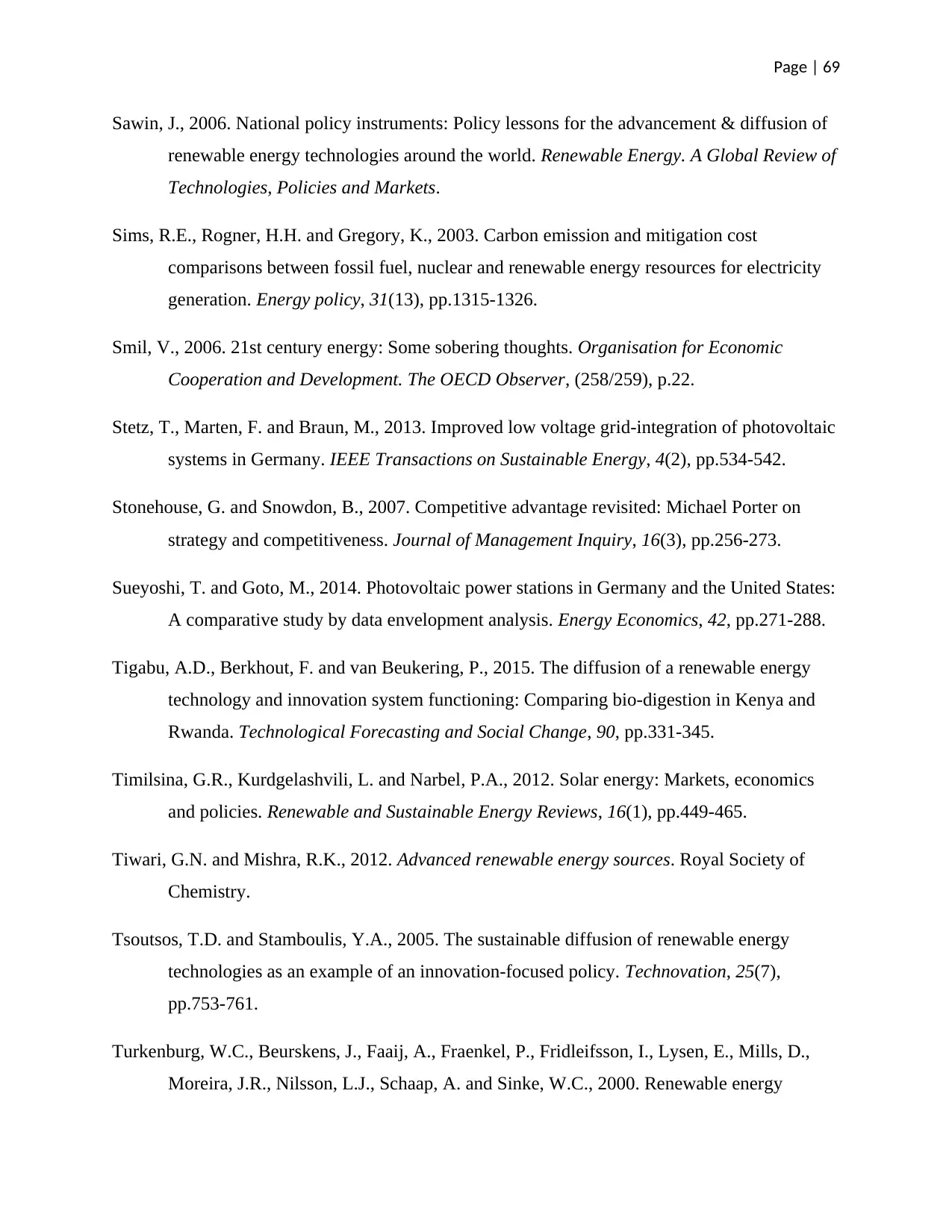
Page | 69
Sawin, J., 2006. National policy instruments: Policy lessons for the advancement & diffusion of
renewable energy technologies around the world. Renewable Energy. A Global Review of
Technologies, Policies and Markets.
Sims, R.E., Rogner, H.H. and Gregory, K., 2003. Carbon emission and mitigation cost
comparisons between fossil fuel, nuclear and renewable energy resources for electricity
generation. Energy policy, 31(13), pp.1315-1326.
Smil, V., 2006. 21st century energy: Some sobering thoughts. Organisation for Economic
Cooperation and Development. The OECD Observer, (258/259), p.22.
Stetz, T., Marten, F. and Braun, M., 2013. Improved low voltage grid-integration of photovoltaic
systems in Germany. IEEE Transactions on Sustainable Energy, 4(2), pp.534-542.
Stonehouse, G. and Snowdon, B., 2007. Competitive advantage revisited: Michael Porter on
strategy and competitiveness. Journal of Management Inquiry, 16(3), pp.256-273.
Sueyoshi, T. and Goto, M., 2014. Photovoltaic power stations in Germany and the United States:
A comparative study by data envelopment analysis. Energy Economics, 42, pp.271-288.
Tigabu, A.D., Berkhout, F. and van Beukering, P., 2015. The diffusion of a renewable energy
technology and innovation system functioning: Comparing bio-digestion in Kenya and
Rwanda. Technological Forecasting and Social Change, 90, pp.331-345.
Timilsina, G.R., Kurdgelashvili, L. and Narbel, P.A., 2012. Solar energy: Markets, economics
and policies. Renewable and Sustainable Energy Reviews, 16(1), pp.449-465.
Tiwari, G.N. and Mishra, R.K., 2012. Advanced renewable energy sources. Royal Society of
Chemistry.
Tsoutsos, T.D. and Stamboulis, Y.A., 2005. The sustainable diffusion of renewable energy
technologies as an example of an innovation-focused policy. Technovation, 25(7),
pp.753-761.
Turkenburg, W.C., Beurskens, J., Faaij, A., Fraenkel, P., Fridleifsson, I., Lysen, E., Mills, D.,
Moreira, J.R., Nilsson, L.J., Schaap, A. and Sinke, W.C., 2000. Renewable energy
Sawin, J., 2006. National policy instruments: Policy lessons for the advancement & diffusion of
renewable energy technologies around the world. Renewable Energy. A Global Review of
Technologies, Policies and Markets.
Sims, R.E., Rogner, H.H. and Gregory, K., 2003. Carbon emission and mitigation cost
comparisons between fossil fuel, nuclear and renewable energy resources for electricity
generation. Energy policy, 31(13), pp.1315-1326.
Smil, V., 2006. 21st century energy: Some sobering thoughts. Organisation for Economic
Cooperation and Development. The OECD Observer, (258/259), p.22.
Stetz, T., Marten, F. and Braun, M., 2013. Improved low voltage grid-integration of photovoltaic
systems in Germany. IEEE Transactions on Sustainable Energy, 4(2), pp.534-542.
Stonehouse, G. and Snowdon, B., 2007. Competitive advantage revisited: Michael Porter on
strategy and competitiveness. Journal of Management Inquiry, 16(3), pp.256-273.
Sueyoshi, T. and Goto, M., 2014. Photovoltaic power stations in Germany and the United States:
A comparative study by data envelopment analysis. Energy Economics, 42, pp.271-288.
Tigabu, A.D., Berkhout, F. and van Beukering, P., 2015. The diffusion of a renewable energy
technology and innovation system functioning: Comparing bio-digestion in Kenya and
Rwanda. Technological Forecasting and Social Change, 90, pp.331-345.
Timilsina, G.R., Kurdgelashvili, L. and Narbel, P.A., 2012. Solar energy: Markets, economics
and policies. Renewable and Sustainable Energy Reviews, 16(1), pp.449-465.
Tiwari, G.N. and Mishra, R.K., 2012. Advanced renewable energy sources. Royal Society of
Chemistry.
Tsoutsos, T.D. and Stamboulis, Y.A., 2005. The sustainable diffusion of renewable energy
technologies as an example of an innovation-focused policy. Technovation, 25(7),
pp.753-761.
Turkenburg, W.C., Beurskens, J., Faaij, A., Fraenkel, P., Fridleifsson, I., Lysen, E., Mills, D.,
Moreira, J.R., Nilsson, L.J., Schaap, A. and Sinke, W.C., 2000. Renewable energy
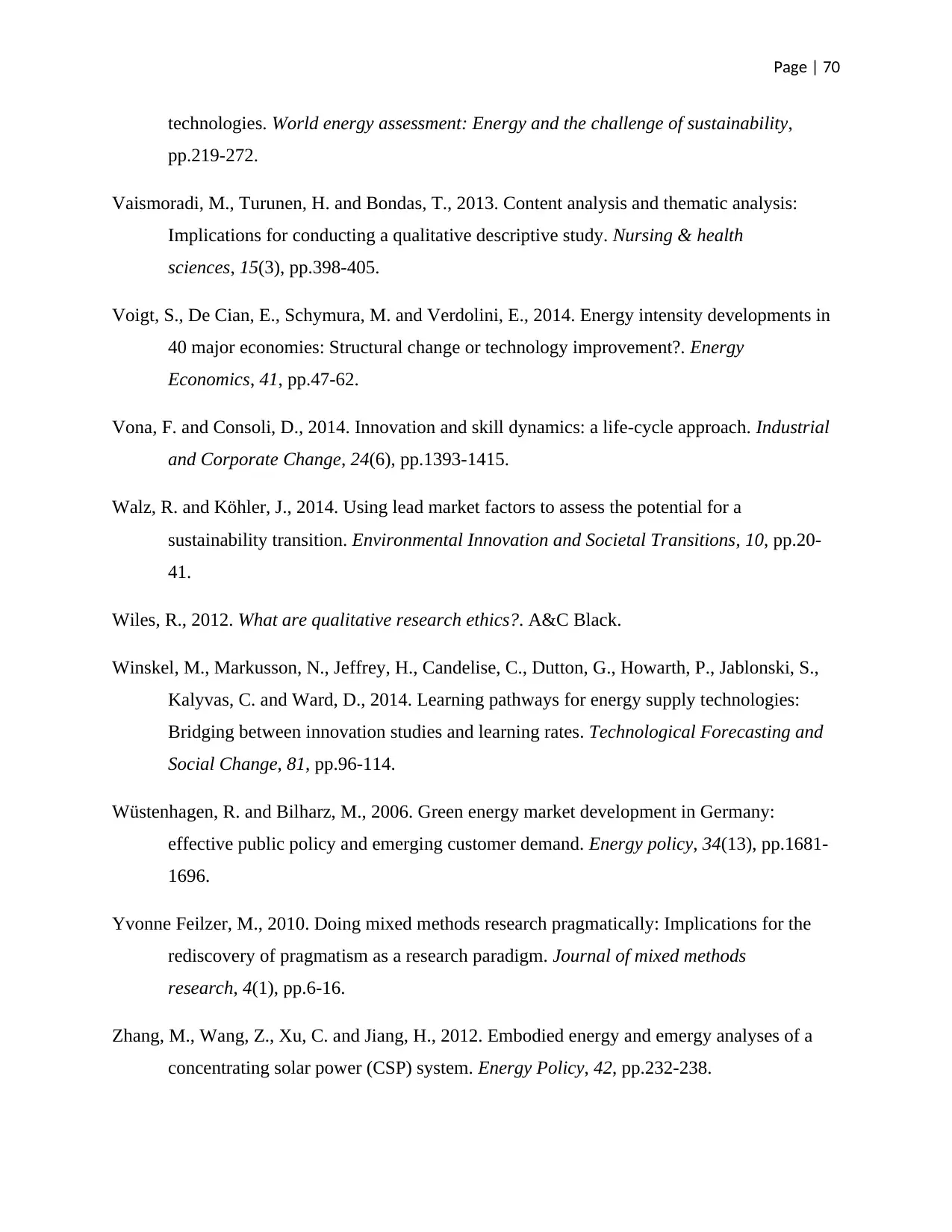
Page | 70
technologies. World energy assessment: Energy and the challenge of sustainability,
pp.219-272.
Vaismoradi, M., Turunen, H. and Bondas, T., 2013. Content analysis and thematic analysis:
Implications for conducting a qualitative descriptive study. Nursing & health
sciences, 15(3), pp.398-405.
Voigt, S., De Cian, E., Schymura, M. and Verdolini, E., 2014. Energy intensity developments in
40 major economies: Structural change or technology improvement?. Energy
Economics, 41, pp.47-62.
Vona, F. and Consoli, D., 2014. Innovation and skill dynamics: a life-cycle approach. Industrial
and Corporate Change, 24(6), pp.1393-1415.
Walz, R. and Köhler, J., 2014. Using lead market factors to assess the potential for a
sustainability transition. Environmental Innovation and Societal Transitions, 10, pp.20-
41.
Wiles, R., 2012. What are qualitative research ethics?. A&C Black.
Winskel, M., Markusson, N., Jeffrey, H., Candelise, C., Dutton, G., Howarth, P., Jablonski, S.,
Kalyvas, C. and Ward, D., 2014. Learning pathways for energy supply technologies:
Bridging between innovation studies and learning rates. Technological Forecasting and
Social Change, 81, pp.96-114.
Wüstenhagen, R. and Bilharz, M., 2006. Green energy market development in Germany:
effective public policy and emerging customer demand. Energy policy, 34(13), pp.1681-
1696.
Yvonne Feilzer, M., 2010. Doing mixed methods research pragmatically: Implications for the
rediscovery of pragmatism as a research paradigm. Journal of mixed methods
research, 4(1), pp.6-16.
Zhang, M., Wang, Z., Xu, C. and Jiang, H., 2012. Embodied energy and emergy analyses of a
concentrating solar power (CSP) system. Energy Policy, 42, pp.232-238.
technologies. World energy assessment: Energy and the challenge of sustainability,
pp.219-272.
Vaismoradi, M., Turunen, H. and Bondas, T., 2013. Content analysis and thematic analysis:
Implications for conducting a qualitative descriptive study. Nursing & health
sciences, 15(3), pp.398-405.
Voigt, S., De Cian, E., Schymura, M. and Verdolini, E., 2014. Energy intensity developments in
40 major economies: Structural change or technology improvement?. Energy
Economics, 41, pp.47-62.
Vona, F. and Consoli, D., 2014. Innovation and skill dynamics: a life-cycle approach. Industrial
and Corporate Change, 24(6), pp.1393-1415.
Walz, R. and Köhler, J., 2014. Using lead market factors to assess the potential for a
sustainability transition. Environmental Innovation and Societal Transitions, 10, pp.20-
41.
Wiles, R., 2012. What are qualitative research ethics?. A&C Black.
Winskel, M., Markusson, N., Jeffrey, H., Candelise, C., Dutton, G., Howarth, P., Jablonski, S.,
Kalyvas, C. and Ward, D., 2014. Learning pathways for energy supply technologies:
Bridging between innovation studies and learning rates. Technological Forecasting and
Social Change, 81, pp.96-114.
Wüstenhagen, R. and Bilharz, M., 2006. Green energy market development in Germany:
effective public policy and emerging customer demand. Energy policy, 34(13), pp.1681-
1696.
Yvonne Feilzer, M., 2010. Doing mixed methods research pragmatically: Implications for the
rediscovery of pragmatism as a research paradigm. Journal of mixed methods
research, 4(1), pp.6-16.
Zhang, M., Wang, Z., Xu, C. and Jiang, H., 2012. Embodied energy and emergy analyses of a
concentrating solar power (CSP) system. Energy Policy, 42, pp.232-238.
Secure Best Marks with AI Grader
Need help grading? Try our AI Grader for instant feedback on your assignments.
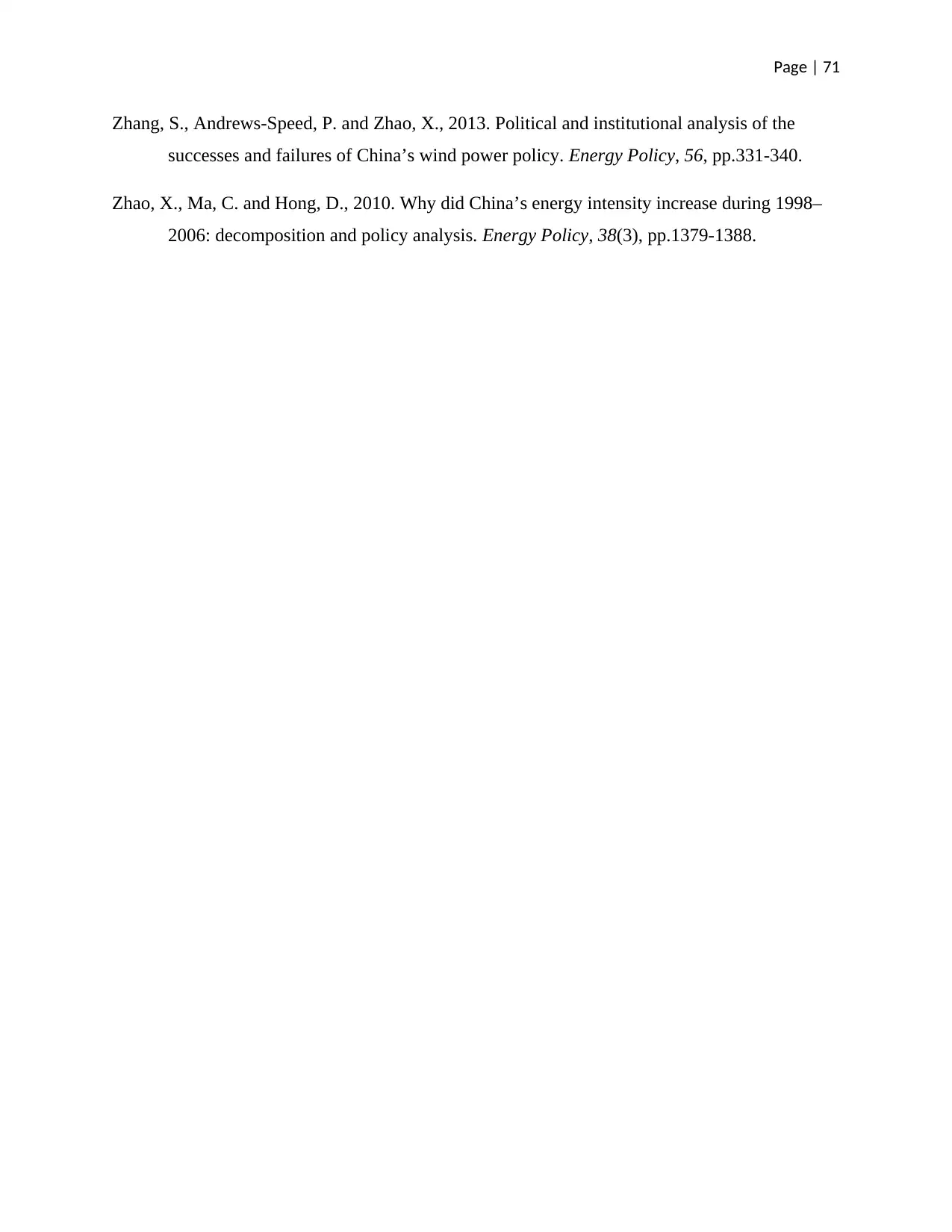
Page | 71
Zhang, S., Andrews-Speed, P. and Zhao, X., 2013. Political and institutional analysis of the
successes and failures of China’s wind power policy. Energy Policy, 56, pp.331-340.
Zhao, X., Ma, C. and Hong, D., 2010. Why did China’s energy intensity increase during 1998–
2006: decomposition and policy analysis. Energy Policy, 38(3), pp.1379-1388.
Zhang, S., Andrews-Speed, P. and Zhao, X., 2013. Political and institutional analysis of the
successes and failures of China’s wind power policy. Energy Policy, 56, pp.331-340.
Zhao, X., Ma, C. and Hong, D., 2010. Why did China’s energy intensity increase during 1998–
2006: decomposition and policy analysis. Energy Policy, 38(3), pp.1379-1388.
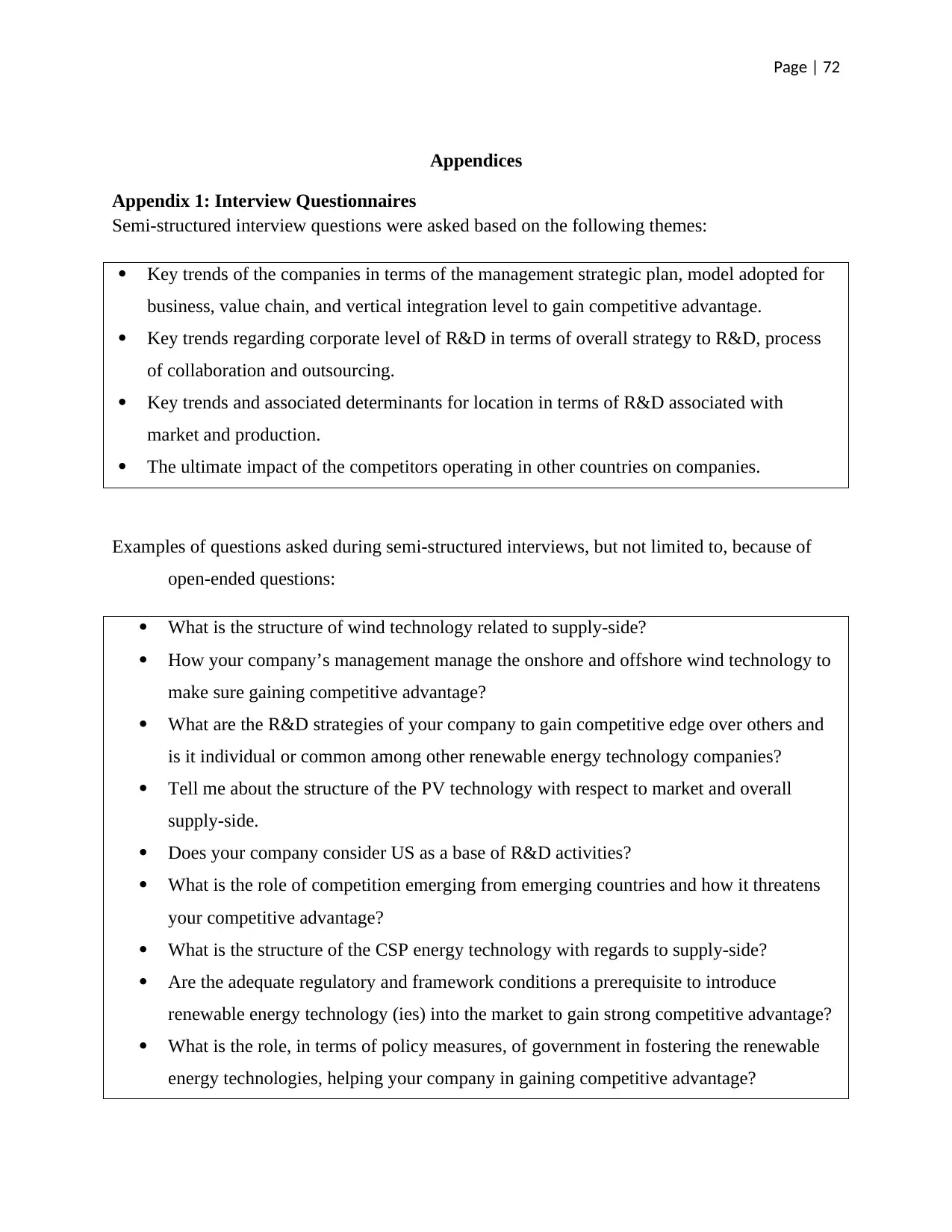
Page | 72
Appendices
Appendix 1: Interview Questionnaires
Semi-structured interview questions were asked based on the following themes:
Key trends of the companies in terms of the management strategic plan, model adopted for
business, value chain, and vertical integration level to gain competitive advantage.
Key trends regarding corporate level of R&D in terms of overall strategy to R&D, process
of collaboration and outsourcing.
Key trends and associated determinants for location in terms of R&D associated with
market and production.
The ultimate impact of the competitors operating in other countries on companies.
Examples of questions asked during semi-structured interviews, but not limited to, because of
open-ended questions:
What is the structure of wind technology related to supply-side?
How your company’s management manage the onshore and offshore wind technology to
make sure gaining competitive advantage?
What are the R&D strategies of your company to gain competitive edge over others and
is it individual or common among other renewable energy technology companies?
Tell me about the structure of the PV technology with respect to market and overall
supply-side.
Does your company consider US as a base of R&D activities?
What is the role of competition emerging from emerging countries and how it threatens
your competitive advantage?
What is the structure of the CSP energy technology with regards to supply-side?
Are the adequate regulatory and framework conditions a prerequisite to introduce
renewable energy technology (ies) into the market to gain strong competitive advantage?
What is the role, in terms of policy measures, of government in fostering the renewable
energy technologies, helping your company in gaining competitive advantage?
Appendices
Appendix 1: Interview Questionnaires
Semi-structured interview questions were asked based on the following themes:
Key trends of the companies in terms of the management strategic plan, model adopted for
business, value chain, and vertical integration level to gain competitive advantage.
Key trends regarding corporate level of R&D in terms of overall strategy to R&D, process
of collaboration and outsourcing.
Key trends and associated determinants for location in terms of R&D associated with
market and production.
The ultimate impact of the competitors operating in other countries on companies.
Examples of questions asked during semi-structured interviews, but not limited to, because of
open-ended questions:
What is the structure of wind technology related to supply-side?
How your company’s management manage the onshore and offshore wind technology to
make sure gaining competitive advantage?
What are the R&D strategies of your company to gain competitive edge over others and
is it individual or common among other renewable energy technology companies?
Tell me about the structure of the PV technology with respect to market and overall
supply-side.
Does your company consider US as a base of R&D activities?
What is the role of competition emerging from emerging countries and how it threatens
your competitive advantage?
What is the structure of the CSP energy technology with regards to supply-side?
Are the adequate regulatory and framework conditions a prerequisite to introduce
renewable energy technology (ies) into the market to gain strong competitive advantage?
What is the role, in terms of policy measures, of government in fostering the renewable
energy technologies, helping your company in gaining competitive advantage?
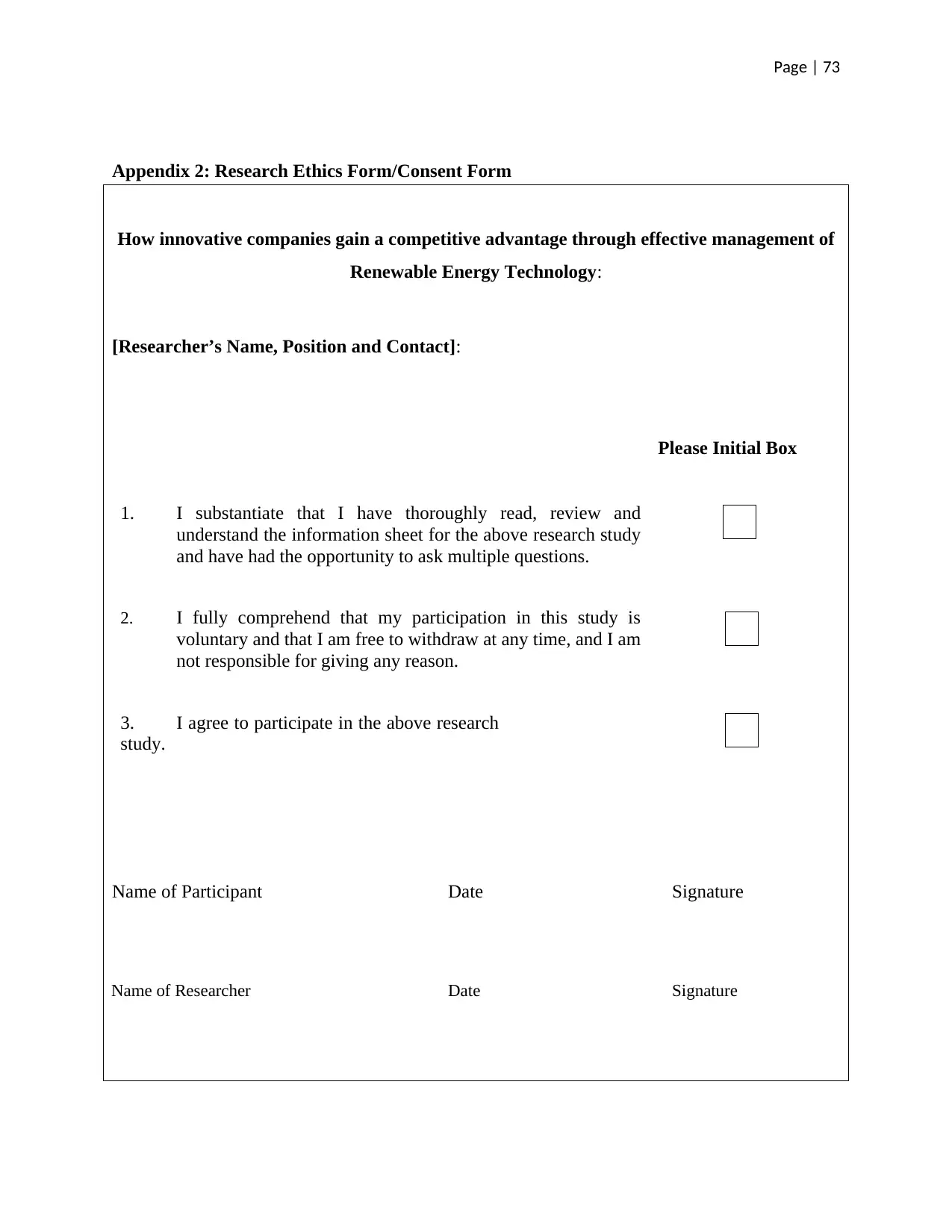
Page | 73
Appendix 2: Research Ethics Form/Consent Form
How innovative companies gain a competitive advantage through effective management of
Renewable Energy Technology:
[Researcher’s Name, Position and Contact]:
Please Initial Box
1. I substantiate that I have thoroughly read, review and
understand the information sheet for the above research study
and have had the opportunity to ask multiple questions.
2. I fully comprehend that my participation in this study is
voluntary and that I am free to withdraw at any time, and I am
not responsible for giving any reason.
3. I agree to participate in the above research
study.
Name of Participant Date Signature
Name of Researcher Date Signature
Appendix 2: Research Ethics Form/Consent Form
How innovative companies gain a competitive advantage through effective management of
Renewable Energy Technology:
[Researcher’s Name, Position and Contact]:
Please Initial Box
1. I substantiate that I have thoroughly read, review and
understand the information sheet for the above research study
and have had the opportunity to ask multiple questions.
2. I fully comprehend that my participation in this study is
voluntary and that I am free to withdraw at any time, and I am
not responsible for giving any reason.
3. I agree to participate in the above research
study.
Name of Participant Date Signature
Name of Researcher Date Signature
1 out of 73
Related Documents
Your All-in-One AI-Powered Toolkit for Academic Success.
+13062052269
info@desklib.com
Available 24*7 on WhatsApp / Email
![[object Object]](/_next/static/media/star-bottom.7253800d.svg)
Unlock your academic potential
© 2024 | Zucol Services PVT LTD | All rights reserved.





